

The Cost of Travel in Japan: My 2024 Budget Breakdown
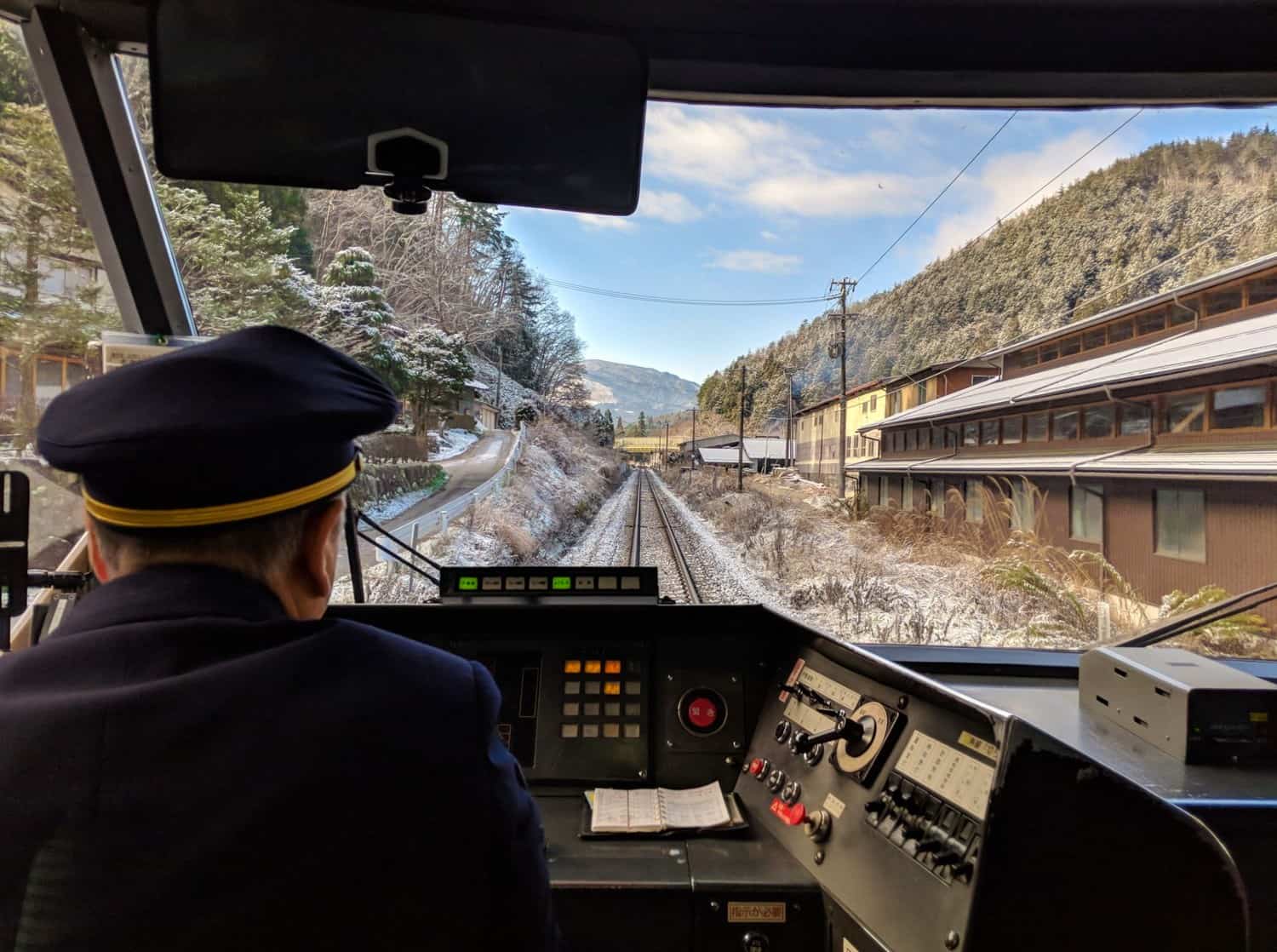
It took me six years to get to Japan.
I didn’t think I could afford it.
Every time I seriously looked into visiting, I would wince at the high cost of the train passes, read about how the hotels were super-expensive, and then fly to Vietnam instead. Or Taiwan. Or even Australia. Japan was simply too expensive for a budget traveller, so I decided to save it for when I was rich.
With that not happening any time soon, I decided to blow my money anyway, because I wanted to go and the gushing blog posts from travel writer friends had convinced me it would be worth the splurge.
Imagine my surprise, then, when I discovered that it really wasn’t that expensive.
I arrived in Japan fully expecting it to be the priciest country I’ve ever been to, but I discovered it’s more on a par with Western Europe or North America, and cheaper than Australia. It was way more affordable than Namibia , where my daily expenses came to $132, and way, way, way more affordable than the Democratic Republic of the Congo , where I averaged, um, $550 a day.
Anyway! This is about the cost of travel in Japan rather than my poor financial decisions, so let’s get started!
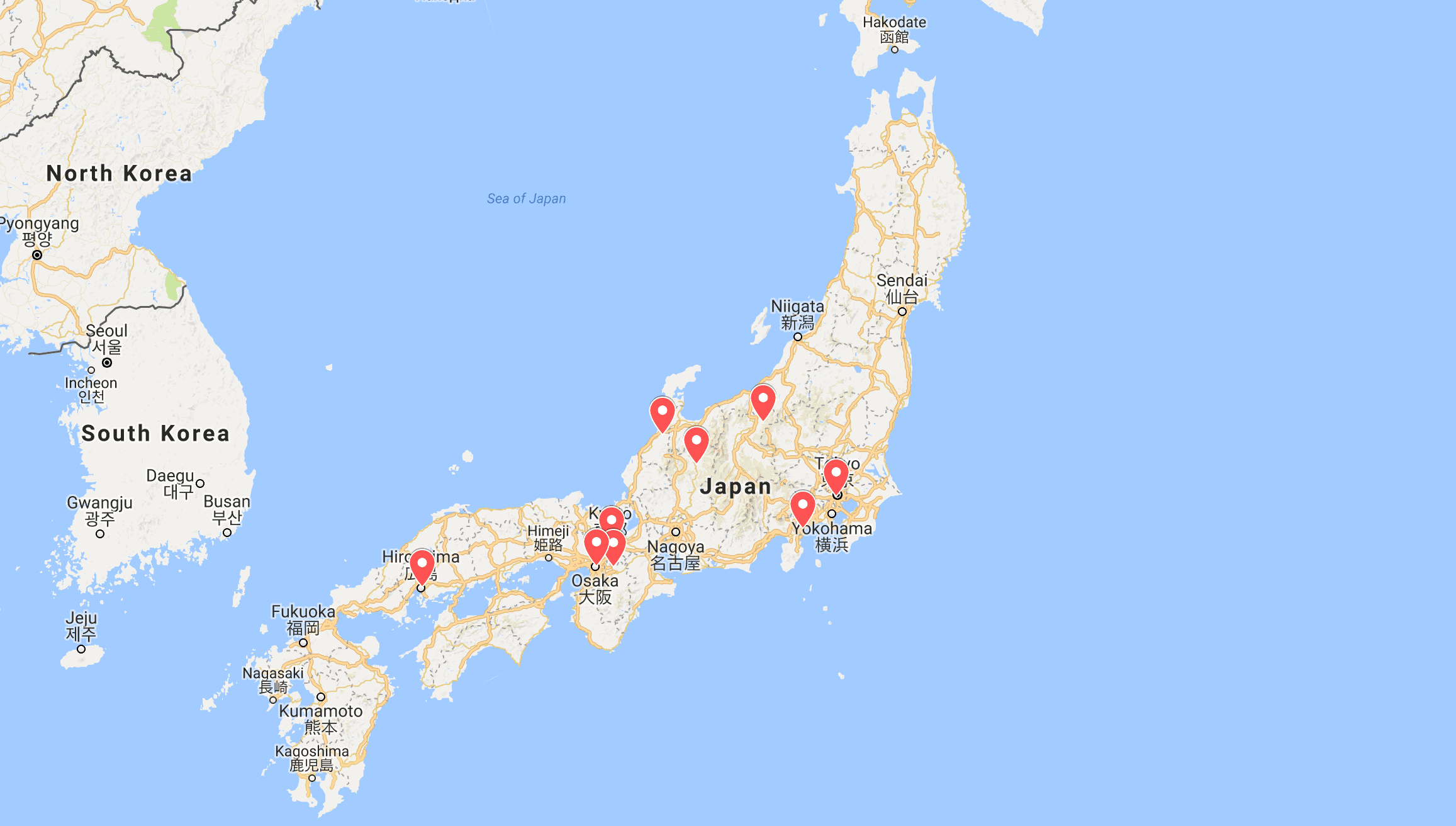
My 16-Day Japan Itinerary
Here’s a brief rundown of where I visited over my 16 days in the country — I think I managed to put together the perfect itinerary for first-time travellers to Japan .
Tokyo: 4 nights Hakone: 1 night Yudanaka: 1 night Kanazawa: 2 nights Takayama: 1 night Kyoto: 3 nights Hiroshima: 1 night Osaka: 3 nights
What’s Included in this Post
This budget breakdown covers how much I spent on accommodation, transportation, activities, food, and whichever miscellaneous items popped up while I was in country.
I’ve not included my flights into and out of Japan because this is going to vary significantly based on where you’ll be arriving from. In case you’re interested, though, I paid $320 for a return flight from Rome to Tokyo, which I scored through browsing my favourite site for flight bargains, Secret Flying .
The amounts in this guide are listed in Japanese Yen and U.S. dollars, simply because the vast majority of my readers are from the U.S. And finally, these are the three rules I always abide by on this site:
- I do not accept sponsored trips, so everything listed in this post is something I personally paid for with my own money
- I travel anonymously to ensure my experiences accurately reflect what yours will be. I don’t want special treatment!
- Every single word of this article was written by me, based on all of my own experiences. I strictly do not use AI to compose my guides.
Okay — let’s get started with my expenses.
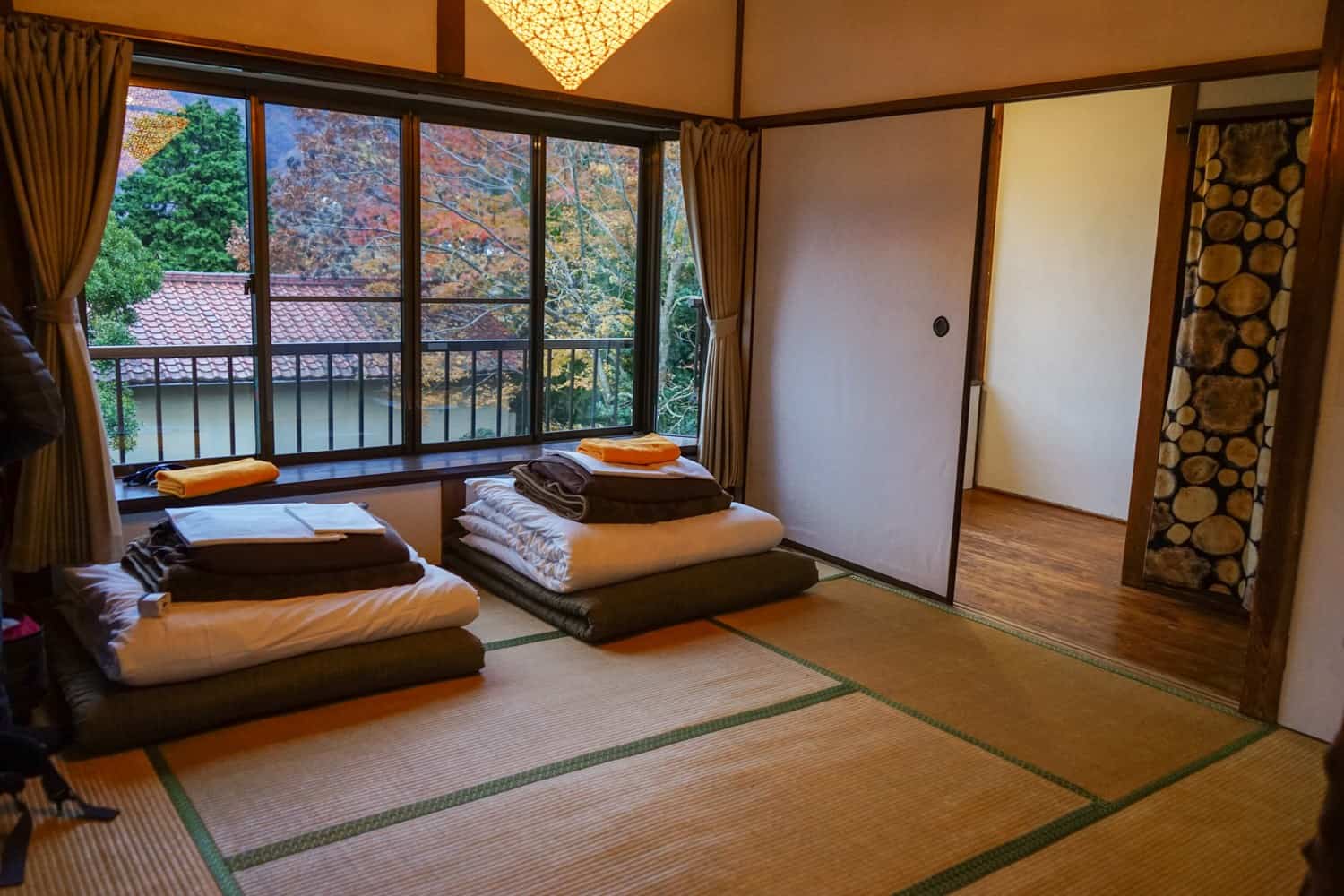
The Cheapest Accommodation Options in Japan
Like practically every country in the world, prices in Japan have increased post-pandemic.
In 2024, you’ll be paying a little more for everything than you would have done a few years ago — in fact, prices almost doubled between my first trip in 2017 and today! — however costs are still on a par with most Western countries. Travel in Japan shouldn’t be too devastating to your travel budget.
I’ll start on the lower end of the spectrum. If you’re willing to put in the time and effort, it’s possible to avoid paying for accommodation entirely.
Couchsurfing exists in Japan and allows you to stay with a local for free , usually sleeping on their sofa and enjoying a local’s insight into life in their country. Yeah, it’s not the most comfortable of living situations, but if your budget’s tight, it’s worth sending out a few requests to hosts to see if anything comes of it. You can browse through the 300,000+ Japanese hosts on the Couchsurfing site — just be sure to read the references of anybody you choose to stay with.
Housesitting is a more upmarket option, aimed at mid-range and luxury travellers. Housesitting involves taking care of somebody’s house for free while they’re away, often (but not always) looking after their pets, too. It’s best for long-term travellers or retirees, as you can’t pick and choose dates and destinations, so you’ll need to have a lot of flexibility as to where you go and at what time of year. If you do have that freedom, though, it’s a wonderful way to cut down your travel expenses, soak up some home comforts, and live like a local for a while. Trusted Housesitters is the main site for getting started with housesitting, as they have the highest number of listings.
Finally, when it comes to free accommodation, you could take a look at WorldPackers in Japan , where you’ll be able to volunteer for locals in exchange for food and board. There are some seriously cool options available on the site right now, from helping harvest honey for a bee farm in the countryside to lending a hand in the garden of a Buddhist temple. Readers of this site get a $10 discount for WorldPackers with the promo code neverendingfootsteps .
If you’re not looking to travel for free and just want a clean and comfortable room to sleep in, there are plenty of great budget options, too.
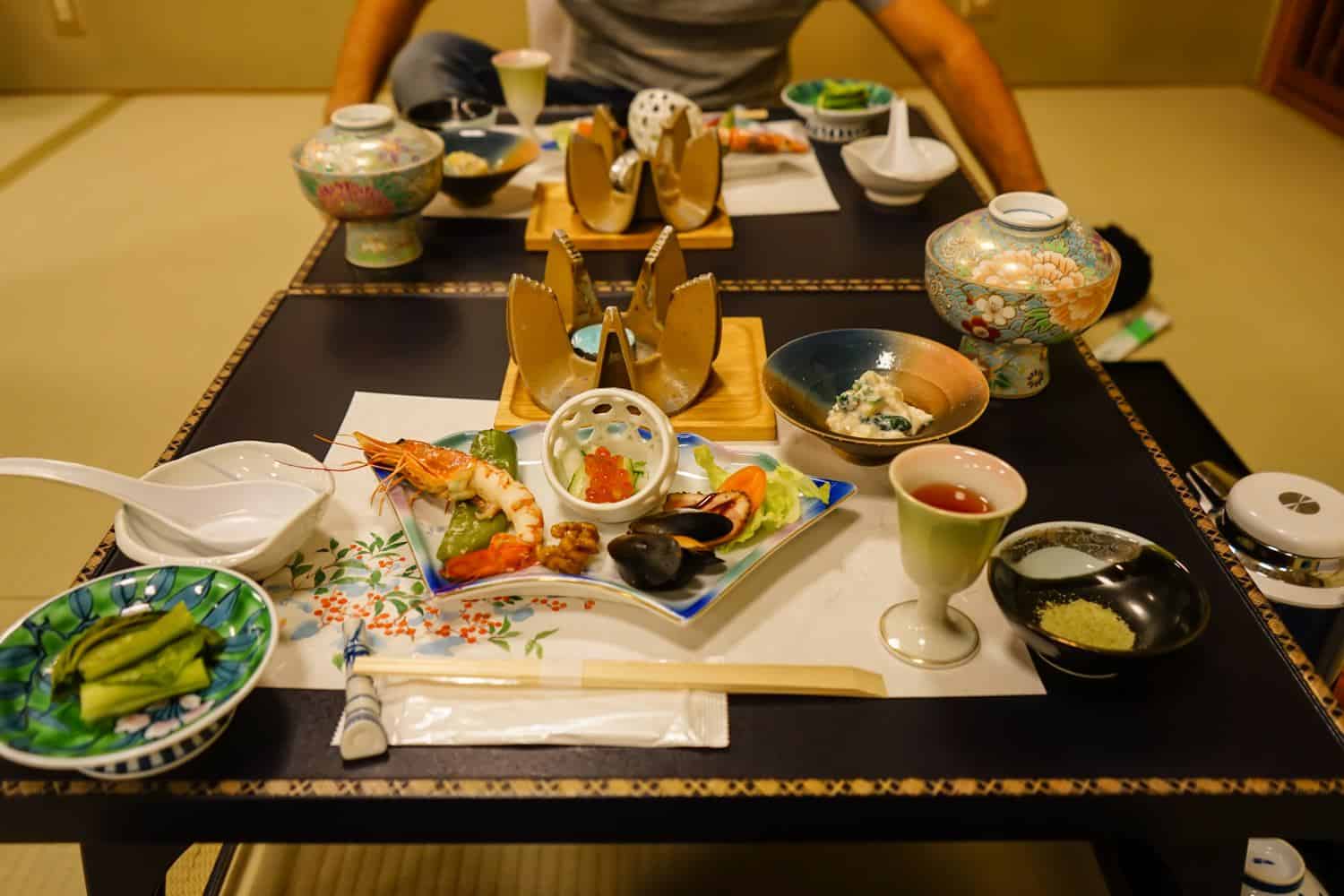
And then we have hostels . In Japan, you’ll come across hostels all over the country, finding them on tiny islands, large cities, and even within the national parks. They’re one of your best options for saving money.
Hostels in Japan are on a par with the rest of major cities in East Asia, and you can expect to spend $25 a night for a dorm bed for a well-reviewed hostel, with the price increasing slightly to around $45 a night for the absolute best of the best.
When it comes to private rooms in hostels, you’ll be looking at $50 a night for a clean, basic room in a good location, so if you’re travelling with friends or with your partner, you may find it cheaper to grab some privacy over settling for two beds in a dorm room. $90 a night will get you an exceptionally well-reviewed private room in a hostel.
I use HostelWorld to find the cheapest hostels, as they tend to have the greatest number of listings at the lowest prices.
And then there are hotels, which I’m going to jump into next.
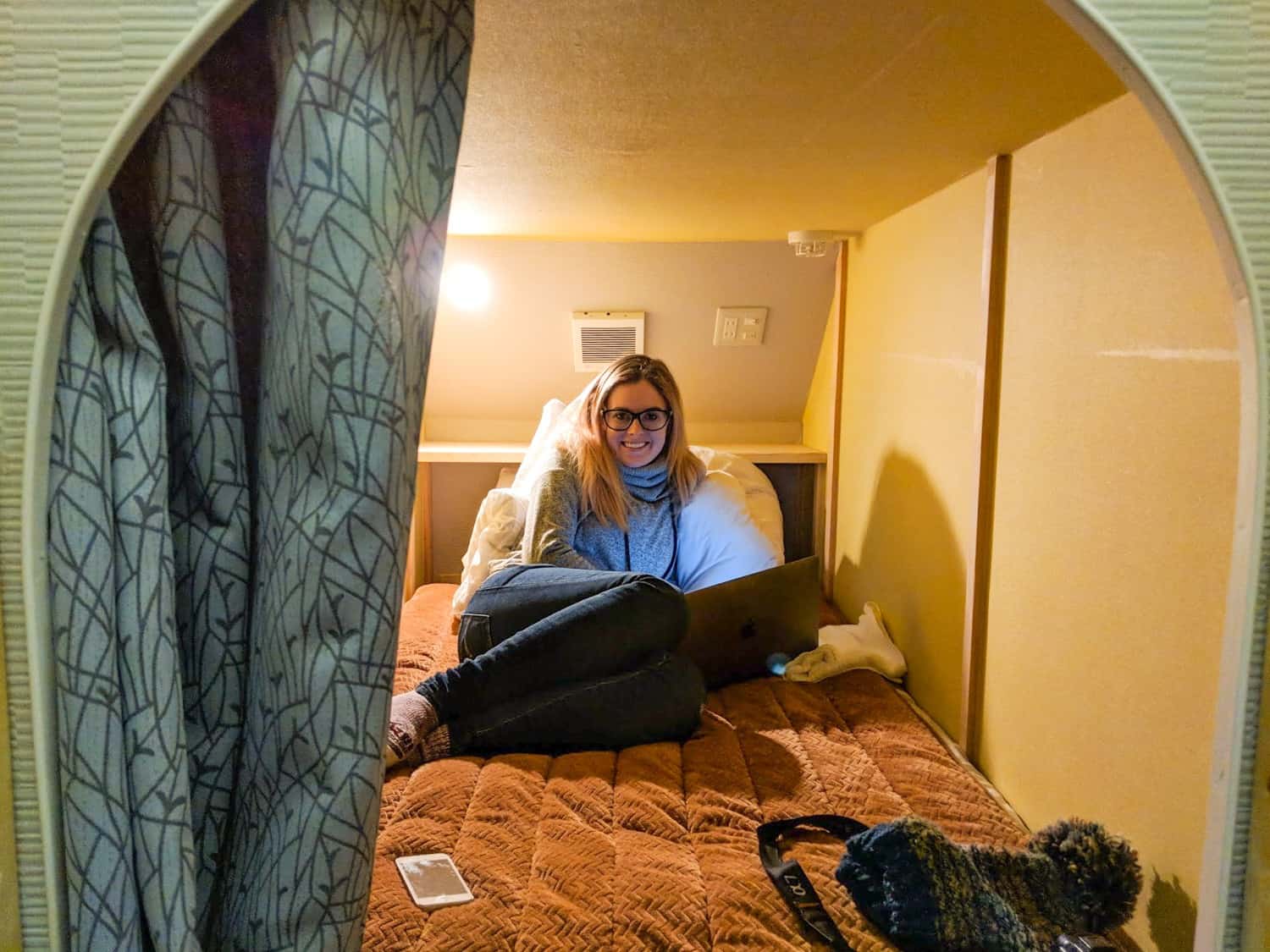
The Cost of Accommodation in Japan
There are so many different types of accommodation in Japan! I attempted to experience as many as possible while I was in the country.
I stayed in a capsule hotel, prioritised hunting down a ryokan, slept on a tatami mat floor, stayed in family-run guesthouses, and checked out some pretty cool hostels. While I did attempt to save money by staying in some cheaper places, I was also happy to splurge on extremely well-rated rooms, too.
As always with these budget breakdowns, I like to share the prices of where I personally stayed, along with a description of the property and whether I’d recommend choosing it, too — hopefully this helps make your trip planning easier!
I visited Japan with my partner, Dave, and we travelled on a mid-range budget; searching out good value accommodation that was highly-rated and in a central location. We prioritised locally-run properties that weren’t too flashy or fancy; for us, a cosy vibe, unique furnishings, and welcoming staff are far more important than the generic decor of a hotel chain.
(Oh and just a quick note: hotels do charge different prices across a range of dates, depending on how busy a certain travel period is going to be. Because of this, it’s hard to be super accurate in the costs that I list. To get to the quoted prices below, though, I looked at the rates across the next six months and took the average: it could be slightly cheaper or more expensive, depending on when you’re visiting.)
Tokyo: $135 a night Odds are, you’re probably going to kick off your Japan adventures in Tokyo, and if so, it only makes sense to really throw yourself into the local experience. That’s why we decided to stay at this lovely onsen-ryokan in Shinjuku. (Whenever readers ask me which neighbourhood to choose in Tokyo, I always recommend Shinjuku or Shibuya.) The reason why I loved this specific property, though, is because it’s a ryokan (traditional Japanese Inn) that also has an onsen (hot pool). It’s a great way to jump immediately into all things Japanese.
And it was wonderful; my favourite hotel in the country. The rooms were small and cosy and felt super-traditional and calming. The views over Tokyo at night from the window were incredible. And the rooftop onsen? With free popsicles afterwards? So good. It’s located in a quieter neighbourhood, but still only a 10-minute walk to the subway. I really recommend this one!
Hakone: $80 a night In Hakone, we opted for a private room in a lovely guesthouse , with a tatami mat floor to sleep on and a private onsen on-site. The photo of the tatami mat room above is of our room here. It ended up being another one of our favourite stays in Japan! The staff were lovely and there was a restaurant/bar that served up fantastic pizzas. It had a cosy and chilled-out atmosphere, with great food and wine, and lots of blankets to snuggle up with as we ate. It was also worth staying here just to experience the private onsen — we got to go in as a couple!
Yudanaka: $105 per night In Yudanaka, we opted for a stay in a wonderful little ryokan ; this one was even more traditional than the one in Tokyo! Often, ryokans can be super-expensive in Japan — as much as $500 a night for the experience — so I was thrilled to have stumbled across a more budget option in Yudanaka. It was run by an adorable Japanese couple and their house came with a private onsen, return transport to see the snow monkeys , and one of the most extravagant meals of my life. A kaiseki is a multi-course (like, 20 courses) meal that will see you eating roughly a week’s worth of food in a single night, sampling fresh, local-to-the-region Japanese cuisine. It was phenomenal, and I loved having no idea what anything was. It even included homemade plum wine, which was so good! I highly recommend the experience (although strongly advise you not to add breakfast to your booking — we were still so full that we couldn’t eat any of it!)
Kanazawa: $65 per night Kanazawa is home to some seriously cool accommodation! We had a hard time choosing where to stay because every property looked so cosy and inviting. In the end, we settled on this minimalist, modern set-up — it was great value for money relative to most other places we stayed in Japan, especially when you consider it’s only been open a year. It’s in a great location, right outside Omicho Market, where you’ll sample the best sushi of your life. Also within walking distance is Kanazawa Castle and Kenroku-en Garden, so you’re really staying in the heart of it all. I recommend signing up for the traditional Japanese breakfast, as you’ll likely not have had anything else like it before! There’s also an onsen and laundry facilities (always appreciated mid-trip!), and the staff were so sweet and kind.
Takayama: $76 per night In Takayama, we stayed in a small, locally-run guesthouse in the centre of town. It felt like particularly good value for Japan, as it was one of the few places we stayed that you could describe as spacious! It even had a kitchen and washing machine. The beds were comfortable and the hotel was within walking distance of everywhere, including the train station. It was quiet, the staff were lovely, and overall, it made for a comfortable stay!
Kyoto: $84 a night In Kyoto, we stayed in a cosy hotel in the heart of town — we loved this place so much in 2017 that when we returned to Japan this year, we knew we’d have to stay there again! The property was in a fantastic location for exploring Kyoto and the bathrooms were nicer than anywhere else we stayed. It’s one of the top-rated guesthouses in the city — while also being one of the cheapest — so when you take that into consideration, I’m convinced you won’t find anywhere better to stay in Kyoto.
Hiroshima: $40 per bed In Hiroshima, we opted for a capsule-style hostel because I didn’t want to leave the country without trying one — you can see a photo of the “capsule” at the top of this section. Fortunately, we found ourselves in a room with only two other people staying there, so our capsule room with 20-odd beds was light on snorers. The owner of this place was ridiculously lovely and it was within walking distance of all of the monuments and activities. Really great bathrooms, a fun common area, and a cheap price: surprisingly, I would have stayed another night!
Osaka: $108 a night I rounded off my time in Japan with a little bit of a treat, opting for this four-star hotel that offered a ton of freebies. It’s all about the onsen here — it’s open all day and is simply beautiful. After you’ve finished your daily bathe, there’s free ice cream to eat, free comics to read, massage chairs to relax in, and even free ramen to slurp on. Yes, really! It was in a great location for Osaka — just a couple of blocks from the nearest metro station. The decor was calming and traditional; the perfect way to say goodbye to Japan.
In total, I spent an average of $97 per day on accommodation over my 16 days in Japan.
The Cost of Transportation in Japan
Okay, so let’s talk about transportation now. And specifically transportation post-2024.
It used to be the case that practically every visitor to Japan would invest in a JR pass (a train pass that grants you unlimited rides over a certain time period). After all, the best way to explore this country is by train, and by buying said rail pass, you’d be saving a significant amount of money on your trip — especially if you were taking a similar route to my one. A JR Pass pre-October 2023 would have saved me a whopping $175 over buying individual train tickets.
Seems like a no brainer, right?
In October 2023, the Japan Rail Pass skyrocketed in price. No exaggeration here: prices increased by an incredible 70% .
What a baffling decision.
What that means is that it’s not such a clear-cut decision anymore. The Japan Rail Pass still holds some benefits: If you’re a first-time visitor to Japan and don’t feel too confident about buying multiple single-journey train tickets, the pass will make it a lot easier: you just show it at any station and get on a train. You won’t need to worry about any extra charges and will have the flexibility to take train-based day trips whenever you want.
For most travellers, however, the value proposition is simply no longer there. For example, my recent 16-day itinerary (Tokyo – Hakone – Tokyo – Nagano – Kanazawa – Takayama – Kyoto – Nara – Kyoto – Hiroshima – Osaka) cost me 50,000 Yen ( $350 ) with single tickets. However, a 14 day rail pass is priced at 80,000 Yen ( $530 )!
Alas, the Japan Rail Pass is no longer something I recommend — unless you’re going to be taking enormous, lengthy rail journeys (like across the whole country) in a short period of time. Alternatively, if you do want that added sense of security and ease by not having to juggle a dozen train ticket bookings, you may find the extra price worth it.
So with all that being said: you’re most likely going to be using the JR West website to book your single train tickets online. This covers the entirety of Japan that’s west of Tokyo (all of the places I visited were west) and allows you to book your train tickets all in one place — and then you can reserve a seat on said train one month before its departure date. Honestly, it’s pretty easy to use, book, and reserve — and being able to do it all online means you can get everything sorted before you step foot in the country.
Let’s take a look at the some of the prices that a typical train journey in Japan costs — in this case I’ll use my itinerary mentioned above to plot out the costs:
Tokyo – Hakone: 2,500 Yen ( $17 ) Hakone – Tokyo: 2,500 Yen ( $17 ) Tokyo – Nagano: 7,500 Yen ( $50 ) Nagano – Kanazawa: 8,500 Yen ( $57 ) Kanazawa – Takayama: 5,000 Yen ( $33 ) Takayama – Kyoto: 9,000 Yen ( $60 ) Kyoto – Nara: 700 Yen ( $5 ) Nara – Kyoto: 700 Yen ( $5 ) Kyoto – Hiroshima: 10,500 Yen ( $70 ) Hiroshima – Osaka: 10,000 Yen ( $67 )
So if you were to replicate my Japan route exactly, you would end up spending $381 on rail tickets. It sounds like a lot of money but I do want to stress that the trains in Japan are some of the best in the world. They’re spotless, comfortable, modern, and lightning-fast. You will feel like you’re travelling in luxury.
If you’re not down to spend hundreds of dollars on trains, then the buses are going to be your best option. They’re cheaper, slower, less comfortable, often run overnight, and are complicated to book. The best sites I’ve found for booking long-distance buses is Willer Express and Japan Bus Online — but even they don’t run buses for several of the routes I took on my trip.
I thought it would be a good idea to share the cost of buses for the trip I took, so that you can compare them to the train and see how much money you could save.
Tokyo – Hakone: 2,250 Yen ( $15 ) Hakone – Tokyo: 1,800 Yen ( $12 ) Tokyo – Nagano: 2,200 Yen ( $15 ) Nagano – Kanazawa: No bus for this route Kanazawa – Takayama: 3,300 Yen ( $22 ) Takayama – Kyoto: 3,800 Yen ( $25 ) Kyoto – Nara: No bus for this route Nara – Kyoto: No bus for this route Kyoto – Hiroshima: 4,300 Yen ( $29 ) Hiroshima – Osaka: 4,000 Yen ( $27 )
As you can, see prices are generally around half what they are for the trains. You’d be looking at paying $212 in total for taking the bus, with three trains replacing the routes where I couldn’t find any existing buses.
We’ve covered the main ways to get in between the destinations, so now it’s time to take a look at how much you could spend on transportation within the cities.
Fortunately, this was where I found Japan to be really affordable. I love to explore cities on foot and I found many of the places I visited to be surprisingly walkable. In total, I spent $6 on the metro in Tokyo, $7 on the metro in Osaka, and $2 on the metro in Kyoto! Everywhere else, I just walked.
A reasonably big expense was our Hakone Free Pass (spoiler: not free), although this was more of a combined transportation and activity cost. At a cost of 6,100 Yen, or $41 , It provides you with unlimited transport around Hakone (where you’ll find Mount Fuji), and discounted entrance to all the attractions in town. If you’re going to Hakone, this will save you money because it covers everything you’ll definitely do there.
The Cost of Food in Japan
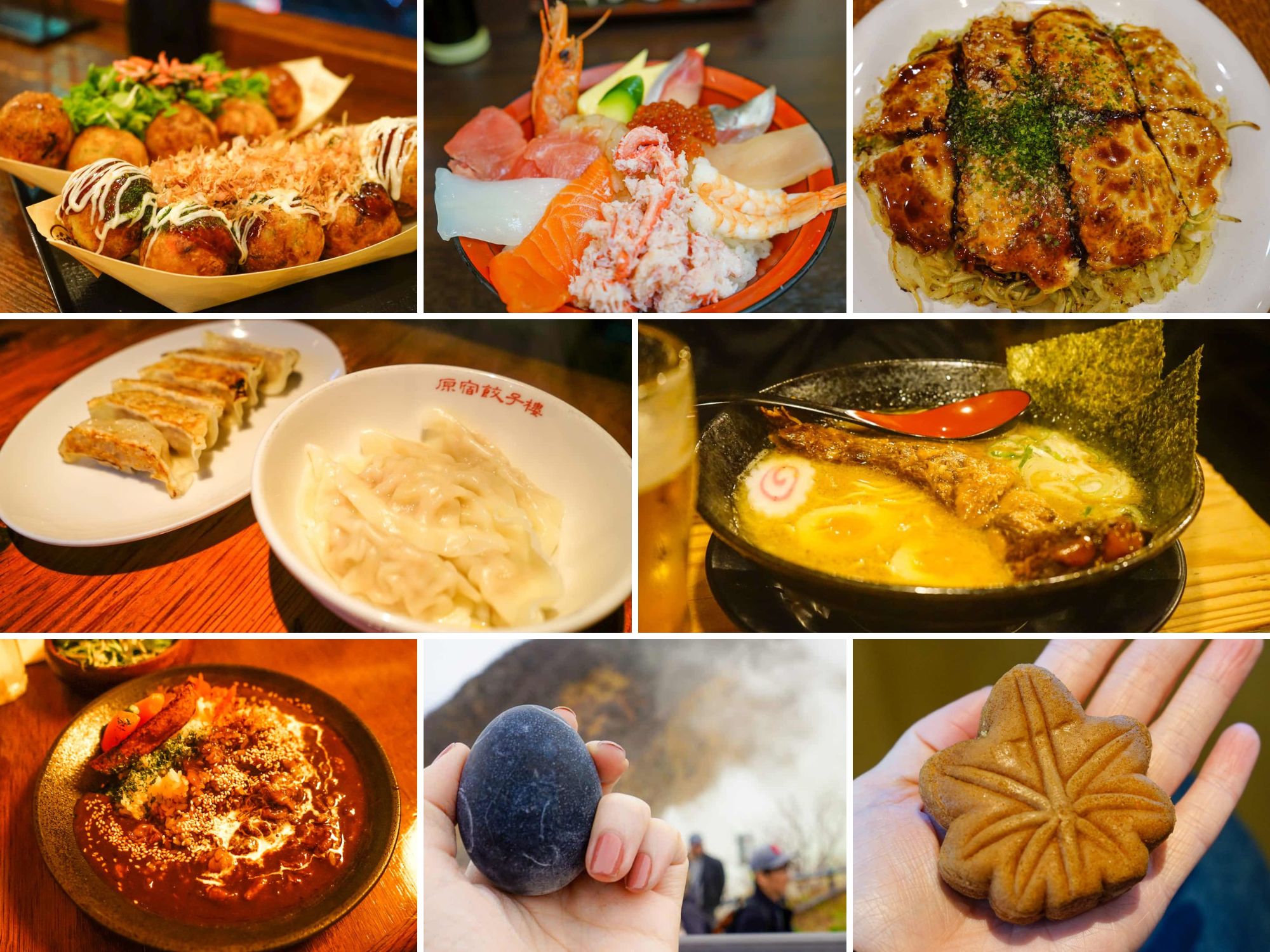
If you love Japanese food but have yet to travel to its homeland, you have such a treat in store for you. The food in this country is phenomenal; packed full of flavour and surprisingly inexpensive. It’s true: eating out is the easiest way for you to cut costs in Japan.
In fact, the vast majority of my meals in this country came to less than ¥1000 ($6.50) .
I’ll start first by breaking down the typical costs that you can expect to spend on the most well-known of Japanese dishes. Then, I’ll cover what you’ll be likely to eat for breakfast, lunch, and dinner, along with the costs associated with each of these meals. Finally, I’ll round out the section off by sharing some of my favourite food experiences in the country and describe which options are worth a splurge and which ones you can happily skip.
You can’t think of Japan without picturing sushi, so that feels like the most logical place to start. If you eat fish, this is going to be such a revelation for you! The sushi and sashimi in Japan is better than any I’ve had in the world and it was here that I finally understood how raw fish could ever be described as buttery.
To combine your sushi/sashimi-eating with a cultural experience, head to Tsukiji Outer Market in Tokyo or Omicho Market in Kanazawa. For a bowl filled with a selection of sashimi, like in my photo above, you’ll pay between ¥1,800 and ¥4,000 , depending on the size and quality of the fish. That’s the equivalent of $12-$25 .
Slurping on a steaming bowl of ramen is my personal definition of a true travel joy, so I opted for this cheap and cheerful dish most evenings as a way to save money. Note: the ramen in Japan is incredible , so don’t interpret my frugality as a hardship. Once you’ve tried the ramen here, I’d be surprised if you didn’t immediately start planning a return visit.
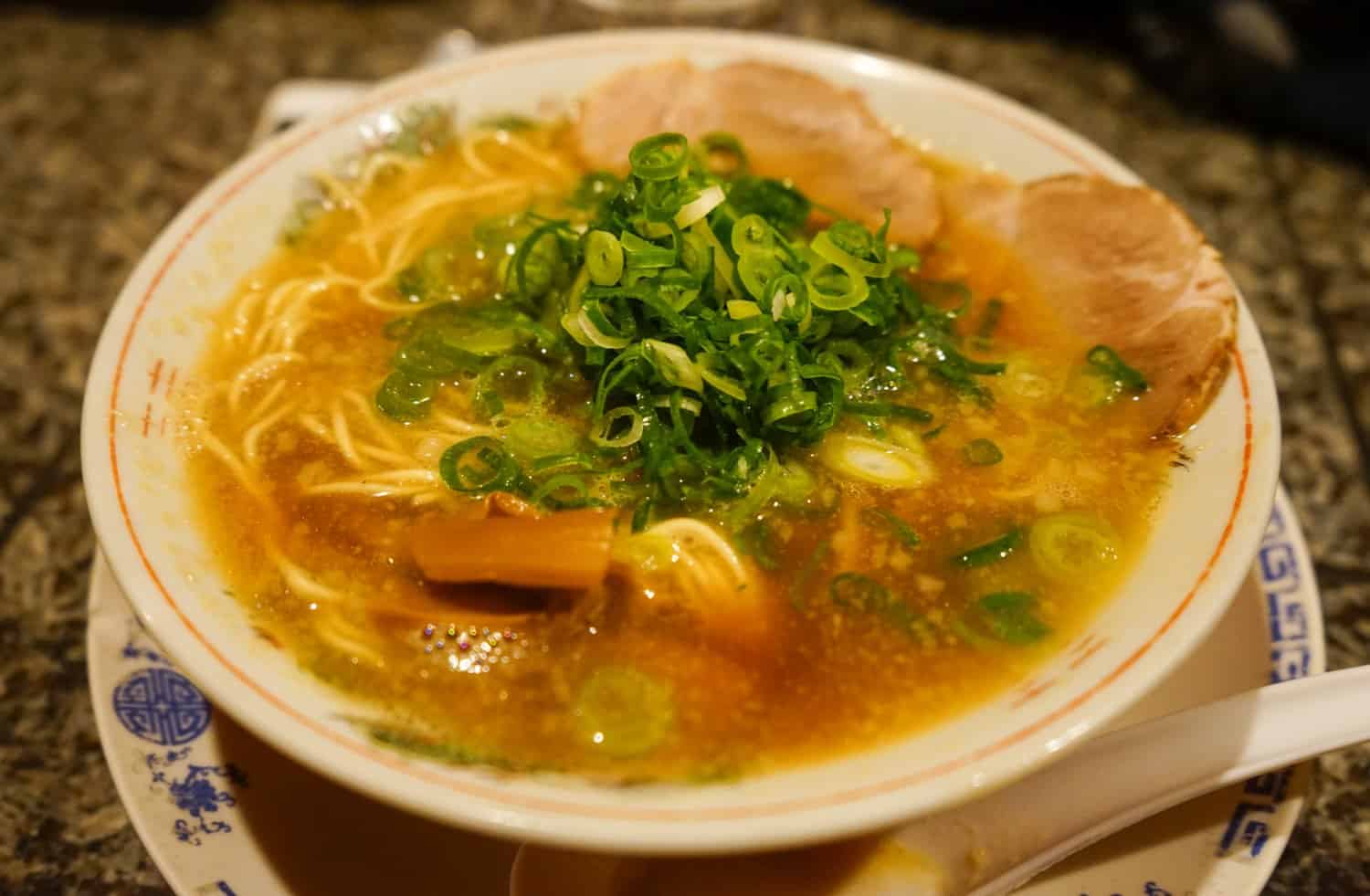
One of my favourite aspects of ordering ramen in Japan is how you’re given the option to customise the dish to your own tastes. It’s not uncommon to be handed a small slip of paper where you’ll get to mark down all of your preferences. Do you want your broth to be rich or light? Your noodles to be firm or soft? Added spiciness or none at all? Extra spring onion? A hard- or soft-boiled egg? Most options come out to ¥1000 ($6.50) for a bowl of pork ramen.
Speaking of cheap and delicious food options, I highly recommend sampling a couple of versions of okonomiyaki while you’re in town. This savoury pancake dish is so delicious, extremely filling, and inexpensive at just ¥1000 ($6.50) – ¥1500 ($10) . The cities of Osaka and Hiroshima each offer up their very own version of okonomiyaki and strong opinions are held by many over which is best! If you’ll be heading to both destinations, make sure you try one of each and let me know which is your favourite.
A dish that I tried for the first time while I was in Japan was Japanese curry and what a wonderful experience that turned out to be! In comparison to Indian curries, I found the Japanese version to be richer, sweeter, and less creamy, with plenty of umami vibes. Once more, you can expect to pay ¥1000 ($6.50) for a plate of katsu (pork cutlet) curry.
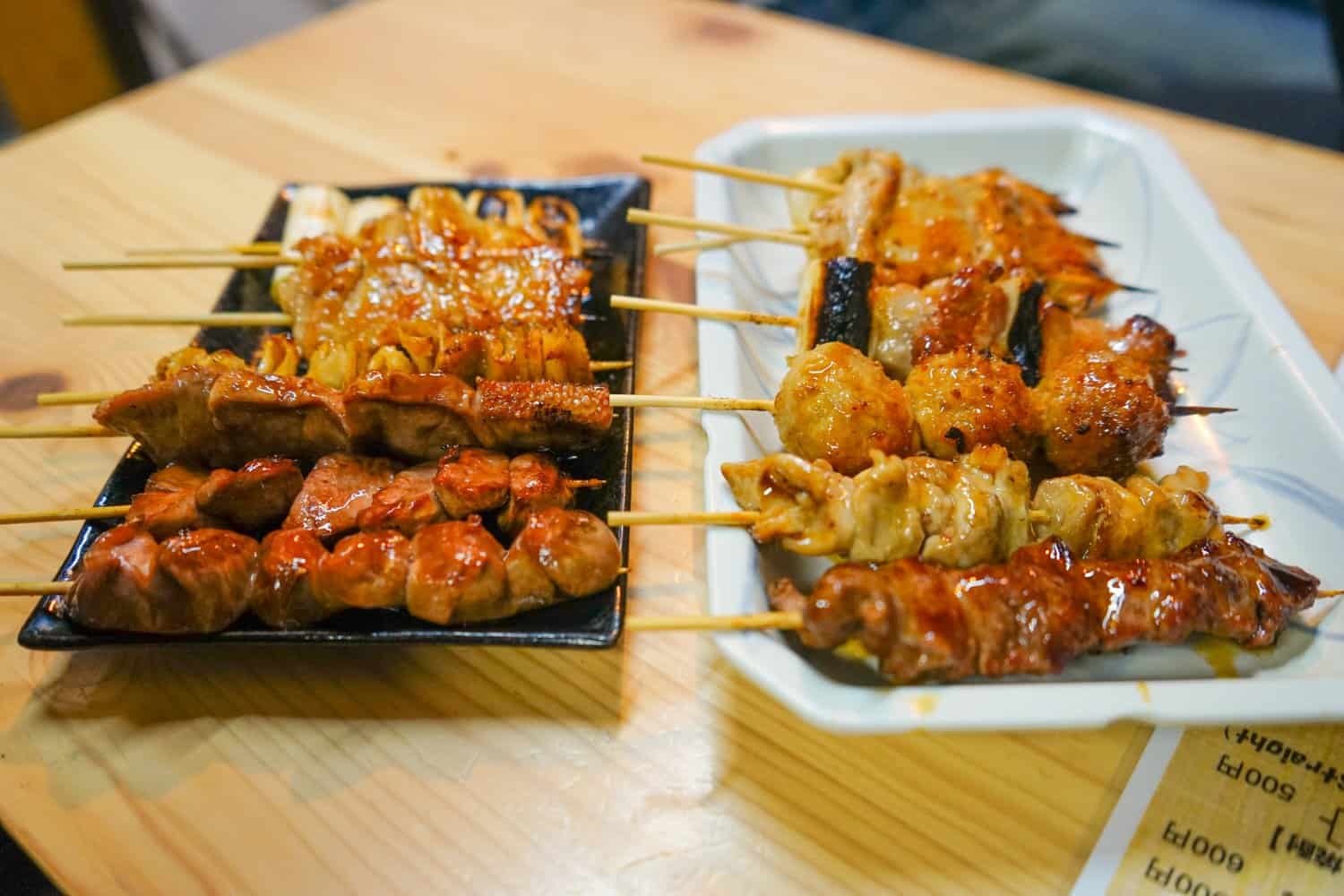
One of the most delightful aspects of my Japanese eating experiences was sampling all of the different snacks in the country.
Street snacks like takoyaki were ¥500 ($4.50) . We splurged on our kaiseki experience at our guesthouse in Yudanaka and paid ¥4000 ($36) for our food extravaganza. It’s a budget option compared to many other kaisekis, which can easily come to $100 for the experience, but still our most expensive meal. Another splurge was on sushi in Kanazawa, which I paid ¥2000 ($18) for.
Whether you’re on a budget or ready to splurge, it’s essentially impossible to eat badly in Japan. If you’re on a really tight budget, you can even get surprisingly decent food from 7-Eleven !
My total cost of food in Japan averaged out to $23.20 per day.
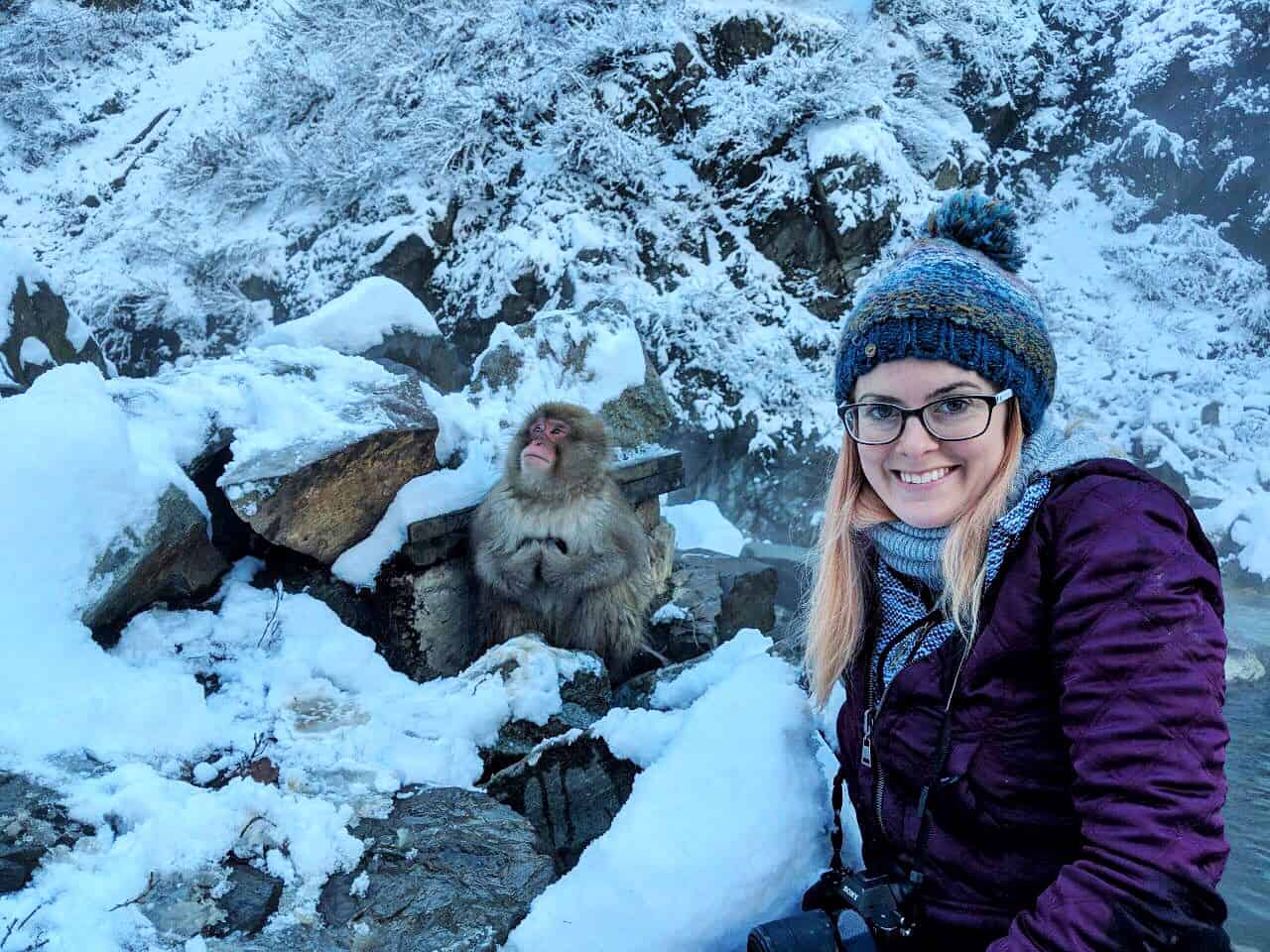
The Cost of Activities and Entrance Fees in Japan
Activities and entrance fees in Japan were very reasonably priced, and I never found myself outraged over the cost of anything. You’ll typically pay less than $5 to enter most temples, museums, and gardens.
Here’s how I spread my cash around:
Entrance fee for the hedgehog cafe in Tokyo: $13/1400¥ Entrance to the Snow Monkey Park : $7/800¥ Entrance to Kenroku-en gardens in Kanazawa: $3/310¥ Entry to the Golden Pavilion in Kyoto: $3/300¥ Entry to Ryoan-ji zen garden in Kyoto: $5/500¥ Ticket for the Hiroshima Peace Memorial: $2/200¥
My total cost of activities in Japan averaged out to $2 a day.
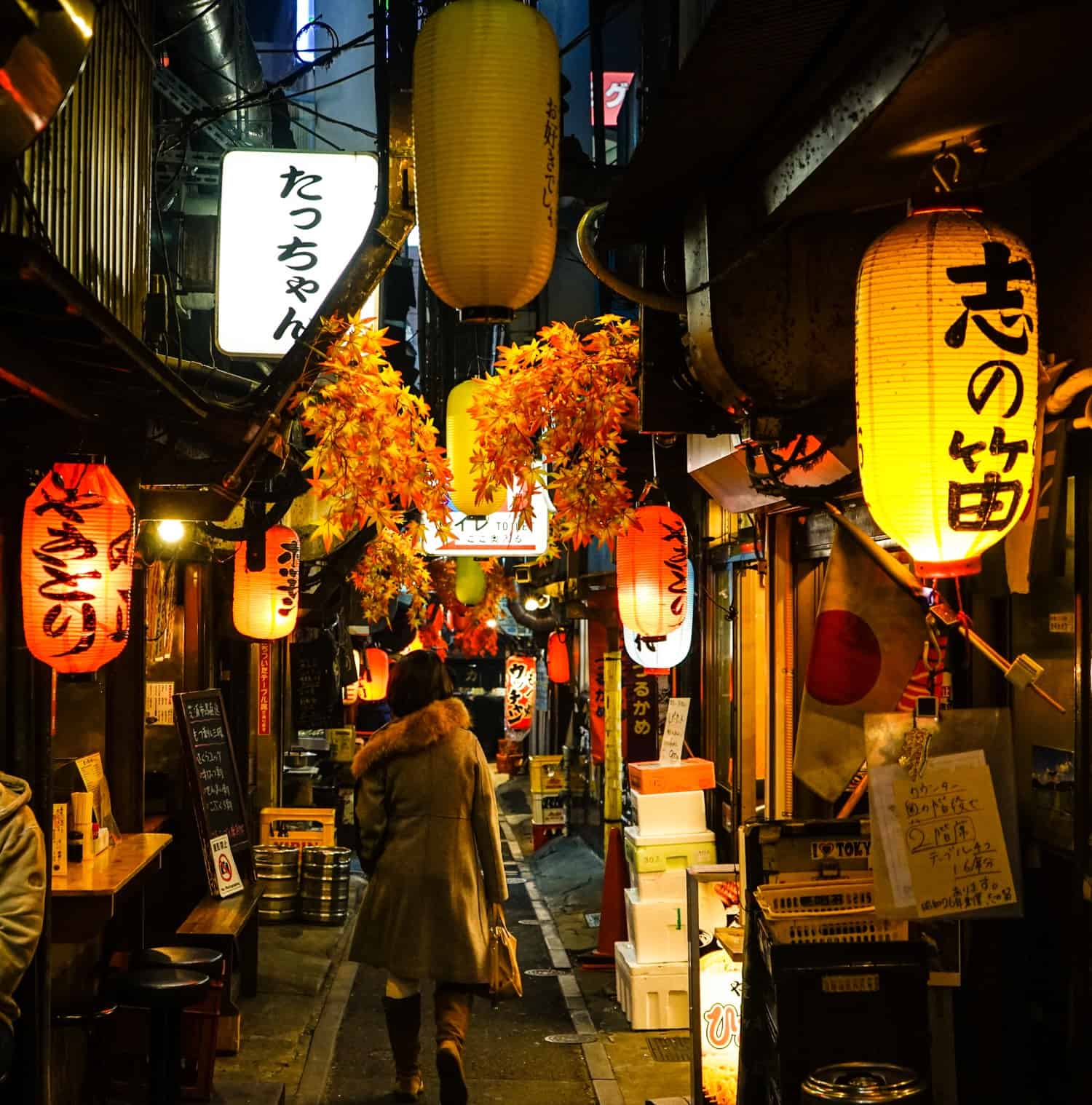
Miscellaneous Expenses in Japan
A local SIM card: $14
I mentioned above that I was able to buy a local SIM card when I purchased my rail pass. If you aren’t going to be using a rail pass in Japan, I recommend taking a look at Airalo instead. Airalo is a company that sells local e-SIM cards for travellers. What that means is that you can buy a virtual SIM card online before you arrive in Japan, and then as soon as you land in the country, can switch on your data and start using it.
It’s worked flawlessly for me and I’ll never go back to physical SIM cards. It’s just so easy! You’ll pay $6 for 1 GB of data or $14 for 3 GB for Japan and can also top-up through the Airalo app.
If you’re going down the Airalo route, just make sure your phone is e-SIM compatible first (all recent iPhones and many Androids are).
Insight Guides guidebook to Japan: $10
My sister bought me this guidebook as a gift before I left for Japan and at first I was like, Insight Guides? Meh. I wish she’d got me the Lonely Planet instead. Then when I opened it up and started reading, I swiftly discovered that Insight Guides are my new favourite guidebook company. It was so, so useful!
What I love about Insight is that their books focus heavily on the history and culture of Japan, with big, beautiful pictures, tons of information about local customs, food, and how to travel responsibly and respectfully. I recommend picking up a copy before your trip to Japan, but not taking it to the country with you — they’re big and heavy, so this is one for inspiration, planning, and education.
Luggage storage at Snow Monkey Park near Yudanaka: ¥500 ($4.50)
We had our backpacks with us when we visited the snow monkeys, so utilised the on-site storage facility while we hiked up the mountain in the snow. You can also hire snow shoes and winter gear if you’re unprepared for the climb, but I was fine in my totally impractical sneakers.
Travel insurance for 16 days in Japan: $60
If you’ve read any other posts on Never Ending Footsteps, you’ll know that I’m a great believer in travelling with travel insurance. I’ve seen far too many Go Fund Me campaigns from destitute backpackers that are unexpectedly stranded in a foreign country after a scooter accident/being attacked/breaking a leg with no way of getting home or paying for their healthcare. These costs can quickly land you with a six-figure bill to pay at the end of it.
In short, if you can’t afford travel insurance, you can’t afford to travel.
Travel insurance will cover you if your flight is cancelled and you need to book a new one, if your luggage gets lost and you need to replace your belongings, if you suddenly get struck down by appendicitis and have to be hospitalised, or discover a family member has died and you need to get home immediately. If you fall seriously ill, your insurance will cover the costs to fly you home to receive medical treatment.
I use SafetyWing as my travel insurance provider, and recommend them for trips to the Japan. Firstly, they’re one of the few companies out there who will actually cover you if you contract COVID-19. On top of that, they provide worldwide coverage, don’t require you to have a return ticket, and even allow you to buy coverage after you’ve left home. If you’re on a long-term trip, you can pay monthly instead of up-front, and can cancel at any time. Finally, they’re more affordable than the competition, and have a clear, easy-to-understand pricing structure, which is always appreciated.
With SafetyWing, you’ll pay $1.50 a day for travel insurance.
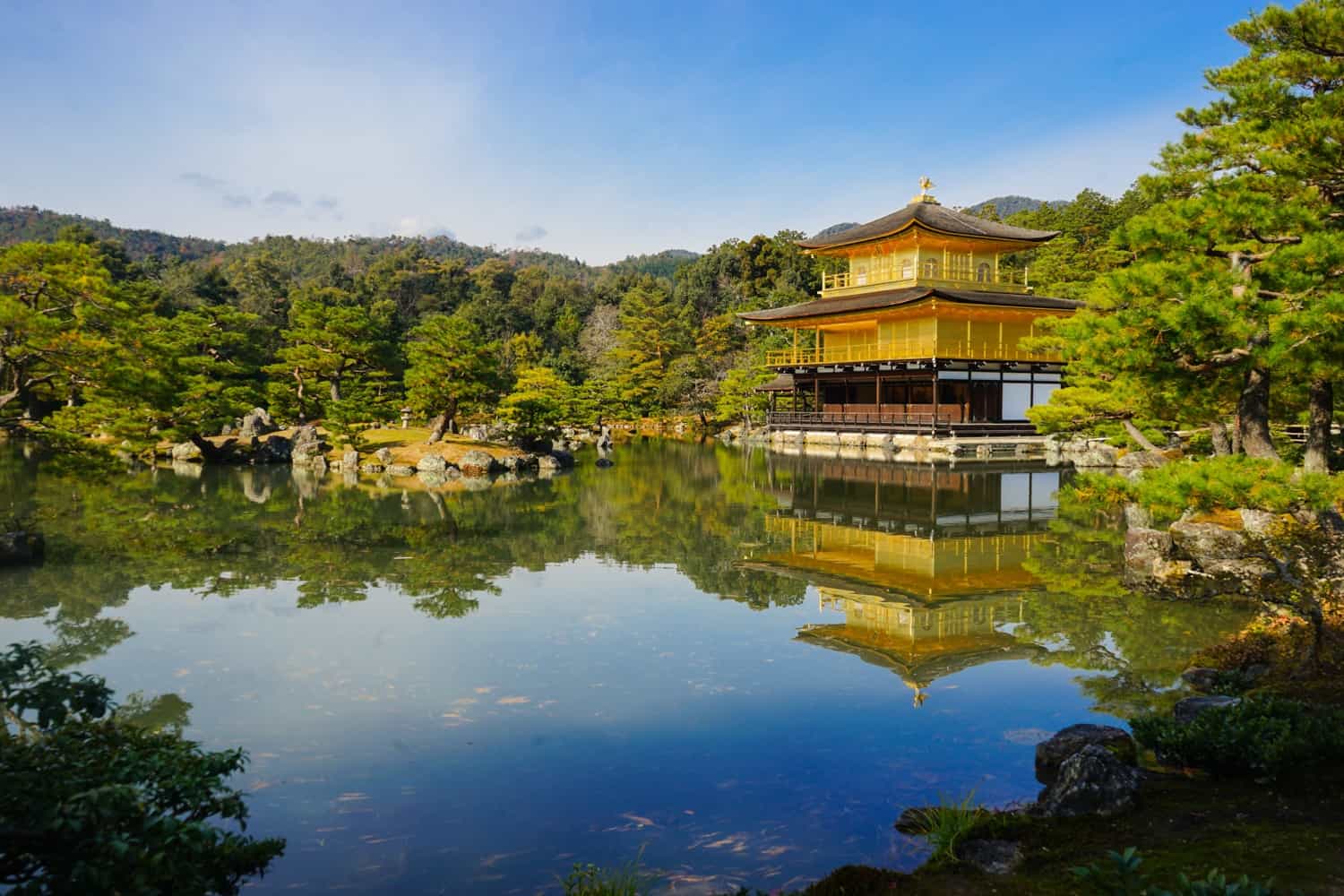
How I Track My Expenses While I Travel
Every time I share my expenses, you guys always want to know how on earth I manage to keep track of so many details from my travels!
Because Never Ending Footsteps is my company, the vast majority of my travel expenses are business expenses. I therefore studiously record everything I spend everywhere I go. I take photos of every receipt I receive and use Xero accounting software to record these expenses. In cases where I can’t get a receipt, I’ll take a photo of the price list and my ticket or food, or something as evidence.
Once a week, I then sit down and spend an hour or so uploading my receipts to Xero and making note of every penny I spent in each country I visit. It makes writing these posts super easy!
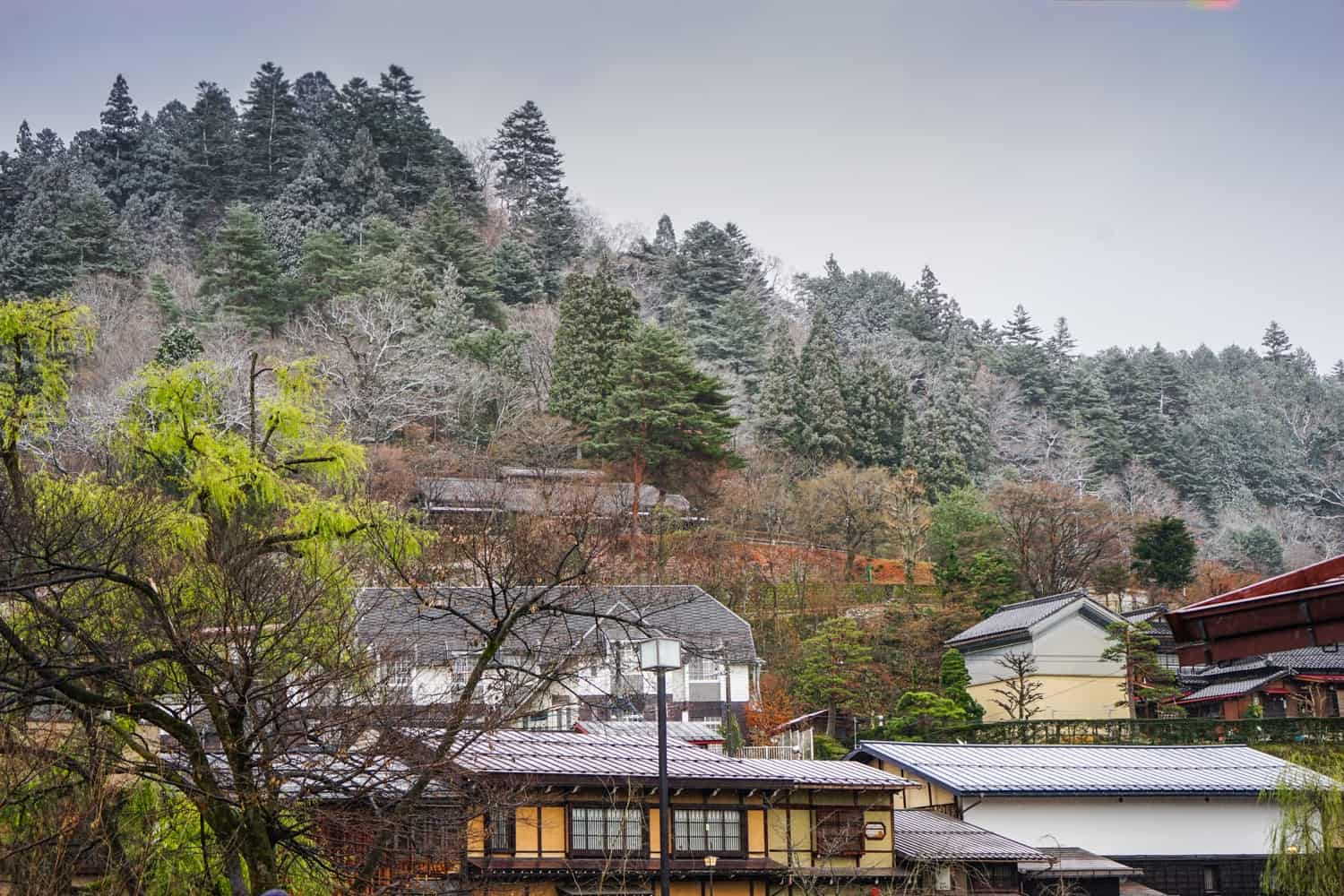
How Much Does it Cost to Travel in Japan?
It’s time to tally up all of my expenses to see my total travel costs!
Accommodation: $97 per day Transportation: $27 per day Food: $23 per day Activities/Entrance Fees: $2 per day Miscellaneous: $2 per day
Average amount spent in Japan: $151 a day!
I don’t know about you, but given Japan’s pricey reputation, I’m fairly impressed with the amount I spent in the country, especially as I included quite a few splurges in there.
How about you? How expensive were you expecting a trip to Japan to be?
Related Articles on Japan 🇯🇵 What’s it Like to Travel in Japan? 🏯 How to Spend Two Weeks in Japan: An Itinerary for First-Time Visitors 🍣 15 Weird and Wonderful Things to Eat in Japan 🎌 23 Incredible Things to Do in Osaka, Japan 🗼 21 Spectacular Things to Do in Tokyo, Japan 😎 Hipster Harajuku: The Coolest Neighbourhood in Tokyo 🦔 Should You Go to a Hedgehog Cafe? My Experience in Japan 🐒 Why Seeing the Snow Monkeys in Japan Sucked
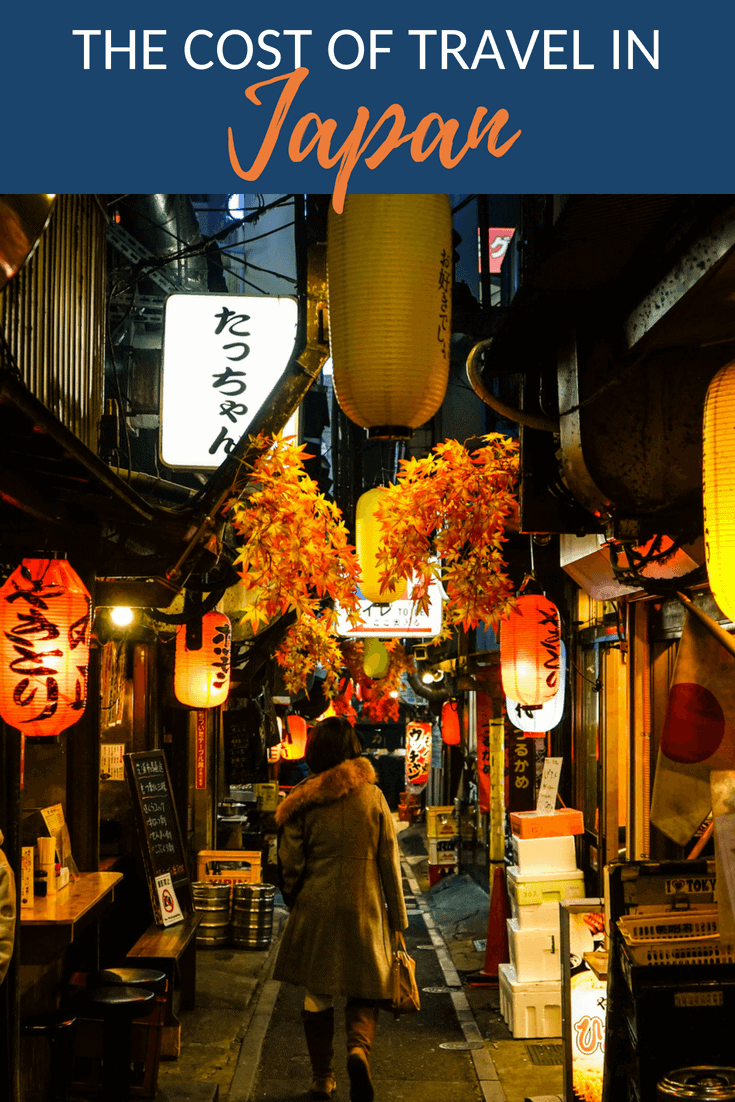
Lauren Juliff
Lauren Juliff is a published author and travel expert who founded Never Ending Footsteps in 2011. She has spent over 12 years travelling the world, sharing in-depth advice from more than 100 countries across six continents. Lauren's travel advice has been featured in publications like the BBC, Wall Street Journal, USA Today, and Cosmopolitan, and her work is read by 200,000 readers each month. Her travel memoir can be found in bookstores across the planet.
Related Posts

The Cost of Travel in Mauritius: My Detailed Budget Breakdown

The Cost of Travel in Thailand: My Detailed Budget Breakdown

2023: My Travels in Review

The Cost of Travel in South Korea: My 2024 Budget Breakdown

How to Spend Three Perfect Days in Delhi: An In-Depth Itinerary

Pushkar Travel Guide: 11 Things to Do in Pushkar
106 comments.
Wow! that’s amazing. I especially got fascinated seeing the capsule hotel…must have been a unique experience.
It was surprisingly cosy! I would totally stay in one again.
Thank you so much for your information. We will go to Japan in October 2023 for 1 month. Have paid fully for 16 days. Using your guides to budget the remaining 2 weeks. Thanks again.
This is great! Do you think it would be much more expensive in summer or any of the peak holiday seasons? I’m going over July this year and wondering if the prices change much with the seasons.
Wow! That’s quite an eye-opener! I’ve wanted to visit Japan for years, and this has certainly nudged me a little closer, as I assumed it was expensive too. The costs seem much better than I found in Amsterdam this spring! (my boyfriend still gets a thousand-yard stare when I mention how much we paid for drinks in one bar.)
Yay! Yeah, it really did feel about the same price as Western Europe, if not cheaper. The transportation is more expensive, but the food was cheaper in Japan.
This is super awesome! I, too, was under the impression that Japan was a super expensive place to visit! Good to know that you can save so much on accommodation and activities! Are you going to be posting about food in Japan? My knowledge of what to eat there is very minimal…
Yes! I published a guide to my favourite things to eat in the country last week: https://www.neverendingfootsteps.com/best-food-japan/
Ditto for here in New Zealand Lauren. All said it would be expensive. But we house sat – rent-free – and saw that food and travel are on par or cheaper than New Jersey. We also saw that virtually all things are cheaper than folks said. Methinks many labeling Japan and NZ as expensive as can be are used to paying $1 for lunch in Chiang Mai LOL. Budget folks see all Western lands as expensive. Granted I am from NJ; living by NYC makes for a high cost of living. But not bad at all, living in these lands.
Yeah, definitely true. I know that when I wrote off Japan as being too expensive, it was in the early days of my travels, when I could only afford to live in Southeast Asia!
Loving the posts about Japan so far. Do you have many more articles planned? I’ve a trip booked in November and this has been the most useful of the blogs so far for help in planning – thank you. Although I’ve had to cut the hedgehog cafe off my plans after reading your article as I hadn’t quite considered the ethics enough!
Yes! So many. I’ll probably post another half a dozen or more over the next few weeks :-)
I always assumed Japan to be very expensive. Thanks to your blog I don’t anymore. Cheers!
This is all very useful info! I’m impressed with your budgeting skills. Awesome, Thanks for sharing this!
Ha! Thank you :-) It comes naturally (finally) after seven years of doing this.
Great article. I’m planning a visit for early 2025 to go with my grandson … was the budget breakdown for one person or a couple … because you mentioned going with your partner?
The accommodation prices are the total cost of the room (rather than just my share), while the transportation, food, and activities are all my share of the costs.
Fantastic article. Love your budget posts because you never leave anything out.
I try not to! Thanks so much :-)
Beautiful photos, Japan look amazing and thank you for sharing your budget tips as well. :)
No problem! :-)
Thank you so much for this! I’m going to Japan in September and I’ve been worrying about my budget. This has definitely put my mind at rest!
Yay! Happy to hear that :-)
I’m so happy that you have posted so much lately, you’re my favourite travel blog and I check this page a lot more often now that the pace of the posts has increased :)
Thank you! :-) I’m aiming to stick to a three-times-a-week posting schedule now that I have a base and more time to dedicate to writing.
This is so much cheaper than I expected. Do you have any idea about prices for solo travellers though? Would I have to pay for a double room most of the time (apart from dorm beds of course)?
No, lots of hotels and guesthouses have single rooms, so you wouldn’t need to pay out for two people very often, if at all.
Thanks, that’s good to know!
Very useful breakdown that would be very helpful for first-timers to Japan.
Just to share, one of my own major expenditure in JP is … vending machine contribution! I simply can’t resist them and can end up buying seven times a day. “P
Yes! I couldn’t believe how many vending machines there were in the country, as well as the variety of things you could buy from them.
Hello! This is a very timely article for me to read as I’m actually going to visit Japan for a week on September. I really love Japan’s culture and their people. There are a lot of places that I want to visit and a lot of things I want to do but I am on a strict budget. Hopefully, your article would be able to help me fix my budgeting for my trip to Japan.
I hope so! I really didn’t find it horrendously expensive, so I think you’ll be surprised by how much you can do there for free.
I love your budget posts because they give me such a good idea of how much I can expect to spend in places around the world. Are you thinking of doing them for everywhere you visit?
That’s my plan! I’m slowly working my way through my records and adding more and more to the site.
Hey, thanks so much! :-)
I’ve planed to visit Japan next year, Thank you for sharing your budget, I’ll try to not exceed 100$/day, following your information on this post.
Have a fantastic trip, Ingrid! :-)
Which month you visited Japan? I am thinking for Cherry blossom (April 2019) and everything is coming up too expensive. Are those above for cherry blossom season you visited?
Ah yeah, unfortunately, the cherry blossom season is the most expensive time of year to visit Japan. I was there in December, so prices will be higher than the ones mentioned in this post. I’ll add that detail to my post now!
I was under the impression that Japan was a super expensive place to visit! Good to know that you can save so much on accommodation and activities! This article includes all the places you can visit in Japan and their expenses. It is very educative and it can be improved by providing expenses in INR. Thank you for posting this useful information.
Thank you! I usually just price these articles in the local currency and USD, which is where the vast majority of my readers are located. If I started including currencies for everyone, the post would quickly get ridiculous :-)
Seems a dumb question, but I’m assuming all the values are in USD, is it correct?
Yep! I write at the start of the post: “The amounts in this guide are listed in Japanese Yen and U.S. dollars, simply because the vast majority of my readers are from the U.S.”
That is a very good breakdown cost analysis there. i am planning to go to japan as well with my wife. and planning to stay for 10 days only. 4 in tokyo 3 in kyoto and 3 in osaka. i like to idea of 100 aud / day it’s a good target to keep but i guess the expense on buying cloths and souvenir would be uncontrollable though i heard things in japanese is not that dear if you know where to shop and avoid tourist trap. i didn’t see you mention buying internet data in advance ? or i missed it somewhere. i guess the expense for a couple will be double up. but i guess 3000 aud for 2 people is unavoidable.
amazing detailed guide
You’re welcome!
I’m so glad I found your website! I love the detail and photos. I just booked a trip to Japan with my boyfriend for this upcoming October, and your site will be very helpful. Question: do most hostels and accommodations that you experienced have you sleeping solo? I’m wondering if I should expect to sleep in a separate area than my partner for most of the trip…
Hi Lauren, Thanks for such a detailed description of your time in Japan! I’m going to Japan October this year with my wife and my major concern is how you managed to book sleeping pods for you and your boyfriend as almost all accommodations are either “male only” or “female only” from the options I’ve seen so far. Did you have to get separate beds for those nights?
Yeah, the capsule hotel-style accommodation is all single beds. You can see in my photo in this post that there’s not much room for anybody else!
My wife and I are heading to Japan in mid May and I plan to use your itinerary.
Would it be possible for you to write something about the travel logistics if you can remember them – ie to get from Tokyo to Mt Fuji we booked the following train, leaving at…from the following platform which took X hours and arrived at Mt Fuji at. We then bought our day pass from….and ……..
This would be really helpful to me and other independent travellers – from where did you buy your JR pass and how did you book your individual train rides?
Cheers Paul
Oh, man. That would take me hours and hours to put together and I’m sure times and platforms change so it would be impossible for me to keep the information up-to-date and accurate.
I recommend downloading the mobile app Hyperdia — you can plan your train travel out using that. Just enter in your destinations and it will tell you which train to take and from which platform. Super easy to use! :-)
The site I used to buy the JR Pass is this one . I booked the other train tickets in person at the stations when I arrived — there weren’t many that weren’t covered by the rail pass. Just the small regional ones to get to and from Yudanaka, I think.
Hello Lauren, I love the details in your blog. Your expenses were for 1 or 2 people?
I cover that at the start of the blog post: “And finally, these are the expenses I paid while travelling with my boyfriend. That means that accommodation prices (with the exception of the dorm bed in Hiroshima) have been halved to indicate my share.”
Great super helpful article. THANK YOU!
Hi Lauren, Thanks so much for this article, it is so helpful!!! on which dates did you fly to japan? what dates are you recommending on?
I spent the first two weeks of December in Japan. I’d recommend looking at May or September as the best months to travel there.
Hi Lauren I’d love your advice. I’m traveling with my 22yr old daughter to celebrate her graduation and my birthday. I booked the first two nights a hotel in Tokyo and then figured we would VRBO or Airbnb but after reading your post it looks like things have changed. I love the idea of the capsule hotels and the standard tatami mat rooms look enchanting. So how do I search for either? We’d like to experience both for the trip. oh by the way, I’m a traveler too, let me know where in the world are you now. Perhaps we can meet up and collaborate, I do video production, just got back from Colorado and am going to Cancun in June.looking forward to hearing back from you, Peace and Love always, “L” oh let’s connect on IG
Just book them through Booking.com — no need to go to any specific site. I’m in Bristol, in the UK. I actually don’t have an Instagram account — it wasn’t doing good things for my mental health, so I deleted it :-)
G’day Lauren,
Loved your detailed description of your travels through Japan. However; I’m not so brave as you travelling around on my own, especially with the language problem. I am a single traveler from Bangalore, India and would love to spend 7-8 days in Japan, with my journey starting and ending in Tokyo, reasonably priced hotels or local hostels, but preferably single accommodation, if possible. (willing to pay extra).
I love train travel and Japan is one of the best places to do that..your take on that would be appreciated. If you feel, I meet your requirements, would love to get an itinerary and costing for my 7-8 day stay in Japan.
Hello! I am really curious on how you got a 14 days pass JR for only 420$, from where I am from (Canada) it is 567!
If you click the link in the post, you can buy it through there. It’s currently listed for 414 USD.
$95/day seems cheaper than what I had expected – is that a tight budget? What can you do more with $150/day? I’d prefer to spend that extra on living in nice hotels + do more activities. Does that seem possible with $150/day?
No, not really. It was a mid-range budget and all of the hotels we stayed in were nice — I made zero effort to stick to a tight budget.
Hope you’re well. I’m wondering if you still advise from not booking Airbnb for Tokyo? Thanks.
Until moments ago, I had always assumed Japan to be too expensive to even consider. Never thought the cost of activities and entrance fees would be so cheap. This is an encouraging article, thanks, Lauren!
Really remarkable post, Lauren. Extremely thorough and helpful. I’m looking to plan a trip to Japan soon and stumbled across your blog. As you clearly hoped from city-to-city, (this may be a silly question) what did you do with your luggage on a day-to-day basis?
Thanks for any insight.
Oh, just left it in my hotels. If I spent less than a full day somewhere, it was visited as a day trip, so I didn’t take my luggage with me. And then whenever I arrived somewhere, I’d time my arrival with the check-in time of the hotel, drop my bags first, then head out exploring.
great article! As I have said in the past you always put out great stuff that’s very valuable information.
I just came across your website when searching for trips for Japan for my son. I have to say I am really so happy and want to thank you so much for the information. My eldest son has been taking Japan as a language course for the last 3 years and was looking forward to trying to get into the high school Japan trip in end of july beginning of August 2020. He also wanted to go to TUJ(Temple University Japan).
However, because of the olympics the high school Japan trip has been canceled for 2020. Unfortunately, he will be a senior next year so the 2021 high school program will not be available for him. Plus going to olympics are so expensive. If you can give me any advice, I would greatly appreciate. Thank you so much in advance for your time!!!
What advice do you need? About what?
Hi Lauren, I really liked you post and I think is really helpful. When exactly did you go in Japan? We have to change our plans for next February (previous planned for Philippines but to risky for my wife pregnancy) and we consider to go in Japan instead. So, do you think it is good idea travelling in Japan in February? Thank you and advance.
I went during the first half of December. As long as you keep in mind that it’ll be pretty cold (5-10 celsius), I think it’s a great time of year, as it won’t be as crowded as peak season.
is it favorable to use credit card or cash is much preferred? thanks
Hi. Thank you for the information! I am so inspired to go to Japan now. My mom who was from Japan, always told me it’s too expensive to go back and visit. I am now 56 and it has been my lifelong dream to go. My husband and I will go with backpacks like we did when we were younger and before having kids. Is October a good time to go? I read September can be humid. I want to follow your itinerary for the most part. My mom lived in Kanazawa. My heart is full right now and my eyes are misty. Thank you for making my dream a little bit closer.
Hey Lauren!
Thank you so much for the information. I actually got invited on a delegation to go to Japan this evening and am trying to get the average cost to travel in the country. Obviously, your trip was on a very impressive budget. I have two questions, 1. Based on the $95/day over the course of your 16-day trip, would it be right to say that (flight included) you only paid ~$1,600 for your entire trip? 2. Would you say for a trip including cultural experiences, transportation and stays in nice hotels for a week, a grand total of $3,700 is reasonable?
In advance, I appreciate your advice on this!
Hi Lauren, Are you able to name all the accomodations you stayed with? I would like to visit Japan next year on a very tight budget. Thanks.
Yes, they’re already linked in the post along with the reviews of them under the accommodation section.
Hi Lauren. I’m debating spending 5 nights in Osaka and doing day trips to kyoto, nara and himeji castle. (I have hotel points where i can stay at osaka). Based on your experience – is that ok? or is better to stay 2 nights in Osaka and 3 nights in kyoto. There is a lot of different opinions online, thought id ask you if you think i’d be missing out on anything if staying in osaka. The one plus is i can save some money if using points and also staying in 1 location for 5 nights vs packing and moving to another location. Thanks so much for your posts!
Hey i found this really helpful but I’ve been planning to visit japan for a while and have hopes of going after i graduate high school. With some research i found that the JR pass isn’t needed if you’re just staying in one city. How much do you think i would spend on transportation for 2 weeks in Tokyo? Will it come out to more than what you spent or less?
Definitely less! You can walk to a lot of places, but otherwise the metro won’t cost much at all — a dollar or two per trip.
Would you be able to give recommendations for food places in Kyoto that are affordable.
Hi Lauren. Came across your site on a Google search for budget travel. It convinced e that a trip to Japan is affordable. Never have done international travel and would like your advice on a couple of things. 1. What is the best way to pack? Do I have to just use a back pack? 2. Can I use a credit card or should cash be used? 3. Can I get cell phone coverage in Japan.
Thanks, you site is great!
1) I prefer to travel with a backpack, but you’ll do okay with a suitcase, too. I personally find backpacks easier for navigating train stations, as you don’t have to drag it up and down stairs, etc. It doesn’t really matter either way, though. Depending on how long you’ll be staying there, I usually pack for a week no matter how long my trip is, then do laundry once a week.
2) Japan is mostly cash-based, so plan for lots of trips to the ATM. I didn’t find many places that accepted cards, although I also wasn’t looking very hard either.
3) Yep, you can pick up a local SIM card at the airport when you arrive. I bought mine through the rail pass company I link to in this blog post, but you can also just buy one when you arrive. Super easy to do and they’ll get it set up for you in the shop, too.
Love your posts! have been browsing but when I stumbled upon your page found it really helpful! Planning for Japan and Singapore so finding both blogs is perfect timing :) We are still not sure if the JRpass will help us- when we did calculation for the main routes we are going it resulted not worth it, however then not sure if we will require any additional rails/trains in between these. Tokyo>Hakone>Kyoto> Osaka without returning back… your input will be appreciated :) P.S. Feel free to visit the island of Malta, my home country
Wooow !! This is amazing , My wife and I have been planning to visit japan and we always had a misconception that Japan is expensive to visit .. This is a great blog .. So the overall cost including your flight tickets and local travel in japan would cost around 2500 $ per person ?
This was so incredibly helpful! Normally I don’t find myself reading entire articles but yours was so informational and in depth. Thank you so much for helping me get an idea of how much I would roughly spend!
Ah, no problem! Thanks for reading, and I’m glad you found it useful :-)
I super love this article Lauren! I thoroughly enjoyed it. When all is well and my country allows us to travel again, this is going to be on my top 3 places to visit (the 1st 2 will be diving spots as I’m a freediver). I made sure to bookmark this page for reference. Again, thank you for writing this. One question though, when you say $ do you mean USD?
Yep, USD! “The amounts in this guide are listed in Japanese Yen and U.S. dollars, simply because the vast majority of my readers are from the U.S.”
How much did you spend on transportation in Tokyo? I mean if you hadn’t had the JR Pass? How much did you save in Tokyo by having the pass?
Oh, I didn’t activate the pass when I was in Tokyo — I activated it on the day I left — so that was my total expenses without using it.
Hi Lauren! I just read your post. My boyfriend and I are backpackers and we are planning our next trip to Japan. I wanted to ask you when did you go there? (what time of the year). Because we can only take time off during winter time (dec-jan) and I don’t know if that’s a good time of year to go. We are from Denver and snow doesn’t bother us but we also want to enjoy it.
Thanks in advance! Love your blog
I was there in December! There’s fewer crowds then, which makes it a great time to go! As an added bonus you get to enjoy all of the cosy onsens in the snow :-)
Even in these unprecedented times, I feel as if I have already traveled to Japan! I loved every minute of the information you gave me. This place is definitely next on my list, of course! It can be months or a year from now.
It appears you’re still getting traffic in the comments here (excellent) so I thought I would ask a broad question. Wife and I are thinking to take our 6 and 9 year old to Japan for about 11 days. Any destinations you might leave off your itinerary given a bit less time and traveling with kids?
Fantastic! I’ve never seen any article about travelling to japan so specific and detailed before!! It sure will help me prepare for my own first&solo trip! thank you so much
Great post, but the prices are wildly outdated now. Your $30/night hotels in 2018 are going for around $220/night in 2023. Insane!
Hi CS, what time of year are you looking to visit? I’ve had a quick check and every hotel I link to still displays roughly the correct prices (a couple were out by about $10-20 a night, but nothing like $190!). If you’re looking at going in May, for example, Hakone Tent prices their rooms at $176 a night, but then offers rooms at a price of $73 a night a month later in June, so the time of year can affect the pricing. I’ll make a note to mention this in a future update to the post.
I visited in the low season, in December, so the prices I paid were lower than they might be at a more popular time of year.
This is amazing on every level. Thank you! only issue is prices for accomodations double during sakura season so what can I do
Thank you Lauren, for this insightful and complete post.
Out of curiosity, do you know what was the average USD/YEN exchange rate when this trip took place?
Kind Regards,
I update the prices in this article every two months so the exchange rate used in the post is recent
How recent was your travel to Japan and what exact dates were you there? I’m planning to take my family of 4 there in 2025 and would like to schedule it during cherry blossom season. I heard prices usually go up during this time so I was wondering if your trip happened during peak or off-peak season.
I was there in December. Prices do increase a lot during cherry blossom season, unfortunately — that’s the most expensive time to visit.
very good post for budget travellers. thanks for sharing.
Leave a reply Cancel reply
Your email address will not be published. Required fields are marked *
Meet Lauren Juliff
Japan on a budget: 17 ways to get more for your yen

Mar 28, 2024 • 7 min read

These top tips to low-cost living can help you stretch your budget on a trip to Japan © Monzenmachi/Getty Images
Japan has a reputation as an expensive place to travel, but it’s an image that doesn’t hold up on the ground.
With a little strategy, a visit can be very reasonable – budget-friendly, even. Many of the country’s major sights, for example, cost nothing, and free festivals take place year-round.
With these top tips on finding the best-value places to stay, the right transportation tickets and places to eat that suit all tastes and wallets, you can make your yen go further on a visit to Japan .
A guide to daily costs in Japan
- Capsule hotel room: ¥4,000 (US$30)
- Basic room for two: ¥8,000 (US$60)
- Self-catering apartment: (including Airbnb) ¥6,000 (US$45)
- Coffee: ¥400 (US$3.50)
- Sandwich: ¥300 (US$2.20)
- Beer/pint at the bar: ¥600 (US$4.50)
- Dinner for two: ¥5,000 (US$38)
- Hour of karaoke for two: ¥2,000 (US$15)
1. Consider staying in a business hotel
These economical (and, to be honest, rather utilitarian) hotels offer the best prices for private rooms with en suite facilities.
It’s possible to find double rooms for as low as ¥8,000 (and single rooms for as low as ¥6,000), though these will be a little more expensive in cities like Tokyo , Kyoto and Osaka .
Look for places that include a free breakfast buffet – they can be substantial enough to keep you going for hours.
2. Book direct at a guesthouse or hostel
Japan has fantastic guesthouses and hostels all over; not only are they generally clean and well-maintained, but friendly English-speaking staff are usually on hand to offer near concierge-level service.
A double or single room is comparable to a business hotel (but usually has shared facilities); dorm beds cost around ¥3,000.
Some places do charge extra for towel rentals, so you can save a few yen by bringing your own. Note that rates are often slightly cheaper if you book directly rather than through a booking site.

3. Sleep in a capsule hotel in the cities
Capsule hotels, which offer small rooms with enough space for just a bed, provide a budget-friendly place to spend the night.
A capsule berth costs slightly more than a dorm bed in a hostel (¥4,000 per night), but you get more privacy.
You probably wouldn’t want to stay every night in a capsule, but they’re good for saving money in cities where hotels are pricier.
4. Go camping in the summer months
If you really want to do Japan on the cheap, you can rely on its network of well-maintained campsites in rural or resort areas; prices range from ¥500 to ¥1,000 per person or tent. Note that many sites are only open in the summer.
5. Swap a night in a hotel for an overnight bus ride
Long-distance buses, like those operated by Willer Express , are the cheapest way to get around, and longer routes have night buses, which saves a night on accommodation. There are also bus passes, which can make this an even cheaper option.

6. The Japan Rail Pass is a great travel bargain
Like the famous Eurail Pass, the JR Pass is one of the world’s great travel bargains and is the best way to see a lot of Japan on a budget.
It allows unlimited travel on Japan’s brilliant nationwide rail system, including the lightning-fast shinkansen (bullet train).
There are also more regionally specific train passes that are cheaper, so examine your itinerary carefully before deciding. Purchase a pass online or from a travel agent like JTB in your home country.
7. Ride local trains for less with the Seishun 18 Ticket
The Seishun 18 is another great deal, but with very specific conditions: for ¥12,050, you get five one-day tickets good for travel on any regular Japan Railways train (meaning not the shinkansen or any high-speed limited express trains) during a limited period of a few weeks.
The Seishun 18 Ticket is only available at certain times during the year – during school holidays (the ticket is designed for students, but there’s no age cap) – and can only be purchased from JR ticket windows in Japan.
If the timing works, and you’re a fan of slow travel, this is a unique, ultra-cheap way to get around in Japan .
8. Consider renting a car to go beyond the cities
Highway tolls and petrol in Japan are expensive; however, renting a car can be economical if you’re traveling as a group or family, or are plotting an itinerary that takes you away from major rail hubs.
9. Take domestic flights with low-cost airlines
Japan has several budget carriers, like Peach , Jetstar and Air Do , that offer bus-like pricing on some routes – just be sure to factor in the time – and cost – of going to/from the airport.

10. Japan’s shrines and temples are free to visit
The vast majority of Shintō shrines in Japan cost nothing to enter. Likewise, the grounds of many temples can be toured for free (often, you only have to pay to enter the halls or a walled garden).
11. Eat cheap food and meet locals at a traditional festival
Throughout the year , festivals take place at shrines and temples and through city streets. They’re free, an excellent way to see traditional culture come alive, and are well attended by cheap food vendors.
12. Opt for hikes and walking tours
Going on a hike or a trek is free and can be the most rewarding part of your trip: explore an up-and-coming city neighborhood , walk old pilgrimage trails or rural lanes, or get up into the mountains in one of Japan’s national parks .
Japan’s cities, especially Tokyo, have some fantastic buildings designed by many of the big names in Japanese architecture. With a little bit of planning, you could chart your own architecture tour. Ask at a tourist information center or your accommodation for suggestions.
13. Spend time relaxing in the city parks
Urban parks are generally free to enter (and some gardens are, too) and are popular with locals on weekends; pack a picnic and settle in for an afternoon of people-watching. If you time your visit right, you could be bathing in the beauty of Japan's cherry blossoms .
14. Shop for cheaper goods at a local market
Many seaside towns have fish markets, some rural spots have morning markets, and some cities still have their old-fashioned open-air markets. Visits here are a great way to connect with local culture and are often a source of cheap, fresh food.
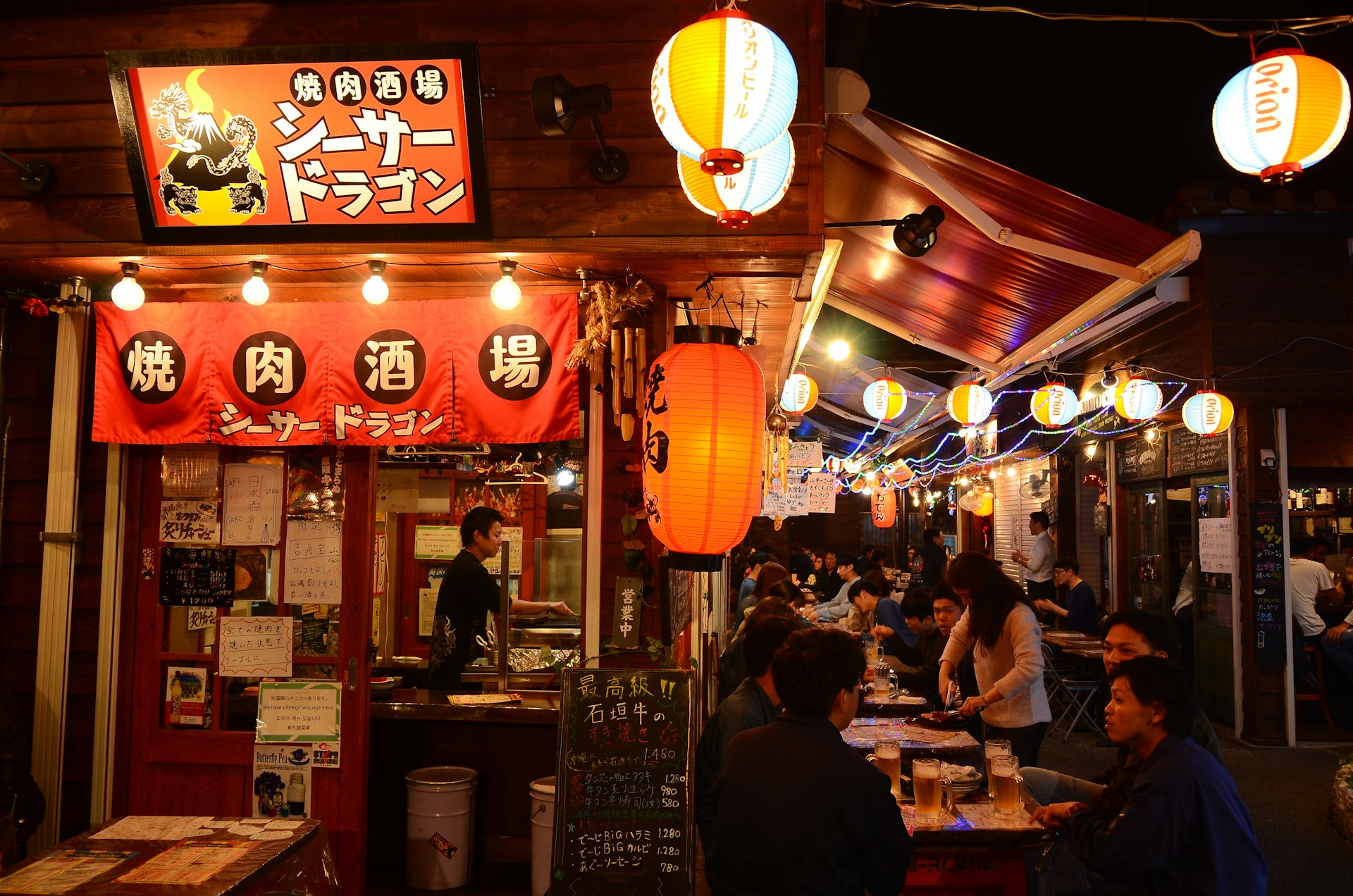
15. Choose the right dish in the right place to save money
You can get a good, filling meal in shokudō , Japan's answer to the greasy spoon, for under ¥1,000. A steaming bowl of tasty ramen can be picked up in many places for as little as ¥600.
Tachigui (stand-and-eat counter joints) sell soba (buckwheat noodles) and udon (thick white wheat noodles) for even less – starting as low as ¥350 per bowl.
Many upscale restaurants in Japan offer a smaller course at lunchtime for significantly less than they charge at dinner, so for a bargain deal have your larger meal then. In all restaurants in Japan, tea and water are complimentary, and tipping is not required.
16. Bentō are a budget alternative to a meal out
These "boxed meals," which include a variety of dishes, can be picked up for under ¥1,000 at supermarkets. Department store food halls sell gourmet ones for a little bit more; visit just before closing to buy them on markdown.
17. Get everything you need and more at the convenience store
Convenience stores are the best friend to all budget travelers. They stock sandwiches, rice balls, hot dishes and beer, all of which you can assemble into a very affordable (if not exactly healthy) meal. Accommodations always have kettles, so cup noodles are always an option.
Keep planning your trip to Japan:
Save this guide to the top things to do in Japan . Find out what to expect during every season from cherry blossoms to winter skiing . Before you book your trip, read these t op things to know before you go . Do you need a visa? Discover more here. Want to see Japan by train? Railway enthusiast John Walton shares his advice.
This article was first published May 15, 2012 and updated Mar 28, 2024.
Explore related stories
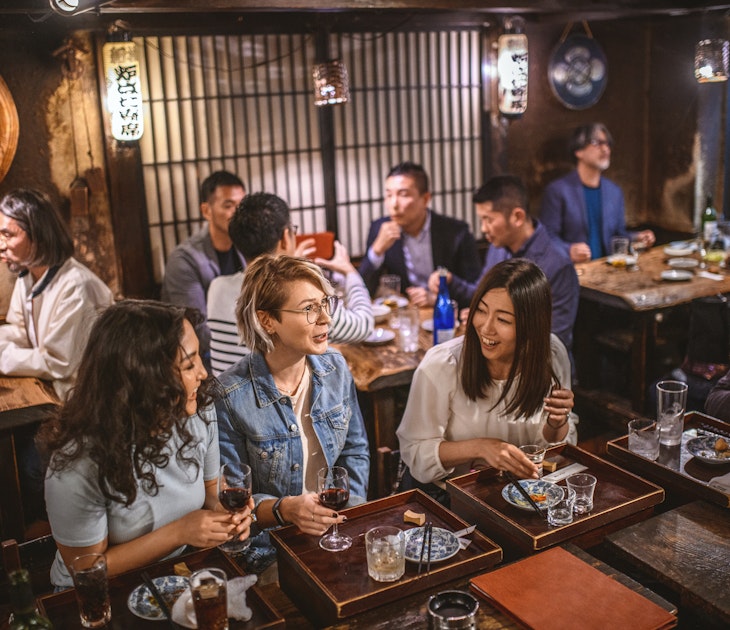
Budget Travel
Mar 23, 2024 • 7 min read
Tokyo is expensive but you don't need to max out your credit card to enjoy. Our insider tips and tricks will stretch your yen and save your bank account.
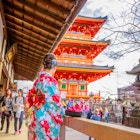
Dec 10, 2023 • 6 min read
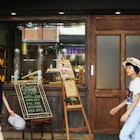
Oct 20, 2023 • 13 min read

Jan 29, 2020 • 9 min read

Jan 12, 2020 • 5 min read

Oct 28, 2019 • 19 min read

May 3, 2024 • 14 min read

May 1, 2024 • 9 min read

Apr 14, 2024 • 6 min read

Apr 3, 2024 • 17 min read
- Travel Planning Guide
Japan Travel Budget - Visit Japan on a Budget or Travel in Style
- Japan Costs

- Is Japan Expensive?
- How much does a trip to Japan cost?
- Japan On-Your-Own Itineraries
- Yaeyama Islands
- Japan Hotel Prices
- Japan Cities: Hotel Prices by City
- Best Beach Hotels in Japan
- Best Hotels for Scuba Diving in Japan
- Best Hotels for a Weekend Getaway in Japan
- Best Cheap Hotels in Japan
- Best Hotels for First Time Visitors in Japan
- Best Business Hotels in Japan
- Best Romantic Hotels for Couples in Japan
- Best Family-Friendly Hotels in Japan
- Best Luxury Hotels in Japan
- Best Hotels for Skiing in Japan
- Best Hotels for One Night in Japan
- Best Hotels for One Week in Japan
- Best Party Hotels in Japan
- Best Pet-Friendly Hotels in Japan
- Best Adults Only Hotels in Japan
- Where Do Backpackers Go in Japan? A Review of Hostels and Guesthouses.
- Hostel Prices & Reviews
- Japan Activities
- Japan Tour Prices
- The Best Family-Friendly Tours to Japan
- The Best Hiking & Trekking Tours in Japan
- The Best Historical Tours in Japan
- The Best 10-Day Tours in Japan
- The Best One Week (7-Day) Tours in Japan
- The Best 2-Week Tours in Japan
- The Best Bicycle Tours in Japan
- Tours for Outdoor and Nature Lovers in Japan
- The Best Christmas & New Years Tours in Japan
- The Best Coach Bus Tours in Japan
- The Best Adventure Tours to Japan
- The Best Eco Tours in Japan
- The Best Train & Rail Tours in Japan
- The Best Sightseeing Tours in Japan
- The Best Cultural Tours in Japan
- The Best Food and Culinary Tours in Japan
- The Best Romantic Tours for Couples in Japan
- The Best Walking Tours in Japan
- The Best Luxury Tours to Japan
- The Best Budget Tours to Japan
- The Best Tours for Seniors to Japan
- The Best Contiki Tours to Japan
- The Best G Adventures Tours to Japan
- How much does it cost to travel to Japan? (Average Daily Cost)
- Japan trip costs: one week, two weeks, one month
How much do package tours cost in Japan?
Is japan expensive to visit.
- How much do I need for a trip to Japan?
- Accommodation, Food, Entertainment, and Transportation Costs
- Travel Guide
How much does it cost to travel to Japan?
You should plan to spend around $122 (¥18,714) per day on your vacation in Japan. This is the average daily price based on the expenses of other visitors.
Past travelers have spent, on average for one day:
- $30 (¥4,568) on meals
- $18 (¥2,719) on local transportation
- $117 (¥17,840) on hotels
A one week trip to Japan for two people costs, on average, $1,712 (¥261,998) . This includes accommodation, food, local transportation, and sightseeing.
All of these average travel prices have been collected from other travelers to help you plan your own travel budget.
- Travel Style: All Budget (Cheap) Mid-Range Luxury (High-End)
- Average Daily Cost Per person, per day $ 122 ¥ 18,714
- One Week Per person $ 856 ¥ 130,999
- 2 Weeks Per person $ 1,712 ¥ 261,998
- One Month Per person $ 3,668 ¥ 561,425
- One Week For a couple $ 1,712 ¥ 261,998
- 2 Weeks For a couple $ 3,424 ¥ 523,997
- One Month For a couple $ 7,337 ¥ 1,122,850
How much does a one week, two week, or one month trip to Japan cost?
A one week trip to Japan usually costs around $856 (¥130,999) for one person and $1,712 (¥261,998) for two people. This includes accommodation, food, local transportation, and sightseeing.
A two week trip to Japan on average costs around $1,712 (¥261,998) for one person and $3,424 (¥523,997) for two people. This cost includes accommodation, food, local transportation, and sightseeing.
Please note, prices can vary based on your travel style, speed, and other variables. If you're traveling as a family of three or four people, the price per person often goes down because kid's tickets are cheaper and hotel rooms can be shared. If you travel slower over a longer period of time then your daily budget will also go down. Two people traveling together for one month in Japan will often have a lower daily budget per person than one person traveling alone for one week.
A one month trip to Japan on average costs around $3,668 (¥561,425) for one person and $7,337 (¥1,122,850) for two people. The more places you visit, the higher the daily price will become due to increased transportation costs.
Organized tours are usually more expensive than independent travel, but offer convenience and peace of mind that your trip has been planned by a travel expert.
The average price for an organized tour package in Japan is $431 per day. While every tour varies by total price, length, number of destinations, and quality, this is the daily average price based on our analysis of available guided tours.
- Japan Winter One Life Adventures 11-Day Tour 11 Days - 5 Destinations $ 1,965
- Japan´s Landscapes 13 Days - 21 Destinations $ 4,559
Independent Travel
Traveling Independently has many benefits including affordabilty, freedom, flexibility, and the opportunity to control your own experiences.
All of the travel costs below are based on the experiences of other independent travelers.
Japan is a moderately priced destination to visit. It's about average with most other countries for travel costs. The prices for food, accommodation, and transportation are all fairly reasonable.
Within Asia, Japan is moderately priced compared to the other countries. The overall cost of travel here is comparable to Taiwan or Macao.
For more details, see Is Japan Expensive?
How much money do I need for a trip to Japan?
The average Japan trip cost is broken down by category here for independent travelers. All of these Japan travel prices are calculated from the budgets of real travelers.
Accommodation Budget in Japan
Average daily costs.
Calculated from travelers like you
The average price paid for one person for accommodation in Japan is $58 (¥8,920). For two people sharing a typical double-occupancy hotel room, the average price paid for a hotel room in Japan is $117 (¥17,840). This cost is from the reported spending of actual travelers.
- Accommodation 1 Hotel or hostel for one person $ 58 ¥ 8,920
- Accommodation 1 Typical double-occupancy room $ 117 ¥ 17,840
Hotel Prices in Japan
Looking for a hotel in Japan? Prices vary by location, date, season, and the level of luxury. See below for options.
Find the best hotel for your travel style.
Actual Hotel Prices The average hotel room price in Japan based on data provided by Kayak for actual hotel rooms is $102. (Prices in U.S. Dollars, before taxes & fees.)
Kayak helps you find the best prices for hotels, flights, and rental cars for destinations around the world.
Recommended Properties
- Toba View Hotel Hanashinju Budget Hotel - Kayak $ 174
- Aman Tokyo Luxury Hotel - Kayak $ 699
Local Transportation Budget in Japan
The cost of a taxi ride in Japan is significantly more than public transportation. On average, past travelers have spent $18 (¥2,719) per person, per day, on local transportation in Japan.
- Local Transportation 1 Taxis, local buses, subway, etc. $ 18 ¥ 2,719
Recommended Services
- Private arrival transfer from Kansai International airport to Kyoto City Viator $ 108
- Private arrival transfer from Osaka Itami International airport to Kyoto City Viator $ 79
What did other people spend on Local Transportation?
Typical prices for Local Transportation in Japan are listed below. These actual costs are from real travelers and can give you an idea of the Local Transportation prices in Japan, but your costs will vary based on your travel style and the place where the purchase was made.
- Subway ¥ 1,200
Food Budget in Japan
While meal prices in Japan can vary, the average cost of food in Japan is $30 (¥4,568) per day. Based on the spending habits of previous travelers, when dining out an average meal in Japan should cost around $12 (¥1,827) per person. Breakfast prices are usually a little cheaper than lunch or dinner. The price of food in sit-down restaurants in Japan is often higher than fast food prices or street food prices.
- Food 2 Meals for one day $ 30 ¥ 4,568
Recommended
- YANAKA home cooking experience, homely and local style. Viator $ 89
- Sapporo Bar Hopping Food Tour Viator $ 83
What did other people spend on Food?
Typical prices for Food in Japan are listed below. These actual costs are from real travelers and can give you an idea of the Food prices in Japan, but your costs will vary based on your travel style and the place where the purchase was made.
- Food for Fuji Hike ¥ 721
- Meal at Airport ¥ 1,043
- Conveyor Belt Sushi Snack ¥ 800
- Late Night Noodles ¥ 800
Entertainment Budget in Japan
Entertainment and activities in Japan typically cost an average of $19 (¥2,909) per person, per day based on the spending of previous travelers. This includes fees paid for admission tickets to museums and attractions, day tours, and other sightseeing expenses.
- Entertainment 1 Entrance tickets, shows, etc. $ 19 ¥ 2,909
Recommended Activities
- Private guided hidden gems tour by local English speaking driver Viator $ 64
- Hidden Osaka - Yukaku Red Light Tour & Culinary Adventure Viator $ 51
What did other people spend on Entertainment?
Typical prices for Entertainment in Japan are listed below. These actual costs are from real travelers and can give you an idea of the Entertainment prices in Japan, but your costs will vary based on your travel style and the place where the purchase was made.
- Osaka Aquarium (for 2) ¥ 4,600
Tips and Handouts Budget in Japan
The average cost for Tips and Handouts in Japan is $3.30 (¥505) per day. The usual amount for a tip in Japan is Never .
- Tips and Handouts 1 For guides or service providers $ 3.30 ¥ 505
Scams, Robberies, and Mishaps Budget in Japan
Unfortunately, bad things can happen on a trip. Well, you've just got to deal with it! The average price for a scam, robbery, or mishap in Japan is $2.79 (¥427), as reported by travelers.
- Scams, Robberies, and Mishaps 1 $ 2.79 ¥ 427
Alcohol Budget in Japan
The average person spends about $15 (¥2,338) on alcoholic beverages in Japan per day. The more you spend on alcohol, the more fun you might be having despite your higher budget.
- Alcohol 2 Drinks for one day $ 15 ¥ 2,338
- Pub Crawl in Nagoya Viator $ 39
- Tokyo Hidden Izakaya and Sake Small-Group Pub Tour with Local Guide Viator $ 163
What did other people spend on Alcohol?
Typical prices for Alcohol in Japan are listed below. These actual costs are from real travelers and can give you an idea of the Alcohol prices in Japan, but your costs will vary based on your travel style and the place where the purchase was made.
- Sake ¥ 600
Water Budget in Japan
On average, people spend $4.42 (¥677) on bottled water in Japan per day. The public water in Japan is considered safe to drink.
- Water 2 Bottled water for one day $ 4.42 ¥ 677
Related Articles
Japan on a budget.

At A Glance
- Japan is recognized for its strikingly different culture from the west. If you do some research on this country's interesting customs before your trip, you will find your experience all the more enlightening. You will also better understand how to handle different situations as they arise.
- This is a complex country with a diverse and rich history. A great way to familiarize yourself with the region is to read any number of books on the country, fiction or nonfiction, before you begin your trip. You'll be able to see the people, customs, and cultures through different eyes, and your experience will be even more meaningful and memorable when you can put it in context.
- Japan is a great country for cyclists. If you're comfortable on a bicycle head to the countryside and find a good route. You'll pass through beautiful landscapes, picturesque towns, and meet some friendly people. It's a wonderful and unique way to experience the country. It will also help you cut down on transportation costs which can be quite high throughout Japan.
- Make sure you keep your passport on you at all times. Police can question you and will often fine you if you do not have it on you. Some first time offenders get off with just a warning. In particular, nightclub raids are common, so if you're going out for the evening, don't leave home without your passport.
- Public transportation in Japan is excellent but expensive. There are many different types of transportation passes that offer any number of ticket combinations and various discounts. Make sure you fully research and understand your options before you purchase a ticket. Some passes have stricter limitations than others so make sure you look into this before buying a pass.
Top Tourist Attractions
Transportation, popular foods, more related articles.
We've been gathering travel costs from tens of thousands of actual travelers since 2010, and we use the data to calculate average daily travel costs for destinations around the world. We also systematically analyze the prices of hotels, hostels, and tours from travel providers such as Kayak, HostelWorld, TourRadar, Viator, and others. This combination of expenses from actual travelers, combined with pricing data from major travel companies, gives us a uniqe insight into the overall cost of travel for thousands of cities in countries around the world. You can see more here: How it Works .
Subscribe to our Newsletter
By signing up for our email newsletter, you will receive occasional updates from us with sales and discounts from major travel companies , plus tips and advice from experienced budget travelers!

Search for Travel Costs
Some of the links on this website are sponsored or affiliate links which help to financially support this site. By clicking the link and making a purchase, we may receive a small commission, but this does not affect the price of your purchase.
Travel Cost Data
You are welcome to reference or display our travel costs on your website as long as you provide a link back to this page .
A Simple Link
For a basic link, you can copy and paste the HTML link code or this page's address.
Travel Cost Widget
To display all of the data, copy and paste the code below to display our travel cost widget . Make sure that you keep the link back to our website intact.
- Privacy / Terms of Use
- Activities, Day Trips, Things To Do, and Excursions

- Travel Budget Japan: How much it costs and how to save
This article may contain links to products and services we use and recommend. We may receive compensation when you click on links to those products. For more information, see our Disclosure Policy .
Download our 2024 Minimalist Travel Wardrobe and Carry-On Packing List
What is the currency of japan, travel cost assumptions.
- Japan Travel Cost Summary
Map of Accommodation, Points of Interest, Eateries and Transport
How much does accommodation cost in japan, laundromats, communications, how much to budget for experiences in japan, gifu prefecture, ishikawa prefecture, nagano prefecture, yamanashi prefecture, hiroshima prefecture.
- Hyōgo Prefecture
Kyoto Prefecture
Naha prefecture, tokyo prefecture, kanagawa prefecture, okinawa prefecture, how much to budget for dining and groceries in japan, recommended foodie experiences, how to save money on dining and groceries, how much to budget for transportation in japan, train travel, how to save on transport costs in japan, rail transportation, japan-wide rail pass, regional rail passes, without rail passes, what are ic cards, bus transportation, other expenses you may incur when travelling to japan, travel insurance, finance and bank fees, luggage transfer and storage services, haircuts and massages, donations and gifts, how much did it cost you to explore japan, author: paul ryken.
Are you planning a trip to Japan and wondering how much it will cost you? You’ve come to the right place. In this article, we outline our actual travel costs during our three-month trip to Japan in 2023. Contrary to popular belief, Japan can be an affordable travel destination, with surprisingly reasonable accommodation and dining options. Plus, with the current exchange rate working in your favour, now is the perfect time to explore the Land of the Rising Sun . We also share some useful tips on how to save money during your time in Japan .
This list for women and men was created as a result of more than seven years of full-time travel around the world in all seasons with only carry-on luggage. This is the packing list we have used as we embark on our adventures into 2024.
The fine print: I agree to receive the Minimalist Journeys newsletter full of news, actionable tips and practical advice every month. I know I can unsubscribe at any time. I have read and agree to the Terms of Use and Privacy Policy .
The Japanese Yen (JPY) – the word yen meaning circle or round object – has been in existence since 1871. In circulation these days are
- Banknotes in JPY1,000, JPY 2,000, JPY5,000 and JPY10,000 denominations; and
- Coins in JPY1, JPY5, JPY10, JPY50, JPY100 and JPY500 denominations (though the latter two are most commonly used).
When reading this article, please keep the following in mind:
- Our travel costs are based upon a couple travelling together.
- We are independent travellers, researching and organising our own itinerary using our go-to travel planning tools .
- Accommodation: We usually stay in self-catered accommodation (homestays, locally owned guesthouses, hostels and short-term rentals) - in our own room with (preferably) our own bathroom, though the kitchen may be shared.
- Dining and Groceries: We have at least two meals a day at home . We like to eat out once a day to every few days (and prefer locally owned restaurants and small eateries away from the tourist hotspots).
- Transportation: We walk a lot, and wherever possible, we travel by public transport . Only occasionally do we hire a vehicle.
- Experiences: Many of the activities we do are free of charge or cost very little. When we pay for attractions or activities , we are selective as our funds are limited (just like everyone elses).
- In addition to above expense categories, we include in our total daily costs our mail scanning and forwarding service , mobile phone plans and travel insurance - though only for the period we are in the country.
- We use a multi-currency personal account with Wise to manage our currencies XE to transfer money as required.
- Not included are the costs for entry or exit transportation into/out of the country.
During our most recent visit, we spent the maximum time we could in Japan (that is, 90 days on a tourist visa ), which means we travel slower and see fewer attractions/do fewer activities each day than someone who spends two or three-week vacation in Japan and tries to see and do as much as possible each day.
Japan Travel Cost Summary
Bearing those assumptions in mind, we spent on average JPY9,205 per person per day in Japan (or USD69 using the foreign exchange rate applicable at the time).
Certainly not the cheapest country we’ve visited to date , but surprisingly more affordable than we thought.
Below is a map of the recommended accommodation, points of interest, eateries and transport terminals/stops mentioned in this article.
If you are interested in our other detailed maps containing recommended accommodations, points of interest, eateries, and transport terminals/stops, check out the following destinations:
As independent travellers, we booked almost all our accommodations ourselves via the various platforms we recommend below. We only used the help of an agent when organising accommodation for our two multi-day hikes – the Kumano Kodo ( Kumano Travel ) and the Nakasendo (the Tsumago Tourist Information Center). Most accommodations were short-term rentals – studios or one bedroom apartments with a small kitchen (where basic meals could be prepared), bathroom and laundry facilities. During our hikes , we also stayed in family-run guesthouses (minshukus), often with onsen facilities.
During our three months in Japan , our accommodation costs averaged JPY7,720 (USD58) per room per night :
Our most expensive accommodation was at Koyasan Saizenin [ Google Maps location ], a Buddhist Temple in Koyasan – at JPY14,199 per night. While not cheap compared with our other accommodations in Japan , the temple stay (shukubō) was well worth it, as it allowed us to experience a multi-course shōjin ryōri dinner and breakfast (not included in above price), bathe in the traditional onsen and attend the Buddhist early morning prayer.
At just JPY4,500 per night , our most affordable accommodation was a stay at Guest Cafe Kuchikumano [ Google Maps location ] on Day 0 of our Kumano Kodo Hike. This was a traditional Japanese guesthouse (minshuku) with a large shared kitchen and bathroom. The host was super nice, and we had a lovely evening around the fire, toasting mochi balls (the Japanese version of marshmallows) and then dipping them in zenzai, delicious sweet red bean soup .
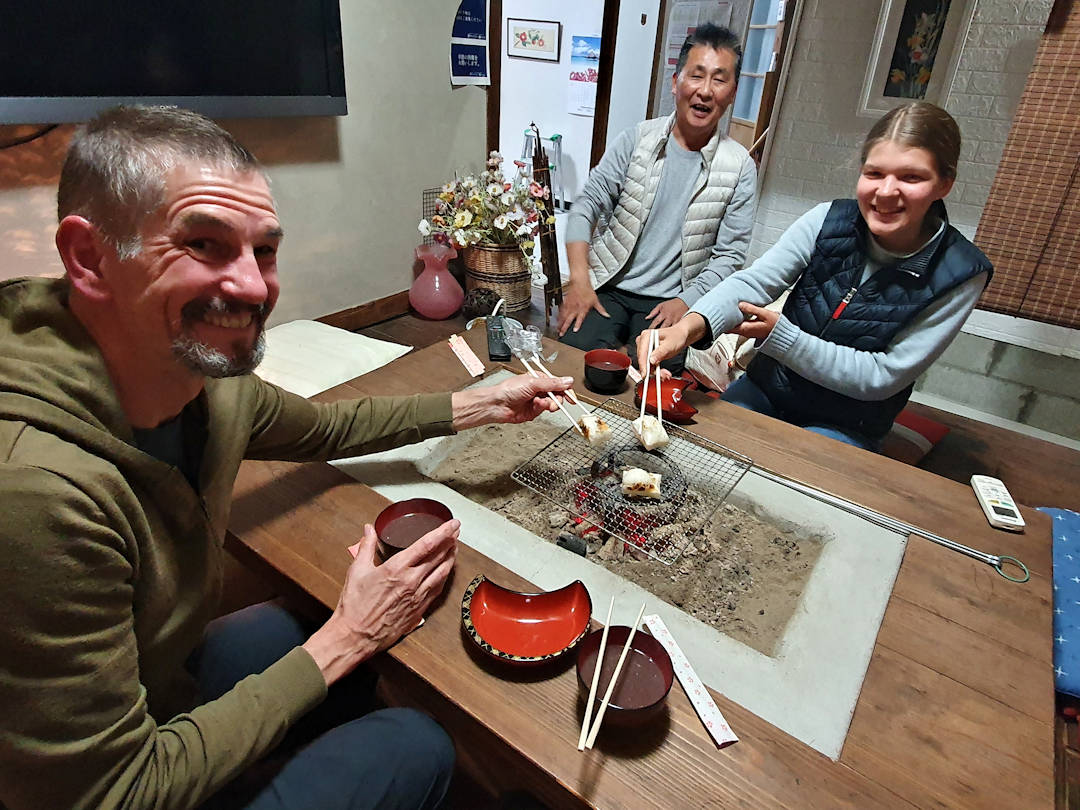
Interacting with your Japanese hosts and other guests is a wonderful experience
Although most of the accommodations we booked had a washing machine, over the three months in Japan , we did use laundromats eight times, costing us a total of JPY4,600 (or JPY575/USD4 per laundromat use ).
Prior to arriving in Japan , we purchased and received two NIPPON 4G-LTE SIM cards (one for each of our mobile phones) at a cost of JPY3,280/USD25 each – to use when we didn’t have access to Wi-Fi while travelling. Each SIM card came with 15 GB of data, valid for 180 days.
You can pack a lot into a three-month trip in Japan , and we did. All our experiences added up to JPY131,583 (USD984) between the two of us – on average, JPY756 (or just under USD6) per person per experience.
Here are some of our favourite things to see and do (including the cost per person when we visited – note that some were FREE):
- Chubu Region
- Chugoku Region
- Hokkaido Region
- Kansai Region
- Kanto Region
- Kyushu Region
Kamitakara-no-Yu Onsen , Shinhotaka [ Google Maps location ]: JPY800 Kanda House , Shirakawa-go [ Google Maps location ]: JPY400 Matsuri no Mori Museum , Takayama [ Google Maps location ]: JPY1,000 Takayama-Shinhotaka Ropeway (Bus and Cable Car) Two-Day Pass, Takayama [ Google Maps location ]: JPY6,800
Yasue Gold Leaf Museum , Kanazawa [ Google Maps location ]: JPY310
City Museum of Art , Matsumoto [ Google Maps location ]: JPY410 Miyamoto shōkai one-day bicycle rental, Nagano [ Google Maps location ]: JPY1,500 Nagano Marathon Foreign Athlete Entry Fee: JPY15,437 Obuse 3-in-1 Museum Pass (Hokusai, Kozan Takai and Obuse Museums), Nagano: JPY1,300 Togakushi Bus Day Pass , Nagano: JPY3,000
Bike ride around Kawaguchi and Saiko Lakes, Fujikawaguchiko: FREE (bicycle was provided by accommodation) Witnessing Magomi Matsuri/Chigo-no-Mai at Kawaguchi Asama Shrine and Hike to Tenku no torii, Fujikawaguchiko: FREE Kubota Itchiku Art Museum , Fujikawaguchiko [ Google Maps location ]: JPY1,300
Mt Misen Hike, Miyajima : FREE Hiroshima Castle , Hiroshima [ Google Maps location ]: JPY370 History and Folklore Museum , Miyajima [ Google Maps location ]: JPY300 Mitaki-dera Temple, Hiroshima [ Google Maps location ]: JPY200 Peace Memorial Museum , Hiroshima [ Google Maps location ]: JPY200
Hokkaido Museum , Sapporo [ Google Maps location ]: JPY1,200 Okurayama Ski Jump Stadium , Sapporo [ Google Maps location ]: JPY1,000 Sapporo Snow Festival : FREE Teine Ski Field (Day Pass and Gear Hire), Sapporo [ Google Maps location ]: JPY11,800 TV Tower , Sapporo [ Google Maps location ]: JPY1,000
Hyōgo Prefecture
Great Hanshin-Awaji Earthquake Memorial , Kobe [ Google Maps location ]: JPY600 Himeji Castle and Koko-en Garden , Himeji [ Google Maps location ]: JPY1,050 Nunobiki Herb Gardens , Kobe : JPY1,130
Botanical Gardens , Kyoto [ Google Maps location ]: JPY400 Free Walking Tour , Kyoto: FREE/Donation Hike Mt Inari , Kyoto [ Google Maps location ]: FREE Gion Corner Cultural Performance , Kyoto [ Google Maps location ]: JPY5,500 Ninomaru-Goten Palace , Kyoto [ Google Maps location ]: JPY1,050
Todai-ji , Naha [ Google Maps location ]: JPY600
teamLab Planets , Koto City [ Google Maps location ]: JPY3,500 Hokusai Museum , Sumida City [ Google Maps location ]: JPY1,000 Japan Olympic Museum , Shinjuku City [ Google Maps location ]: JPY500 Watching the sunset from Carrot Tower , Setagaya City [ Google Maps location ]: FREE Yayoi Kusama Museum , Shinjuku City [ Google Maps location ]: JPY1,100
Open-Air Museum , Hakone [ Google Maps location ]: JPY1,600
Rental Charinko Bike Ishikawa , Zamami [ Google Maps location ]: JPY2,800 Fukushuen Garden , Naha [ Google Maps location ]: JPY200 Himeyuri Peace Museum , Naha [ Google Maps location ]: JPY310 Japanese Naval Underground Headquarters , Naha [ Google Maps location ]: JPY600 Okinawa Prefectural Museum , Naha [ Google Maps location ]: JPY555 Shuri Castle Grounds, Naha [ Google Maps location ]: FREE Tsushima-maru Memorial Museum , Naha [ Google Maps location ]: JPY500
As mentioned above, during our time in Japan , we stayed mostly in accommodation that had a kitchen with basic cooking facilities, enabling us to have at least two meals a day at home . That said, it was sometimes easier and cheaper to buy ready-to-eat meals from convenience stores such as Lawsons, 7-Eleven or Family Mart – though we did try to limit those occasions to avoid adding to Japan ’s plastic waste problem .
Our daily dining costs in Japan averaged JPY1,193 (USD9) per person , with our most expensive dining experience costing us JPY2,350 per person at Steakland Kobe-kan [ Google Maps location ] – a worthwhile luxury to taste the famous beef the city is renowned for.
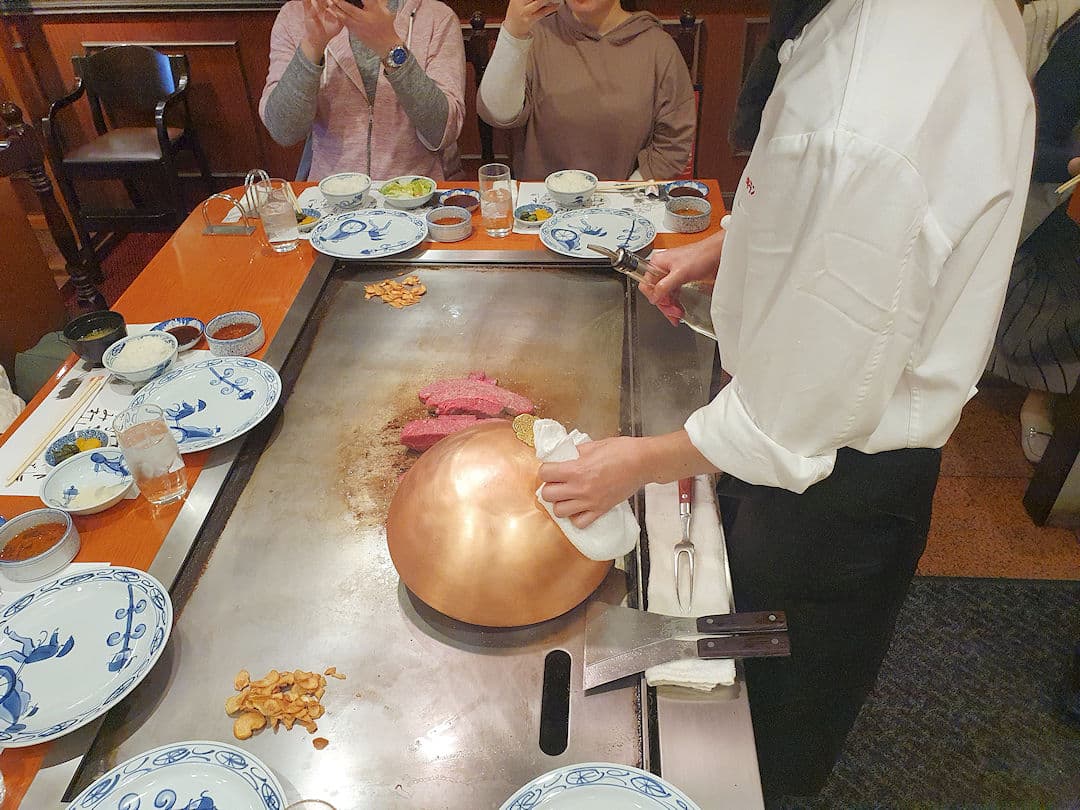
Our most expensive meal was at Steakland Kobe - but it was well worth it
Our daily groceries expenses in Japan averaged JPY1,043 (USD8) per person . We found Aeon supermarkets offered some of the best value for money, and between the major convenience store brands of 7-Eleven, Lawson and FamilyMart, we found Lawson offered the best range at the most affordable prices.
If you happen to visit Sapporo, make sure to pop into a Bostonbake branch [ Google Maps location ]. They have delicious pastries and buns daily (which are super affordable) – great to stock up on some items when you’re out and about during the Snow Festival . Sadly, Bostonbake only exists in Hokkaido.
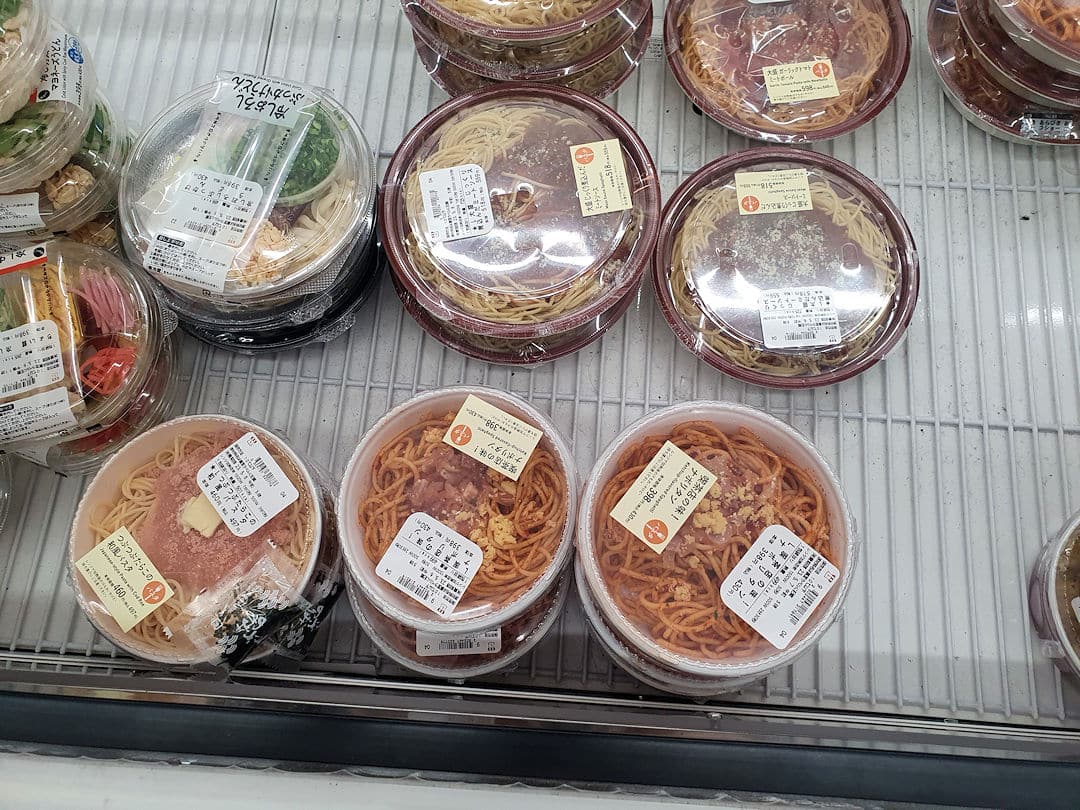
In Japan , ready-made meals are always available at supermarkets and convenience stores
As Anthony Bourdain is famously quoted as saying: You learn a lot about someone when you share a meal together. And the best way to learn about a destination is by spending it with locals, in their homes and in local markets. If you're a foodie and would like to join some incredible cooking classes and food tours, here are our recommended EatWith offers in Japan :
- Food and Sake Pairings in a Traditional Kyoto House
- Home style Ramen and Gyoza cooking class in a Japanese home
- Tokyo West-Side Walking and Street Food Tour
- Izakaya Food Tour in Shinjuku
Dining out all the time can quickly get expensive. We always try and book accommodation where we have access to a kitchen - either our own little kitchenette or the kitchen of our host. That way, we can store food in the fridge and make our own meals. We usually have breakfast and one other meal at our accommodation, and one meal when we're out and about.
Restaurants (even in tourist hotspots) often have special lunch offers (for example, a three-course meal for EUR10). Portion sizes in many parts of the world are usually quite substantial, so we often share a three-course meal. The same applies if you go out for dinner: Order a starter or salad and a main, and that's usually enough for two people. An added benefit: there is less food waste.
As for groceries: every country has more expensive and cheaper supermarkets. Ask your host what the cheaper options are (for example, Aldi or Lidl in many European countries) and avoid convenience stores as much as possible.
Experiencing the local cuisine is one of the reasons why WE travel… Paul and I tend to only eat out once a day (sometimes only once a week), usually at lunchtime. This allows us to try local dishes while taking advantage of awesome lunch deals. It also means we don’t have to roam around unknown parts of town every night in search of a restaurant.
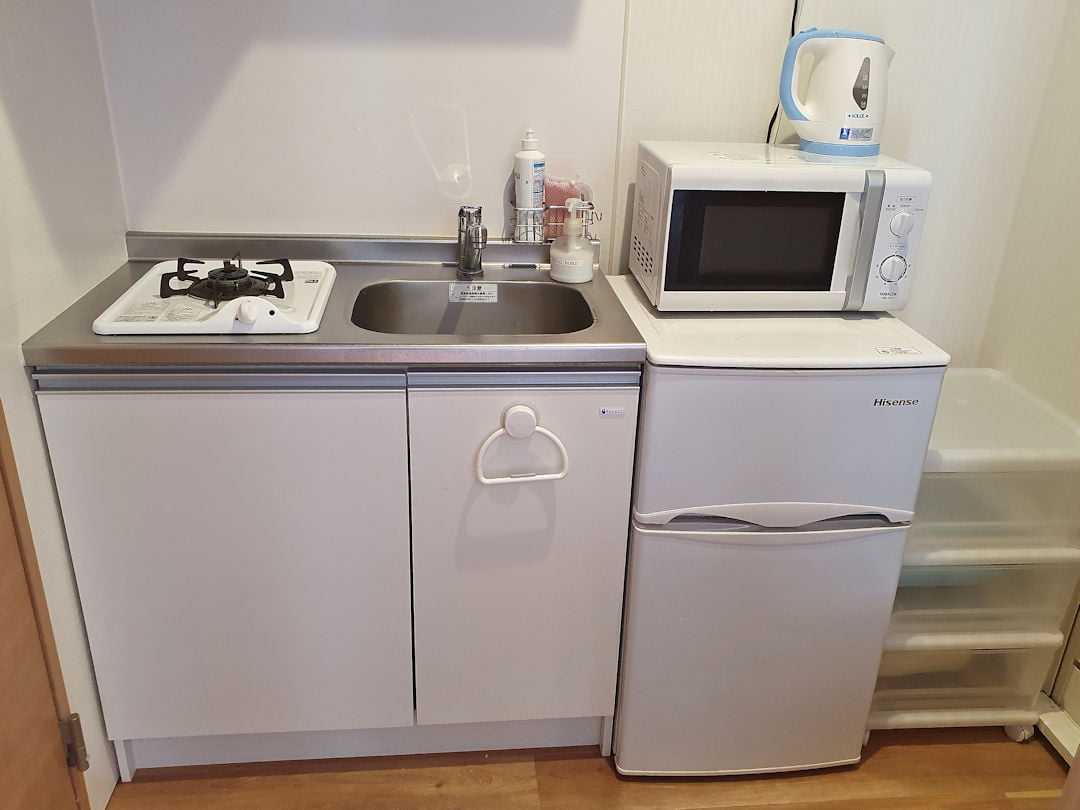
A Japanese apartment kitchen is not big but allows you to prepare your own meals (and save on dining out)
Our transport costs over the three months we explored Japan averaged at JPY1,569 (just under USD12) per person per day .
Given Japan is an island country, we ended up taking two internal flights: The flight from Sapporo, Hokkaido to Nara, Okinawa cost us JPY16,580 each (with Peach Aviation ); while the flight from Nara, Okinawa to Hiroshima on Honshu cost JPY14,460 per person (with ANA ). In both cases unfortunately, we had to check in our travel packs as the strict carry-on limit was seven kilograms.
As we were keen to see the country and had more time to explore Japan than most foreign tourists, we always considered taking slower (and thus cheaper) train options over the Shinkansen. That said, we did want to ride the Shinkansen (and in some cases, there was just no feasible alternative). In the end, we took the bullet train three times: Our Hiroshima to Himeji trip cost JPY8,040 per person ; the Kanazawa to Nagano journey JPY8,590 each and the train ride from Odawara to Tokyo JPY3,280 per person .
The Shinkansen was always markedly more expensive than slower train options. As an example, the distance from Hiroshima to Himeji was 239 kilometres, with a per kilometre cost of JPY33.64 on the Shinkansen, whereas the (slower) Rapid Express train from Himeji to Kyoto – a distance of 127 kilometres – cost JPY2,310 per person or JPY18.19 per kilometre. So if you have time, take the slow train and save money.
And speaking of travelling slowly: If you’re in the Hakone area, make sure to ride the Hakone Tozan Train [ Google Maps location ] between Gora and Odawara. The scenery is stunning, and the train does a number of switchbacks as it journeys down the mountain (or up if you do the trip in reverse) – a very unique experience.
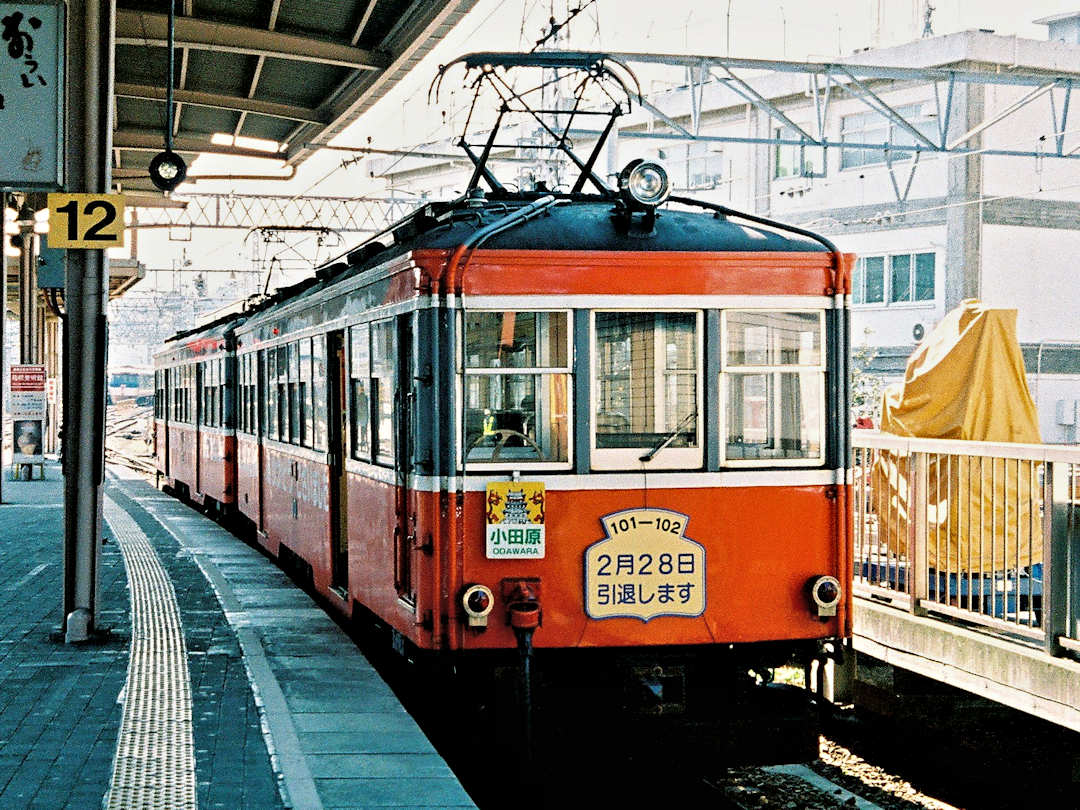
Take the Hakone Tozan Railway for its unique switchbacks down (and up) the mountains | Photo on Wikimedia Commons
Japan boasts an efficient transportation system. But, as we found out, transportation costs add up quickly, especially if you’re travelling a lot around the country.
The Japan-wide JR Rail Pass is a cost-effective option for visitors who plan to move around a lot during their stay. It’s available for 7, 14 and 21 day periods and valid on consecutive days within the chosen timeframe. The pass allows unlimited travel on JR-operated services, including JR trains – even the Shinkansen (just NOT the Nozomi and Mizuho) – and JR-operated city buses. Seat reservations are included with the JR Rail Pass but need to be obtained (free of charge) prior to travel.
The Japan-wide JR Rail Pass can only be purchased by foreigners outside of Japan and must be exchanged for the actual pass upon arrival.
Although the JR ( Japan Rail) Pass is a popular option for foreign tourists visiting Japan , it’s not the only way to save, and it may not even be worthwhile pending your itinerary. To determine if the Rail Pass is worthwhile, use an online route calculator to compare the costs of individual ticket purchases against the price of the pass.
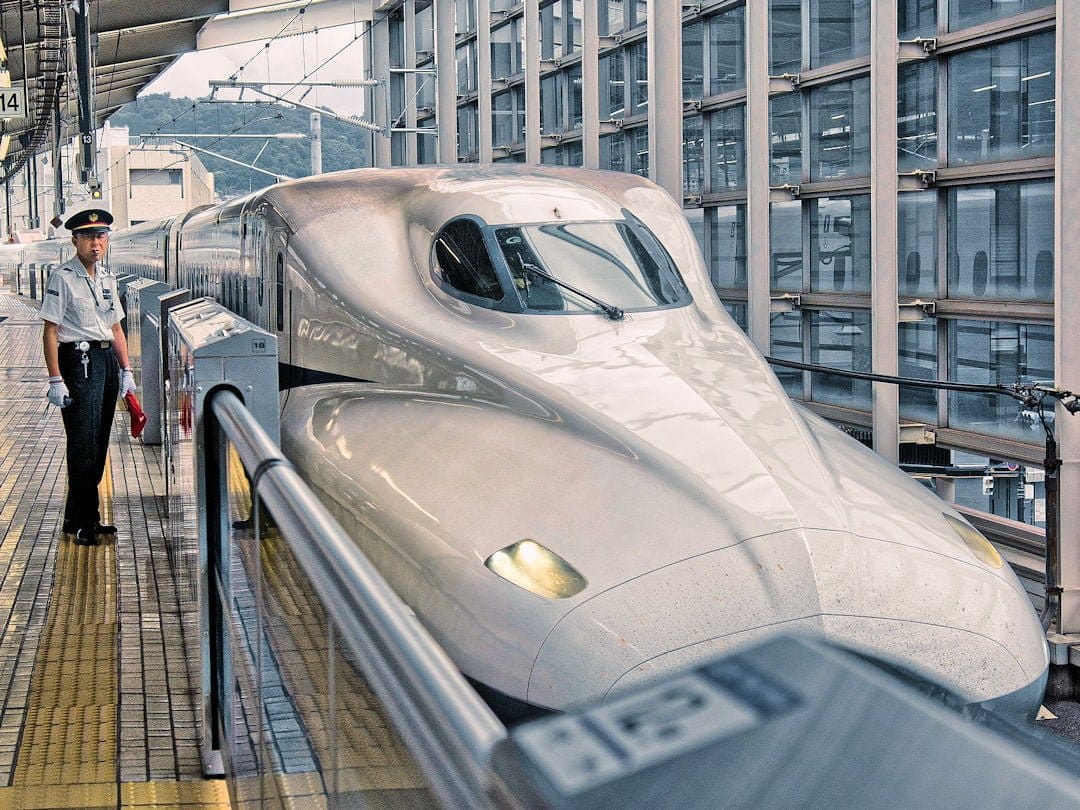
Trains in Japan are (almost) always on time, making train travel easy and convenient | Photo by Armin Forster on Pixabay
If the Japan-wide JR Rail Pass is of no use to you, one (or several) of the many Regional Rail Passes might be worthwhile. A big difference to the Japan -wide Rail Pass: you can buy these passes while already in Japan (though they are slightly more expensive than if you bought them from overseas). Worthwhile options to check out include:
- JR East: the JR Tokyo Wide Pass
- JR West: the Kintetsu Rail Pass, JR West Kansai Area Pass, JR West Kansai Wide Area Pass or the JR Kansai-Hiroshima Area Pass
- JR Central: the JR Takayama-Hokuriku Area Tourist Pass or JR Alpine-Takayama-Matsumoto Area Pass.
Even without any of the rail passes, there are still ways to save on train travel in Japan :
- Shinkansen – Buy a non-reserved seat ticket (where available): This also offers greater flexibility as you’re not bound to a specific train. Which carriages are non-reserved varies from train to train (most often it’s carriages 1-3 or 1-5). Arrive at the platform early to check out where the non-reserved carriages are located and position yourself/queue at the door marker of one of those carriages to increase your chances of getting a seat as you board.
- Alternatives – Opt for Limited Express trains: You may need to change trains along the way, but the trains in Japan are usually on time, and changing trains in Japan is not really stressful, especially if you travel light. Unless you’re travelling during rush hour, Limited Express trains are often less crowded than the Shinkansen, which also means you can save the seat reservation cost (where possible).
Extra tip: In many areas in Japan , you can use an IC card to tap on/off rather than having to purchase individual paper tickets for each journey. This saves time and makes train travel more convenient.
In Japan , you will come across the term IC card a lot (IC stands for Integrated Circuit ). IC cards are essentially plastic cards that can be topped up and the amount stored on the card is used for transportation - simply by tapping on/off at the card reader - and more and more at convenience stores and other places.
Each region issues their own version of the IC card, for example
- If you enter via Tokyo Narita or Haneda Airports, you would buy the Suica Card or PASMO card.
- If you enter via Osaka Kansai Airport, you will find the ICOCA card for sale.
Fortunately, 10 of the most common IC cards (including the two above) can be used across regions (and likely more will be added over time). Some regions (including Nagano and Okinawa prefectures) only allow their own IC card (at this stage) or cash.
Also, note:
- Cards (including any stored funds) will expire after 10 years of non-use, which means you can reuse the card if you return to Japan within that timeframe.
- You can return it (and get a refund of the money on the card plus the deposit you paid for the card itself) - as long as it's in the region you bought it.
- You can load the IC card onto your smartphone - via Apple Pay or Google Pay - but you won't be able to get a refund of your deposit or any funds stored when you leave the country.
Buses can be a good alternative to trains (especially for medium to long-distance travel and on competitive routes). Do note though that while train timetables are (mostly) reliable, buses can be stuck in traffic just like any other road transport (and delays of 30 minutes and more are not unusual).
One way to save on transport costs in Japan is by purchasing a Willer Express Bus Pass . This pass allows you to travel for 3, 5 or 7 days within a period specified by you.
- Advantages: The days of travel do not need to be consecutive, giving you flexibility in your itinerary. Willer Express has a number of night buses which can save on accommodation costs. Additionally, you can easily book your seats in advance online through the user-friendly Willer Express website.
- Disadvantages: The pass can only be used on Willer Express buses and only on the least comfortable 4 seats per row bus types.
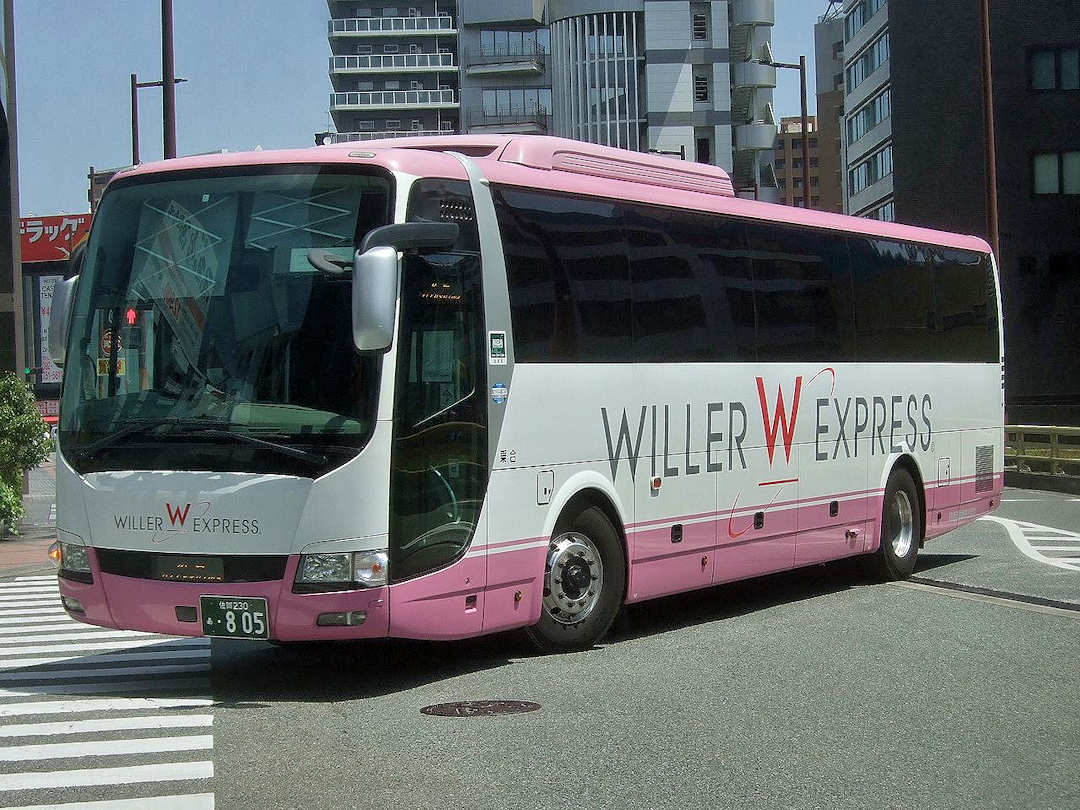
Travellers to Japan may also be able to save on transport costs by using intercity bus services like those provided by Willer Express | Photo on Wikimedia Commons
Even without a bus pass, you can save money when travelling by bus in Japan :
- Avoid backtracking and travel point to point instead – For example, stop in Shirakawa-go on the way from Takayama to Kanazawa (or vice versa) rather than visiting the UNESCO World Heritage site on a day trip – this also reduces carbon emissions.
- Make use of specials – Just ask at the local tourist office at your destination or check the websites of the bus companies operating at your destination, for example Alpico and Nohi Bus in the Japanese Alps. Do make sure though they are worthwhile by comparing individual fares (via Google Maps ) against the special fare.
We always buy travel insurance – because medical expenses overseas can add up quickly and because our carry-on backpacks are pretty much everything we own.
Whenever we buy travel insurance , we make sure we thoroughly read the fine print. It’s tedious, we know. But if you’re planning certain activities (for example, hiring a motorbike or hiking above 3000 metres), it’s crucial to know whether your insurance pays if the worst happens. Otherwise, you may have paid all that insurance premium and are still left to foot a (potentially) massive bill.
For this trip, we used Cover-More. For our three months in Japan , our joint Cover-More Travel Insurance Single Trip International Comprehensive+ Policy cost us AUD1,519/USD1,022 (or just under AUD9/USD6 per person per day) . Although we didn’t need to submit a claim and therefore don’t have first-hand experience of their claims process,we won’t be buying another policy from Cover-More again,

To our surprise, cash is still King in Japan , thus ATM withdrawals are a regular occurence. To avoid unnecessary ATM withdrawal fees we always research before our trips to figure out which overseas bank/s offer/s the best exchange rate and charge/s the lowest fees for ATM withdrawals.
In the case of Japan , we had done all our research. We knew our Bankwest Debit Card charged no foreign transaction fees, and that 7Bank ATMs charged no ATM withdrawal fees. What we didn’t know was that you had to press “Credit” when trying to withdraw with the debit card overseas (Bankwest only told us about that small fact when queried afterwards). After our debit card was declined multiple times, we ran out of time and had to use our credit card. While we had topped up the card with some money beforehand (to avoid nasty cash advance fees), the credit card provider still charged us AUD4 (or JPY382) for the ATM withdrawal. You live and learn.
Unless you’re planning to hike the Kumano Kodo or Nakasendo , you are likely not going to need luggage transfer service. We ended up using luggage transfer twice (both times with Yamato Transport):
- on our final day on the Kumano Kodo , paying JPY2,500 for the same-day transfer of one travel pack from Koguchi to Nachikatsuura; and
- during our Nakasendo hike , paying JPY1,620 for the standard transfer of one travel pack from Osaka to Matsumoto.
We also used luggage storage facilities on occasion to store our travel packs for a few hours or excess luggage during our Kumano Kodo hike for a whole week. Those storage costs added up to JPY3,640 in total ( an average of JPY607 per storage use ).
If you need to store excess baggage in Osaka, we recommend Daikoku Locker . Alternatively, you can try Radical Storage who have agencies all over Japan .
When you explore a country for three months, you will likely need a hair cut (in that country). I had mine at a barber in Osaka about half-way through our trip for JPY2,200 (a bit over USD16) .
We both also took the opportunity to get a 90 and 60 minute massage, respectively, just before the Nagano Marathon at Relaxation Salon Lovina [ Official website , Google Maps location ] for a total cost of JPY13,200 (or JPY6,600/around USD49 per massage ). It was well worth it, and we both would recommend it to anyone visiting Nagano.
Withdrawing cash overseas can be expensive but it doesn’t have to be. We can show you how to avoid unnecessary fees and make your travel budget stretch further.
How do you determine which card is best for your overseas trip? Using the right one can save bank fees and make your travel budget stretch further.
Ever been caught out by the bad FX rates and exorbitant commissions charged by FX bureaus? These tips allow you to minimise these charges in future . We also recommend XE Money Transfer to keep more of your money when you complete a transfer.
When visiting a Shinto shrine, it is traditional and appropriate to make a donation. It doesn’t have to be a lot, especially when you are throwing loose change into the large container before you bow your head and clap your hands. All our donations added up to JPY1,511 .
I wrote this Japan Travel Costs article based on our own unique experience. If you have been to Japan recently as well and you have something to add to the costs for exploring Japan , please feel free to contact us. If you liked my Japan Travel cost tips and found them helpful, I would appreciate it if you could share them with your friends and family via the Share buttons below. Even better, link to the page from your personal blog or social media platforms.
- Media & Industry
- Meetings & Events
- Select Language 简体中文 繁體中文(香港) 繁體中文(臺灣) India (English) Bahasa Indonesia 한국어 ภาษาไทย Tiếng Việt Singapore (English) Philippines (English) Malaysia (English) Australia/New Zealand (English) Français Deutsch Italiano Español United Kingdom (English) Nordic countries(English) Canada (English) Canada (Français) United States (English) Mexico (español) Português العربية Japan(日本語) Global (English)
- India (English)
- Bahasa Indonesia
- Singapore (English)
- Philippines (English)
- Malaysia (English)
- Australia/New Zealand (English)
- United Kingdom (English)
- Nordic countries(English)
- Canada (English)
- Canada (Français)
- United States (English)
- Mexico (español)
- Global (English)
- Fujiyoshida
- Shimonoseki
- Ishigaki Island
- Miyako Island
- Kerama Island
- Tokyo Island
- Koka & Shigaraki
- Hida Takayama
- Ginza, Nihonbashi
- Beppu & Yufuin (Onsen)
- Ginzan Onsen
- Nagasaki Islands

- Kumano Kodo
- Shikoku Karst
- Amami Oshima
- Hachimantai
- Omihachiman
- Aizuwakamatsu

- Diving in Japan
- Skiing in Japan
- Seasonal Flowers in Japan
- Sustainable Outdoors
- Off the Beaten Track in Japan
- Scenic Spots
- World Heritage
- Home Stays & Farm Stays

- Japanese Gardens
- Japanese Crafts
- Temple Stays
- Heritage Stays
- Festivals and Events
- Theater in Japan
- Japanese Tea Ceremony
- Cultural Experiences in Japan
- Culture in Japan

- Local Cuisine Eastern Japan
- Local Cuisine Western Japan
- Local Street Food
- Japan's Local Ekiben
- Japanese Whisky
- Vegetarian and Vegan Guide
- Sushi in Japan Guide
- Japanese Sake Breweries

- Art Museums
- Architecture
- Performing Arts
- Art Festivals
- Japanese Anime and Comics
- Japanese Ceramics
- Local Crafts

- Scenic Night Views
- Natural Wonders
- Theme Parks
- Samurai & Ninja
- Iconic Architecture

- Wellness Travel in Japan
- Japanese Ryokan Guide
- A Guide to Stargazing in Japan
- Relaxation in Japan
- Forest Bathing (Shinrin-yoku)

- Experiences in Japan
- Enjoy my Japan
- National Parks
- Japan's Local Treasures
- Japan Heritage
- Snow Like No Other
- Wonder Around Japan

- Visa Information
- Getting to Japan
- Airport Access
- COVID-19: Practical Information for Traveling to Japan
- Anime Tourism
- Countryside Stays
- Accessible Tourism
- Hokkaido Great Outdoors
- Scenic World Heritage in Tohoku
- Shikoku’s Nature and Traditions
- Southern Kyushu by Rail

- Traveling by Rail
- How to Travel by Train and Bus
- JR Rail Passes
- Scenic Railways
- Renting a Car
- Sustainable Travel in Japan
- Travel Brochures
- Useful Apps
- Online Reservation Sites
- Eco-friendly Accommodation
- Luxury Accommodations
- Traveling With a Disability
- Hands-free Travel
- How to Book a Certified Tour Guide
- Volunteer Guides
- Tourist Information Center

- Japanese Manners
- Spring in Japan
- Summer in Japan
- Autumn in Japan
- Winter in Japan
- Cherry Blossom Forecast
- Autumn Leaves Forecast

- Japan Visitor Hotline
- Travel Insurance in Japan
- Japan Safe Travel Information
- Accessibility in Japan
- Vegetarian Guide
- Muslim Travelers
- Safety Tips

- JAPAN Monthly Web Magazine
- Arts & Cultures
- Nature & Outdoor
- Festivals & Events
- Insider Blog
- Things to do
- Local Guides
- Food & drink
- Traditional
- Hokuriku Shinetsu

My Favorites
${v.desc | trunc(25)}
Planning a Trip to Japan?
Share your travel photos with us by hashtagging your images with #visitjapanjp
GUIDE Guide to Traveling Japan on a Budget A guide to budgeting your trip to Japan
- Stories & Guides
- Guide to Traveling Japan on a Budget
Plan in advance to make your trip to Japan affordable
You may have heard that Japan is an expensive place to visit, but don't be discouraged. With some advance planning, Japan is an affordable destination for even the most budget-conscious traveler. Take some time to decide which options best suit your budget.
There are a wide variety of budget accommodation options, transportation passes and sightseeing discounts available. Browse our list for more details.
Transportation
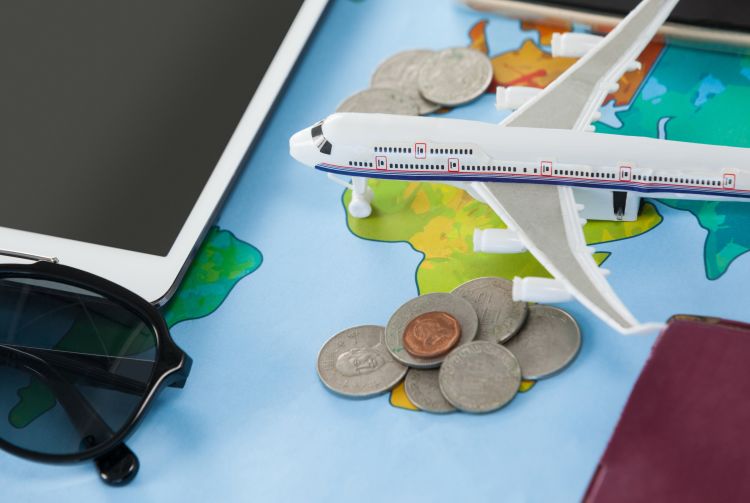
Long distance buses
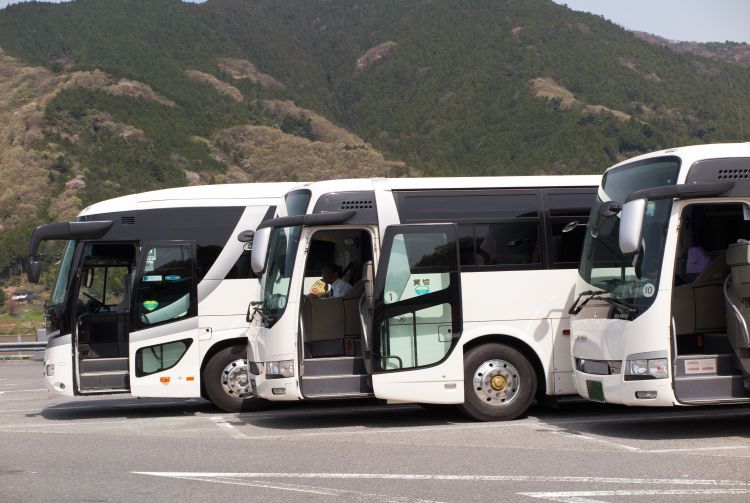
Ferries and passenger boats
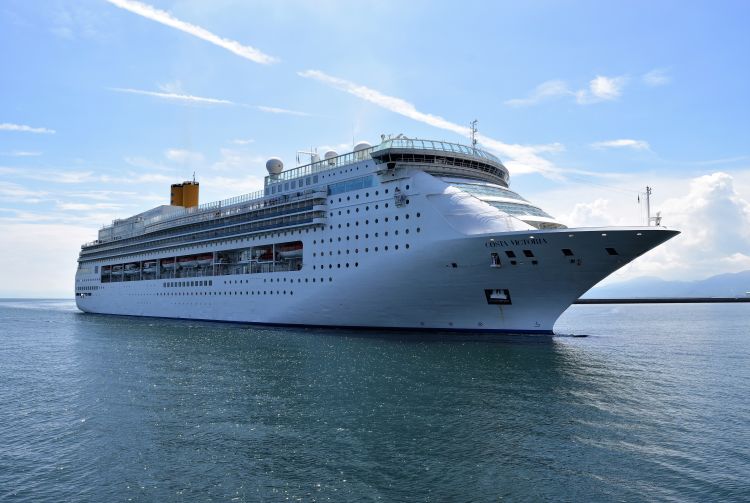
Accommodations
Dining out in Japan doesn't have to be expensive, and is often better value for money than most other world capitals. Wherever you travel, restaurants in popular tourist areas will always cost more. Follow the locals and you will generally find both lower prices and more authentic Japanese cuisine. Avoid restaurants that don't list their prices outside the door. Budget dining can usually be enjoyed at more casual establishments such as izakaya (Japanese pubs), shokudo (small casual restaurants, often with set meals), kaitenzushi (conveyor belt sushi) and okonomiyaki restaurants.
Comparing Prices
Improvements in the foreign exchange rate mean more favorable prices for overseas visitors to Japan. The price chart on this page is designed to give an idea of what you can expect to pay for a variety of everyday and travel-related items in Japan.
The latest information may differ, so please check the official website.
* The information on this page may be subject to change due to COVID-19.
- Story & Guide
- Travel Tips
Did this information help you?
out of found this information helpful.
Thank you for your feedback.
Recommended for you.

Please Choose Your Language
Browse the JNTO site in one of multiple languages

Japan travel budget calculator
What will exactly cost my trip to Japan? Every prospective tourist for the archipelago wondered about the amount necessary to plan a travel in their dream country.
Kanpai’s Budget Calculator provides a precise estimate of the travel expenditures item-by-item, with numerous possible choices. As a matter of fact, a backpacker’s 10-days trip will not cost the same as a 3-weeks stay for a family looking for a very comfortable trip.
Fill in the questionnaire below to discover the expenses to expect and many advices on how to keep the cost down.
How much should I budget to go to Japan?
- Number of Travelers
- Your Travel
- Itinerary & Transportation
- Accommodation
- Outings & Shopping
April, July and August are peak touristic seasons: many services are more expensive during these periods. Consider traveling in January, February, March, May, June, September, October, November or December to keep your costs down.
- Flights and Airports
- Transportation
- Internet & Phones
- Budget and money
- Japanese Food
- Visit with Kids
- Seasons: spring / summer / autumn / winter
- Weather forecast
- Time in Japan
- Holidays & Festivals
- Natural Disasters
- Customs and Duties
- Works and Closures
- June 6 -- Beginning of the rainy season (Tsuyu) in Japan
- June 21 -- Summer starts in Japan
- From July 1 to 31 -- Gion Matsuri Festival in Kyoto with float processions on July 17 and 24
- July 1 -- Season start for climbing Mount Fuji
- July 15 -- Sea day / Umi no Hi in Japan (holiday)
- July 17 -- Tokyo Day
- Tokyo : Shinjuku , Shibuya , Harajuku , Asakusa , Akihabara , Odaiba , Ikebukuro , Ueno , Roppongi , Chiyoda , Ryogoku ...
- Around Tokyo: Kamakura , Nikko , Hakone , Mount Fuji , Mount Takao , Yokohama ...
- Kansai: Kyoto , Nara , Osaka , Mount Koya , Himeji , Kobe , Kinosaki , Kumano Kodo , Ise ...
- Japanese Alps: Kanazawa , Matsumoto , Takayama , Shirakawa-go , Nakasendo ...
- West: Hiroshima , Miyajima , Shikoku , Onomichi , Naoshima , Izumo , Kurashiki , Matsue ...
- South: Kyushu , Okinawa , Yakushima ...
- North: Hokkaido , Tohoku ...

- Temples and Shrines
- Gardens and Parks
- Hiking and Trekking
- Observation Decks
- Public Baths (Onsen and Sento)
- Festivals (Matsuri)
- Amusement Parks
- Visit on a Budget / Luxury

Keikaku is a travel agency specialist of Japan and providing different kind of services:
- Japan Rail Pass
- English speaking Guides
- Pocket Wi-fi
- Japan Nightlife
- Working in Japan
- Religion and Spirituality
- Arts and History
- Movies / Animated Movies
- Japanese Music
- Studio Ghibli
- Photos / Videos
- Weird Japan
- Translations
- Kana & Kanji
- Japanese Swear Words
- Honorific Suffixes (san, kun, chan...)
- Introducing yourself
- Thank you / Apologize
- Count / Say Your Age
- Say the Date / Tell the Time
- Happy birthday
- Enjoy Your Meal
- Writing your name

Kanas are the much-needed basic characters of written Japanese language. Memorize them at a fast pace with our method.

Ask any kind of question and share your knowledge about Japan in Kanpai’s community space, our Q&A section Kotaete.

Isshoni means "together" in Japanese: share your trip details (dates, places you would like to visit) and find companions to travel in Japan.

Create your Kanpai account to manage your profile and view your participation history (questions, answers).

Budget Travel in Japan – Ultimate Backpacking Guide [2024]
- Last Updated: February 5, 2024
From seeing up close the famous Mt Fuji, exploring the architecture of Japanese castles to slurping down the best bowl of ramen you ever had, all these epic memories to-be-made are possible even with our guide to budget travel in Japan .
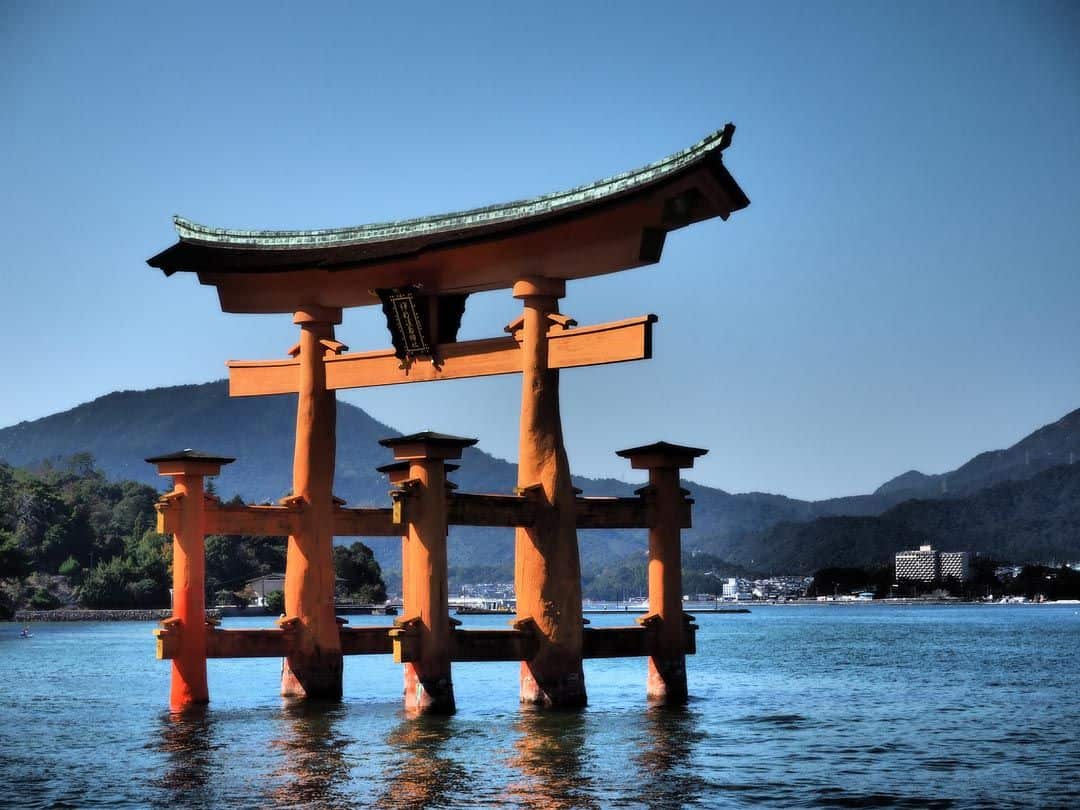
Today’s Japan is a fascinating example of blending the ancient traditions and modern day culture.
Throughout the country you’ll witness dynamic mountainscapes in stark contrast to futuristic cities that are inspiring new trends in architecture worldwide.
It’s also thought of to be notoriously expensive but we managed to travel to Japan on a budget, and so can you.
Table of Contents
Get A JR Rail Pass
Take some flights, deals in hiroshima, deals in osaka, deals in kyoto, deals in tokyo, cheap eating and drinking in japan, save this pin for later, budget travel in japan.
Japan has had a reputation as being expensive for a very long time, people paying hundreds of dollars for a piece of Kobe beef or a sliver of the finest blue fin tuna.
Prices of hotels can be among some of the most expensive in the world. Public travel, whilst incredibly reliable, can sometimes be quite expensive.
Well, some of this is true and some of it is a little more than a rumour that we have all perpetuated. Many people are put off traveling around for a long period of time because of the belief that the costs will be astronomical.
This isn’t always the case.
We have just finished 1 month of travel in Japan and it is comfortably cheaper than Australia, New Zealand, Western Europe and in some cases is even cheaper than China!
It sounds crazy, but here are a few really simple tips for budget travel in Japan that will save you some dollars on your next trip.
Note – At time of travel $1 USD was equal to about 110 Japanese Yen.
READ MORE: Don’t miss our brand new complete guide to help you travel to Japan!
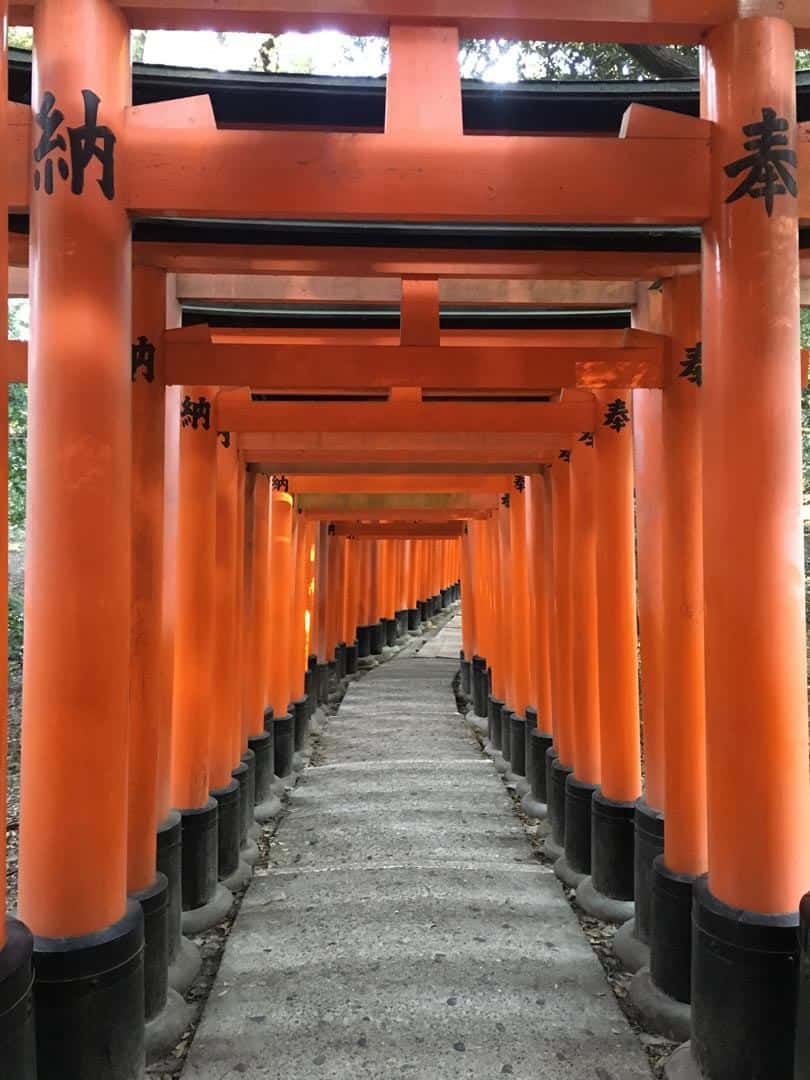
This is a no-brainer. Anyone travelling between cities in Japan should consider investing in one of these.
However be very careful about which JR pass you choose as you could end up spending more than you need to.
I’ll use our situation as an example.
We spent our first 12 days figuring out an excellent Hokkaido itinerary , which is absolutely incredible and definitely our favourite part of Japan. From Sapporo we flew down to Hiroshima .
From here we planned to go on to Miyajima, Osaka, Himeji, Nara, Kyoto and Tokyo.
A few of these were day trips and a few were for a bit longer, but as you can see we had a lot of travel ahead of us.
A regular JR pass that allows travel across the whole country costs 29,100 yen. This is incredibly reasonable. If you take a train from Tokyo to Kyoto, throw in a day trip to Nara and you’ve started saving money.
Our plan was as follows:
- 3 days – Hiroshima and Miyajima
- 2 days – Osaka
- 1 day – Himeji
- 1 day – Nara
- 4 days – Kyoto
- 5 days – Tokyo
We decided to purchase a Kansai-Hiroshima pass through JR West for 13,500 yen per person.
We activated this when we travelled from Hiroshima to Osaka. We used it for our day trips to Himeji, Nara and our trip to Kyoto. We then travelled from Kyoto to Tokyo by night bus for 6500 yen per person.
A total of 20,000 yen, 9000 yen less than a 7 day rail pass.
We would not have had time to do everything we wanted to do around Kansai and get to Tokyo in 7 days. Hence why we elected to go this route.
The JR pass website states that a JR pass cannot be used on the Nozomi or Mizuho trains. However if you purchase ANY JR west railway pass, which ours was, you can use these trains. This is great for longer routes, notably Hiroshima to Osaka/Kyoto.
Plan where you want to go and what you want to see and then search on the Klook website to find the pass that best fits your plan.
You could end up saving yourself a lot of money.
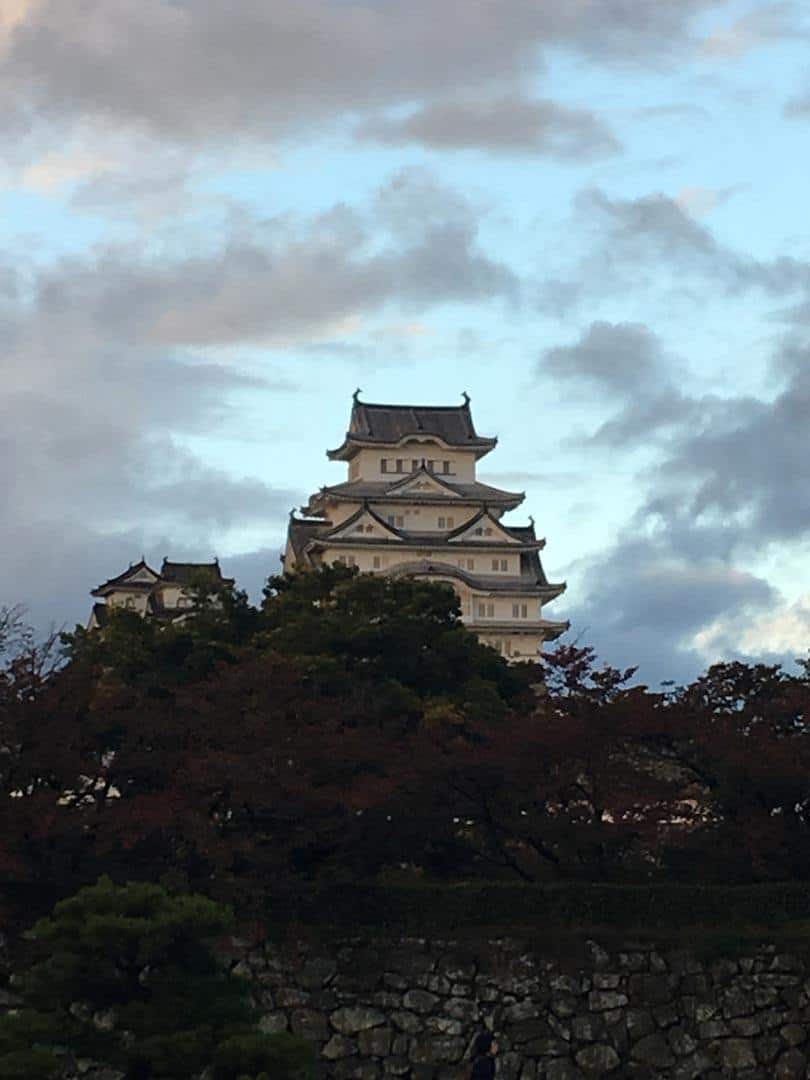
I read about this little deal on the amazing website Japanguide , a must for anyone planning a trip to the land of the rising sun.
In essence, this deal covers cheap flights all over Japan for any visitors to the country. It’s advertised as a 10,000 yen deal however there are some flights that are cheaper and some that are slightly more expensive.
We paid 10,000 yen each to fly from Sapporo to Hiroshima. If we were to booked these flights without this deal it would cost us closer to 50,000 yen per ticket.
There are two airlines that participate in this amazing deal: JAL and ANA. We ended up flying with ANA and it was great.
One thing to remember is that for this to work you usually have to book from outside Japan. As always in Japan there are a variety of deals.
The deals that we researched are linked below, but the link above has information on all of the deals available.
- JAL – Japan Explorer Pass
- ANA – Experience Japan
Both of these links take you straight to the booking page where you can research and compare prices. This deal is a must for anyone looking to get away from the Tokyo-Kyoto-Osaka route. This saved us a huge amount of money.
Day Passes for Attractions
Many of Japan’s cities have a variety of day passes allowing giving unlimited rides and even discounts to various attractions. This is a lifesaver for budget travel in Japan.
In Hiroshima you can purchase a 1 day street car and ferry pass for 840 yen. This is a great option if you are doing Miyajima as a day trip.
- Street Car to Miyajimaguch i = 280 1 way – total of 560
- Ferry to Miyajima = 180 yen 1 way – total of 360
- 560+360 = 920
This also means that you can use the streetcars to get around in the evening as your legs will be knackered after a day in Miyajima.
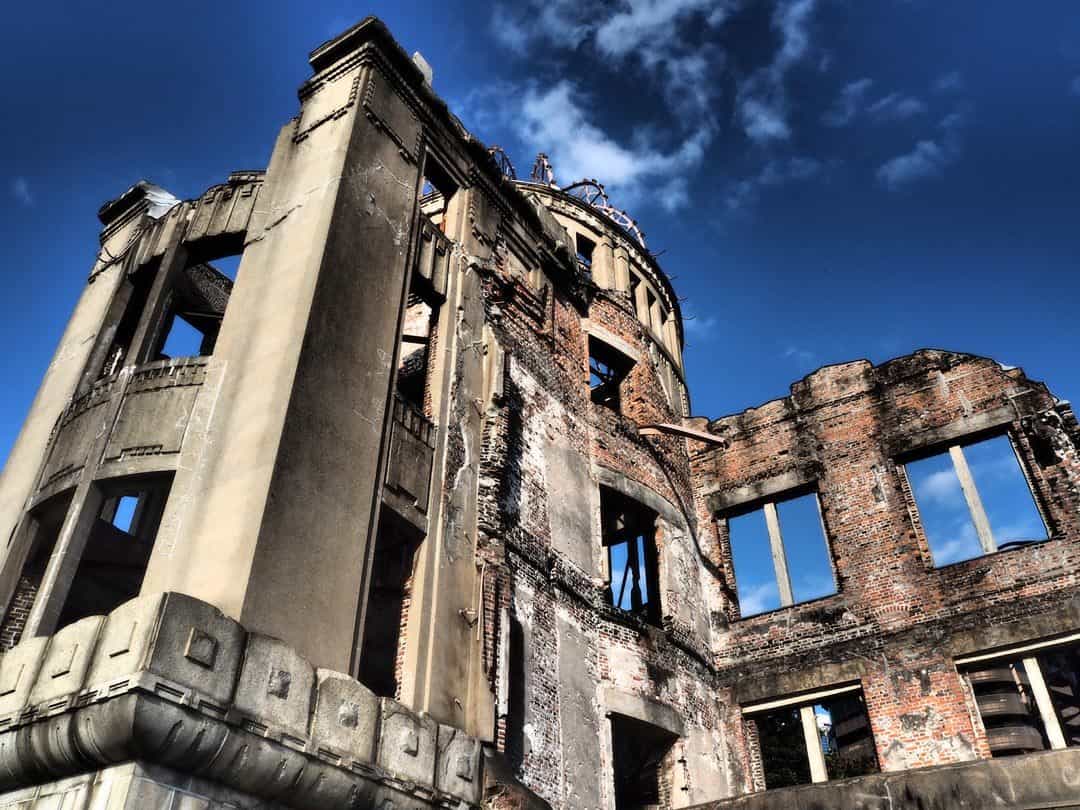
In Osaka you can pick up the “Osaka Amazing Pass” that covers subway and entry in a huge number of attractions for one day.
When we used it we headed to Osaka Castle, did the HEP5 ferris wheel, went to the top of the Umeda tower and took in an evening cruise (which was not that great to be honest).
It costs 2500 and it ended up saving us 2500 yen in transport and entrance fee’s definitely worth it.
Possibly the most popular tourist destination in Japan (it certainly felt that way when we were there).
Kyoto’s subway system is quite useful for accessing Northern Higashiyama and the city centre, but other than that it’s the bus and JR that are king.
However the JR routes to Arashiyama and Inari are very cheap so it’s not worth activating a rail pass just for this. Save it for intercity travel.
Kyoto’s bus network is both extensive and convenient. For 500 yen you can pick up an all day bus. You end up saving money if you take 3 or more buses. With Kyoto’s sites spread all over the city, this will not be a problem.
Here’s our list of the best things to do in Kyoto .
Japans greatest urban metropolis has one of the most impressive and confusing transportations systems on planet earth. The truth is there are huge number of tickets. Outlines of all of them are listed here .
Suica: This is just a simple subway card, like the oyster card in London or the octopus card in Hong Kong. You need to pay a 500 yen deposit for the card, but this is returned to you when you return the card at the end of your trip. Also the fares a few yen cheaper than if you buy tickets at the machine. They can be used on every line in Tokyo.
All Day Pass: There are 2 all-day pass options. The all-day metro card for 600yen which can only be used on the Tokyo metro, or you can include the Toei lines for 1500yen.
We found the all-day metro card fantastic value. If you take 4 trips you will be saving money. Just remember, neither of these passes include the JR lines, so sometimes the journeys are a little longer.
While you’re at it, check out these great things to do in Tokyo.
Eating out in Japan can be extremely cheap, in some case it was far cheaper than eating similar food in Beijing. Obviously eating out can be as cheap or as expensive as you wish, but here is a very rough price guide based on 2 people eating.
- 500-1000 Yen – Bento boxes – can be brought from any convenience store
- 1000-1500 Yen – Ramen and Udon
- 1500-2000 Yen – Katsu Curry
- 2000-3000 Yen – Tempura Sets
- 3000-5000 Yen – Yakiniku (Japanese BBQ), Izakaya/Yakitori (Japanese style pub serving sticks of meat, sashimi and other wonderful delights), Sushi and Sukiyaki (type of Japanese hot pot)
This is not a definitive list, but it’s generally a good guide as to what type of food is generally cheaper or more expensive.
The big thing that raises the cost of meal is alcohol. A couple of draft beers would generally add at least 1000 yen to the bill. So an easy way to save is to limit your alcohol intake.
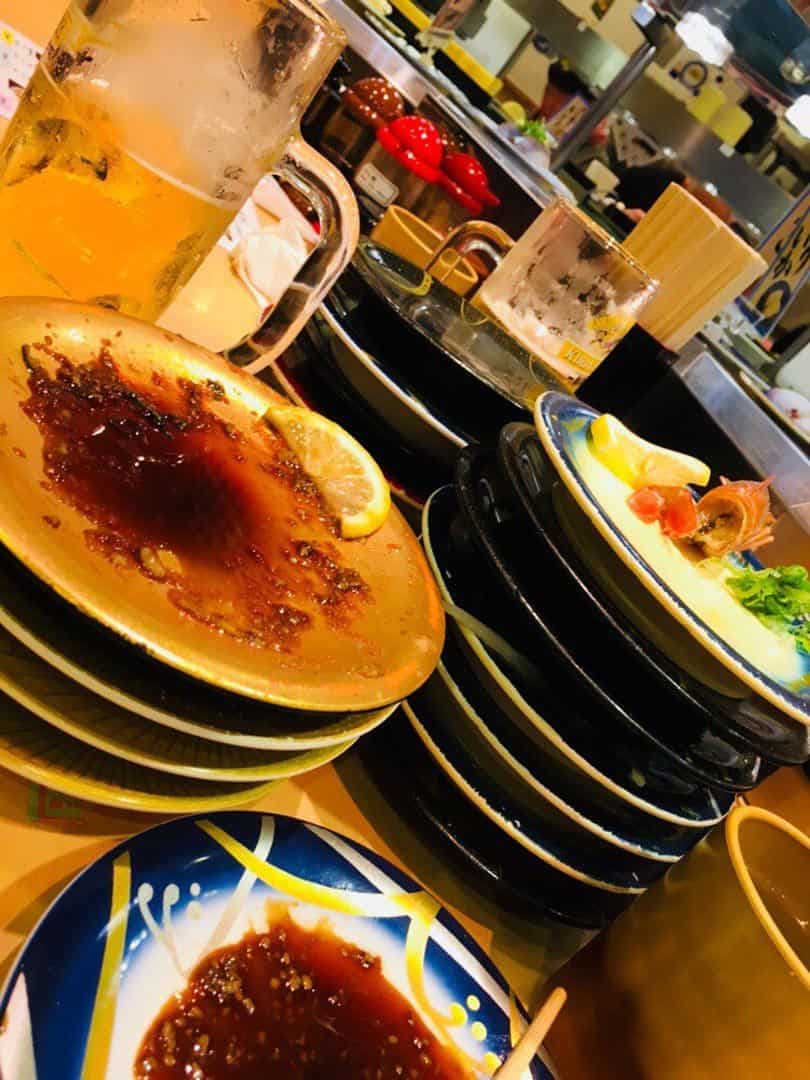
Budget Accommodation in Japan
Accommodation is usually the most expensive part of any trip.
Hokkaido – Booking.com and agoda.com offered us the best rates for anything outside Sapporo. In this region of Japan AirBnB is can be pretty pricey. In the national parks it can be around 9000yen per night, with breakfast included. However this is offset by the cost of food being much cheaper than other parts of Japan.
Hiroshima to Tokyo – Here AirBnB was generally cheaper and that was what we used the majority of the time. We managed to rent entire apartments for half the price of a hotel room in Hokkaido.
Another thing to be aware of is that paying for 2 beds in a dorm is usually more expensive that getting a room in a hotel or guesthouse, so plan accordingly.
Sign up using our AirBnB link to get $50 credit to go towards your first booking and make help make your trip even cheaper.
In truth Japan is much more affordable than people would believe. Hope you found this useful. Head over to www.abearandapig.com to see more of what we do.
That’s it for our guide to budget travel in Japan. Please leave a comment below if you found this article useful, or if you have anything else to add.
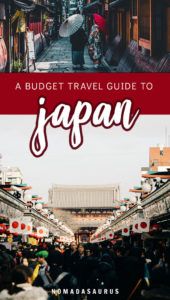
Richard Barnes
Hi, We’re Alesha and Jarryd!

We’ve been traveling the world together since 2008, searching for the planet’s best destinations and adventures.
Love Travel?
Sign up for our free weekly newsletter for the best travel tips, ideas and deals!
We respect your privacy. Unsubscribe at any time.
READ MORE...
19 BEST Things to Do in Osaka, Japan [2024 Edition]
The Perfect 3 Days in Tokyo Itinerary
The Best Day Trips from Every City in Japan [2024]
Related Posts
18 amazing things to do in nara, japan (2024 edition), 7 best day trips from osaka, japan (2024 travel guide), 17 awesome things to do in hiroshima, japan, 19 incredible things to do in takayama, japan [2024 guide], 6 thoughts on “budget travel in japan – ultimate backpacking guide [2024]”.
People may think that Japan is very expensive, but there are many ways to travel in there very cheaply if you know some “secrets” like right organizations where you can get some very unbelievable travel deals 😉
What kind of organizations would those be?
Thanks for sharing this kind of information Thanks for the tips I’ve always enjoyed traveling, the idea of seeing the world fascinated me, but I was never able to take a very long trip
Thank you for your comment Luana. Travelling is definitely amazing in so many ways. Hope you can travel where you want to soon and stay for a long trip and immerse yourself in the country and the people. Happy travel planning 🙂
I love to visit this places in japan this year..Thanks for sharing such kind of information..I think Travelling is the most important way to enjoy life and know something different from your routines..
We agree. Travel is amazing. Have a great trip.
Leave a comment Cancel reply
Save my name, email, and website in this browser for the next time I comment.

Borders Of Adventure
Leading Culture and Adventure Travel Blog by Becki Enright. Looking at the world with a different angle to change perceptions of misunderstood places, for the best in travel.
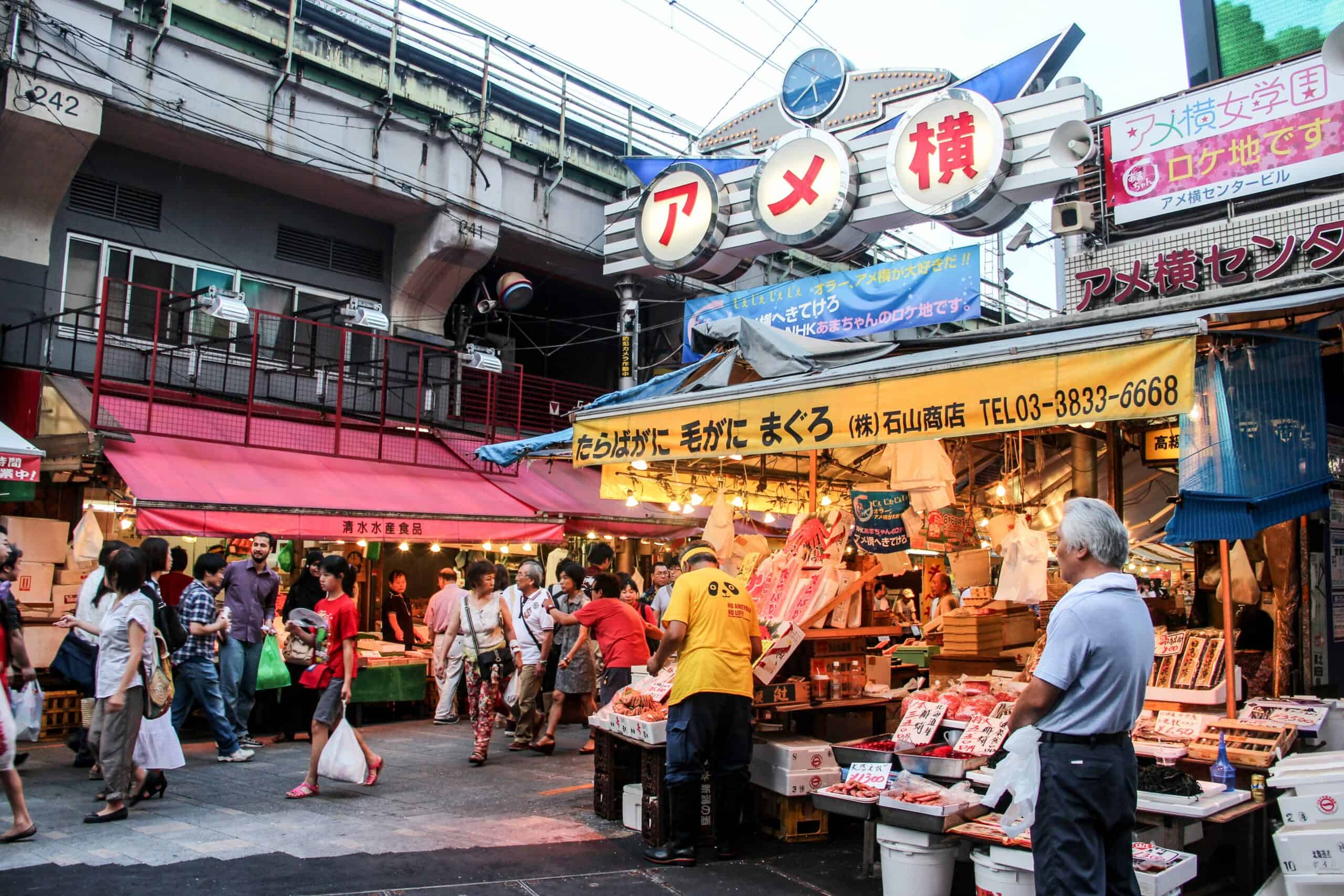
Cultural Travel , Japan
How Much Does It Cost To Travel In Japan? Budget Trip Tips and Worthwhile Expenses
Disclaimer: This post contains affiliate links to handpicked partners, including tours, gear and booking sites. If you click through or buy something via one of them, I may receive a small commission. This is at no extra cost to you and allows this site to keep running.
The cost of travelling in Japan is not as much as you think if you plan well. This guide on Japan trip costs has budget tips and breakdowns for transport, bookings, and accommodations across the country.
Knowing that Japan has a higher cost of travel can be offputting, but the expense is secondary to the experience. Whether you want to soak up the bright lights and the distinct buzz of the big cities like Tokyo and Osaka, wander the old, narrow wooden housed lined alleyways of Kyoto, stroll through the scenic smaller towns of Kobe and Nara, or relax within the beach towns and mountain ranges of the peninsulas and islands, Japan is vast and full of natural beauty and endless changing scenery.
Aside from where to go and what to do, the questions of ‘Is Japan expensive?’ and ‘How much does a trip to Japan cost?’ are always at the fore. So I will cut to the chase—travelling here is more costly than in its Asian neighbours. Yet, by pre-booking rail passes and planning your rough route and associated bookings, you’ll save yourself some money.
This Japan travel cost breakdown will help you plan your trip, calculate your estimated Japan budget and see exactly where your money goes.
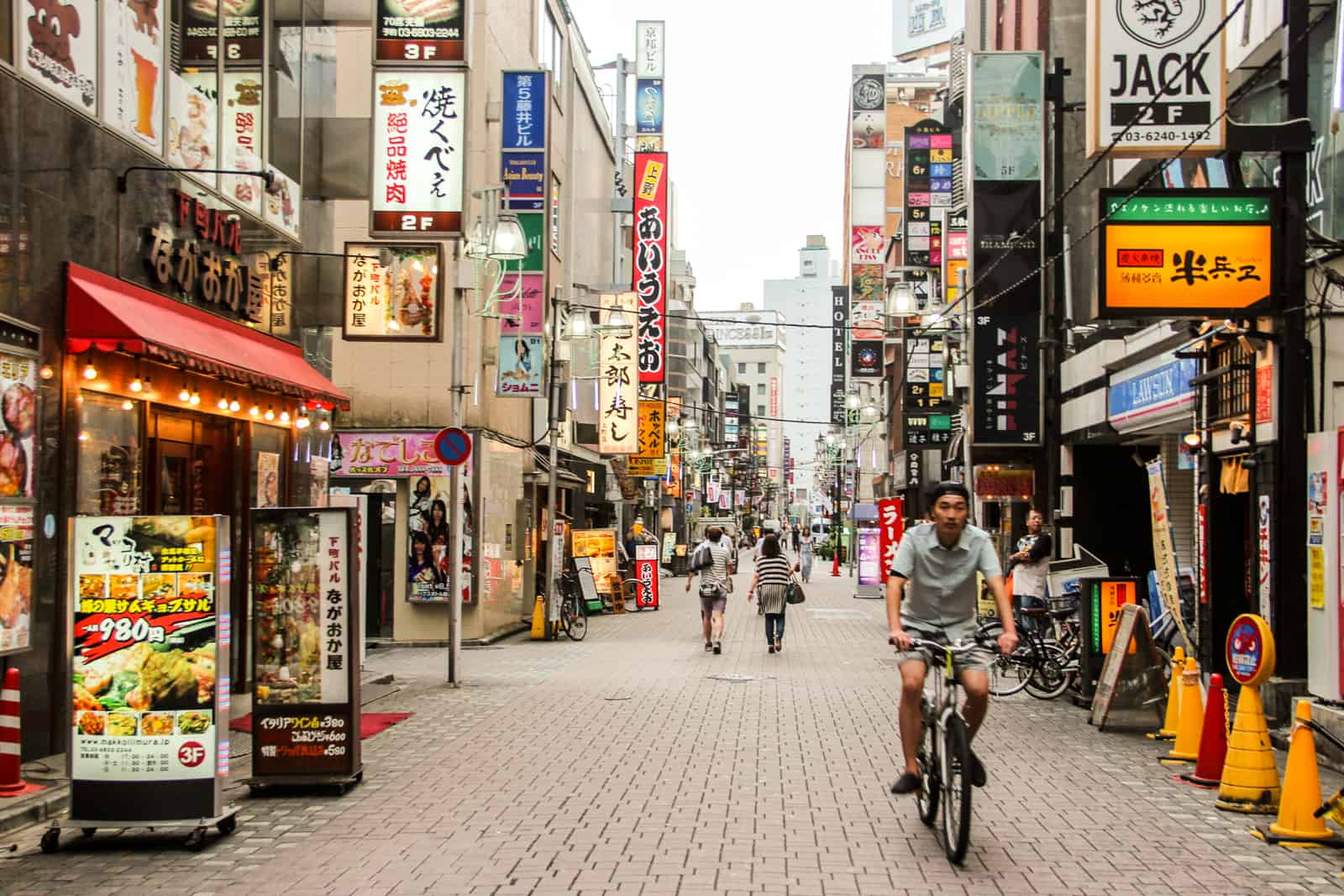
How Much Does It Cost To Travel In Japan? Save with these budget trip tips.
First, Plan How Many Days to Spend in Japan
When is the cheapest time to travel to japan, how much does a japan trip cost in comparison to the rest of asia, japan budget per day, per week, per month, cost of a two-week japan vacation, how much money do you need per day in japan, cost of travelling in japan for one month , standard train prices in japan, 7-day japan rail pass, 14-day japan rail pass, 21-day japan rail pass, buying a japan rail pass , local trains in japan, japan metro and bus system, taxis in japan, bike hire in japan, cost of food in japan, tokyo accommodation costs, mount fuji area accommodation costs, ito accommodation costs, kyoto accommodation costs, nara accommodations costs, osaka accommodation costs, kobe accommodation costs, hiroshima accommodation costs, book a hotel in japan, cost of tours in japan, how much do attractions cost in japan, planning a trip to japan and want to budget pin it.
Of course, the length of your Japan itinerary determines your budget. Typically, visitors spend two weeks in Japan on their first visit, hopping between the major cities and associated landmarks and sites.
I spent four weeks in Japan, travelling entirely via overland transportation. I wanted to immerse myself in the culture, see a range of different places, and spend a quality amount of time in areas that are both key highlights and some of the biggest areas to explore – Tokyo (one week), Kyoto (six days) and Osaka (three days), time to climb Mount Fuji, and to cross the country and get down to Hiroshima.
Yet in one month, I didn’t get to explore the far northern regions of Japan, the Alps, anywhere further south than Hiroshima, nor the outlying islands, which would have meant having to budget for an internal flight.
The country is much bigger than you think, and seeing it all on a single visit is impossible.
- What is Tokyo Like? Things to Love About Japan’s Capital City
- Climbing Mt Fuji – Summiting Japan’s Sacred Peak
- What to Do in Osaka – The Rebellious, Eccentric, and Brash City
- Things to Do in Hiroshima – A City With Unforgettable History
READ ALL: On my Destination Page for Japan .
The best times to visit Japan are March to May (for the spring season) and September to November (for autumn). Therefore, it’s a good idea to look for flights to Japan and accommodation deals during the off-season: November to March. The summer months from June to September (especially July and August) can be unbearably hot and uncomfortable for travel and sightseeing.
The official climbing season for Mount Fuji is also between July and September, which is a big factor for a lot of visitors wanting to hike.
Japan is one of the most expensive countries to travel to in the Asia region. For that reason, many people choose not to travel there in favour of the more established and budget-friendly Southeast Asian routes.
Backpackers and hardcore travellers are a minority here; most Westerners are those just visiting on business. Visitor numbers, however, are growing. Japan’s tourism industry has one of the fastest growth rates annually. Since Japan was one of the last countries to open following intense pandemic measures, exponential visitor numbers continue.
In reality, Japan isn’t going to get any cheaper; in fact, it may get even more expensive – and avoiding Japan for cost reasons alone means missing out on what is rated as an absolute must-see destination.
In the Southeast Asian countries of Cambodia, Laos, Vietnam, Thailand, and Myanmar, you can expect to spend an average of £500- £600 / $800-$950 + a month on a budget. China, Taiwan, and Nepal cost approximately the same, and South Korea is slightly higher, depending on transport options and the number of activities undertaken.
A step up from that are destinations like Mongolia, Borneo, Singapore, and Malaysia, where your budget would stretch closer to £800 / $1,300+ over a month because they are places with stronger economies, where prices are naturally higher, or where activities and attractions are harder to reach or organise on your own.
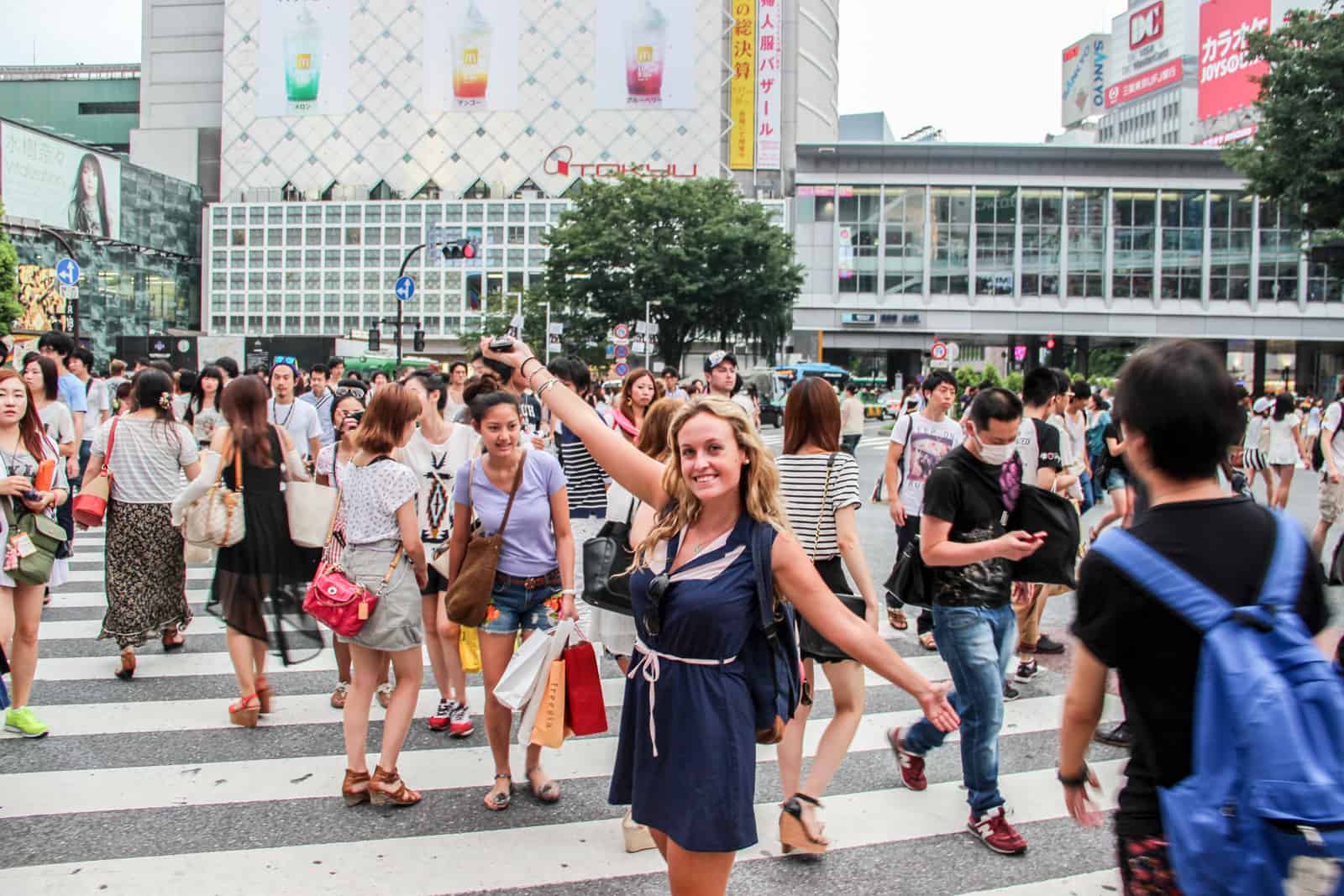
Japan is expensive when it comes to travelling in Asia. But it’s worth the cost.
Trip Cost by Length of Visit
In Japan, independent travel was much easier than I had originally thought. Hostel options were plentiful, local food outlets were cheaper than larger restaurants, and the transport was cost-effective.
But where does your money go in Japan, and what is the spending ratio?
Estimated calculations from 2024: based on transport, accommodation, and food expenses. All variations include the cost of a 7-day and 21-day Japan Rail Pass (following its recently hiked prices).
- Japan trip cost for one month
- £1,900 / $2,400
- £550 / $695
Based on the average vacation time of two weeks, you need to budget at least $1,400.
Around one-third of that will be spent on a 14-day Japan Rail Pass.
Since there’s no set amount of time to travel in the country, with some even visiting as a layover in Tokyo, it can be easier to calculate a daily budget spend in Japan.
Japan on a budget – 15,000 Yen per day (£80 / $100)
Those looking to stay in hostels, eat cheaper meals, and not frequently indulge in nightlife.
Japan on a mid-budget – 20 ,000 Yen per day (£100 / $130)
For those wanting to stay in low-cost hotels, enjoy the restaurant scene, nights on the town, and the odd activity/experience splurge.
Japan on a high-end budget – 25,000 – 40,000 Yen per day (£130-£200 / $165-$250)
For those wanting more luxury, the best cuisine in town and first-class train tickets.
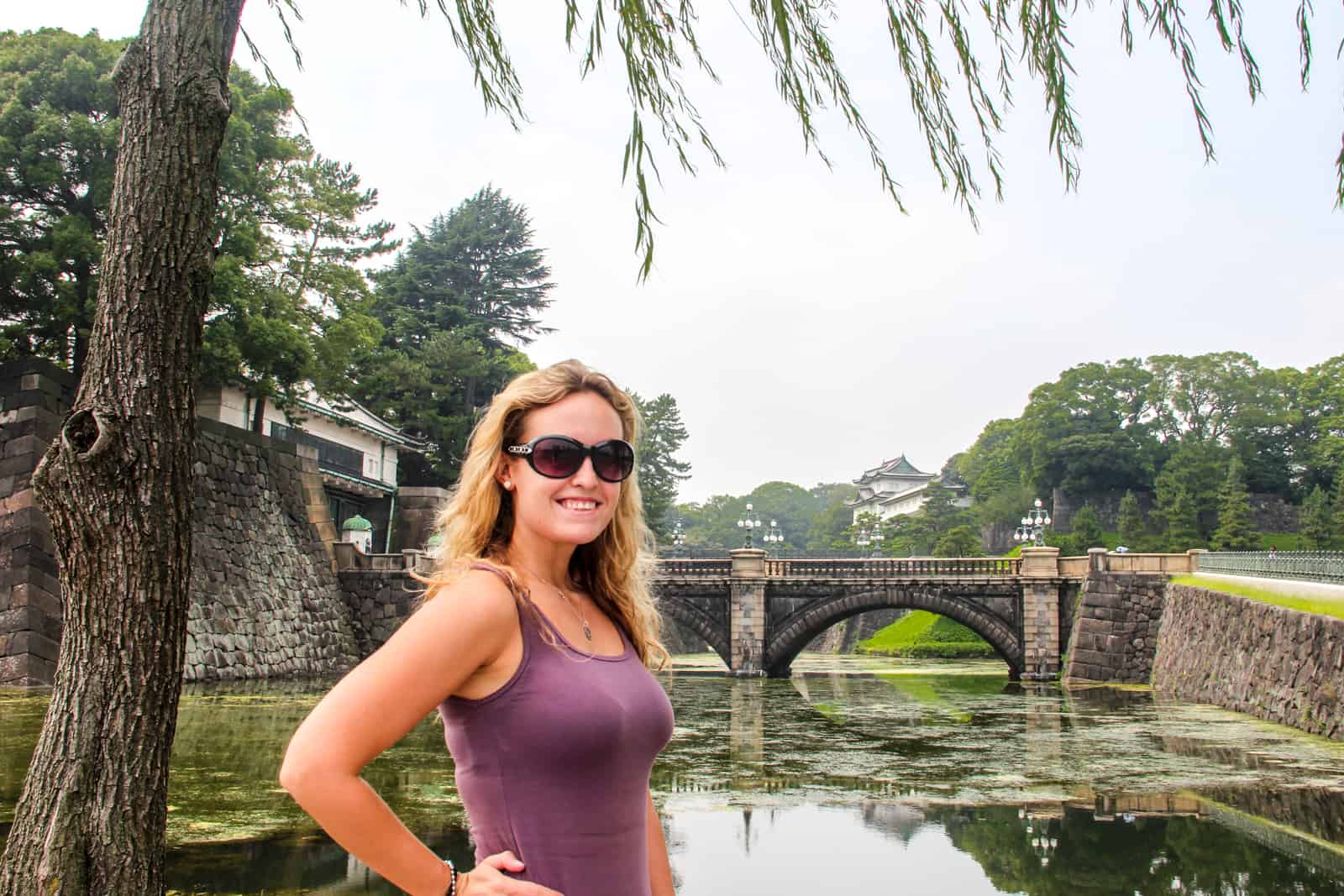
You’ll need to budget around $1,200 for a two-week backpacking trip around Japan.
21 Day Japan Rail pass
£523 / $660
Accommodation for 30 nights
£600 – £800 / $760 – $1,010
Food, drink, tourism site entry fees, other transport, and day-to-day living
£700 / $880
For a slow and budget traveller, this hit my monthly outgoings hard, but I don’t regret a single penny spent. Why? Japan is incredible.
Is it Worth Getting a Japan Rail Pass?
The Japan Rail Pass might be one of the biggest initial costs. Suppose you plan to visit more than three or four long-distance destinations in Japan. Buying one is highly advised in that case. It gives you unlimited journeys on all Japan Rail, Japan Ferry, and Japan Buses throughout the country.
Many people are put off by the high cost of the rail pass, but individual rail journeys are expensive and, when added together, can cost more than the unlimited rail pass. Since the Japan Rail Pass price hikes in October 2023 , it is worth working out planned train journeys and seeing if you can save by having the pass.
Are you thinking of paying as you go? Here are some average one-way train ticket costs in Japan without using a Japan Rail Pass.
- Tokyo – Kyoto: £94 / $118
- Tokyo – Osaka: £97 / $122
- Tokyo – Hiroshima: £128 / $161
- Kyoto – Osaka: £20 / $25
- Kyoto – Hiroshima: £77 / $97
- Osaka – Hiroshima: £70 / $88
The average cost for a Tokyo – Kyoto – Osaka – Hiroshima – Tokyo round-trip ( without using a Japan Rail Pass) = £348 / $440 .
For one week of travel, individual train tickets may be the more cost-effective option. That’s if you can find good fares at the time of travelling.
How Much is a Japan Rail Pass?
If you cover this basic route of city highlights, buying a Japan Rail Pass for two or three weeks of unlimited travel in Japan can save you a lot of money and avoid the hassle of searching for the lowest-cost ticket.
You should invest in a Japan Rail Pass only to make the cost of multiple and long-distance travel worthwhile.
The following are prices for the standard/ordinary class tickets.
£261 / $330
£418 / $528
£523 / $661
The Japan Rail Pass must be booked before you arrive in Japan.
Local travel agents can book this for you, and you will be given a receipt to be presented at the main stations in Tokyo in exchange for your pass. However, it’s quick and easy to purchase a Japan Rail Pass online, as shown below.
Japan Rail Pass From £261 / $330 / 50,000 Yen / Multiple Currencies You can purchase a rail pass from Japan travel experts, J Rail Pass. Multiple-day and regional passes can be ordered with free delivery in various countries. The website is easy to use, with quick and secure payment and with other Japan travel services to hand. Buy a Japan Rail Pass Now
Other Transportation Costs in Japan
Local trains outside the JR Rail pass inclusion can cost anywhere from £3-£10 / $4-$13 for a short half-hour journey up to £15 / $20 for a destination an hour or more away.
Ticket prices vary according to which of the five different types of train you take:
- Local trains stop at every station on the route.
- Rapid trains skip some stations
- Express trains skip even more stations
- Limited Express stop only at major designated stations
- Super Express (shinkansen ‘bullet trains’) operate separately on different lines and with their own stations
Be aware of extra costs when using Japanese trains and booking tickets. An extra fee is applied on top of the train ticket base fee for the faster trains.This applies to the Express trains upwards (in terms of speed)
What seat class do you choose? While most local trains have a standard class across all carriages, there are two classes of seats on long-distance trains, which also affects your overall costs – Ordinary (Second Class) and Green (First Class)
- Green/first-class seats can sometimes be double the price of the standard fare.
- Shinkansen (bullet) trains have reserved and non-reserved seating options, where a reservation can cost within the region of $5.
- Shinkansen (bullet) train seat reservations are free with the Japan Rail Pass.
Check here for routes and timetables for trains in Japan.
Japan has metro lines in nine cities, although you are likely to mainly use those in Tokyo, Osaka, and Kyoto. Tokyo’s subway is the largest and most tricky to navigate, although I always find myself being helped out by locals who came to my aid in helping me purchase the right ticket or even ride the line with me until my correct stop.
A single trip on a Metro and average bus journeys in all cities varies but is usually from 180 – 400 Yen – around £1 -£4 / $1.25 – $5 for a single journey.
You can purchase an unlimited Tokyo Metro Pass: 24 hours (800 Yen/€4/$5), 48 hours (1,200 Yen/£6/$8), or 72-hours (1,500/£8/$10).
A comprehensive breakdown of all metro lines, ticket prices, and tips on navigating each system can be found here .
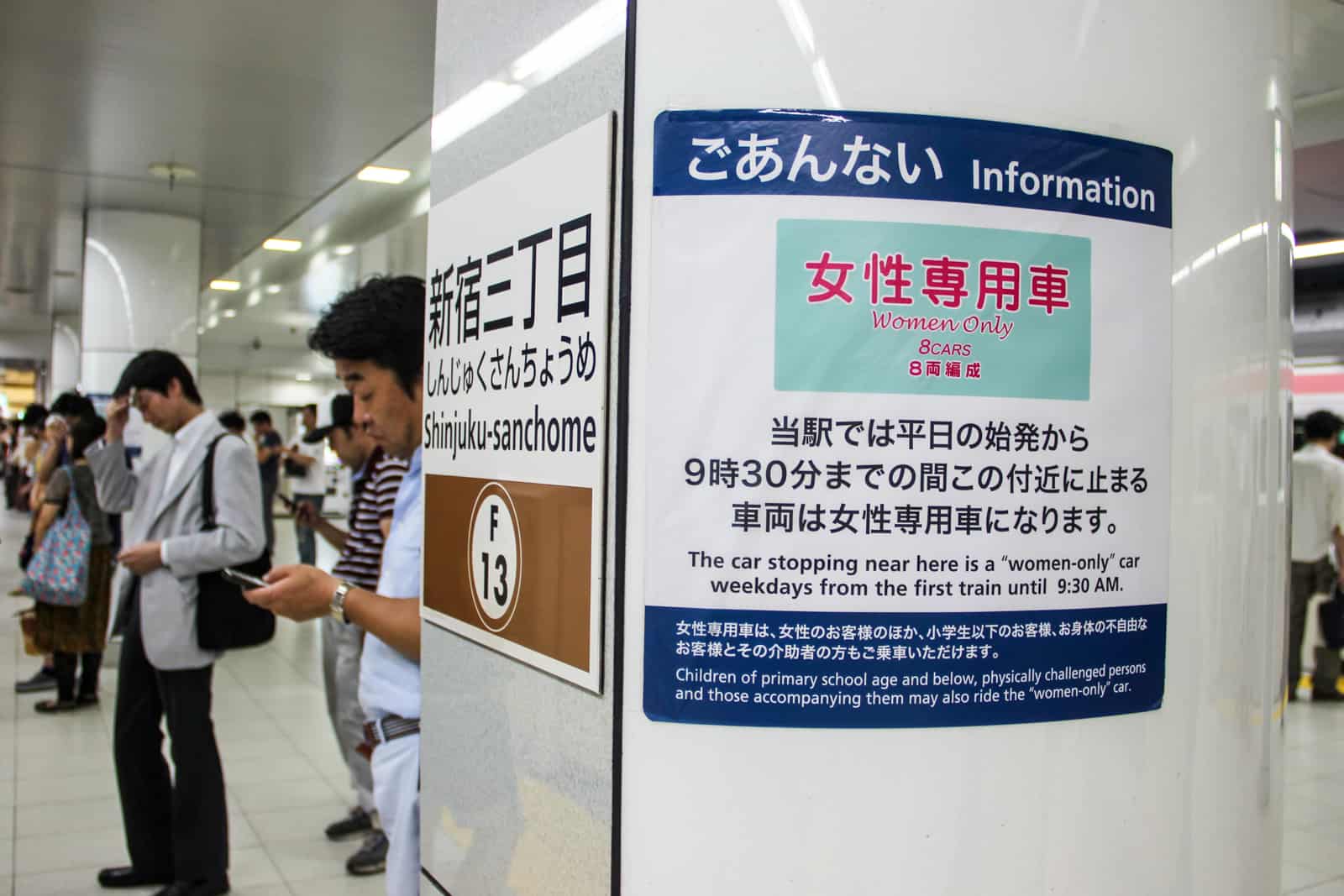
The Japan Metro is an overwhelming but cheap means of transport around the major cities.
Taxis, especially in Tokyo, are ridiculously expensive and should be avoided unless absolutely necessary or if you have no choice. As an example, a 20-minute journey home after a night out in Tokyo cost nearly £38 / $48, and that was even on the meter.
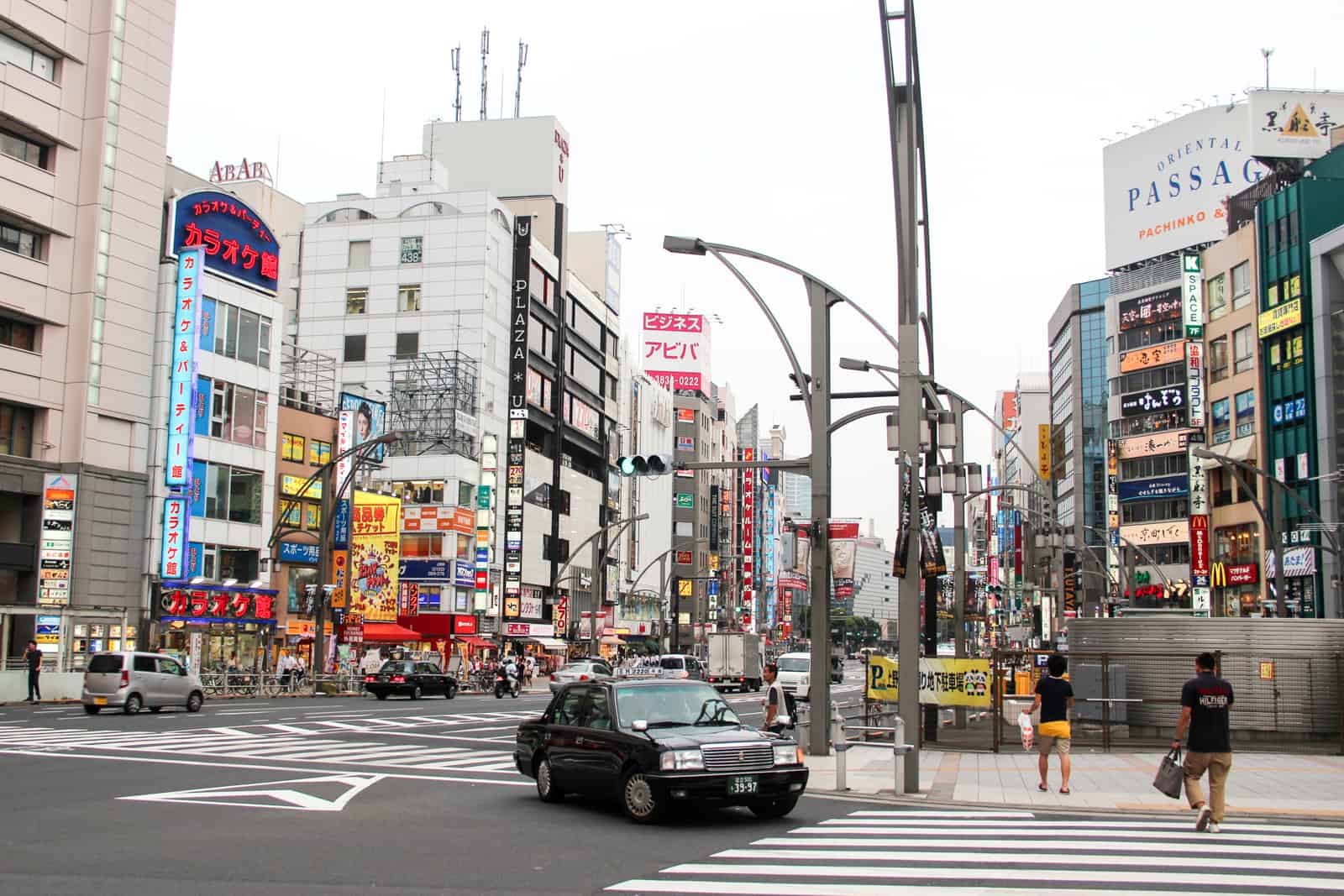
Japan black and yellow taxis are an expensive option.
Like most destinations, bike hire is common and one of the most budget-friendly ways to get around and explore an area.
Many guesthouses in Japan offer this facility for free, and if not included, the average cost I found for one-day bike hire was £3 / $4.
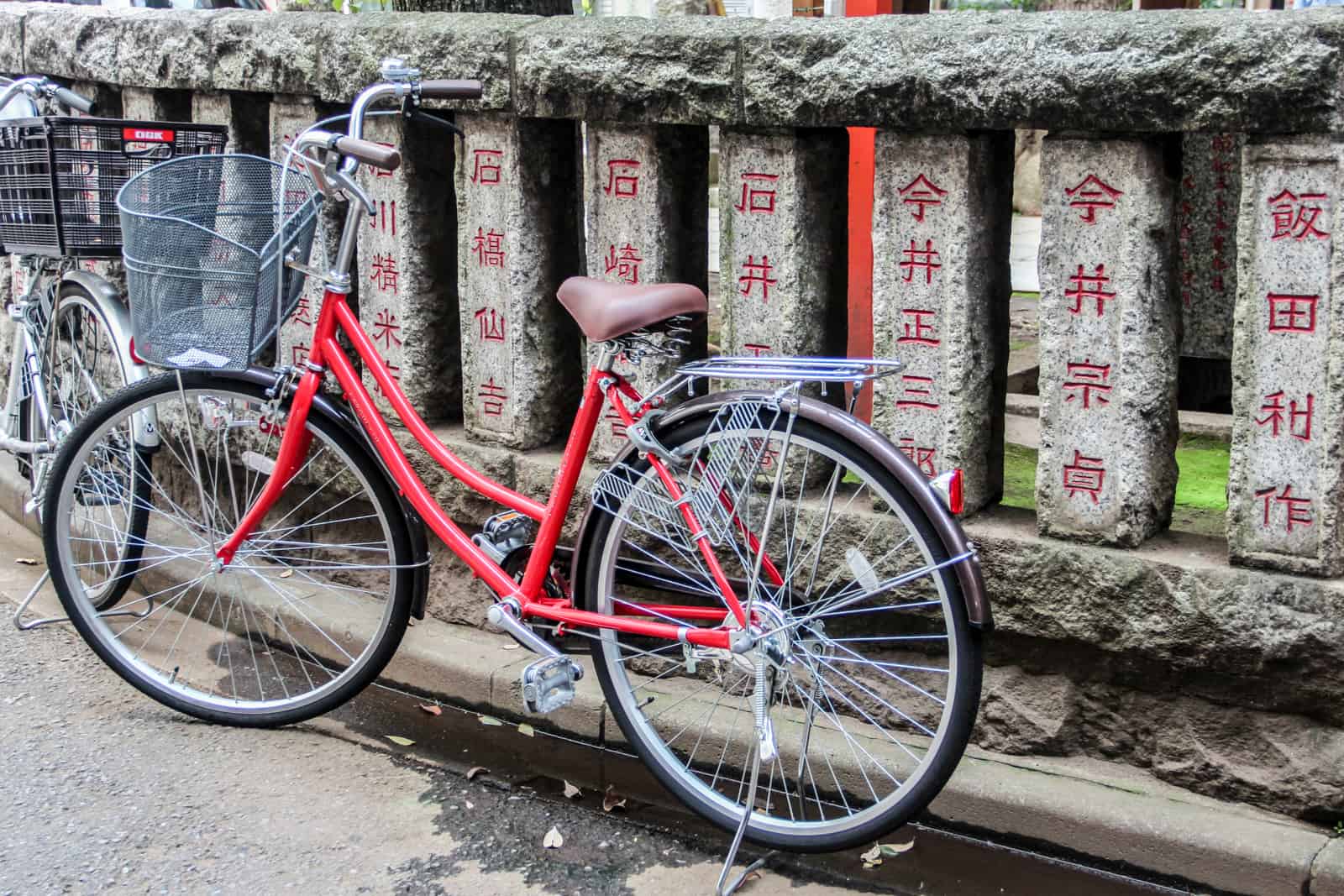
Make use of free or inexpensive bike hire from Japanese accommodations.
Food prices (and drinks) vary dramatically depending on location. You may be eating a cheap bowl of ramen noodles for a full meal at a standard restaurant or trying the delectable beef that Kobe is famous for, with a hefty price tag! Chain restaurants like the CoCo Ichibanya curry house do great deals alongside local establishments, which might throw in a free beer if you stick to a certain menu. Sushi doesn’t have to be an expensive option, as does tempura.
One budget food tip for Japan is to get breakfast, snacks, and sushi sets at a local supermarket. You can even stay within a 1,000 Yen budget (£6 / $8) for a meal.
- A meal in a local restaurant: £5-£10 / $6-$13.
- Ramen or curry: £6 / $8 (can be sought for less than 1,000 Yen).
- Kobe beef (special, must-do treat!): £17 / $22+.
- Budget sushi: £0.75 / $1 (Around 100 Yen per item on the menu)
- Sushi at Tokyo’s Tsukiji Market: £13 – £20 / $17 – $26 (2,000 – 3,000 Yen for sushi sets of around seven pieces or more).
- Cover charge at themed bar or restaurant: £6 / $8 on average.
- Bottle of beer: £3 / $4.
- Cup of coffee: £3 / $4.
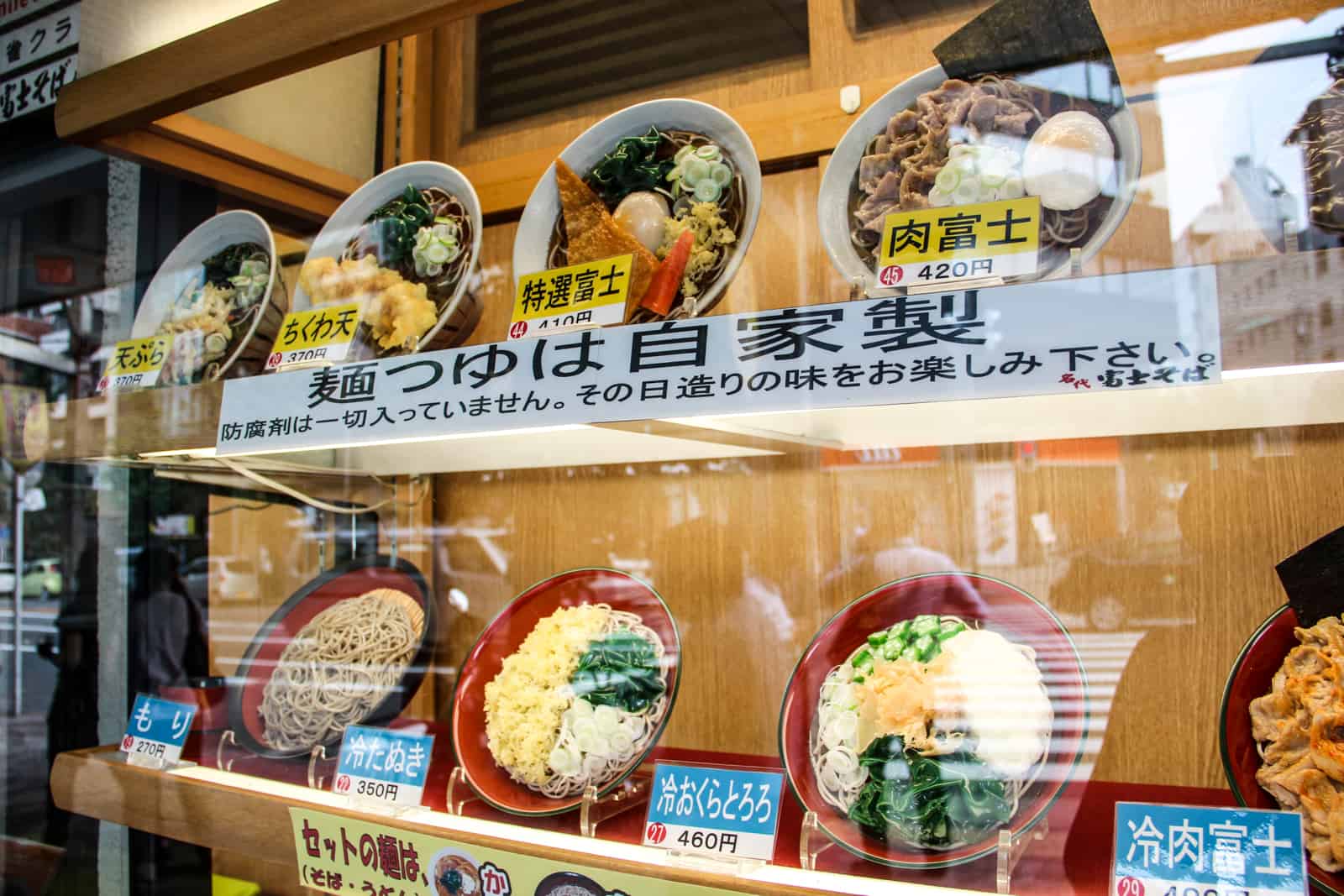
Plastic food on display at Japanese restaurants makes choosing and knowing the price easy.
Accommodation Costs in Japan
In Japan, accommodation will be your biggest cost, alongside transportation.
However, this country is quickly responding to the needs of the budget traveller, with more and more establishments becoming aware of the growth of tourism and a slow influx of more established backpackers looking for practicality over luxury.
Hostels are prevalent in big cities like Tokyo, Kyoto, and Osaka. In many areas, old houses and traditional Ryokan are being preserved and turned into homely hostels and guesthouses, meaning you can experience Japanese tradition on a budget.
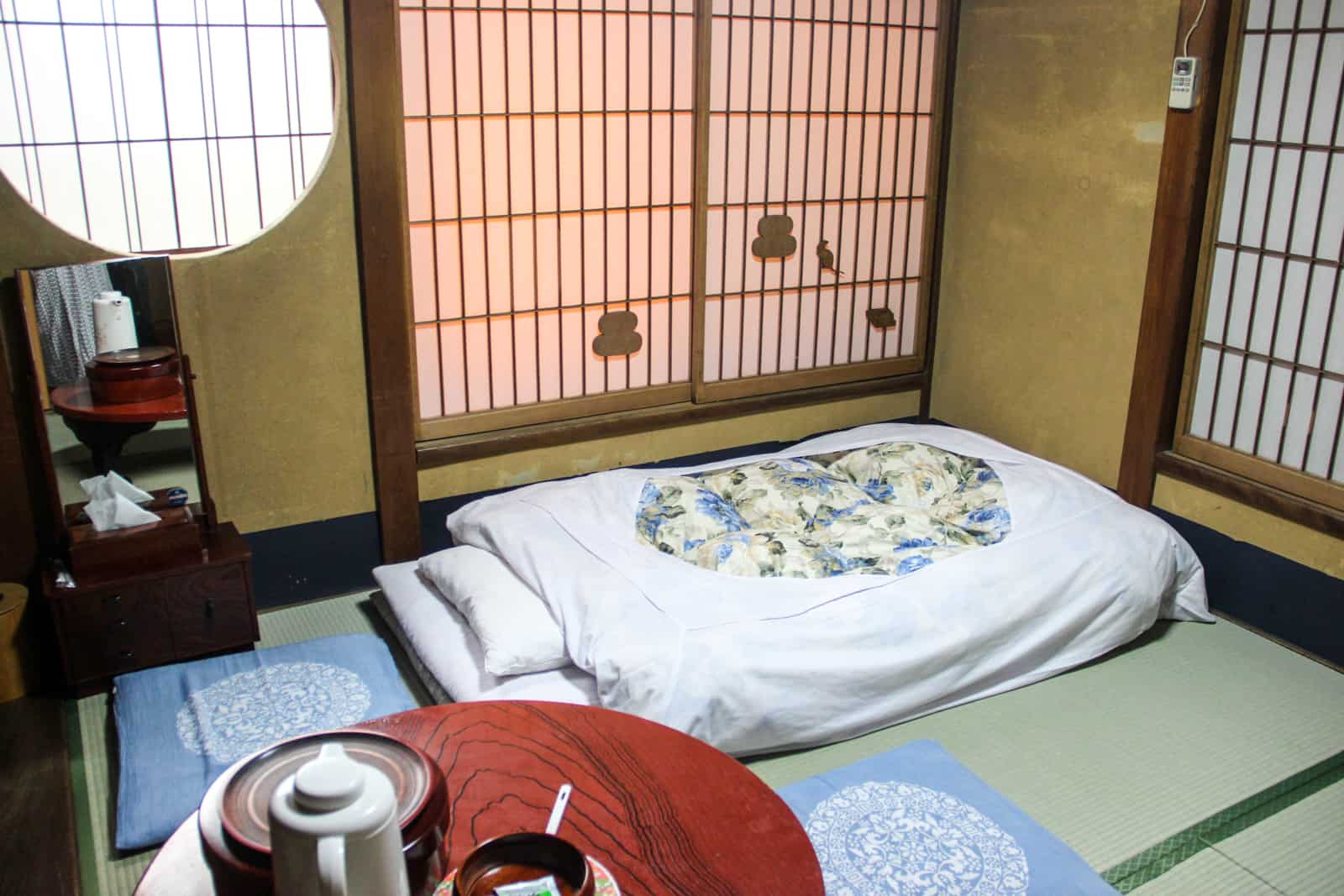
Factor in a traditional Ryokan (Japanese Inn) into your accommodation budget.
I stayed at the range of accommodations in Japan listed below to pull together a comprehensive list of options that cover all manner of budgets, from no-frills to luxury hostels, to traditional homestays and Ryokans, on a journey that started in Tokyo and which took me through various key hotspots in the country, all the way down to Hiroshima.
Below is an outline of where I stayed and the costs per night for a dorm or a single room.
Homeikan – A traditional Ryokan, said to be Tokyo’s oldest, with an onsen bath.
From £41 / $51 for a private room
K’s House Traveller’s Hostel in Kawaguchiko – In the heart of the Fuji area, with free bus transfers to the main train station.
From £58 / $73 for a dorm room
K’s House MtFuji
Private rooms from £140 /$176
Standard mountain house on Mount Fuji
From £38 / $48 for a sleeping space, sleeping bag provided
K’s House Ito Onsen – Shared and private rooms within a 100-year-old Ryokan, with an onsen bath.
From £20 / $25 for dorm room
From £58 / $73 for a private room
Santiago Guesthouse – A new hostel with its very own luxury café.
From £11 / $13 for a dorm room
Kyoto Piece Hostel – A luxury hostel with a swanky hotel vibe.
From £42 / $53 for a private
From £15 / $19 for a dorm room
Haruya Hostel – An old Japanese house converted into a homely guesthouse.
From £16 / $20 for a dorm room
Utano Youth Hostel – A traditional ‘youth hostel’ outside of the central city.
From £21 / $27 for a dorm room
Nara Backpackers – A traditional Japanese house turned into a cosy guesthouse.
J-Hoppers Osaka – Based slightly out-of-town in nearby Konohana ward (where Universal Studios is based) and main transport links.
From £17 / $22 for a dorm room
Yume Nomad – A huge local house turned guesthouse with its own in-house café.
From £13 / $17 for a capsule
Nest Hotel Hiroshima Hatchobori
From £49 / $62 for a economy double
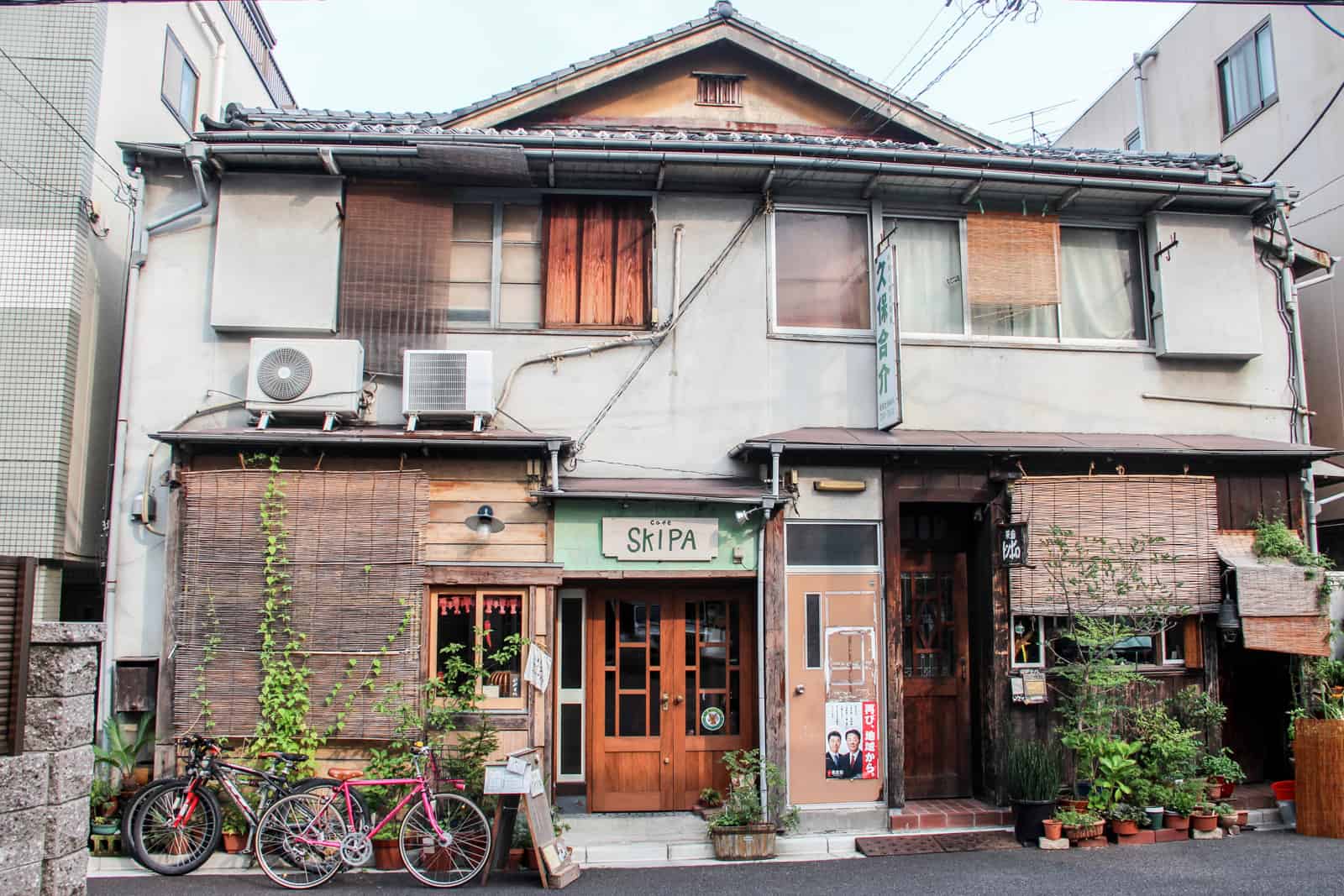
Living locally in Japan. Many traditional houses have been converted into small hostels and guesthouses.
For some, independent travel in Japan might seem overwhelming. If you embark on solo travel in Asia for the first time, Japan can feel more isolated and less trodden than the Southeast Asia hotspots. Would you rather a travel trip to Japan be taken care of and travel in a small group with other adventurers? I recommend these tours of Japan with G Adventures, which takes in many of the country’s key cities and highlights, getting you from Tokyo to Hiroshima and back again.
With a variety of trip options from five days to two weeks, including visiting the iconic Japanese sights on a National Geographic Journey trip , seeing Japan’s highlights on a budget , or travelling the backroads of Japan , you could even mix and match a small group tour with independent travel.
Eccentric shows, walking tours, cultural tours, and ceremonies also factor into your exploration budget when travelling in Japan.
Temples, castles, and palaces are mostly free to enter , although some historical monuments may have an admission fee, which contributes to the site’s protection.
For example, Tokyo is a dream on a sightseeing budget, with core sites such as the Buddist Sensoji Temple and the Imperial Palace grounds having no admission fee. However, the Kinkaku-Ji Temple of the Golden Pavilion in Kyoto is ¥400 – $2/€3.
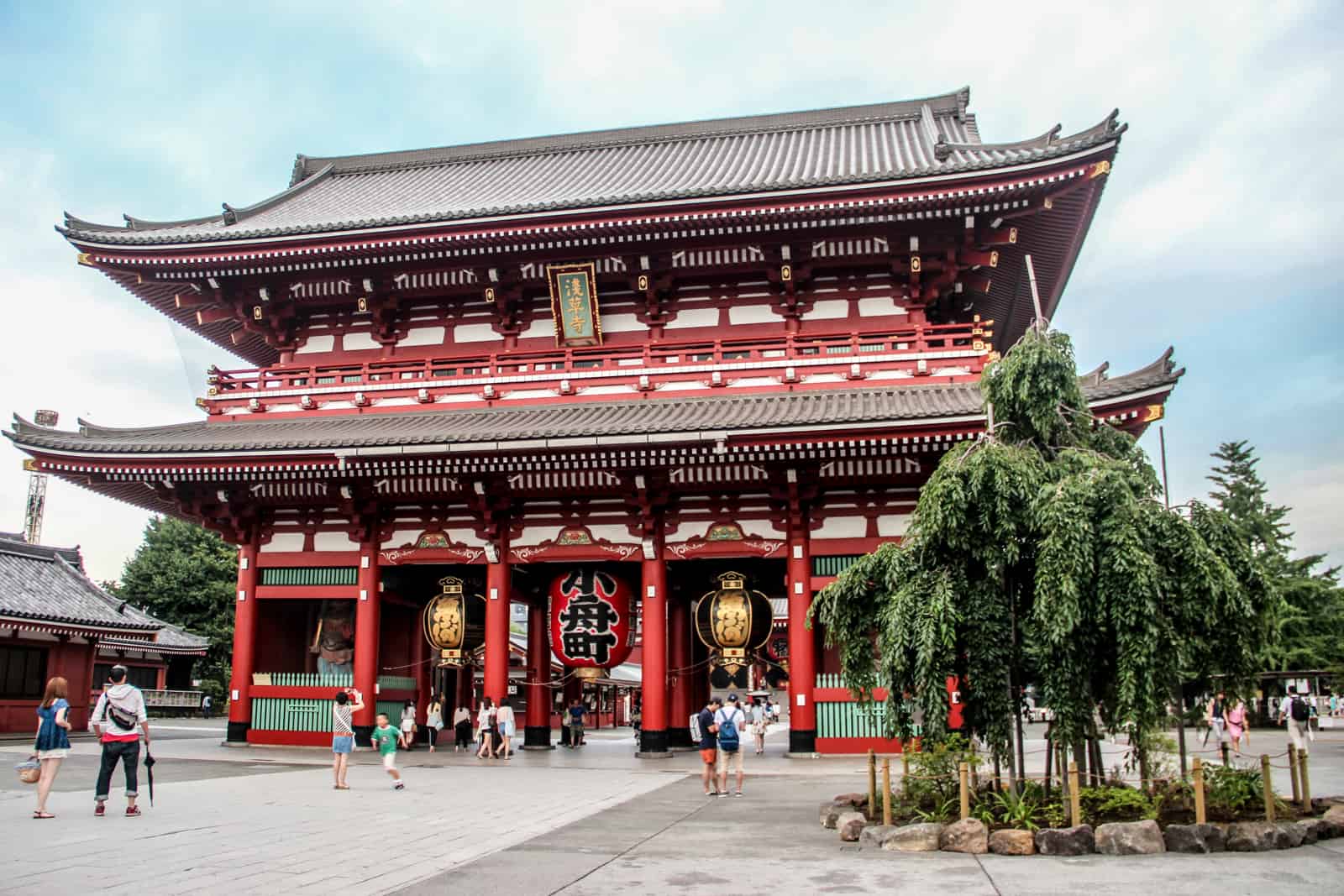
Sensoji Temple in Tokyo is free to enter. Sightseeing in Japan isn’t expensive.
Is Japan Expensive?
Yes, but the cost of travelling within Japan is relative. Before getting there, you must decide where you will go, whether to purchase the rail pass, and what kinds of accommodation you want to try out, from standard budget hostels to traditional Japanese experiences.
Everything else along the way falls into place, and if you look hard enough when it comes to food and other everyday costs, your overall Japan vacation cost might not be as overwhelming as you expect.
Japan may be more expensive than her Asian neighbours, but the incredible time you will have here will leave you saying the same thing long after you have left: “It was completely worth it”. I promise you that, and I’m already looking forward to returning, cost and all.
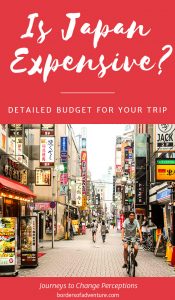
Any plagiarism of this Japan cost travel blog, or any of its calculations and descriptions used on other sites and blogs without attribution is not information authorised by myself for use.
About Becki
Becki Enright is a British Travel Press Award-winning writer whose work focuses on changing perceptions about misunderstood aspects of destinations. Her writing combines storytelling with insight into the social, historical, political and economic factors that shape the country or place in relation to tourism. Becki has appeared live on Sky News and CNN and has contributed to high profile media including National Geographic, Time.com, Guardian online, New York Times, Grazia and Buzzfeed.
29 August 2019 at 8:03 am
So quick question I guess for me would be, the rail pass does not cover local buses or trains in Tokyo? Or like smaller distances? I just want to make sure it’s worth getting since I am only making a trip from Kyoto to Tokyo and if it won’t cover other trains I don’t think it would be worth getting it. What do you think?
29 August 2019 at 1:01 pm
If you are only planning to take one train (the bullet train for that journey being no more than $20) then I don’t think buying a JR Rail Pass is worth it. It’s more intended for those taking multiple train journeys around the country.
Thanh Pham says
10 September 2016 at 2:26 pm
Could you please help me a bit? I am visiting Japan this October, from 14th–21st. I am quite confused how much I should spend beside the cost for transport & hostel.
I am visiting Hiroshima from 14–17th and Kansai area (from 17th–21st, bases in Osaka and from here go to Kyoto, Kobe..). Its 42.100 yen for transport & hostel already, how much do you think i should prepare more for the trip?
Thank you a lot for your help Thanh
12 September 2016 at 3:49 pm
Hi Thanh. I’ve done my best here to break down costs for everything in Japan. I can’t tell you how much you should bring. Some people like to splurge more on food, others like to go shopping, or day trips to neighbouring cities. It’s a case of working out roughly what you want to do, and having more to cover yourself or a bank card that can work in Japan.
Rita Saavedra says
2 June 2016 at 7:29 pm
Thank you for your helpful tips. I am planning a trip to Japan in May 2017 for a total of 10 days. Two days for flying and 8 on ground. However, I am being charged $3458 (does not include air fare). This price seems steep for me. Your tips have encouraged me to research and plan the trip on my own. I do want to ask who helped you plan your sight seeing adventures?
2 June 2016 at 11:29 pm
I planned it all myself. I got a one month rail pass and wrote a list of all the cities I wanted to visit. I also got help from a local who gave me tips on how long to stay in each place and an ideal route. The Japanese are very helpful when it comes to all that stuff 🙂
3 June 2016 at 7:26 am
I recently just got back, I stayed at friends homes so it was a little bit cheaper, however, I was pretty free using on my money and I only ended up using 1,500 dollars for 10 day airfare round trip, two week rail pass, 5 nights in hotels, and of course lots of sushi! I think I would try to find cheaper flights. I also recommend avoiding traveling from June to August. And mid November till February. The cheapest times are September and may. Also, stay 30 min outside of the big cities and there are much cheaper accpmodations.
Franklin Orosco says
16 May 2016 at 4:34 am
I lived in and around Tokyo for two years and recently returned for a holiday. As far as saving on food costs, I would strongly suggest going to one of the large department stores which feautre one or two floors of stalls which sell packaged foods that just need to be heated at home. The thing is is that just about 30 minutes before closing time, they are quite eager to sell off the dishes that they cannot sell the next day, so the price cuts are enormous I saw discounts of up to 70%, but the norm was more like 50% off for all kinds of great food. If you have a fridge to put it in, you can have it for lunch the next day. Also, during the lunch hour, I would go down to a convenience store like Lawson`s or Family Mart to get a bento for about 10,000 Y. Eating doesn`t have to cost a fortune, but it is definitely higher than Thailand.
17 May 2016 at 2:37 pm
Thanks for the great food tips!
Leave a Reply Cancel reply
Your email address will not be published. Required fields are marked *
- Article Archives
- Work with me
- Privacy Policy

Lists by Lukiih 🍀
Practical travel guides with less fluff
- 💰 My 2024 Japan Trip Cost: A Budget Breakdown
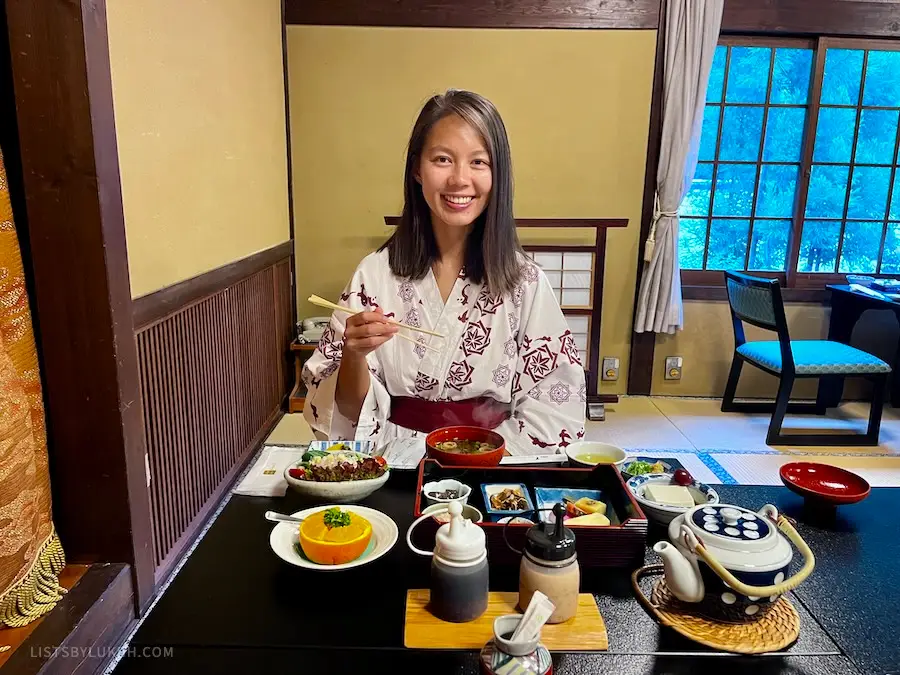
Japan, a country famous for its cherry blossoms and temples, can be visited with a budget of $60 to $120 a day.
My two-week trip to Japan cost a total of $2,829 . In this post, I share:
- 💰 Expected travel costs
- 💡 Budgeting tips
- 💵 How much cash to bring
- ✈️ My trip’s costs by category
- 📍 My trip’s costs by major cities
Planning a trip? Here’s what to know about Japan .
- Is Japan Expensive?
- How Much Is a Trip?
- About My Trip
- Cost Breakdown
- Daily Budget: $145
- Flight: $796
- 🏠 Accommodation Cost in Japan: $807
- Transportation: $374
- Entertainment: $155
- Kyoto: $616
- Withdrawing Cash
- How Much Cash To Bring
- Cash-Only Places
- Tipping Etiquette
Lists By Lukiih is readers-supported. When you buy with my affiliate link, I may earn a small commission. Thanks!
Is Japan Expensive To Travel To?
Japan ranks as one of the most expensive destinations in Asia. While it can be visited with a lower budget, Japan has pricey accommodations in major cities, the Japan Rail Pass is not cheap, and fees for attractions can add up.
Along with Singapore and Hong Kong, Japan is often considered a luxury destination in Asia.
However, with advanced planning and the willingness to forego certain experiences, Japan can be visited on a small budget .
💰 Trip Daily Budget for Destinations in Asia
For comparison, I visited these countries in Asia within a year of visiting Japan, and here’s how much I spent per day at each one:
*My Cambodia daily budget is high because I splurged on accommodation.
See all my daily budget for each destination I’ve visited .
How Much Is a Trip to Japan?
This section covers estimated trip costs depending on your travel style. I share my actual travel expenses further below.
🎒 Budget Traveler – Japan Trip Cost
Budget travelers can expect to spend approximately $60 per day or $840 for two weeks of travel in Japan, excluding flights.
Here’s what a budget traveler’s cost breakdown can look like:
To travel on a budget to Japan, below are some things you’ll need to do.
Accommodation Budgeting Tips
- Stay in a dorm-style hostel for about $30 a night in big cities like Tokyo. You can find hostels for closer to $15 a night in more remote areas.
- If you want more privacy, consider staying at a capsule hotel, where you can rent an enclosed bed for less than $40 a night.
- The average cost of a private room in a budget hotel can also be cheap, but only if you stay on the outskirts of central areas . Otherwise, budget hotels are priced like mid-range hotels in central places of major cities like Tokyo, Kyoto, and Osaka.
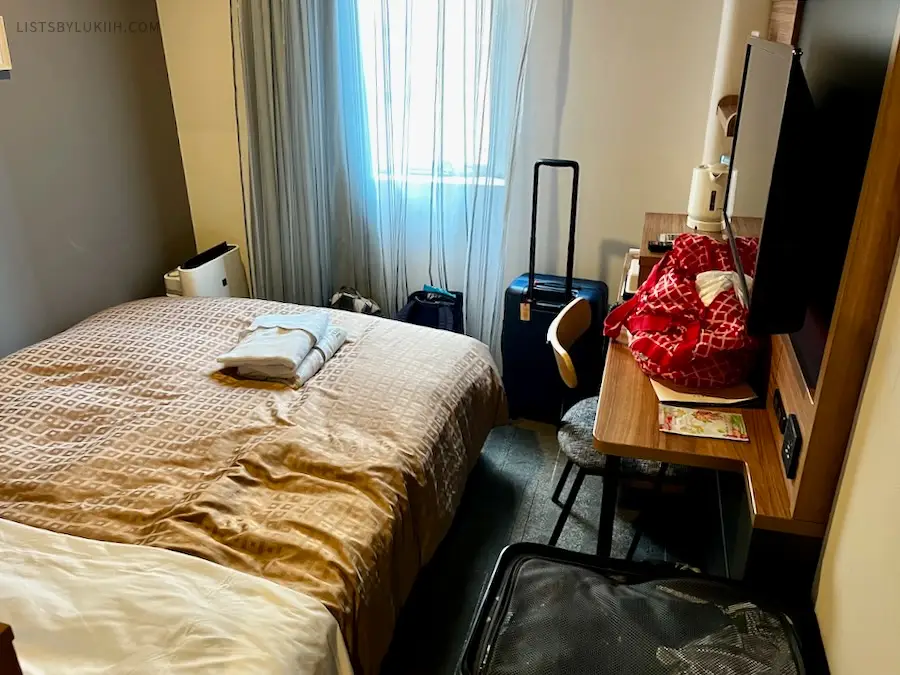
- Avoid traveling during Japan’s high season, which is the cherry blossom season in the spring (March to May). Traveling during the low season, which is summer or winter, will get you the best deals on accommodation .
See what traveling to Japan is like in December .
Transportation Budgeting Tips
Japan’s public transportation, a complex and vast network of trains, makes traveling convenient and cheap.
- If you know you’ll be taking the train a lot, consider buying a day pass, which can be as cheap as $4 per person in Tokyo.
- If you’re traveling long distances around Japan, consider getting the Japan Rail Pass , which gives you unlimited rides for a set time and includes access to high-speed bullet trains.
The JR Pass is expensive , so you should know your rough Japan itinerary before purchasing it. That way, you can evaluate whether it’s worth it.
Food Budgeting Tips
You can eat cheaply in Japan and find meals for $5, even in big tourist cities.
- A great way to save money on food is to shop at convenience stores like Family Mart, 7-Eleven, and Lawson. These stores provide decent meals for less than $5 . I had a latte and onigiri (rice ball) for breakfast several times at convenience stores, which cost only $2 per meal.
If you buy a refrigerated meal, like gyudon, ramen, or pasta, they will warm it up for you and provide utensils .
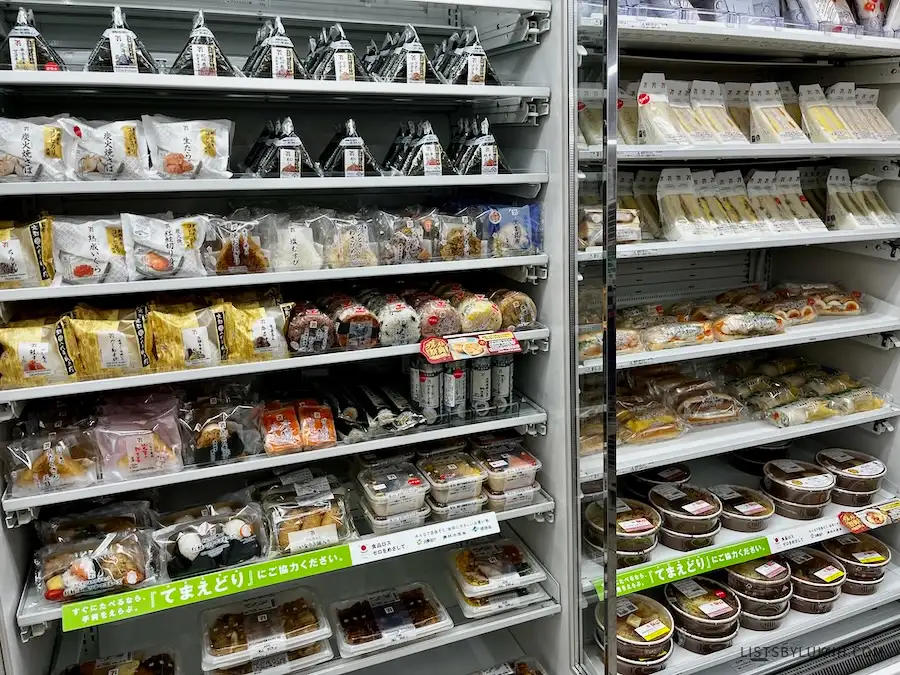
- Fast food places that typically have automatic ordering machines also provide hearty meals for $5 or less. In Kyoto, I had an udon bowl for $3; in Tokyo, I ate at a ramen restaurant for $7.
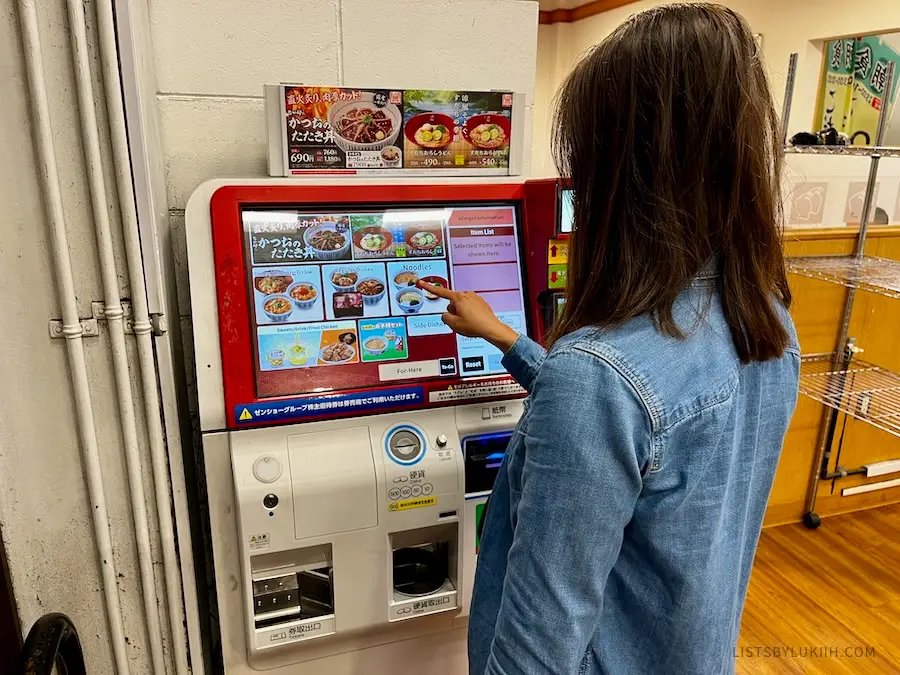
- Markets, like the popular Nishiki Market in Kyoto and the Kuromon Ichiba Market in Osaka, are cheap places to try a wide variety of good food for less than $12 , as each stall sells $1 to $3 snack-bite food.
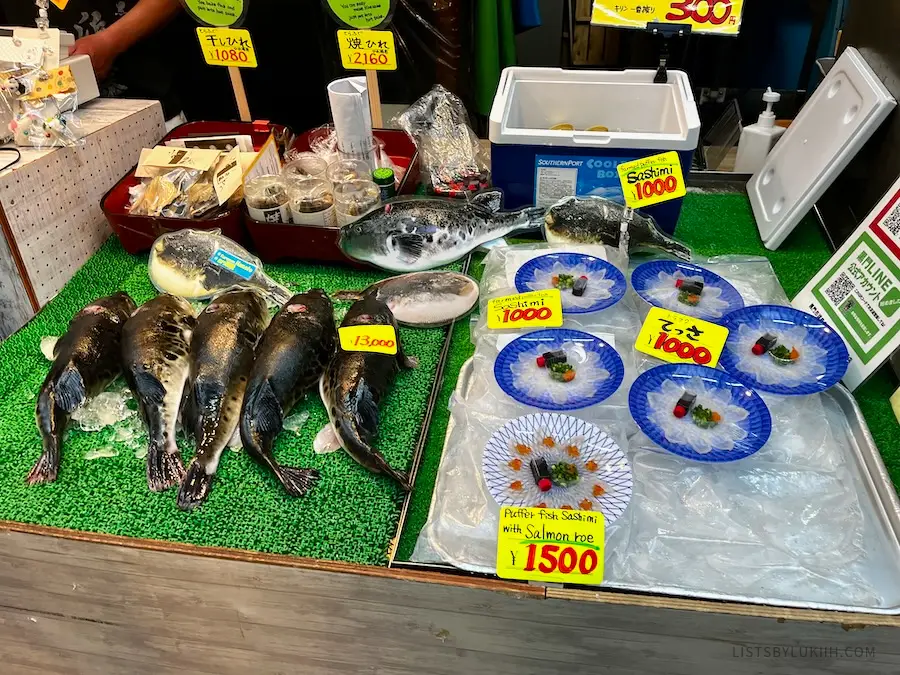
- Conveyor belt sushi restaurants are a good deal if you’re craving seafood . I ate at one in Shinjuku, a central location in Tokyo, for $13.
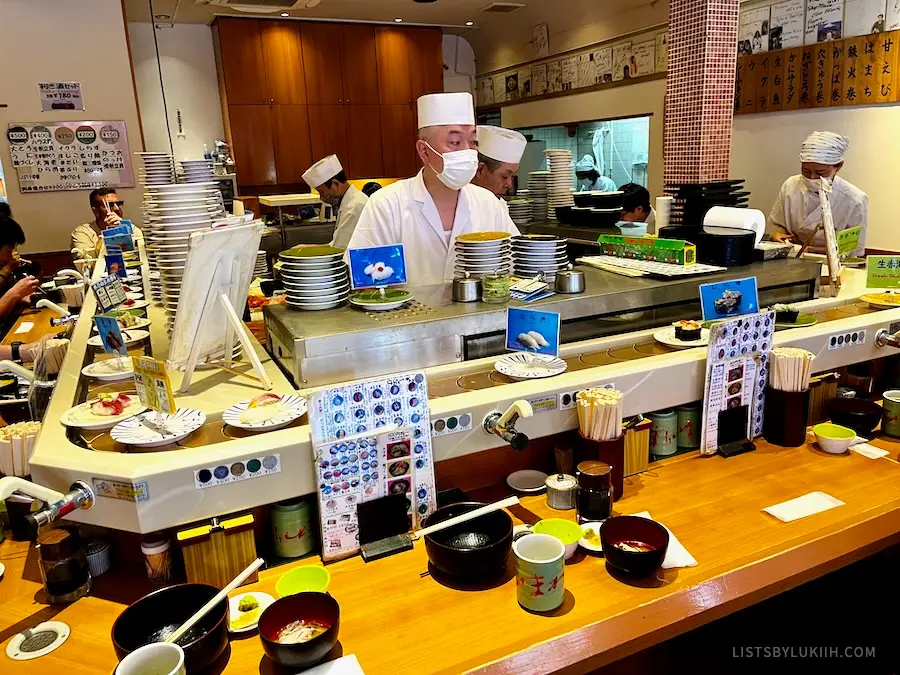
Entertainment Budgeting Tips
While many of Japan’s main attractions require an entrance fee, there are plenty of ways to enjoy the country without spending much money . Some of my best days in Japan didn’t require me to pay for any attractions.
- Many famous temples have a small entrance fee, but there is an abundance of other less well-known temples around Japan that are free .
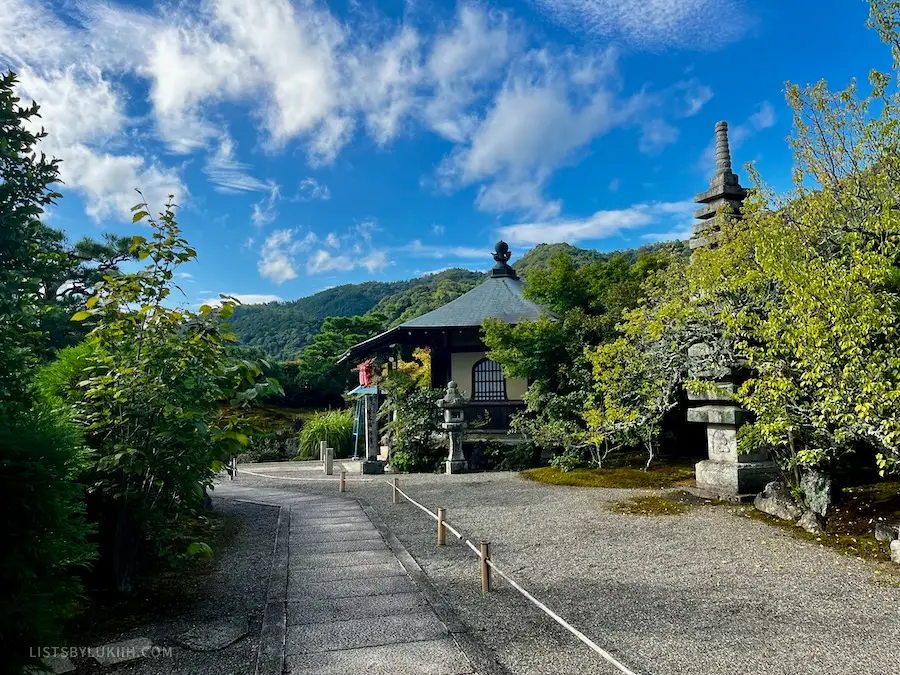
- Similarly, gardens and some bigger parks will also have entrance fees, but many urban parks have free access.
💰 Mid-Range Budget Traveler – Japan Trip Cost
A mid-range budget traveler like myself can expect to spend approximately $120 per day or $1,680 for two weeks of travel in Japan, excluding flights. I break down my trip expenses by travel category below.
About My Japan Trip
To give context to the expenses below, here’s what you need to know about my trip:
- Tokyo : 6 days
- Kyoto : 2 days
- Osaka : 1 day
- Mount Fuji hike : 2 days
- Shimanami Kaido cycle : 2 days
- ☀️ High season – I visited Japan in September, the beginning of the high season. Japan has two high seasons: one in the spring and one in the fall.
See the upsides and downsides of visiting Japan in September .
- ✌️ Group travel – I traveled with one other person, so we were able to split some costs, such as housing.
- 💰 Mid-range budget – I consider myself a mid-range budget traveler, and these expenses reflect that. I don’t aim to travel on a budget, but I’m thoughtful about how and where I spend.
- 🍀 Self-funded – My trips are self-funded, so I paid for everything listed below. None of my excursions or experiences are sponsored.
- 💵 US dollars – All costs listed in this post are per person and in US dollars, which have been converted from Japan’s local currency, the Japanese yen.
The exchange rate was $1 USD = 142 JPY at the time of writing.
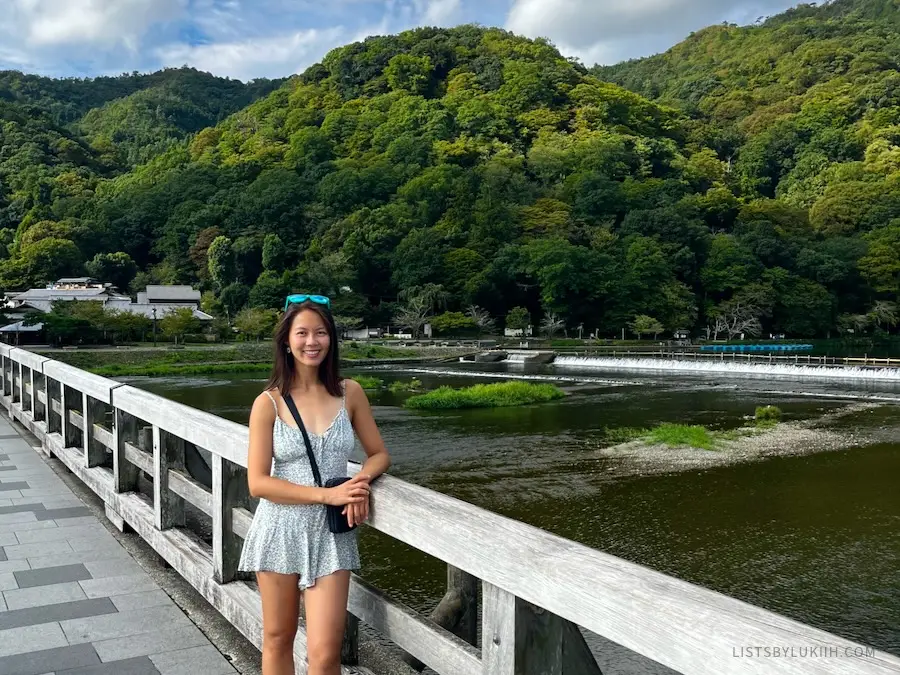
Japan Trip’s Total Cost: $2,829
My two-week trip to Japan cost a total of $2,829 , including flights.
See the highlights of my trip in this Japan itinerary .
💰 Cost Breakdown for Japan
Here’s a quick overview of my expenses by travel category:
🗓️ Daily Budget in Japan: $145
My Japan trip cost $145 per day , excluding my round-trip flights from and to the United States.
A mid-range budget traveler can expect to spend $120 per day in Japan. This generally means staying at accommodations that cost about $70 per night, eating a mix of food from convenience stores and restaurants, and visiting several of Japan’s big cities.
✈️ Flight Cost to Japan: $796
My round-trip flight from the West Coast of the United States to Haneda Airport in Tokyo was $796 .
A round-trip flight between the US and Japan that costs under $700 is considered cheap; international flights typically cost over $900.
🏠 Accommodation Cost in Japan: $807
My average cost of accommodation in Japan was $58 per day . I was able to split accommodations with one other person at all times.
Here are the accommodations I stayed at and how much I paid for each:
Budgeting Tips for Accommodations in Japan
Here are my budgeting tips and things to note regarding accommodations in Japan:
- Accommodations are pricey – While accommodations in Japan can be affordable in non-central areas, expect to pay $70 for mid-range hotel rooms in central areas of Tokyo, Kyoto, and Osaka. Luxury hotels in those major cities will be as high as $900, but I recommend staying in a ryokan if you have a larger accommodation budget.
- Be prepared to shell out for a ryokan – Ryokans, which are traditional Japanese inns, are typically more expensive than mid-range hotels; a decent one starts at around $150.
Ryokans are usually attached to onsens and serve kaiseki, a multi-course Japanese meal, for breakfast, dinner, or both. Despite their higher costs, they’re considered a unique experience that’s worth a one- or two-night stay.
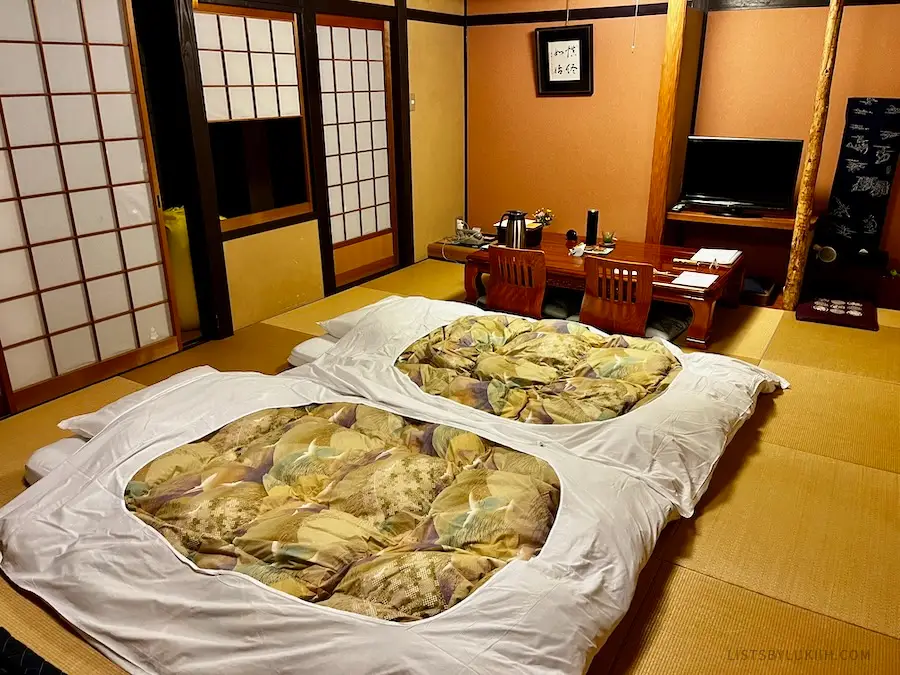
- Don’t pack toiletries (optional) – Many hotels in Japan will provide toiletries, pajamas, and breakfast sets as part of their accommodation costs. All the hotels I stayed at (with Mt. Fuji hut being the exception) provided toothbrushes, toothpaste, face lotion, etc.

🍣 Food Cost in Japan: $489
My average cost of food in Japan was $35 per day .
Food costs in Japan vary widely ; you can eat on a budget or extravagantly. For either budget, try eating at local spots for the best authentic eats.
Here’s a hack for finding local eats in Japan .
Cheapest Meals in Japan
Here are the most affordable meals I ate during my trip:
If you’re on a budget, you can eat Japanese food for $3 to $10 at convenience stores (Family Mart, 7-Eleven, and Lawson), street food markets, and fast food restaurants where you sometimes order at a machine resembling a vending machine.
Most Expensive Meals in Japan
Here are the most expensive meals I ate during my trip:
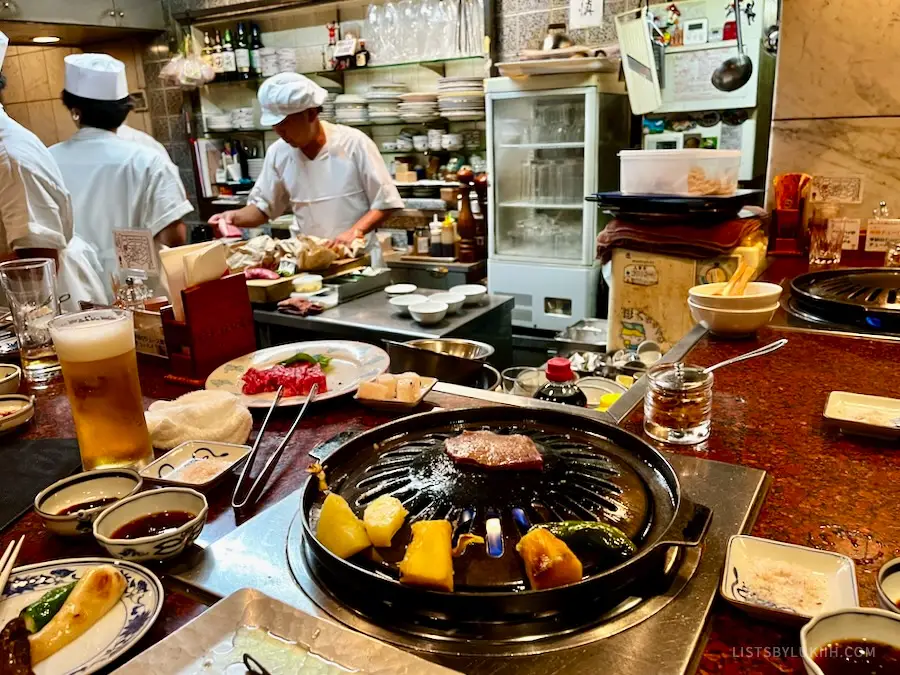
You’ll notice that fresh fruits in Japan can be very expensive (e.g., over $15 for a handful of grapes) because fruits hold more significance in Japanese culture. But if you go to local supermarkets, you can buy them for reasonable prices.
🚆 Transportation Cost in Japan: $374
My average cost of transportation in Japan was $26 per day .
Here are the transportation methods I took and how much I paid for each:
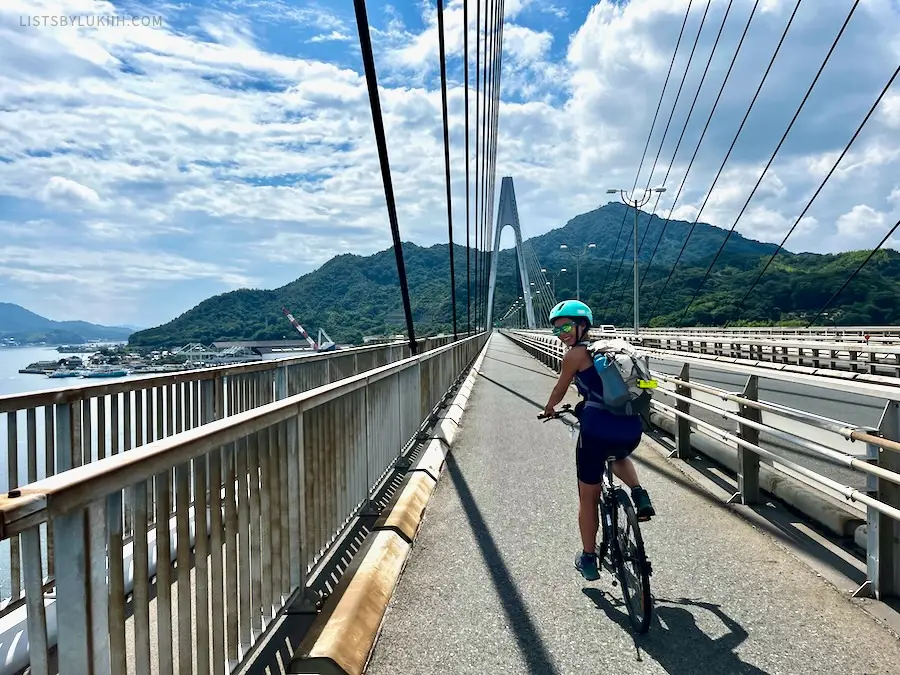
When figuring out transportation, know that many of Japan’s train stations have coin-operated luggage storage that is cheap and convenient. It typically costs less than $5 for 24-hour storage . As the name implies, they are sometimes cash-only and need exact change. Train station attendants can give you change for larger bills.
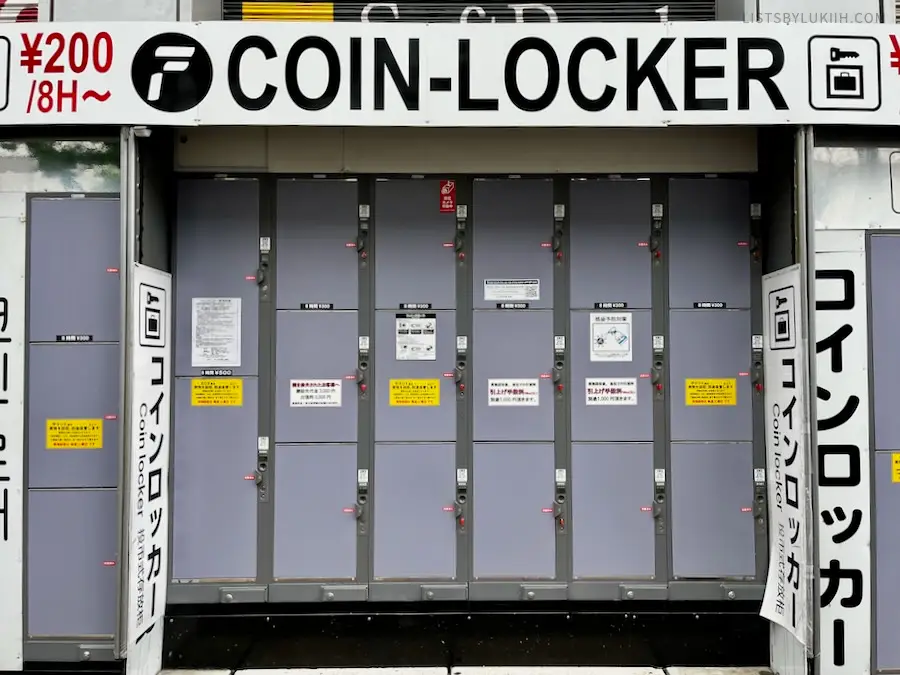
Budgeting Tips for Trains in Japan
The best way to travel around Japan is by train. Here are my budgeting tips and things to note regarding trains there:
- Consider getting the JR Pass – JR, the same group that operates all the bullet trains (called Shinkansen ), serves many of Japan’s trains. A bullet train ride can be expensive (around $100 from Tokyo to Kyoto), so you should determine whether getting a JR Pass , which gives you unlimited rides for a set time, is more economical. I got the 7-day JR Pass for my Japan itinerary because it was cheaper than buying individual rides.

- Take advantage of day passes – Some local transportation, like Tokyo’s local trains, offers a cheap day pass that is usually cost-efficient if you take the train more than three times within 24 hours.
- IC cards can make things more convenient – You’ll notice that many places in Japan, including public transportation, convenience stores, restaurants, and vending machines, will accept IC cards like PASMO and Suica. An IC card is a rechargeable travel card that you can get to make navigating Japan easier.
⛩️ Entertainment Cost in Japan: $155
My average cost of entertainment in Japan was $11 per day . My entertainment costs are on the lower end because I did many free things and took advantage of the country’s beautiful nature, which is usually low-cost.
A typical mid-range traveler in Japan will likely spend closer to at least $30 a day on entertainment.
Costs of Activities and Attractions in Japan
Here are all the activities and attractions I paid for and how much each cost:
Japan is a beautiful country where many people like to take photos. Before snapping a photo of a local, ask them for permission , as doing so without consent is considered disrespectful. Learn more about proper Japanese etiquette .
Free Things To Do in Japan
Japan is known for its natural beauty, so there are many free outdoor activities and attractions available.
Here are the attractions and activities I did in Japan that were free:
- Fushimi Inari Taisha – This famous shrine complex in Kyoto has no entrance fee.
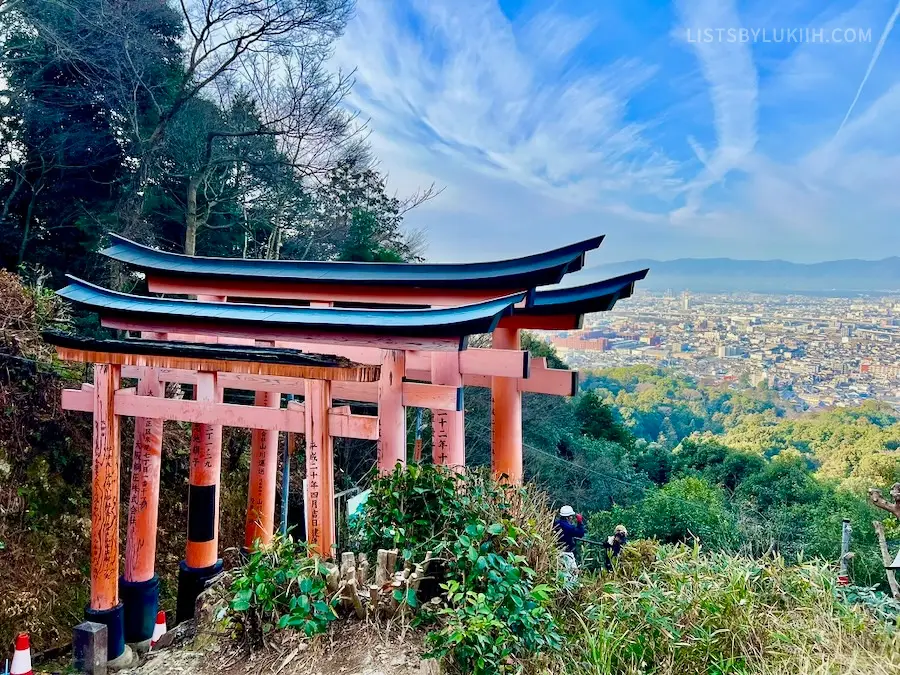
- Mount Fuji hiking – Mt. Fuji has four trails, and starting in 2024, you only need to pay for the Yoshida Trail, the most popular one. When I did the Subashiri trail, I just had the option to donate a small amount.
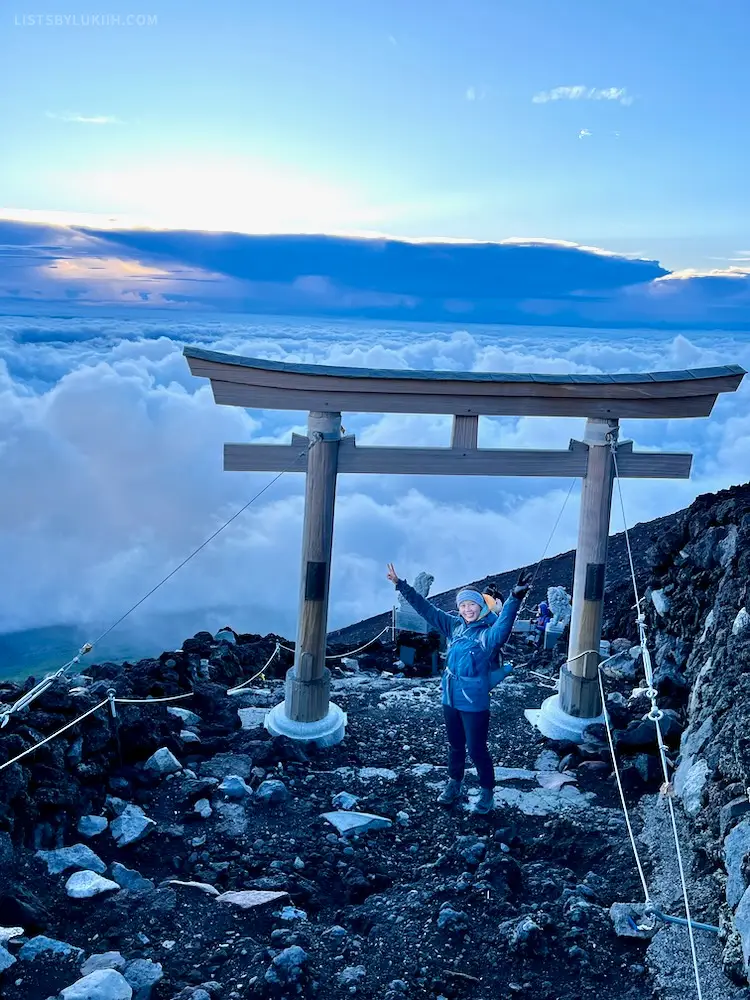
- Tokyo Metropolitan Government Building – Shibuya Sky is a popular sunset observation deck in Tokyo, but you can save $15 by going to the deck on the 45th floor of the government building instead.
- Parks – Tokyo has tranquil and beautiful urban parks, including Yoyogi Park and Shinjuku Central Park.

- Smaller temples – Many of Kyoto’s smaller and less well-known temples in the Arashiyama district and Philosopher’s Path are free.
- Bustling districts – You can spend hours walking around and window shopping in districts like Tokyo’s Akihabara and Osaka’s Dotonbori.
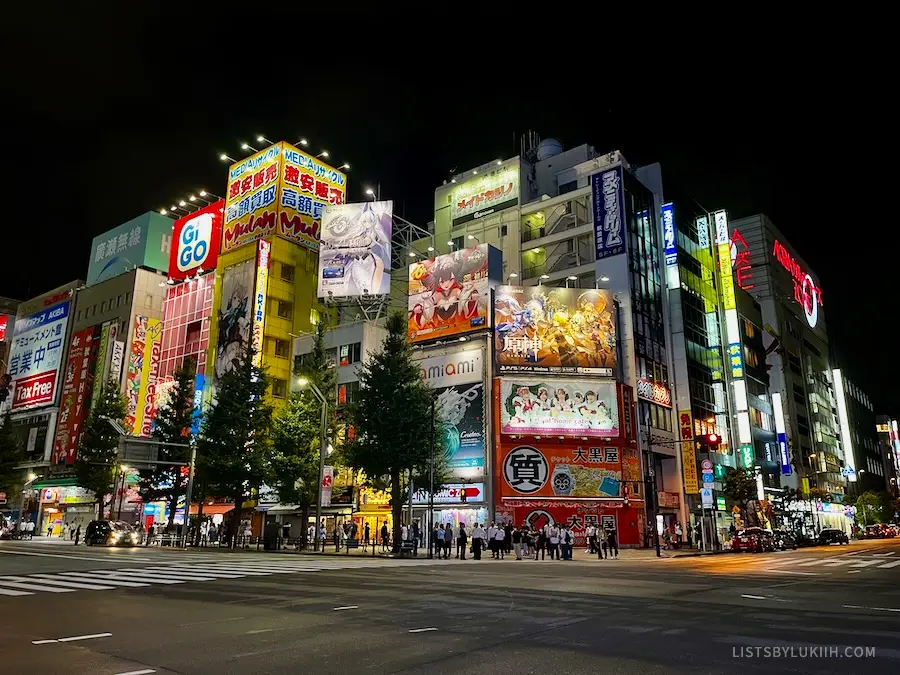
Cost Breakdown by Destination in Japan
Below are my trip expense breakdowns for Tokyo, Kyoto, and Osaka . These three major cities are often featured in first-timers’ travel itineraries.
I also spent time in the following places:
- I stayed at Gotemba , a nearby city of Mount Fuji, to hike up the iconic volcano . I spent $139 over two days while doing the hike.
- As part of the Shimanami Kaido two-day cycling activity , I stayed on Ikuchi Island and Imabari City. I spent $223 cycling the route.
🍱 Tokyo Trip’s Total Cost: $97
During my six-day trip to Tokyo, I averaged $99 in daily travel expenses.
In Tokyo, I stayed at two hotels in the Shinjuku and Nihonbashi areas to be close to major train stations. I paid to visit the Shinjuku Gyoen National Garden , watch an Olympics Qualifiers volleyball game at Yoyogi Stadium, and sing karaoke with some locals.

Tokyo is the most expensive city in Japan to live in, but it’s not the most expensive city to visit . With a plethora of restaurants and sights to see, you can explore Tokyo on your own for free or hire a local guide to optimize your time there.
⛩️ Kyoto Trip’s Total Cost: $616
During my two-day trip to Kyoto, I averaged $308 in daily travel expenses.
Kyoto is where I splurged more on accommodation as I stayed at a ryokan and a nicer hotel near the Kyoto train station. I also spent more on dining, as my two most expensive Japanese meals were here.
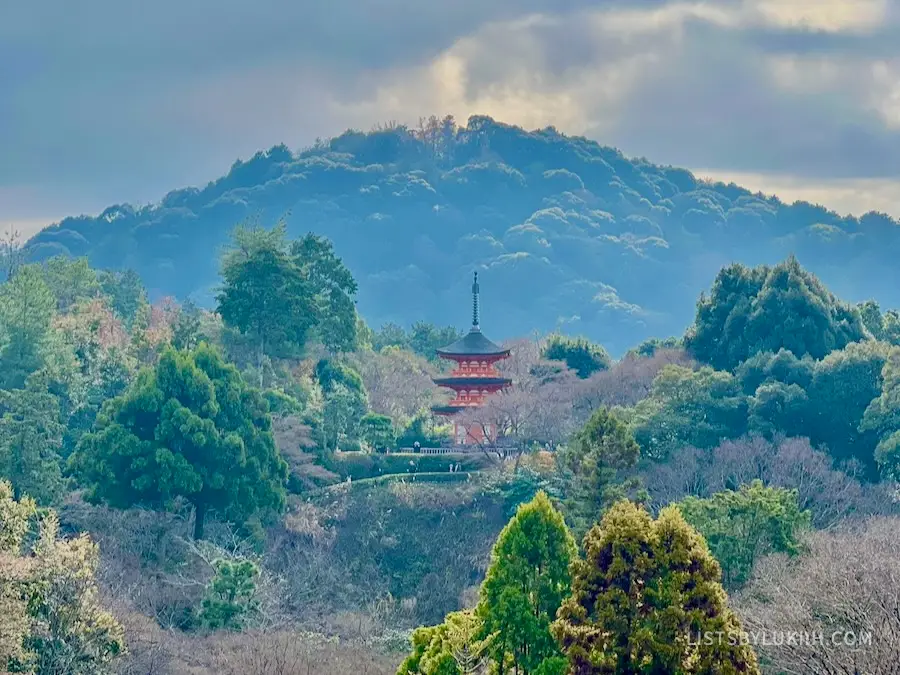
Kyoto is known for its well-preserved historical sites. It boasts over 1,600 temples, and all the major or popular ones have a small entrance fee (usually around $5). The city also has many free temples , like the ones found on the Philosopher’s Path or in the Arashiyama district.
🐙 Osaka Trip’s Total Cost: $50
I did a day trip to Osaka from Kyoto. During my short trip, I visited the Kuromon Ichiba Market , walked around the popular and bustling Dotonbori area, and visited the Osaka Aquarium , which I found to be unique and well-designed.
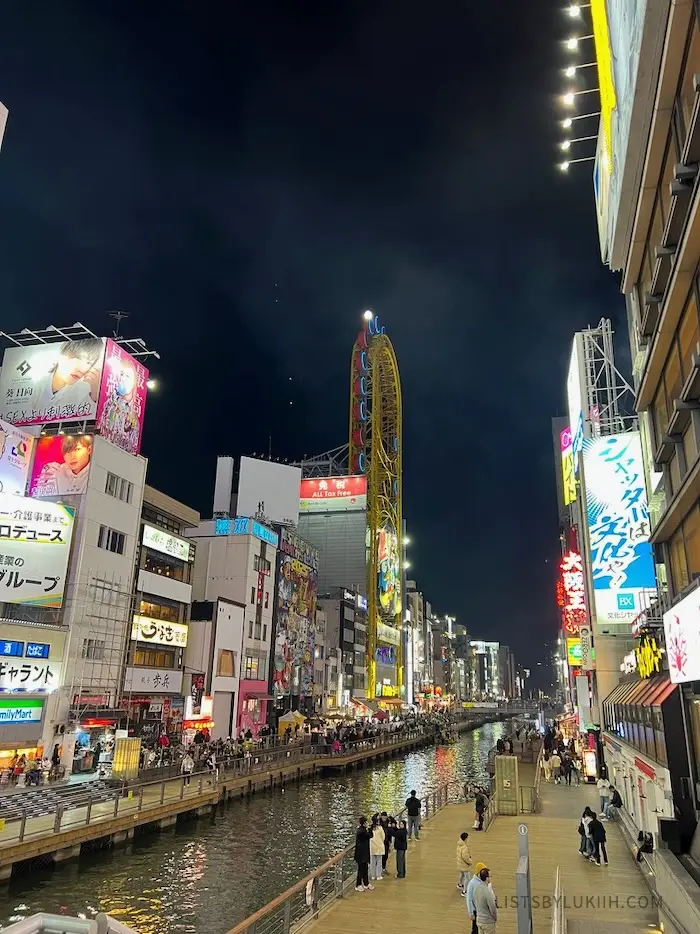
Osaka is called “Japan’s Kitchen” and a foodie’s paradise. It’s well-known for its street food, nightlife, and numerous Michelin-starred places, so expect to spend a bit on dining . If you like some guidance, plenty of English-speaking guides offer street food tours .
Do You Need Cash in Japan?
Although Japan has a good credit card infrastructure, a significant part of its economy is based on cash transactions . This is especially true once you wander outside its major cities, so make sure to bring some cash.
Below are tips on bringing and using cash in Japan.
💴 1. Withdraw cash in Japanese yen.
Japan’s currency is the Japanese yen (JPY), and the US dollar is not widely accepted.
ATMs are readily available in many central areas of Japan, but you might have trouble finding them elsewhere. For example, during my ryokan stay, I had trouble finding an ATM on the outskirts of Japan.
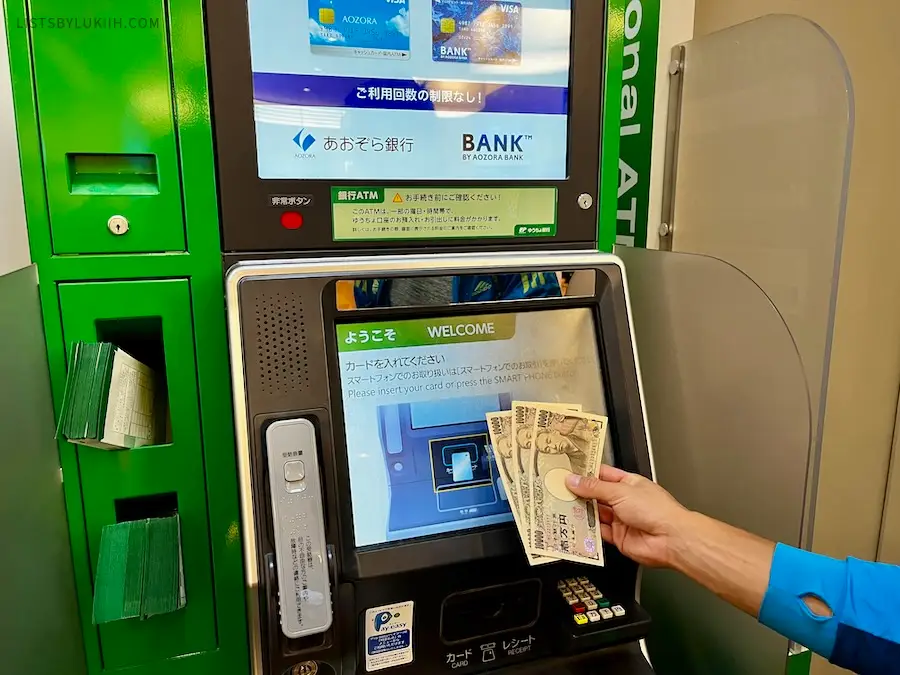
💵 2. Carry about $40 worth of cash per day in Japan.
On a typical day, a mid-range budget traveler in Japan will need at least $40 in cash to cover food, transportation, and attractions. A daily cash expense breakdown can look like this:
- $15 at restaurants and cafes
- $10 on shopping
- $5 on attractions
- $5 on taking the trains
- $5 on miscellaneous spending like vending machines, coin-lockers, etc.
Japan’s trains have a fixed price based on the distance traveled, so you must calculate the price every time you ride and buy a disposable ticket. However, you can buy a PASMO card to avoid calculating the price every time and minimize the amount of cash you need to carry.
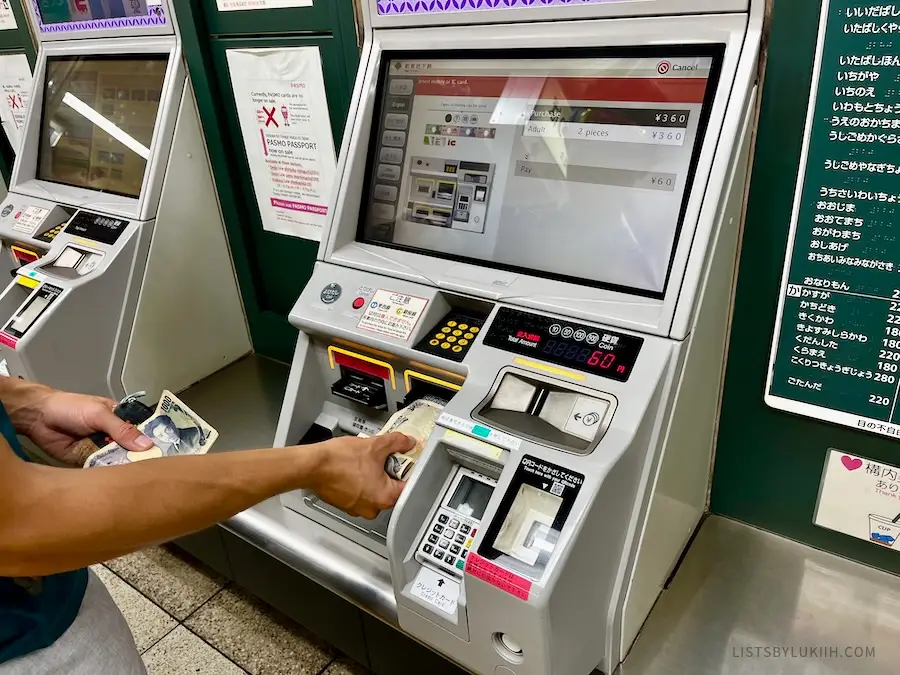
On my Japan trip, I spent a total of roughly $200 (about $15 per day) in cash. Here’s a breakdown of how I used my cash:
I keep my cash in my crossbody bag , but if you want extra protection against pickpocketing , carry it in a hidden money belt instead.
🏧 3. Many places in Japan are cash-only.
While credit cards are commonly used in Japan, I still had to use cash more than 30 times during my two-week trip. Here are some of the places that were cash-only in Japan:
- Markets – Kyoto’s Nishiki Market and Osaka’s Kuromon Ichiba Market are both cash-only.
- Restaurants – This includes places in major cities and smaller towns. I had to use cash in restaurants specializing in tofu, fluffy pancakes, ramen, and conveyor belt sushi.
- Cafes and bakeries – This includes a popular matcha place in Kyoto and an ice cream stand in Onomichi.
- Smaller shops – Shops tend to be cash-only in less accessible areas (e.g., at the top of the Fushimi Inari in Kyoto).
- Train stations kiosks – None of the kiosks took my Chase travel credit card, so I used cash for all my train rides.
- Coin-operated lockers – As the name implies, these lockers only accept coins.
- Smaller temples – Some less well-known temples in Kyoto had small entrance fees.
- Vending machines – Most vending machines in Japan are cash-only.
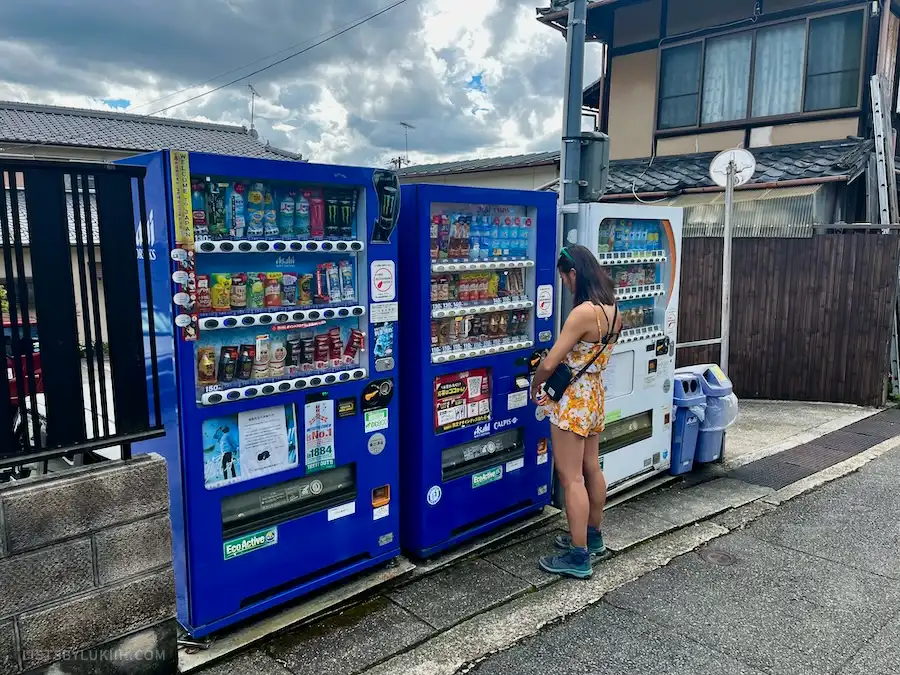
💰 4. Tipping is not customary in Japan.
Japan does not have a tipping culture, and you’ll find that locals will refuse tips even if you offer or insist. This is because they feel you’re already sufficiently paying for their service.
I offered a tip out of habit twice while in Japan, and my tips were refused both times.
See other essential travel tips for Japan before visiting.
Japan Trip Planner 2024
To make your travel preparation easier, download the trip planner below. It has destination-specific travel information, itinerary, map, and packing list.
My trip planners are built on Notion, which I use for all my travel planning. I genuinely love this tool and creating an account is free .

Thoughts? Questions? Leave a comment below .
Japan Travel Guides
- 🇯🇵 Planning a Trip to Japan: 11 Practical Things To Know
- ⛩️ 10 Epic Days in Japan: A Unique & Active Itinerary
- 🌋 Hiking Mt. Fuji: Firsthand Review & Tips
- 🚲 Cycling the Shimanami Kaido: Firsthand Review & Tips
- ⛩️ Fushimi Inari Taisha: Firsthand Review & Tips
- 🙅🏻♀️ Etiquette in Japan: 13 Things Tourists Should Not Do
- ☀️ Visiting Japan in September: Tips & What To Know
- ❄️ Visiting Japan in December: Tips & What To Know
Lists by Lukiih is Readers-Supported
If you find my travel tips helpful, say thanks with a bubble tea 🧋!
Leave a Reply Cancel reply
Your email address will not be published. Required fields are marked *
Save my name, email, and website in this browser for the next time I comment.
Budget Travel Guide
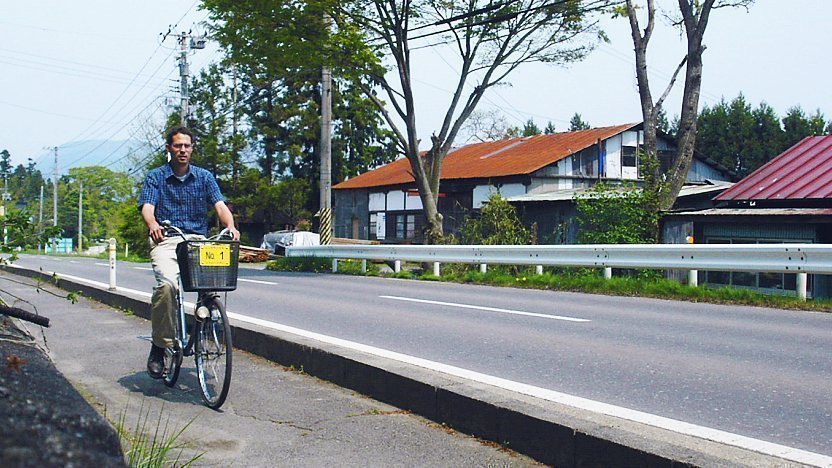
Unlike in much of the rest of the world, consumer prices in Japan have barely increased over the past decades. Add to it a weak yen , and you have a travel destination that is much more economical than the outdated misconceptions about expensive Japan would suggest. With careful planning and a little know-how, it is now easier than ever to enjoy a budget trip in Japan.
The following budget travel guide contains the basics on how to save money on a trip to Japan. In addition, check out our sightseeing guide for information on access and admission to specific destinations and sights and get answers to your questions in our question forum .
Questions? Ask in our forum .
Links and Resources
Hostelworld.com.


Japan on a Budget: The Complete Guide to Cheap Travel in Japan

How to Travel Japan on a Budget: The Only Guide You’ll Ever Need
Is is possible to travel to Japan on a budget? Definitely! Japan is one of the most fun and amazing travel destinations in the world. However, many travelers are reluctant to plan a trip to the Land of the Rising Sun because of the cost.
Known for being an expensive place to visit, many Japan lovers give up when they hear how much it costs to travel to Japan. In doing so, they miss out on the trip of a lifetime. It’s true that Japan has tons of luxury hotels, world-class restaurants, and first class transportation options that cost more money than most people’s mortgages.
However, Japan also has lots of cheap lodging, amazing food, and transportation options that are very easy on the wallet. In fact, Japan can be one of the CHEAPEST destinations to travel on a budget. If you want to visit Japan on a budget, this article will provide you with all of the tips, tricks, and advice to save you as much money as possible.
How to Get Cheap Flights to Japan
While it is possible to visit Japan by boat (namely from Australia, China, Taiwan, and Korea) the vast majority of visitors choose to go by air.
If you live in one of these nearby countries and have LOTS of time, check out your local boat companies for deals. Sometimes they sell last minute tickets at a fraction of the cost.
However, it’s almost always more efficient to travel by air.
So here are 5 tips to getting the cheapest airline tickets to Japan.
5 Tips to Find Cheap Flights to Japan
1. book as early as possible.
When searching for a flight to Japan, booking as far in advance as you can is best. Waiting until the last minute to grab reduced price tickets can certainly pay off, but it’s a big gamble if the tickets sell out (which happens more often than not).
You’re better off by being prepared, planning in advance and choosing to visit Japan at a cheaper time of year.
I usually buy my tickets at least a month before my travel date. I found that this is the latest I can wait before tickets sell out or really get expensive.
2. Avoid Peak Periods of Travel: Peak Times

Not only does the cost of airfare increase during peak times of travel in Japan, but hotels, attractions, and even restaurants raise their prices as well (usually buffets or nice restaurants that offer things like “special” holiday menus). If possible, try to avoid these peak travel times in Japan if you are on a tight budget:
- Golden Week: End of April – start of May
- Cherry blossom viewing: Late March – early May
- Summer: Mid-August is the busiest due to the Obon Festival
- Autumn: Changing colors of leaves (busiest time is late September due to Silver Week, a period of national holidays grouped close together)
- Spring: The end of March – the beginning of April. School children are on spring break, and lots of families travel during this time
- New Years: A popular time to travel during this time (domestic and international)
3. Cheapest Time to Fly to Japan
Here are the dates that generally have the cheapest flights to Japan
- Early to late December (before New Years)
- Just after the New Year holiday ends (people are usually back to work by January 5th) up until the end of March. However, Hokkaido has lots of visitors during this time due to all of the incredible ski slopes and winter foods. The world-famous Snow Festival also takes place in early February, which makes finding a cheap ticket to Hokkaido difficult.
- Mid May – June is also a cheaper time to visit.
While the winter season might not be the best time to visit Japan in terms of weather, you’ll usually save money on plane tickets. Winter foods in Japan are absolutely delicious as well. Delicious hot pot dishes, fresh crab, and other seafood are especially delicious in winter.
If you want all of the details and insiders tips on when to visit Japan, check out our best time to visit Japan guide.
4. Check for Internet Deals
Or course you could get cheap airlines tickets by choosing non-direct flights with long, inconvenient waits in between. But who wants to do that? Sure, you can save some money, but you’ll be giving up a lot of time and comfort by doing this.
Before going this route, spend an hour or two searching the Internet for the best deals. You can decide if a reduction in price with a 12-hour wait in some random airport is worth the inconvenience.
How to do Internet Research for Cheap Flights to Japan
Here are the steps I use to find the best deals to Japan:
1. Determine Both Your Budget and Which Airlines Companies You Want to Use
Of course, if you are willing to fly with any airlines, you’ll have the best chances of finding a cheap flight. However, I highly recommend you only use reputable carriers. There are lots of airlines with cheap flights to Japan, but they usually have very long layovers or delays, poor service, and safety issues.
Sometimes, it’s just not worth the risk. So to minimize your chances of having a bad flight, go with a reputable airline company. Airlines that fly to Japan differ depending on where you live, but I like Hawaiian Airlines, Japan Airlines (JAL), All Nippon Airways (ANA), and Korean Airlines.
2. Always Check Your Favorite Airline Carrier’s Website First
I always check the Hawaiian, JAL, and ANA Airlines website first. Most of the time, I find the best deals directly on their website.
Booking directly with the airline carrier is usually safer and more secure than booking with a third-party company. Be sure to check the prices often, as they can change frequently.
If the prices are high, proceed to step 3.
3. Do a Quick Search for Ticket Prices on a Multi-Search Website like Kayak.com
Other websites such as Skyscanner, Expedia, Jetstar, Kayak, Lastminute, and Farecompare are also good places to analyze ticket costs. Remember that flight costs will depend on where you’re flying from. Heading out from a major “hub” airport rather than a local one will certainly cut costs.
These websites search hundreds of travel sites and find the cheapest tickets out of all of them. Filter the searches by the airline carrier and how many layovers you are willing to have on your trip. Be sure to check the prices for different dates. Sometimes traveling just 1 day later can drop the prices significantly.
NOTE: I just do this to see what the average prices are for that dates of travel. I DO NOT purchase my tickets through Kayak unless there is an amazingly good deal though a REPUTABLE company. While there are usually cheap tickets that show up in the results, most of these are either a) flights with LONG layovers or b) flights listed by bad, untrustworthy third party companies.
In my experience, many of the companies that are listed on their website aren’t very trustworthy. Many of them have very bad reviews, with some even having complaints filed against them. Stick with the bigger companies like Expedia. Just use it to check the prices of the airlines you want to fly on.
4. Consider Buying a Ticket from Another Country or with a Different Currency
Choose the best 3 or 4 itineraries you found on Kayak/Expedia/Priceline/etc. I usually have the best results with Expedia.
At the bottom of the Expedia website, there’s a section called “Global Sites” with pictures of flags of different cultures. Choose a different country and search for the same flight. The ticket prices might be lower if you book it through another country with Expedia.

5. Fly into a Different Airport in Japan

If all of the flights to your desired airport in Japan are crazy expensive, consider flying to a different airport and then using the JR Rail Pass to take the train the rest of the way. If you don’t mind having a longer trip, the JR Rail Pass is a good way to cut costs.
You can fly into another major airport in Japan and then cash in your rail pass at the nearest participating station. Then you can take the bullet train to your desired location. While this does take more time, it can save you money and is much more fun that riding an airplane.
The seats on the bullet train are much more spacious than a plane and are much easier to travel. The only downside is that the bullet train doesn’t have space for big pieces of luggage.
Transportation in Japan: Saving Money on Domestic Travel
Finding a cheap way into the country is only half the problem. Domestic travel within Japan is also expensive. Of course, you could explore only one or two cities, which can cut costs dramatically by only paying local fares, especially if there are city passes available.
What makes Japanese so awesome is traveling to different areas to eat local foods and to experience the culture throughout Japan. If you want to explore many places in Japan, purchasing a travel pass will be your best bet. These passes can save you both time and money if you plan to travel a lot in Japan.
The JR Rail Pass: The Best Deal in Japan

The Japan Rail Pass is essential if you want to experience all that Japan has to offer. This pass allows you unlimited rides on most JR trains, including the bullet trains, as well as some JR buses and the JR ferry to Miyajima.
This pass opens up the whole Japan to you. You’re free to travel wherever, and whenever you want. I highly, highly recommend getting this pass.

This pass also makes traveling much easier. You don’t need to research ticket prices or deal with buying or keeping track of your tickets for each trip. Just walk on through the gates on the side and show your pass to the attendant.
Also, if you don’t mind sitting in the unreserved area, you can walk straight onto the train too – although reserving specific seats ahead of time is certainly recommended for busy times/seasons/routes.
How the JR Rail Pass Works
IMPORTANT: You can’t buy a Japan Rail Pass while in Japan. You must purchase your pass before you arrive in Japan. The pass is only for those on a tourist visa.
Also, keep in mind that the JR pass cannot be used on every type of transport. For example, you cannot ride the NOZOMI or MIZUHO type bullet trains using a Japan Rail Pass. This isn’t usually a problem, though.
The NOZOMI trains travel the exact same route as other types of bullet trains but only stops at major stations. A full list of what you can and can’t use the pass for can be found on the rail pass website .
JR Rail Pass Prices
There are two types of pass you can buy. A “green pass” allows you to sit in the first-class section of the train. However, not every train has a green car (first class section). The “ordinary” JR Rail Pass is the more economical option. Both of these passes can be used to make seat reservations for the bullet train.
Passes are available for periods of 7 days, 14 days, or 21 days. The countdown will start on the day you activate your pass. You do not have to activate it as soon as you arrive in the country. You can redeem it anytime during your trip.
Just take your rail pass voucher to a JR Station that can redeem it. A list of places should be included on a sheet with your voucher. However, most big, urban JR stations can activate your rail pass.
JR Rail Pass Prices (2017)
Prices for adult “original” passes:
- 7-day pass: 29,110 yen
- 14-day pass: 46,390 yen
- 21 day pass: 59,350 yen
Prices for child passes (age 6 to 11):
- 7-day pass: 14,550 yen
- 14-day pass: 23,190 yen
- 21-day pass: 29,670 yen
The passes may seem expensive but can save you an incredible amount of money if you travel a lot during your trip. A round-trip ticket from Tokyo to Kyoto would already cost 28900 yen, nearly the full price of a one week pass.
A typical 7-day trip for tourists would look like this:
- Days 1&2: Tokyo
- Day 3: Osaka
- Days 4&5: Kyoto
- Day 6: Hiroshima
This itinerary would cost you 41,640 yen, not including all of the local trains you’ll ride within these cities. If you were to return to Tokyo from Hiroshima, the total cost would be 60,200 yen, which is more expensive than a 21-day pass.
If you plan to visit more than one city by bullet train on your trip to Japan, a rail pass is an absolute must.
Where to Buy the JR Rail Pass
There are a few different agents you can use to order your Japan Rail Pass. Be sure to check the details. Some airlines sell rail passes, but you must book your airlines ticket with them as well.
Here are some of the main agents through whom you can purchase the pass: Tobu Top Tours, JTB Corp., KINTETSU INTERNATIONAL, Japan Airlines, Nippon Travel Agency, ANA Sales Americas (Los Angeles), and JALPAK. Check the website for details on how to purchase a rail pass.
Special Passes to Save You Money on Travel in Japan
As well as the Japan Rail Pass, there are other special tickets and passes you can buy to cut costs on your trip to Japan. Some tickets are regional, but others can be used all over the country.
Seishun 18 Pass

This is another offer from the JR (Japan Rail) company. This ticket is similar to the Japan Rail Pass, but it is more limited. However, the reduced cost makes this pass a great option if you’re trying to travel on a budget (and have lots of time).
The Seishun 18 ticket is a seasonal offer only. You can use the ticket for a 5 day period during the spring (early March to early April), summer (mid-July to early September), or in the winter (early December to early January). The exact dates are released when the tickets become available.
You can use this pass for unlimited travel on all local and rapid JR trains. You cannot use it on Shinkansen rides (bullet train) or on limited express travel.
The Seishun 18 is a 5-day ticket, costing 2,370 yen per day – a total of 11,850 yen.
A fraction of the price of the Japan Rail Pass, this is a great option if you want to do lots of little trips or one or two big journeys during the 5 day period. Interestingly, the ticket can also be shared between up to 5 people. You could have use of it for one day each and your friends could use it the other days.
Where to Buy the Seishun 18 Pass
You can buy the Seishun 18 ticket in the JR East station travel centers, or at JR Ticket Offices. Advance booking is available. Dates for when the passes go on sale are listed on the website along with the details, which usually becomes available from 1 to 3 weeks before the pass becomes available.
Hakone Free Pass
Hakone is an amazing place to visit. It is filled with stunning natural beauty, especially when the autumn leaves change and the cherry blossoms bloom in the spring. Whatever the season, Hakone is a wonderful place to visit. Amazing hot springs, outdoor walks, mountain hikes, surrounded by peace and quiet. It’s pure bliss.
The Hakone Free Pass is a must for people heading out that way. It gives you free travel on eight different types of transport in the Hakone area for a 2 or 3 day period, as well as discounted entry to dozens of attractions, including hot springs, museums, galleries, historical sites, parks, restaurants, shops and more. A full list is available on their website .
The Hakone Free Pass has different prices depending on where you depart from.
While you can get passes that are valid from Machida and Odawara, most travelers start their journey at Shinjuku. However, if you are heading off from one of the other two locations, be sure to check out the details as those tickets are a little cheaper.
From Shinjuku:
2-day adult pass: 5,140 yen
3-day adult pass: 5,640 yen
For children:
2-day pass: 1,500 yen
3-day ticket: 1,750 yen
Where to Buy the Hakone Free Pass
Hakone Free Passes can be purchased at any Odakyu line station, including Odakyu line ticket machines.
JR Tokyo Wide Pass

If your trip to Japan will be focused in and around Tokyo (there is so much to do there that you could easily spend your whole holiday there) then you should consider buying the Tokyo Wide Pass.
This 3-day ticket offers unlimited travel in Tokyo and the surrounding Kanto area. Including both the Narita and Haneda airports, you can pick up your pass on arrival, and it will cover the cost down into central Tokyo, and everything else for the rest of the period of validity.
Like the Japan Rail Pass, this ticket is only available to people with a tourist visa. As it is only valid for 3 days, you could easily get yourself one of these passes to use for a few days in Tokyo, then after that head off around the rest of the country using a Japan Rail Pass.
The 3-day pass is 10,000 yen for adults and 5,000 yen for children aged 6 to 11.
Where to Buy the JR Tokyo Wide Pass
You can buy a Tokyo Wide Pass at the JR Ticket Offices and JR Travel Agents located in the Haneda International Airport and in the Narita Airport Terminals 1 and 2, and 3.
The passes are also available at JR travel centers and general travel service centers at various locations, including Shinjuku, Tokyo, Ueno, Shinagawa, Shibuya, Ikebukuro, Yokohama, and Mito. Check the website for details.
Domestic Air Travel
Train passes are good for people who want to travel a lot, but what if you only want to explore one or two areas? While the rail passes are, on the whole, cheaper than buying individual tickets, they are still quite costly if you aren’t going to be getting a lot of use out of them. So if this applies to you, take a look at budget local airlines for domestic travel.
Low-Cost Carrier (LLC) Flights

Several airlines in Japan offer flights to various locations, and often at a fraction of the price of the same journey by train. Of course, you need to factor in all costs to make sure you’re getting the best deal. Keep in mind that getting to the airport might involve time-consuming/costly trips on the subway or train.
However, this depends on the city. For example, in Fukuoka, the airport is only a 5-minute subway ride away from the central train station.
Two of the most well-known budget airlines in Japan are Peach and Jetstar.
Both of these airlines fly to a variety of locations, including Tokyo, Osaka, Sapporo, Kagoshima, Fukuoka, and Nagasaki.
Other popular domestic airlines include JAL (Japan Airlines) , ANA (All Nippon Airways) , Skymark Airlines , Vanilla Air , Spring Airlines and Solaseed Air .
Taking a plane instead of a train, even for a short journey, can make a huge difference in price.
For example, reserving a seat on the train from Kumamoto to Tokyo will cost a total of around 27,000 yen (and take about six hours!) whereas the same journey by plane (using Jetstar airlines) will cost less than 7,000 yen.
Taking the train from Kagoshima to Osaka will set you back around 22,000 yen, vs. a flight on Peach Airlines can cost you less than 6,000 yen. That’s a huge discount!
Special Airlines Discounts
If you prefer to take Japan Airlines or ANA Airlines, here are a couple of special discounts you can use.
JAL: Special Japan Explorer Pass – 10,800 yen flights to over 30 different cities in Japan.
Restrictions: Only for short-term visitors. Must have a ticket leaving Japan to be eligible for this special pass. You also need to purchase these flights directly through the JAL website.
ANA: Experience Japan Special Fares : 5,500 yen flights to cities within Hokkaido, or 7,700 – 11,000 yen flights for any other destinations.
Restrictions: You need to reside outside of Japan, have a passport from a country other than Japan, and have an international ticket leaving Japan.
Traveling by Bus

Probably the cheapest way to travel long distances in Japan is by bus. Taking a highway bus is not the most popular option, but can be a great way to save money on both short and long trips.
A popular bus provider is Willer Express. You’ll be surprised to know that you can make online reservations in English when booking through Willer Express. Most other bus companies don’t have online or English reservations.
Other companies to look into are Japan Bus Online, Hankyu Bus, and JR Bus branches (split into eight regional companies).
Insider’s Tip
Most bus companies offer different types of seating for overnight buses. These range from the cheapest 2-seater style seats (think of an American school bus) to super comfortable individual seats.
The price difference is significant, but if you’re taking a long bus (over 8+ hours) I highly recommend that you purchase a better seat. The buses with 3 seats per row are very comfortable. The seats are not connected, which makes it feel like you have your own personal space.
I took an overnight bus from Kobe to Tokyo on Willer Express with the cheapest seats (which was only 2,500 yen or so). While the bus looked new and the ride was smooth, it was the one of most cramped, cold (it was during winter), and uncomfortable experiences of my life. The better seats were 2 to 3 times more expensive, but I would definitely purchase those seats next time. These upgraded seats would still be much cheaper than taking a bullet train.
Taking the bus can also save you on money on hotels. You can sleep on overnight buses that run late into the night.
Japan Bus Pass
If you plan on traveling all around Japan, consider the Japan Bus Pass.
This pass can be used on all daytime and overnight buses provided by Willer Express. There are 3-day, 5-day, and *7-day passes, with 2 different prices depending on if you’ll be using it from Monday to Thursday or over a weekend period. A 3-day Monday to Thursday pass costs just 10,200 yen.
*NOTE: The 7-day pass is only valid during Monday – Thursday, but you don’t need to use the 7 days consecutively.
There are a few rules. The pass can be used for up to 3 rides per day, but you can’t use it on premium buses. However, on the plus side, this is one of the “only for foreign visitors” passes which can also be used by foreign residents. That means that JET teachers and other ex-pats who usually miss out on the great travel deals can use the Japan Bus Pass.
For more information: Willer Bus Pass Page
Cheap Places to Stay Overnight in Japan
Finding a place to stay is one of the major concerns for people wanting to travel Japan on a budget. There are tons of luxury hotels that cost a fortune, but there are also lots of budget hotels as well. A discerning eye can track down cheap accommodation all over Japan. The key is knowing what kind of lodging to look for, and where to find it.
Finding Cheap Deals Online

With price comparison websites and dedicated travel companies providing endless lists, this is the best place to start your search. However, bear in mind that these websites have more listings in big cities. Small towns in the countryside will probably yield very few search results. If you’re hoping to visit somewhere off the beaten track, you may need to find other ways to find lodging there.
One of the best websites to use is Booking.com . This website is easy to use and often has great deals. It is also a reputable company that most people trust. I recommend Booking.com because it offers a whole range of different sorts of accommodations. From fancy hotels to local ryokans, you can find something in your budget.
However, there are some popular hotels that are not listed on Booking.com. Agoda.com comes to the rescue in most cases.
Most of the lodging options that aren’t listed with Booking.com can be found on Agoda. I always check both of these websites anyway, to compare prices for the same hotels.
Other good websites are Rakuten, Hostelworld, Japanican and Jalan.
Accommodation Booking Websites
Booking.com : Best choice to reserve most types of accommodations (hotels, Japanese inns, hostels, capsule hotels, etc.)
Agoda.com : Not as easy to use as Booking.com, but has some hotels that are not listed on Booking.com
If you’re having trouble finding something, or the hotel you want is fully booked, check out the Japanese version of the site.
Particularly on Jalan and Rakuten, it might appear that something is fully booked, but when you check the local website, there is still availability! Also, the Japanese website sometimes lists a cheaper price.
The only downside to this is you need to be able to read Japanese.
However, if you are just booking a room (no meals or other services) you can probably book a reservation in Japanese by using “rikaichan” which is an add-on to the Mozilla Firefox browser (for Google Chrome, the extension is called “rikaikun.” When you turn it on and hover your mouse over Japanese characters, it will show you the reading and the definition of the word.
Google Chrome: Rikaikun Mozilla Firefox: Rikaichan
Business Hotels

One of the most affordable types of accommodation in Japan, business hotels are certainly “no frills, ” and you get what you pay for.
They are hugely popular, as the name suggests, with Japanese business people (mainly men) who travel a lot for work.
Business hotels are a good choice if you plan to explore Japan all day and just want a bed to sleep in at night. You find them all over Japan, with many big chains all over the country, with their rooms looking the same whether you’re staying in a big city or out in the countryside.
Major companies to look out for include Toyoko Inn, Daiwa Roynet Hotel, Dormy Inn, Chisun Hotels and Route Inn.
How Comfortable are Business Hotels?
Rooms are functional with minimal decorations. Some rooms can be very small (the bed and drawers take up most of the space). Beds are very standard but usually pretty comfortable. There’s usually a TV, small refrigerator, a hot water pot, and internet access (either by ethernet cable or wi-fi).
The bathrooms are usually very tiny but they do the job unless you are very tall or big. Most business hotel bathrooms are stocked with basic amenities (toothbrush, soap, shaving razor, etc.).
Average Prices
A single room in a business hotel will cost you between 4,000 Yen to 10,000 yen a night, whereas a twin or double room will be the cheaper option if split between 2 people. For a twin, prices are around 7,000 yen to 12,000 yen per night.
Capsule Hotels

One of the most famous types of Japanese lodging, staying in a capsule hotel is definitely an experience. The first ever capsule hotel opened in Osaka, Japan, and now you can stay in similar lodgings all around the world.
They may look like fun, but capsule hotels aren’t always all that they’re hyped up to be. It is small, but not as small as most people think. Most capsules are big enough for you to sit up inside without hitting your head.
However, it’s somewhere to sleep and nothing else. Also, many capsule hotels are for men only. They’re geared at businessmen and often don’t have capsules for women. Some capsule hotels have a “female only” floor, though. You’ll find them in big cities, but smaller towns throughout Japan are unlikely to have mixed gender capsule hotels if they have one at all.
Are Capsule Hotels Comfortable?
For the first day or so, capsule hotels are decently comfortable. However, it doesn’t take an expert traveler to know that these are not good for long term stays. There is only so many nights in a row that sleeping in what is basically a well-lit coffin can be counted as a fun novelty rather than an annoyance.
Depending on your fellow travelers, capsule hotels can easily be noisy, crowded places, and while many hotels offer lockers or other places to store your belongings, theft, while not rampant, is more common in these lodgings than in other types of accommodation.
Capsule hotels are far from the most luxurious hotel, but they do come cheap! Spending a night in a capsule hotel can cost as little as 2,000 yen. However, is it worth it? Some travelers thrive on this sort of “simple” accommodation, but if it doesn’t sound like your cup of tea, move on to another type of hotel.
At best, make your stays in capsule hotels a one-night-at-a-time affair when you are just stopping over or arriving somewhere too late to make use of a regular hotel room. In these instances, the low cost is worth the inconveniences.
Japanese Hotels
This is probably the type of lodging with the widest variation between properties. Some hotels in Japan are little better than business hotels. The rooms have basic furnishings, no decorations or excessive comfort, and is just somewhere to spend the night.

At the other end of the scale, you have fancy hotels which are amazingly luxurious. Fully furnished rooms, spacious bathrooms, communal areas with massage chairs, gym facilities and even swimming pools.
There is great variety between different hotels in Japan. The number of choices can be overwhelming. The good thing is that many hotels are conveniently located near to train stations or bus stops.
Are Hotels in Japan Comfortable?
This really depends on what kind of deal you’re looking for. A cheap hotel will, naturally, not be very comfortable, but it will cost a mere fraction of the cost when you compare it to mega hotel chains like MyStays, APA or Nikko. In general, bigger hotels in Japan are comfortable and are good for both sleeping and relaxing in.
Cheaper hotels are usually around 8,000 yen per night, with luxury hotels priced 30,000 yen to 60,000 yen or more per night. While many hotels might look out of your budget, it’s worth keeping an eye out for special deals. For example, the MyStays chain is a delightful place to stay, but with the rooms usually priced at 20,000 yen per night, it’s not exactly a budget choice.
However, on websites like Booking.com you can regularly see special deals when booking in advance, which see those rooms listed at half price, or less!
Why pay 8,000 yen to stay in a terrible business hotel when you can splash out a little and stay in a palace for 10,000 yen?
Even budget travelers need to relax once in a while, so if you need a night of luxury, this is a great option to check out.
Minshuku / Ryokan

These are types of traditional Japanese accommodation, which are just as popular with foreign visitors as they are with locals. Cheap hotels are all well and good, but if you want to experience local hospitality and step back in time, you can’t beat spending the night in a ryokan or minshuku.
They are pretty similar, it’s just that minshuku tend to be smaller, located in older buildings and usually run as a family business. Ryokans are often run like this too, but sometimes they are located in newer, bigger buildings and have more staff with more services.
Are Ryokan and Minshuku Comfortable?
Staying in traditional Japanese accommodation isn’t for everyone.

For starters, you’ll be sleeping on the floor on a traditional futon, and the flooring will probably have tatami mats rather than carpet.
Sometimes ryokans and minshukus have showers, but often they only have traditional communal bathing facilities – and these will likely be down-to-earth and not luxurious unless you’re staying in an “onsen ryokan” which is specifically designed for spa relaxation.
However, if you like experiencing different cultures in local style, these can be very comfortable places indeed. They vary a lot – some have fun, bubbly atmospheres like youth hostels, with a variety of characters lounging in the common areas, and are quieter than an emply library. Check reviews to see what other travelers think before you make a booking.
These can vary quite a lot, particularly between little minshuku out in the countryside, and fancy onsen ryokan in a swanky location. However, lodging like this is seen less and less in big cities – it’s more frequent to see ryokan and minshuku out in the countryside and on the outskirts of small towns.
The cheapest minshuku can be seen at around 4,000 yen per night, up to about 9,000 yen per night. Ryokan can be as cheap as 5,000 yen or less per night, up to 60,000 yen per person for luxury inns. Be sure to check whether prices are per person or per room.
Internet Cafe / Karaoke Rooms

If you told a Japanese person that you were planning on spending the night in an internet cafe or private karaoke room instead of booking into a hotel, they’d probably think you were a bit weird. That isn’t because you can’t stay overnight in these places – it’s certainly a popular option.
It’s just that few people plan to use this kind of accommodation. The usual overnight clients at these types of establishments are salarymen who stayed out too late drinking and don’t want to go home and face the wrath of their wives, or young party animals who missed the last bus home and need somewhere to stay.
You can choose a public or private space, and choose between a normal chair, reclining chair, floor space or whatever other options they provide.

Are Internet Cafes in Japan Comfortable to Sleep In?
Generally not comfortable in at all. These rooms are not designed for sleeping in, they’re designed for surfing the internet or playing online games. You probably will not get a good nights sleep in a place like this.
They can be noisy, uncomfortable and full of people who are doing anything but sleeping. However, they are super cheap, and often there are shower facilities which you can use for a small charge, and machines which provide free soft drinks, ice-cream, etc.
If you want to try and get a good night’s rest in an internet cafe, be sure to choose the “floor” type of room. This is the only type of room that has enough space to lie down. The other types, come with reclining chairs, or small couches, which makes sleeping difficult.
This depends on how long you stay. Some places charge by the hour, and others have deals where you can stay up to a certain number of hours for a fixed price. You may have to pay in advance. Generally, one night in an internet cafe or similar place will cost 2,000 yen or less.
You can’t book in advance – just turn up, and be wary of busy times. There is usually a crowd around the time just after the last trains/buses have left, so be sure to arrive before then.
Food on a Budget

Eating out in Japan can cost a lot of money if you don’t know where to go. When you arrive in Tokyo, everything looks so delicious it can be difficult to hold back, even when you know you’re on a budget. But there are several ways to make savings in Japan without sacrificing all the delicious culinary experiences that are waiting for you.
Knowing a few tricks can save you a bundle – which you can use to treat yourself to a really extravagant meal. Use these tips to eat well while saving you some cash.
Cheap Restaurants in Japan
Just because you’re cutting down on costs doesn’t mean you need to miss out on eating at restaurants during your trip. There are plenty of budget restaurants in Japan where you can get a tasty meal for a reasonable price. Following these few hints will ensure you get the best value for money without sacrificing your dining experience.
Lunch Deals
If you want to find deals for food in Japan, lunchtime is king. Many restaurants have special menus at lunchtime where you can get the same food available in the evening, but at a lower price. The portions are usually a little smaller, but still worth it.
There are some hearty lunch sets that will leave you stuffed until dinnertime though. Even fancy restaurants offer lunchtime sets for 1,000 yen to 2,000 yen.
Cheaper restaurants sometimes offer a “one coin” lunch which will set you back just 500 yen (1 coin). This is especially a good deal for expensive foods like Kobe beef. Eating Kobe beef for lunch can save you a lot of money.
Gyudon (beef bowl) is one of the more popular cheap eats in Japan, and it soon becomes a favorite of foreigners traveling Japan on the cheap. “Don” means a bowl (with rice), and “Gyu” refers to the beef topping. Plenty of different “don” are available throughout Japan.

Thin strips of beef and slices of onion are simmered in a sweet sauce consisting of soy sauce, mirin (sweet rice wine) and dashi (Japanese broth). Gyudon sets are often accompanied by a raw egg (for dipping the beef in), miso soup, salad, pickles, and tofu. You can get extra toppings like kimchi, cheese, green onion and grated yam.
Popular chain restaurants where you can purchase these dishes, and other cheap options, are Sukiya, Matsuya, and Yoshinoya. You can find these restaurants all over Japan, serving gyudon in portions of different sizes depending on how hungry you are.
A simple bowl of gyudon will cost you about 350 Yen (bargain!). For a set, you’re looking at between about 500 yen and 750 yen. An awesome deal for a quick and delicious meal for the hungry traveler.
Famiresu – Family Restaurants

As eating out is a popular weekend treat for families in Japan, there is a special type of restaurant which cater to this demographic – famiresu ファミレス , which stands for “family restaurant.”
With a mix of Japanese and Western style food at low prices, these places are also a great choice for budget travelers as it allows you have a filling meal in a comfortable environment for a relatively cheap cost. They also tend to have cheap alcohol so are good of you need a treat!
There are many different chains of famiresu in Japan, some of which have specialty dishes or styles, but they are all pretty much the same.
Here are some of the big names which you’ll see around: Gusto, Royal Host, Jolly Pasta, Denny’s, Joyful, and my personal favorite, Saizeriya. Meals cost as little as 500 yen, but taste great.
Teishoku Restaurants – Set Menus
Teishoku restaurants serve meals that follow this basic principle: one main dish, soup, and one side dish. You order whichever main meal you’d like, and it comes with a little plate of pickles, perhaps some tofu or a salad, and a bowl of miso soup.

These vary from place to place, but the combinations are the same. Main meals vary, serving seasonal products throughout the year but also traditional Japanese favorites: udon, katsu don, gyudon, karaage fried chicken, etc.
Some restaurants have a vending machine at the front where you purchase a ticket for your meal. You then hand the ticket to the server once you’ve taken your seat. Food is cheap, ranging from about 500 yen to 1,000 yen for a meal. Teishoku meals give you a taste of popular Japanese foods that can be found all over Japan.
Japanese Supermarkets

You may not think of visiting a supermarket for food during your trip to Japan, but it’s actually a great place with lots of choices. Supermarkets in Japan, whether they are small or large, have a great selection of ‘prepared food,” and they usually have a microwave where you can heat it up too.
Larger supermarkets will often have a seating area with tables where you can sit and eat. Bento boxes are a popular choice, with rice, meat, vegetables all packaged up neatly together. You can get all sorts of food in the supermarket – tempura, sushi, tendon, udon, salads, sandwiches, onigiri (rice balls), fried rice, Chinese steamed buns…the list goes on and on.
Price wise, a small bento at the supermarket could be 300 yen or less, while bigger bento with lots of different dishes cost around 400 yen to 600 yen.
Daily Discounts
The best thing about supermarket dining is the price discounts at the end of the day. From the early evening up until closing time, supermarkets reduce the price of their prepared food, making it even cheaper. At about 6:00 pm you can see savings of 10% or 20%, and then by 9:00 pm the reductions are as low as 50% off, or more.
However, by this time it’s slim pickings and the other customers around at that time as just as eager to grab a bargain, so you have to be decisive and time your visit wisely. If you go too early the savings are small, but go too late, and all of the food is gone.
This is a great option if you’re staying somewhere with a fridge. You can buy your meal late at night and then keep it for lunch the next day. If you really want to save money, you could easily get by on spending around 1,000 yen per day on food.
Cheap Attractions in Japan
If you aren’t fussy about how you spend your leisure time in Japan, it doesn’t need to drain your bank account to see and do amazing things. There are plenty of attractions which you can see cheaply, or even for free.

Parks and temples are often free to visit, and while some specialist museums can be costly, many others have very cheap admission fees.
Hiking and city walks don’t cost a thing, and attending local festivals are some of the best attractions you can see for free in Japan.
For attractions you need to pay for, you can often get combination tickets or discounts. Some small towns offer a combination ticket to encourage visitors to see more of their attractions. Big cities offer pricier combination tickets where you can get entry to dozens of attractions with just one ticket.
The best place to find out information about free and cheap attractions is at a local tourist center. Many centers have brochures with coupons for discount tickets, and the staff there can advise you on how to make the most of your trip for the cheapest cost.
Free local guides are a popular way to see Japan on the cheap. Often run by volunteers who want to practice their English, taking a free tour can be done in a group or even on a one-to-one basis. Research free guides for the area you’re visiting to see what’s available.
Shopping on a Budget in Japan

The cost of shopping in Japan varies greatly depending on where you are and what you want to buy, but the best tip I can offer you is to visit a 100 yen store.
These shops sell everything under the sun, including stuff that tourists want to buy (like Japanese fans, hand towels, chopsticks, fake lacquer bowls).
Almost everything in the store costs 100 yen (+ 8% tax) and if things cost more then they are clearly marked.
Popular 100 yen store shops are Daiso, CanDo and Seria.
TheTrueJapan
Leave a comment cancel reply.
This site uses Akismet to reduce spam. Learn how your comment data is processed .
This site contains affiliate links to products and services we recommend or review. If you click through the links we provide and make a purchase, we may earn a commission.
As an Amazon Associate, I earn from qualifying purchases.
Copyright © 2023 The True Japan
Nomadic Matt's Travel Site
Travel Better, Cheaper, Longer
Japan Travel Guide
Last Updated: April 29, 2024
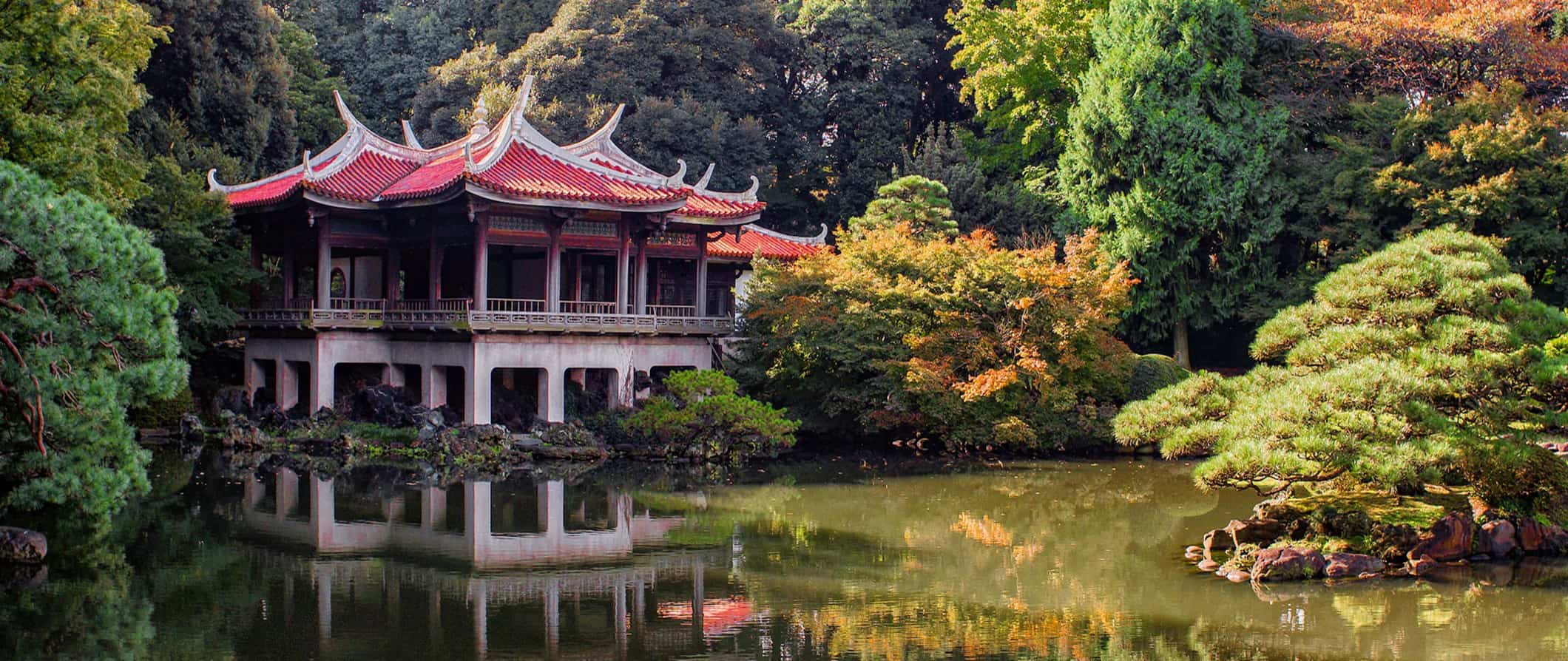
It was a lifelong dream to visit and, when I finally did, it lived up to all my expectations. Since that first visit, I’ve been there over five times. Japan is a country that blows everyone away. From the food to the people to the architecture and everything in between, I’ve never met someone who didn’t go to Japan and fall in love with it.
A lot of people delay visiting Japan because they think it’s super expensive. And, while some aspects of traveling there are expensive, there are plenty of ways to make it affordable. I was actually shocked how easy it was to see Japan on a budget .
This Japan travel guide can help you plan an affordable trip so you can see more, eat more, and spend less.
Table of Contents
- Things to See and Do
- Typical Costs
- Suggested Budgets
- Money-Saving Tips
- Where to Stay
- How to Get Around
- How to Stay Safe
- Best Places to Book Your Trip
- Related Blogs on Japan
Click here for City Guides
Top 5 things to see and do in japan.
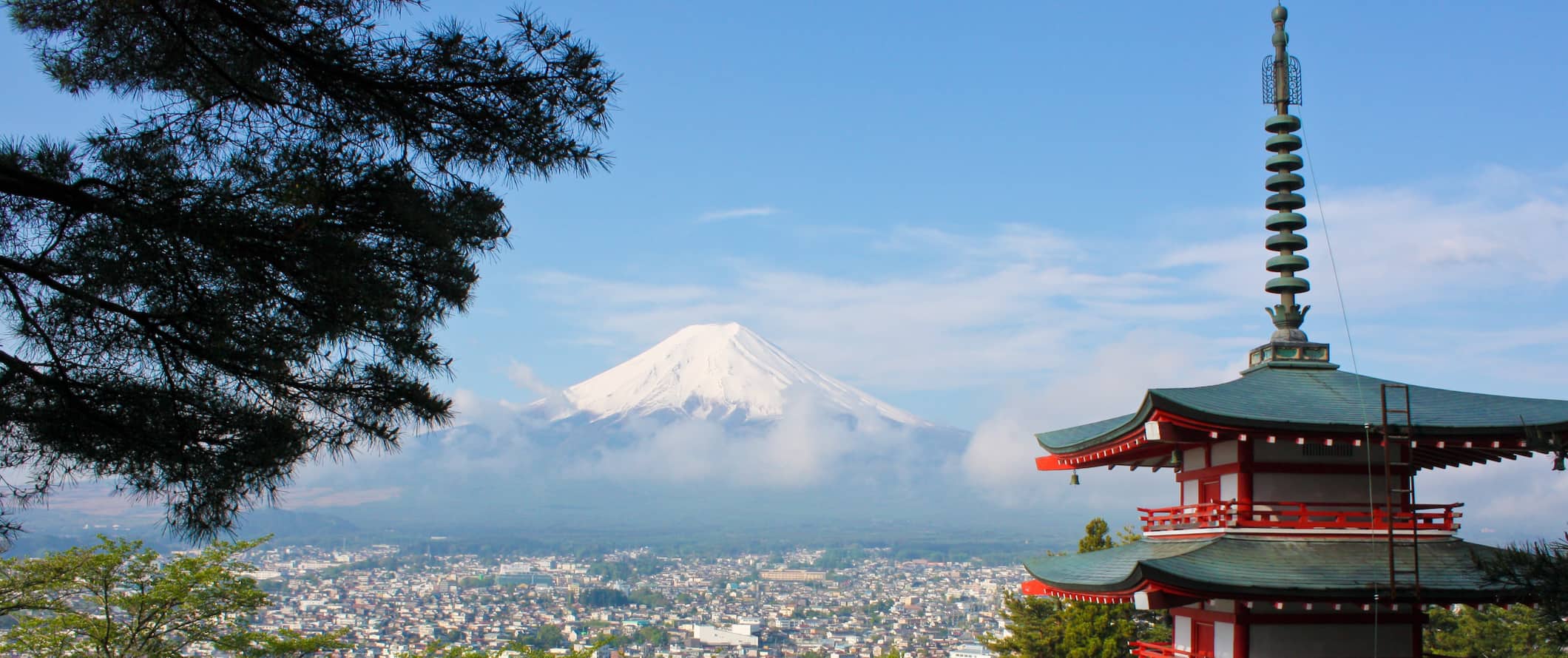
1. Explore Tokyo
Tokyo is one of the best cities in the world. Here you will find shrines, palaces, temples, hip clubs, fancy cocktail bars, weird fashion, and, of course, incredible people. Tokyo is a fast-paced, futuristic city. Be sure to also hit some of the quirky-themed cafés, wander the Harajuku district, walk across the iconic Shibuya crossing, and admire the Imperial Palace. Visit my detailed guide for more information .
2. Wander Kyoto
Boasting beautiful temples and Japanese gardens, Kyoto is one of the most popular destinations in Japan. This place definitely lives up to the hype because it retains much of the traditional lifestyle and is a good juxtaposition to fast-paced and high-tech Tokyo. See as many temples as possible , wander the enchanting bamboo forest of Arashiyama, (just get there early to beat the crowds), and do some hiking here. It’s a city not to be missed.
3. See Hiroshima
In 1945, the first atomic bomb to be used in combat was detonated in Hiroshima . Around 80,000 people were killed instantly and tens of thousands more died afterward due to radiation exposure. Visit the Hiroshima Peace Memorial (Genbaku Dome), which was the only building left standing after the bomb was dropped on August 6, and learn about one of the most controversial events in human history. I found the museum’s photos and artifacts sobering and eye-opening, and yet a must-see if you want to understand modern Japan. You can also take a cycling tour around the city to learn more about the bombing and its aftermath.
4. Climb Mount Fuji
This 3,776-meter (12,389-foot) mountain is located near Tokyo. As Japan’s tallest mountain, it is often covered by fog and clouds during the day, so ascents tend to happen early in the morning or overnight. In fact, some 400,000 people take part during the short climbing season that is only from early July to mid-September. If you’re visiting outside of the climbing season or just don’t want to hike the mountain, there are many tour providers that offer day trips from Tokyo from around 12,000 JPY.
5. Visit Sapporo
The gateway to Japan’s northern island of Hokkaido, this city is famous for its surrounding mountains, thermal baths, ski resorts, and lengthy beer brewing history. Hosting the 1972 Olympic Winter Games put the city on the international map, and it remains hugely popular for its cold-weather sports. It’s also home to the hugely popular Sapporo Snow Festival, where you can see world-class ice and snow sculptures each February (over two million people attend!). Although Sapporo is very much a ski haven, I also loved going in Spring because of the lush greenery and in particular, the thousands of Japanese cherry blossoms in Moerenuma Park. Don’t miss the Beer Museum and be sure to take the train to the coastal town of Otaru for uni (which is harvested there).
Other Things to See and Do in Japan
1. visit the tsukiji and toyosu fish markets.
Tokyo’s fish markets start bright and early at 4am. Here you can see the frenzied buying and selling of the world’s largest tuna market. Tsukiji was the original market but, as of 2018, the inner fish market moved to Toyosu and is now known as the Toyosu Fish Market. However, the outer market (where you can find food and shops) is still at Tsukiji. You can take a guided tour to learn about its history, how it works, and even learn how to roll sushi in a workshop at the end. Shops start opening around 6am so it’s a perfect place to go when you have jetlag.
2. Spend a day in Kyoto’s Gion District
Otherwise known as the Geisha District, this neighborhood is filled with fascinating historic architecture and is a good area for window shopping. Geishas (traditional professional entertainers) have worked here for centuries, and if you’re lucky, you may be able to spot one going to or from a social engagement at one of the establishments. (Just note that photographs are forbidden on the narrow alleys to prevent harassment of the geishas.) You can also take a nighttime walking tour .
3. Explore Nara
Located just one hour from Kyoto , Nara is famous for its 1,300 “wild” deer that freely roam Nara Park. The Japanese consider deer to be messengers of the gods, so they are free to roam the city (their horns are cut short, so they can’t hurt people). There are vendors selling crackers all around the park, so you can feed them by hand. While here, be sure to take in the world’s largest wooden building, Todai-ji, which dates to the eighth century and was reconstructed in the 1700s. Most travelers visit Nara as a day trip from Kyoto, but I suggest staying at least a night to really see everything.
4. See Osaka
Osaka is the third-largest city in Japan and its financial heart. It’s also a big foodie hub. Mouthwatering sushi and sashimi, Kobe beef, Japanese barbecue, and flavorful ramen can all be found here in abundance. There are also popular specialties like okonomiyaki (a savory pancake with egg and vegetables) and kushikatsu (skewered kebabs). You can take a food tour for around 12,000 JPY or just wander and eat.
Beyond the food, don’t miss Osaka Castle. While it’s not the original (this version dates to 1931), it’s nevertheless an impressive sight. It’s home to a small but insightful museum and an observation deck that offers some picturesque city views.
5. Relax in Ueno Park
Established in 1873, Tokyo’s Ueno Park is a great place to spend the day. It’s the perfect spot to see the cherry blossom trees (April is the best time of year if you hope to catch them in full bloom). Year round, you will find events on the weekend, people hanging out here on a beautiful day, and plenty of museums to visit. The park is home to the Tokyo National Museum, a couple art museums, and a zoo. You can also take a three-hour architecture tour around the park .
6. Admire the Imperial Palace
The Imperial Palace is home to the emperor of Japan (whose lineage stretches back over a thousand years). It was built on the site of the former Edo Castle, which was originally constructed in the 15th century. Though you can’t go inside the palace itself, the surrounding grounds and park are beautiful, and you can watch the changing of the guard. You can visit select parts of the grounds on a 75-minute guided tour at 10am and 1:30pm Tuesday-Saturday. The Imperial East Gardens are free and open daily except Mondays, Fridays, and holidays. There’s also a lot of free walking tours that take you around and give you a history of the palace.
7. Visit Miyajima Island
Miyajima is a UNESCO World Heritage Site located about an hour outside of Hiroshima, known as “Shrine Island” because of its temple and iconic floating torii gate. Itsukushima Shrine, the main one here, dates back to the 12th century. There’s also a five-story pagoda that dates back to the 15th century, and the tranquil Momijidani Park, one of the most beautiful maple valleys in the country. And, like Nara, there are plenty of deer here too. A trip to the island can easily be made into a full day if you hit the walking trails nearby. And be sure to hike up Mount Misen — it’s a great workout, and the views are stunning! There is also a cable car to the peak you can take for 2,000 JPY round-trip.
8. Tour Bitchu Matsuyama Castle
At 430 meters (14,100 feet), not only is this Japan’s highest castle but it’s also its only remaining original one (most were destroyed in fires or during World War II). The castle was originally built on a nearby mountain in 1240 by Akiba Shigenobu. In 1929, restoration work began, and it is now a popular tourist site. Admission is 500 JPY for just the castle or 1,000 JPY for the castle, temple, and nearby samurai houses. If you’d like to patronize the Takahashi Folk Museum and Yamada Hokoku Museum, the entire combined ticket costs 1,500 JPY.
9. Go on the temple pilgrimage
The 88 Temple Pilgrimage (also known as “Shikoku Henro”) is an ancient route that circles the island of Shikoku, one of Japan’s four main islands. Under consideration for UNESCO status, the route stretches 1,200 kilometers (745 miles) and can take between 30 and 60 days. Pilgrims typically wear special white robes and carry a walking stick so they stand out (locals take pride in helping and welcoming pilgrims so standing out is a good thing). It’s one of the only circular pilgrimages in the world, with roots dating back over a thousand years. Between 150,000 and 200,000 people do the hike each year. In addition to the 88 official temples, there are also 20 additional sites you can visit as well. Most pilgrims hike between March-May or October-November since the summer is too warm. If mobility is an issue, you can also explore the route via car or bus, which takes around 10 days.
10. Explore Nikko
Located two hours north of Tokyo in the mountains, Nikko has welcomed worshippers of both Buddhist and Shinto traditions for centuries, so there are many temples and shrines in the woods to visit. Nikko is also the home of the imperial summer palace (the only imperial residence opened as a museum) and the resting spot of Tokugawa Ieyasu, the first shogun of Tokugawa Shogunate (1603–1868). You’ll also find lots of waterfalls in the area and a beautiful lake to go boating on. The trails at nearby Nikko National Park offer excellent hiking. Don’t miss Nikko Toshogu, Kegon Falls, Ryuzu Falls, Shinkyo Bridge, Lake Ch?zenji, Kanmangafuchi Abyss, and the Imperial Palace! Only a few hours from Tokyo, Nikko is a really nice destination for two or three nights.
11. Stay in a ryokan
A ryokan is a traditional Japanese bed-and-breakfast, usually found in the more scenic regions. They date back over 1,200 years and are known for their traditional tatami floors, communal baths, sliding doors, and cozy interiors. Ryokan s make for an intimate and unique Japanese experience, featuring included meals and traditional Japanese robes (called yukata ). Beds are traditional futons, and there is usually a common area where you can make tea and chat with the owner.
12. Soak in an onsen
Natural hot springs are widespread throughout the country, and can be found both indoors and outdoors. They are a great way to “soak in” some traditional Japanese culture. Each has a different mineral composition. Expect to pay around 1,000 JPY for a budget bathhouse. (Just note that many do not allow people with tattoos or require tattoos to be covered. They are also separated by gender.) Hakone is the most popular onsen destination as it’s just 90 minutes away from Tokyo and is nestled into the mountains. Other popular choices include Beppu, Yufuincho, Noboribetsu, and Ibusuki.
13. Explore Daisetsuzan National Park
If you make it all the way up to Hokkaido (the northern prefecture of Japan and second-largest island), be sure to spend some time exploring Daisetsuzan (“Great Snowy Mountains”) National Park. Located around two hours from Sapporo, the park offers numerous trails, and some of the most rugged and beautiful landscapes in the country. It’s also one of the last remaining places in Japan to see brown bears. The most popular hike here is Mount Asahidake, a challenging volcano that takes 3-4 hours. The park is a far cry from the tourist trail and usually just sees Japanese visitors, so you’ll get to enjoy a spot locals favor.
14. Relax in Okinawa
If you need a break from the fast pace of Japan, hop on down to Okinawa Prefecture, considered “the Hawaii of Japan.” Life proceeds at a much slower pace here, and the climate is subtropical. Even Naha, the biggest city in the region, is laid-back. Okinawa is famous for its diving opportunities as well as World War II sites and memorials. From Okinawa Honto (the main island), you can hop to other smaller islands by ferry, including some that are very remote and rarely see visitors (such as Iriomote or Kume). Camping, whale watching, and hitting the beach are some of the most popular activities here.
15. Admire Kanazawa
Located on the west coast, Kanazawa is known for its incredibly well-preserved Edo-era (1603–1868) districts (the final period of traditional Japan). Home to under 500,000 people, the city is called “Little Kyoto” — but without the oppressive crowds. I think this is a really nice, off-the-beaten-path destination. Make sure to see Tsuzumi-mon Gate, admire Kanazawa Castle, and explore the geisha districts and samurai district (Nagamachi), where numerous preserved houses remain. Head to the Omicho Fish Market for fresh fish and seafood (there are dozens and dozens of stalls here). And if you want to learn more about Buddhism, visit the DT Suzuki Museum (Suzuki was a Zen Buddhist academic and philosopher who helped introduce Zen Buddhism to the West).
16. Hike in the national parks
Japan may be a small country but it’s preserved a lot of its natural landscapes. There are 34 national parks, each offering respite from the hectic and dense cities that Japan is known for. Nikko (mentioned above) is best for seeing fall colors; Daisetsuzan (also mentioned above) has lots of remote onsen and challenging trails; Keramashoto, located in Okinawa, has some of the best islands and beaches, as well as over 250 types of coral; and Yoshino-Kumano is famous for its cherry blossoms. There are a lot of parks to choose from! Try to see at least one!
17. Visit Takashima
Home to just 50,000 people, Takashima is just a short drive from Kyoto on the coast of Lake Biwa (the largest freshwater lake in Japan). The city boasts castle ruins, plenty of old shrines and Buddha statues, and a picturesque floating torii gate (similar to the one in Miyajima) at the Shirahige Shrine. There’s also a four-kilometer (2.5-mile) walking route lined with cherry trees. Moreover, this town is famous for its Hida beef, which I think is the best beef in all of Japan. For a fun day trip, head to Chikubushima, a small island on Lake Biwa where you can visit centuries-old temples as you hike around the island.
For information on specific cities in Japan, check out these city guides:
- Hiroshima Travel Guide
- Kyoto Travel Guide
- Tokyo Travel Guide
Japan Travel Costs
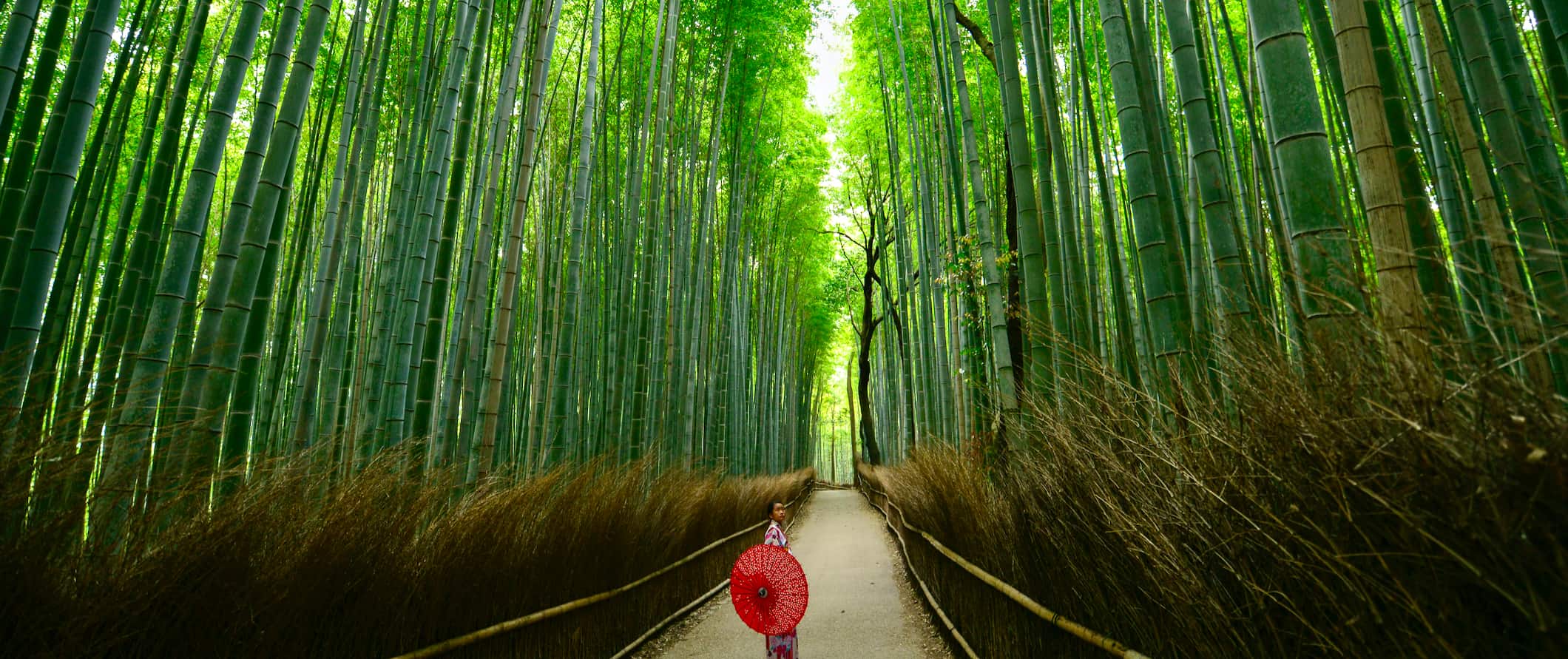
Accommodation – Expect to spend 2,500-4,500 JPY per night for a dorm room in a hostel (prices are on the higher end in larger cities like Tokyo or popular tourist destinations like Kyoto). Free Wi-Fi, private lockers, and self-catering facilities are standard in most hostels. But it’s uncommon for them to provide breakfast here. For a private room with a twin or double bed, expect to pay 6,500-15,000 JPY per night. Prices are generally the same year-round.
Capsule hotels cost 3,000-5,500 JPY for a tiny coffin-like pod that’s essentially just a bed, often with a small TV, light, and outlet to charge your devices. There are shared bathrooms and sometimes a small common room as well. It’s not fancy, but it’s a unique (and very Japanese) experience.
For (non-capsule) budget hotels, expect to spend 6,000-10,000 JPY per night for a double room. For Western hotel chains, expect to spend around 20,000 JPY or more per night. Note: For accommodation in Tokyo, add 50% to all these prices.
Airbnb is heavily regulated in Japan and, as such, there aren’t too many options. What rooms are listed are mostly hotels and guesthouses. Private homes/apartments usually start around 15,000-20,000 JPY per night, while private rooms (i.e., hotel rooms) run 8,000-10,000 JPY per night and up.
If you are looking for a more unique experience, consider staying at a ryokan , a traditional Japanese bed-and-breakfast. While they are more expensive than a standard hotel, it’s a unique and memorable experience, as you’ll get to sleep on traditional futons and tatami mats.
Food – Japanese cuisine is world-renowned and has even earned a spot on UNESCO’s Intangible Heritage List. While each region has its own specialties, rice, noodles, seafood, and seasonal produce all feature heavily no matter where you are. Plus, there’s izakaya (small plates), yakitori (grilled food), curry bowls, BBQ, and so much more. One of the best things about visiting Japan is the food.
Food in Japan is relatively inexpensive so long as it’s not imported (fresh fruit will blow your budget!). The most common cheap eats are using curry, donburi (bowls of meat and rice), or ramen. Curry and donburi bowls cost 500-700 JPY while ramen or soba noodles are usually around 1,200 JPY. Okonomiyaki (a Japanese pancake with noodles or rice) is between 1,000 and 1,300 Yen.
Fast food (think McDonald’s) is around 800 JPY for a set menu. You can also find plenty of cheap meals and prepackaged items at 7-Eleven (locals actually get a ton of food here as it’s delicious and quick). Noodles, rice balls, tofu, and prepackaged sushi are all available for only 250-500 JPY per item. (Trust me, it’s good!)
Most sit-down restaurant meals are going to cost you 2,000-3,000 JPY. Sushi conveyor belt restaurants (which are super fun) will run you 125-600 JPY per piece. Quicker lunch spots are going to be around 1,500 Yen.
Fine dining is a tradition rooted in Japanese culture, and kaiseki ryori is a style of high-end, multi-course Japanese dining that originated in Kyoto. It costs about 8,000-10,000 JPY for a set menu of seven courses, covering everything from chicken to Wagyu steak to sushi.
High-end omakase sushi restaurants (where dishes are selected by the chef) will set you back at least 10,000 JPY, though more likely closer to 20,000 JPY. (In Tokyo, the best ones are 30,000 JPY.)
Domestic beer is around 450-550 JPY, and sake is about 800-900 JPY per glass. A cocktail will set you back about 1,200 JPY, though at the famous cocktail bars in Tokyo, expect to pay closer to 1,600 Yen per drink. A latte or cappuccino is 500-600 JPY, and a bottle of water is 100-130 JPY. Soda is around 200 Yen.
Expect prices to be higher in the bigger cities and cheaper in the countryside.
Buying groceries costs around 5,000-6,000 JPY per week for basic staples like rice, vegetables, and fish. However, given the availability of such cheap food, it’s doubtful you’ll go grocery shopping to prepare your own meals.
Backpacking Japan Suggested Budgets
If you’re backpacking Japan, plan to budget 7,000 JPY per day. This assumes you’re staying in a hostel dorm, cooking some of your meals, eating at the cheap restaurants and takeaways, visiting free museums and temples, and using public transportation to get around.
On a more midrange budget of 16,000 JPY per day, you can stay in nicer accommodations, eat out more liberally, indulge in more drinks, visit more attractions, and, overall, just have some more breathing room in your travels! On this budget, you’ll be able to do most things.
On an upscale budget of 28,000 JPY per day or more, you can stay in traditional Japanese accommodations or two-star hotels, eat at nicer restaurants each day, splurge on some meals, enjoy drinks as often as you want, take tours, and, overall, just afford whatever you want!
You can use the chart below to get some idea of how much you need to budget daily, depending on your travel style. Keep in mind that these are daily averages — some days you’ll spend more, some days you’ll spend less (you might spend less every day). I just want to give you a general idea of how to make your budget. Prices are in JPY.
Japan Travel Guide: Money-Saving Tips
I think Japan’s reputation as an expensive country is overstated. Outside of accommodation and transportation, it’s actually really affordable. Is it super cheap? No. Is it super expensive? Not at all. There are plenty of ways to lower your costs and all non-imported food is really inexpensive. Here are some ways to save money when you visit:
- Visit the free attractions – With its countless museums, galleries, shrines, temples, historic neighborhoods, and parks, Japan is filled with opportunities to immerse yourself in its culture without spending a Yen. Moreover, many of the nation’s parks and gardens are also free. Start with them and you’ll fill your days on the cheap!
- Get a JR Pass – The bullet trains in Japan are ridiculously expensive, with one-way fares costing hundreds of dollars. If you plan to do a lot of traveling around the country, get the JR Pass , which allows you unlimited train travel and can save you a ton of money. It comes in 7-, 14-, and 21-day options. (Keep it mind it can only be purchased outside of Japan, so be sure to plan ahead.)
- Take the bus – Buses are a far more economical option than the trains. They cost a fraction of the price. For example, the unlimited Japan Rail Pass costs 29,650 JPY for seven consecutive days of travel, but this is far more expensive than using the bus. But buses take a lot longer. For example, the two-hour bullet train ride from Tokyo to Osaka becomes a 10-hour bus ride. Bottom line: if you have the time, take the bus.
- Shop at the 100-yen stores – There are many 100-yen shops around the country. They all sell meal sets, groceries, water bottles, toiletries, and household items. Store names vary by region, so ask your hotel or hostel reception where the nearest “Hyaku En” store is located.
- Eat at 7-Eleven – 7-Eleven, Family Mart, and other convenience stores have a lot of pre-made meals that make for a cheap lunch or snack. The food is actually really good and you’ll always see locals dipping in and getting a quick lunch or snack here. Don’t be afraid to at them.
- Cook your own food – Many hostels have kitchens where you can cook your own meals. Combining this with shopping at the 100-yen stores will drastically cut your food costs.
- Eat curry, ramen, and donburi – These dishes are the best option for eating cheap, filling meals. These cost from 400 – 1200 Yen (ramen is 1200). Shops specializing in these dishes are all over the country so you can easily find them. They are on every corner and the cheapest way to eat on a budget.
- Stay with a local – Using hospitality sites like Couchsurfing allows you to stay with residents, so you not only get a free place to stay but you get to interact with someone who can share their insider tips.
- Buy food before grocery stores close – After 8pm, many supermarkets discount their fresh food, as they have to get rid of it by law. You can save up to 50% on almost all ready-made meals. It’s a great cheap dinner.
- Hitchhike – Japan is one of the world’s safest countries, and many locals are curious enough to pick up foreign visitors. Hitchhiking isn’t really practiced by Japanese, so you will stand out as a tourist, which will increase your chances of finding a ride.
Where to Stay in Japan
There’s a lot of affordable accommodation in Japan, especially if you avoid Western style hotels and chains. To help you save money on accommodation, here’s my list of the best hostels and budget hotels in Japan:
- Hostel Chapter Two Tokyo (Tokyo)
- Hotel Century Southern Tower (Tokyo)
- Backpacker Hostel K’s House Kyoto (Kyoto)
- Gojo Guest House (Kyoto)
- The Pax Hostel Records (Osaka)
- Roku Hostel Hiroshima (Hiroshima)
- Guesthouse Akicafe Inn (Hiroshima)
- WeBase HAKATA Hostel (Fukuoka)
How to Get Around Japan
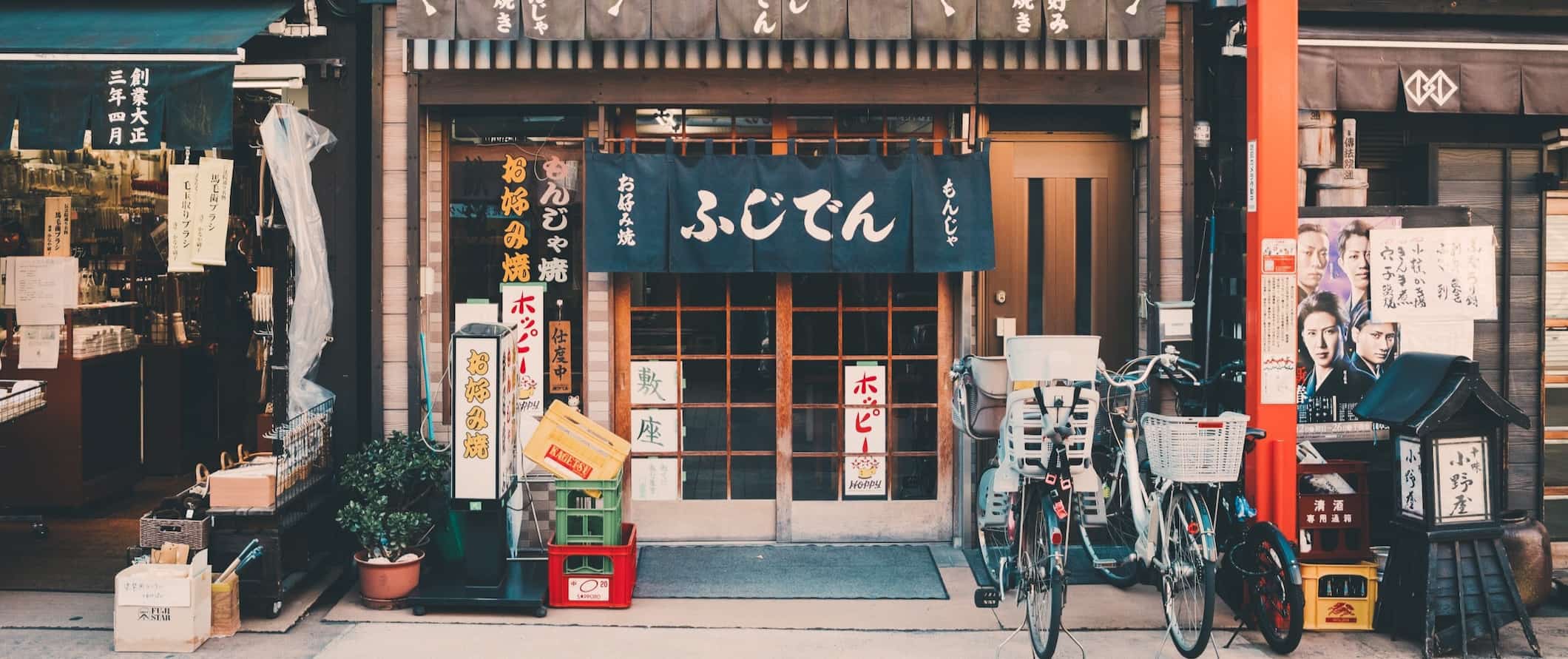
Public transportation – Metro or bus tickets cost 150–300 JPY for a single journey. (The price varies by distance and may often be higher.) Fares are usually around 220 JPY to travel across Tokyo but less for shorter distances. In most major cities, you can buy a day pass, which gives you unlimited travel for 24 hours for around 800-1,100 JPY.
Train – Train travel is the quickest way to get around Japan. The bullet train is awesome, comfortable, and super-fast — but it’s not cheap. Individual tickets can cost hundreds of dollars. In order to reduce your train costs, get a Japan Rail Pass , which is indispensable for travel here.
Even if you just get the seven-day pass, it’s the same price as a round-trip train ticket from Osaka to Tokyo. Moreover, the JR trains also serve urban areas and so can be used within cities. I used my pass to get around Kyoto and Tokyo instead of buying metro tickets.
So, even if you aren’t going to do much traveling around Japan, buying a pass is better than buying individual tickets. While the high price of the pass can cause sticker shock, the alternative is worse.
Additionally, be sure to download the Navitime app . It has offline maps, train and public transit routes, and info on train stations. It’s a lifesaver when trying to figure out how to get around the country.
Bus – Buses are a less expensive alternative to the bullet train system in Japan, but they take more time. For example, the two-hour bullet train ride from Tokyo to Osaka becomes a ten-hour bus ride. The price for that seat is 4,500-8,000 JPY, but at some point, you need to think about how much your time is worth.
There are also bus passes that offer unlimited travel and begin at 10,200 JPY for three nonconsecutive days of travel. You can use these two websites to book your bus journeys:
- Willer Express
- Japan Bus Lines
If you have more time than money, take the bus. Otherwise, I’d say splurge and take the train, because they really are much faster and much, much more comfortable.
To find bus routes and prices, use BusBud .
Flying – Generally, flight prices are on par with bullet train tickets. ANA, one of the country’s two main carriers, offers special last-minute fares via a hidden page on its website , usually for around 14,000 JPY for a seat. It’s only available to foreigners and can sometimes be cheaper than the flights you find on booking platforms, especially for longer routes around the country.
Flights from Tokyo to Okinawa are around 23,000 JPY (round-trip) while those from Tokyo to Sapporo are around 16,000 JPY (round-trip).
Car rental – With efficient public transportation and nationwide bullet trains, renting a car here really isn’t necessary. However, if you do need one, multi-day rentals start at 6,000 JPY per day. Just remember that people drive on the left here! For the best car rental prices, use Discover Cars .
When to Go to Japan
Temperature and weather vary drastically across Japan, meaning it’s always a good time to visit some part of the country. While most of Japan does have four seasons (including snowy, freezing winters in the north), Okinawa and the islands in the south are warm year-round. It gets cold in Tokyo, but it generally doesn’t snow.
Expect warm, humid weather from June through August, with temperatures hovering around 32°C (89°F). Japan also gets a lot of rain, mostly in the summer months, from mid-June to mid-July. It gets a little drier in August, before the precipitation picks up again in September. Typhoon season occurs from May to October. Japan is well-equipped to handle all types of typhoons, but be sure to purchase travel insurance in advance !
Overall, there’s no real bad time to visit. Winter is awesome for skiers or snowboarders, spring is famous for its cherry blossoms, summer is full of festivals, and fall has brilliant autumn colors and nice temperatures. I personally prefer spring and fall, as the summer heat and humidity is pretty oppressive.
How to Stay Safe in Japan
Japan is a very safe country. There’s virtually zero chance you’re going to get robbed, scammed, or hurt here. Your biggest issues will most likely come from other foreigners who get drunk and are causing trouble.
Solo female travelers should generally feel safe here, but the standard precautions apply (never leave your drink unattended at the bar, never walk home alone intoxicated, etc.). Japan does have a problem with groping, especially on packed trains. Most train companies now have “women-only” cars during rush hour (you’ll see pink signs indicating where women should board).
Scams in Japan are nonexistent. No one is going to rip you off. The listed price is the listed price and the same for everyone. There are no tourist prices here.
Your main risk here is from Mother Nature. Earthquakes and typhoons aren’t uncommon, so make note of exits when you arrive at your accommodation. Download offline maps to your phone, as well, in the event you may need to navigate the city during an emergency.
If you do experience an emergency, dial 110 or call the nonemergency Japan Helpline at 0570-000-911.
The most important piece of advice I can offer is to purchase good travel insurance. Travel insurance will protect you against illness, injury, theft, and cancelations. It’s comprehensive protection in case anything goes wrong. I never go on a trip without it, as I’ve had to use it many times in the past.
Japan Travel Guide: The Best Booking Resources
These are my favorite companies to use when I travel. They consistently have the best deals, offer world-class customer service and great value, and overall, are better than their competitors. They are the companies I use the most and are always the starting point in my search for travel deals.
- Skyscanner – Skyscanner is my favorite flight search engine. They search small websites and budget airlines that larger search sites tend to miss. They are hands down the number one place to start.
- Hostelworld – This is the best hostel accommodation site out there with the largest inventory, best search interface, and widest availability.
- Agoda – Other than Hostelworld, Agoda is the best hotel accommodation site for Asia.
- Booking.com – The best all around booking site that constantly provides the cheapest and lowest rates. They have the widest selection of budget accommodation. In all my tests, they’ve always had the cheapest rates out of all the booking websites.
- Get Your Guide – Get Your Guide is a huge online marketplace for tours and excursions. They have tons of tour options available in cities all around the world, including everything from cooking classes, walking tours, street art lessons, and more!
- SafetyWing – Safety Wing offers convenient and affordable plans tailored to digital nomads and long-term travelers. They have cheap monthly plans, great customer service, and an easy-to-use claims process that makes it perfect for those on the road.
- LifeStraw – My go-to company for reusable water bottles with built-in filters so you can ensure your drinking water is always clean and safe.
- Unbound Merino – They make lightweight, durable, easy-to-clean travel clothing.
- Japan Rail Pass – This is a flexible transportation pass used for navigating Japan. Similar to the Eurail pass in Europe, it turns expensive bullet trains into budget-friendly modes of transportation. You honestly can’t visit Japan without one.
Japan Travel Guide: Related Articles
Want more tips? Here are all the articles I’ve written on Japan travel to continue planning your visit:
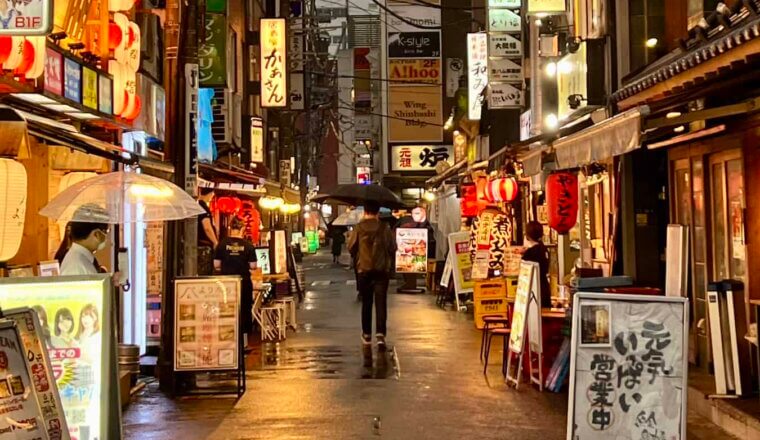
How to Spend Your Time in Tokyo: A Suggested Itinerary
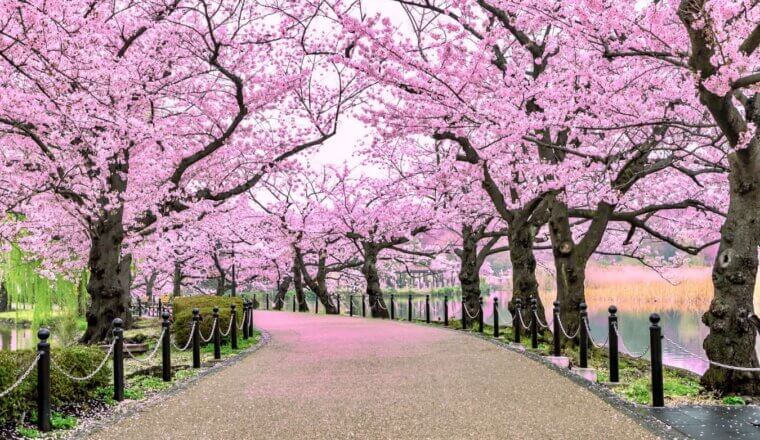
The Perfect 7-Day Japan Itinerary for First-Time Visitors
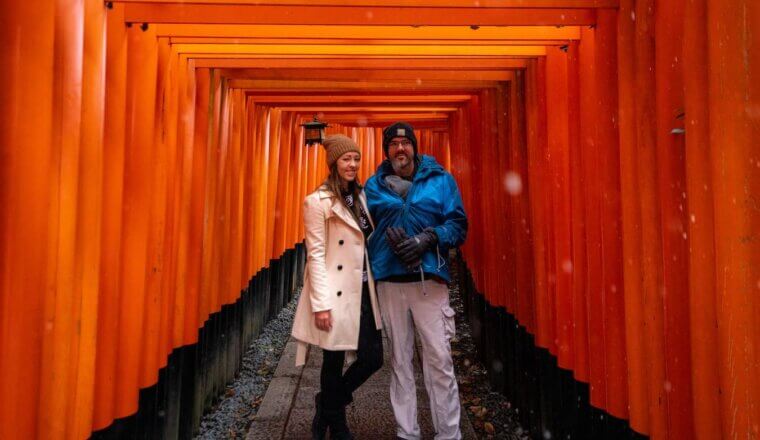
How to Travel Japan with a Baby
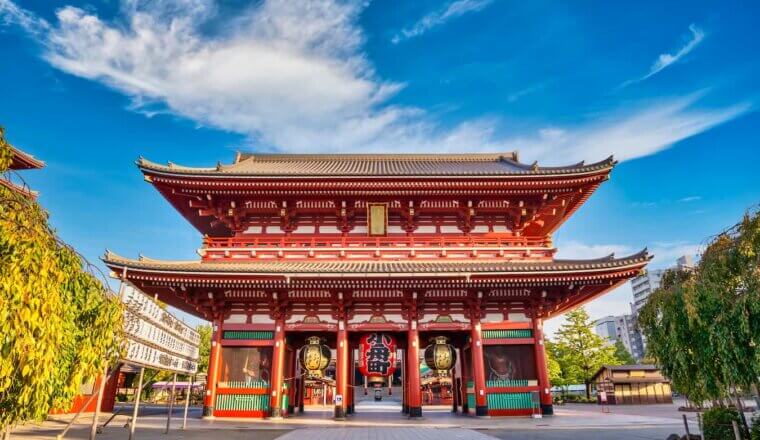
Where to Stay in Tokyo: The Best Neighborhoods for Your Visit
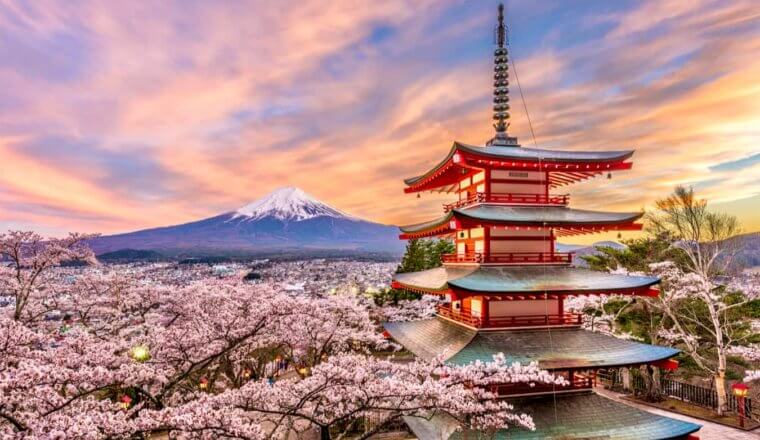
The Ultimate Japan Itinerary for First-Timers: From 1 to 3 Weeks
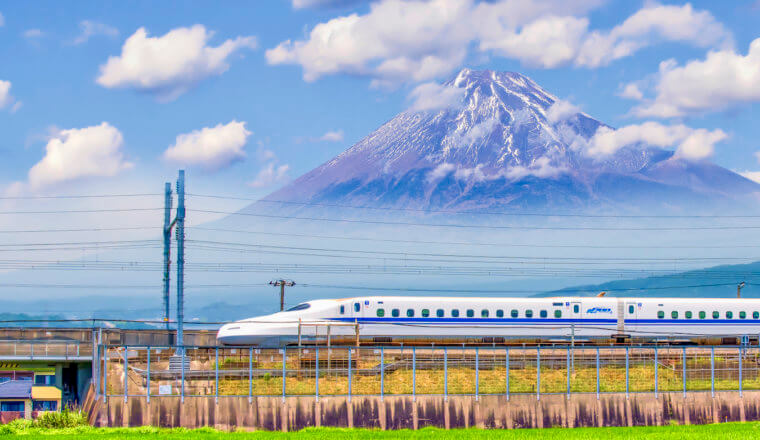
A Complete Guide to the Japan Rail Pass
Get my best stuff sent straight to you, pin it on pinterest.
- Where To Stay
- Transportation
- Booking Resources
- Related Blogs

Japan 2023 Cost | A Two Week Itinerary And How Much To Budget For Your Trip
Visiting Japan In 2023
Japan has such an incredible array of offerings for travelers that it can be overwhelming trying to see everything in one trip.
Some careful planning is your best chance at successfully making your way through some of the major sites to see in the country for your first trip.
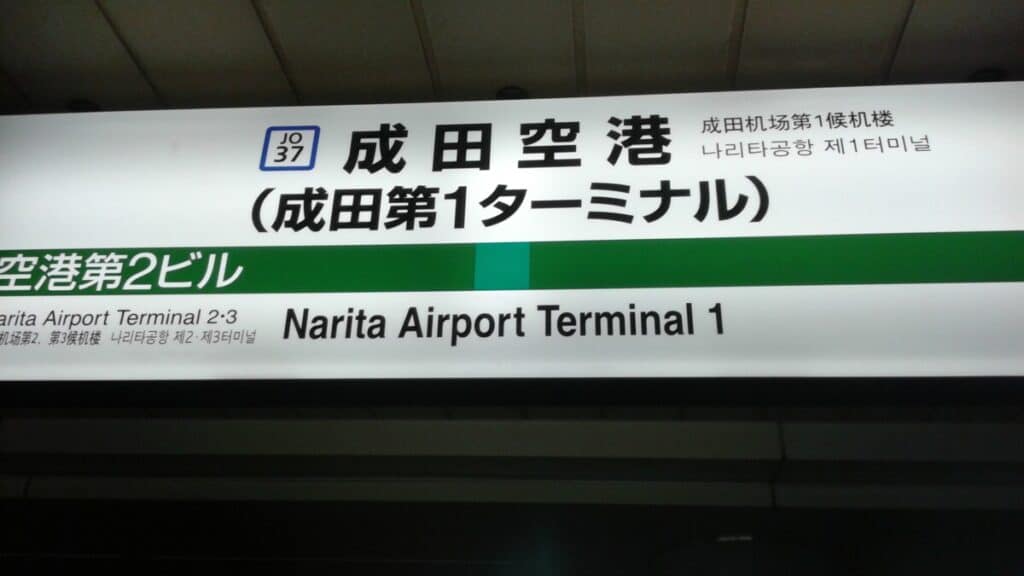
With how much there is to see and do in Japan, it’s a country that people will often come back to more than once.
Not only does it allow them to see and do more, but even experiencing Japan in different seasons is worth coming back for. This guide will help you plan your own trip of a lifetime.
What Makes Japan So Enticing?
One of the many fantastic traits of Japan compared to other countries is the way it’s been able to retain a lot of tradition and remnants of culture from centuries ago while also embracing modern technology and Western influences.
You can move from a big city to a small town in a short train ride, almost as if you’re being transported from one time period in Japan to another.
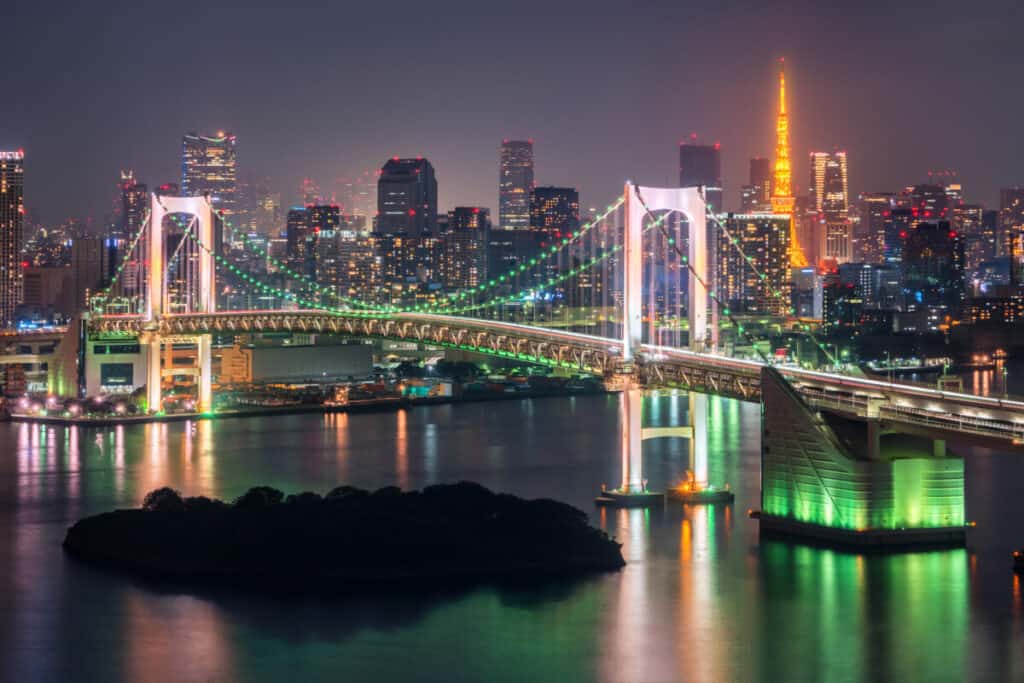
Japan is also a very safe country comparatively, both for locals and tourists. Tourists who are respectful of Japanese culture are embraced and treated with kindness and hospitality wherever they go. Many people in Japan love to share their traditions, food, and their ways of life with those willing to learn.
Getting Around Japan
It’s completely unnecessary to rent a car when traveling through Japan, though it is something you can do should you need one.
The public transportation system in Japan is one of the best systems in the world and is clearly the best way to venture from city to city or within a city itself.
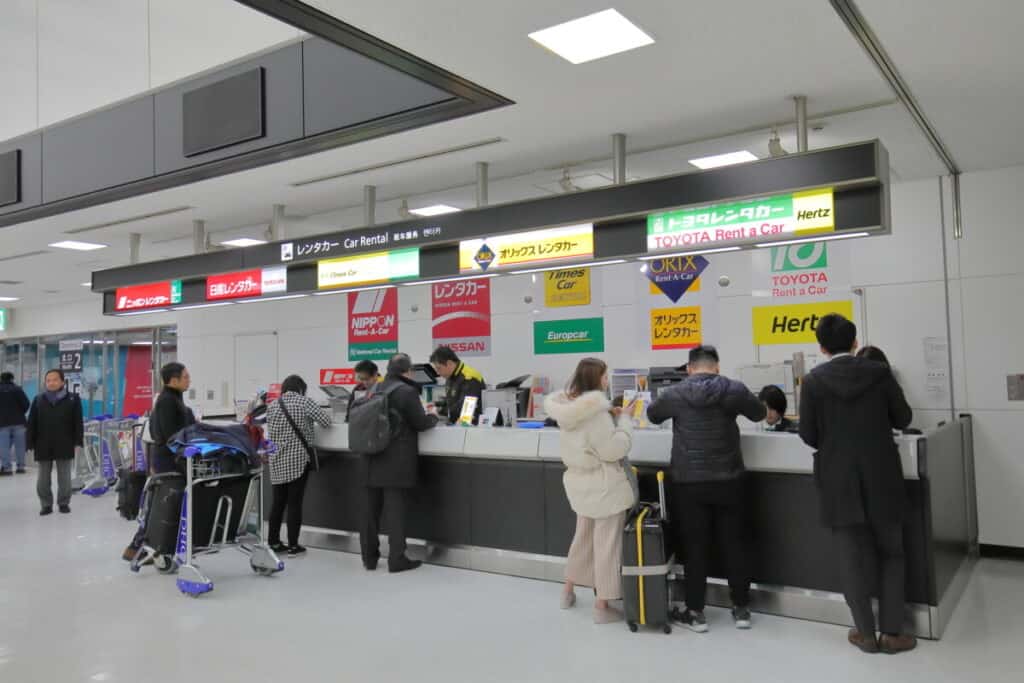
While it takes some time, planning out the specific routes for where you want to go in Japan is crucial, so you know how to budget for your transportation costs. It also helps you understand what your options are in terms of getting from one place to another.
It can be overwhelming traveling through a foreign country when you don’t speak the language fluently .
It’s highly recommended that you purchase a pocket wifi device so you can pull up translation apps and maps with ease, as well as communicate with your loved ones back home.
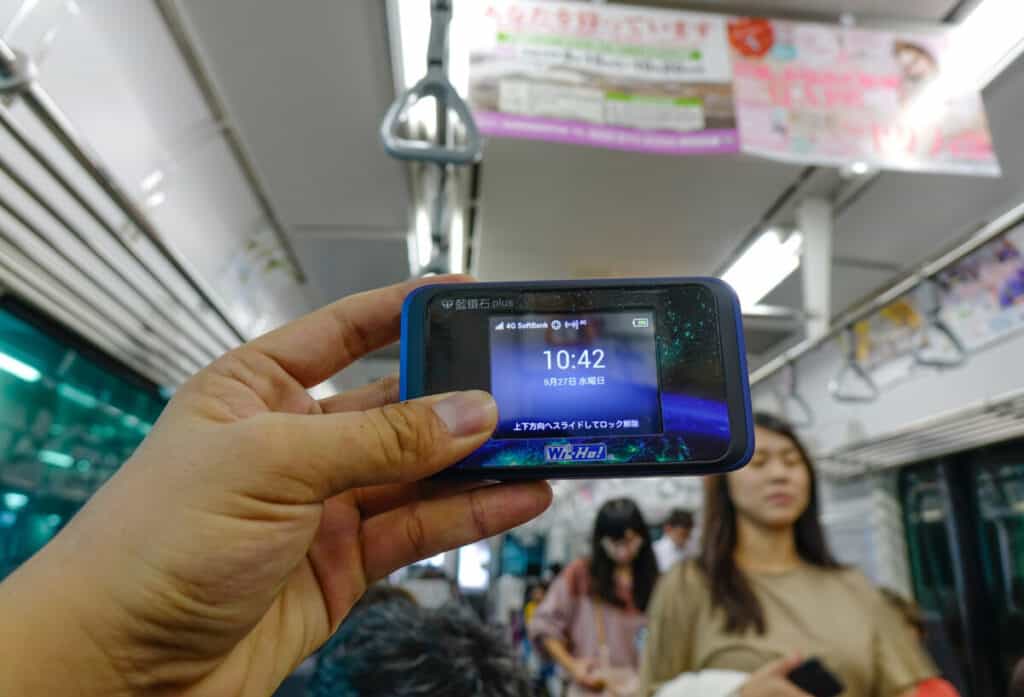
It’s relatively inexpensive and easy to find these devices; you can book one in advance and pick it up at the airport you fly into.
To have access to pocket wifi for a two-week trip, you’re looking at around $50 USD or so. It’s worth adding that to your budget to stay connected and look up directions when needed.
The Japan Rail Pass
One of the most economical ways to utilize public transportation when making your way through Japan is to purchase a Japan Rail pass . A JR Pass gives you the ability to ride many of the local trains and even some bullet trains, or shinkansen, simply by presenting your pass at any train station.
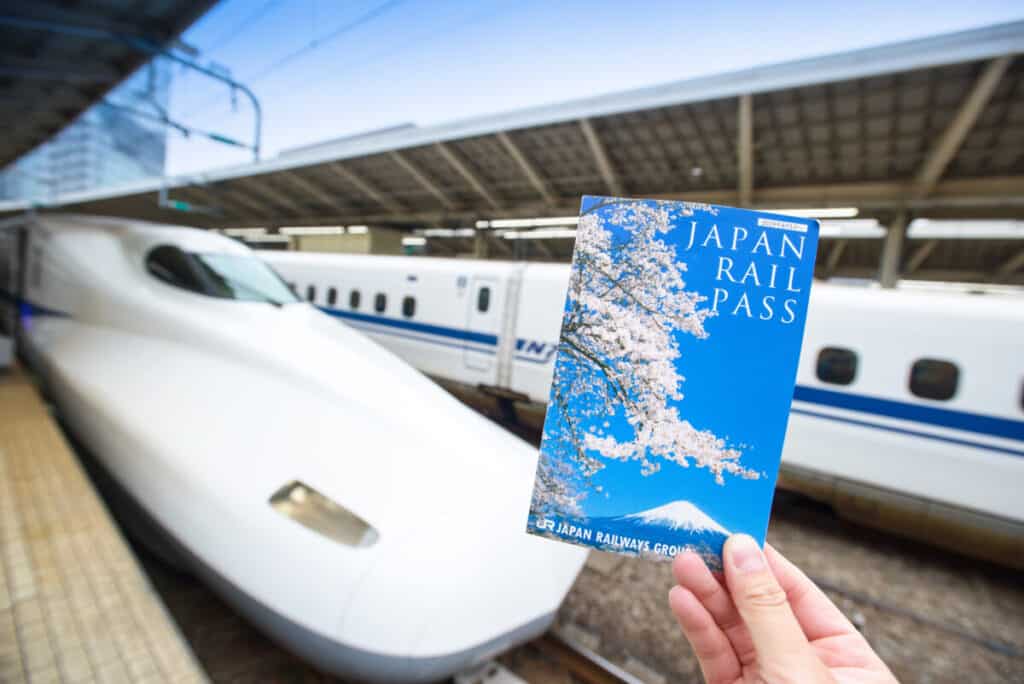
You’ll save a lot of money using a pass, even if some of the routes you plan on taking don’t accept the pass. The 14-day pass is an excellent bargain if you want to see as much of Japan as possible. If you’re mainly spending your trip in Tokyo , it’s not worth buying a pass.
The cost of the Japan Rail Pass will likely vary depending on which pass you choose, as well as whether or not you want to buy an upgraded pass to get luxury seating on select trains .
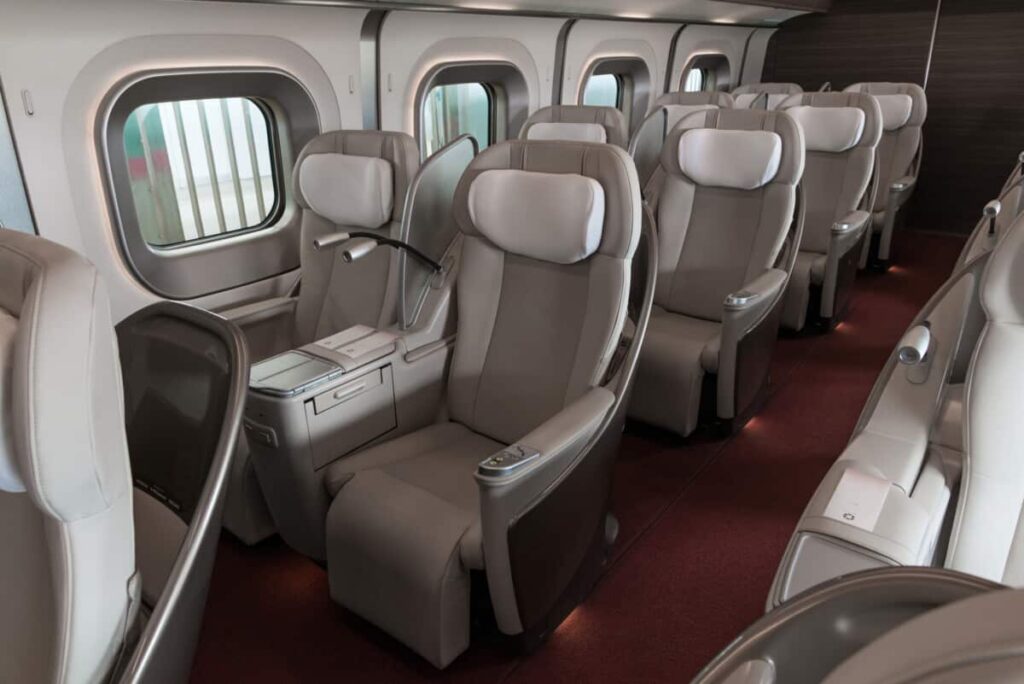
While it’s quite a cool experience to have a green pass, especially if you plan on riding a bullet train, it’s not a necessary expense.
The Limits Of The JR Pass
It’s important to note that while the JR Pass is extremely convenient and cost-effective for traveling through Japan, there are some limitations to where you can use the pass.
You’re only going to be able to use it when traveling on a Japan Rail-owned public transportation medium. Take note that there is some extra cost when using limited express or shinkansen routes.
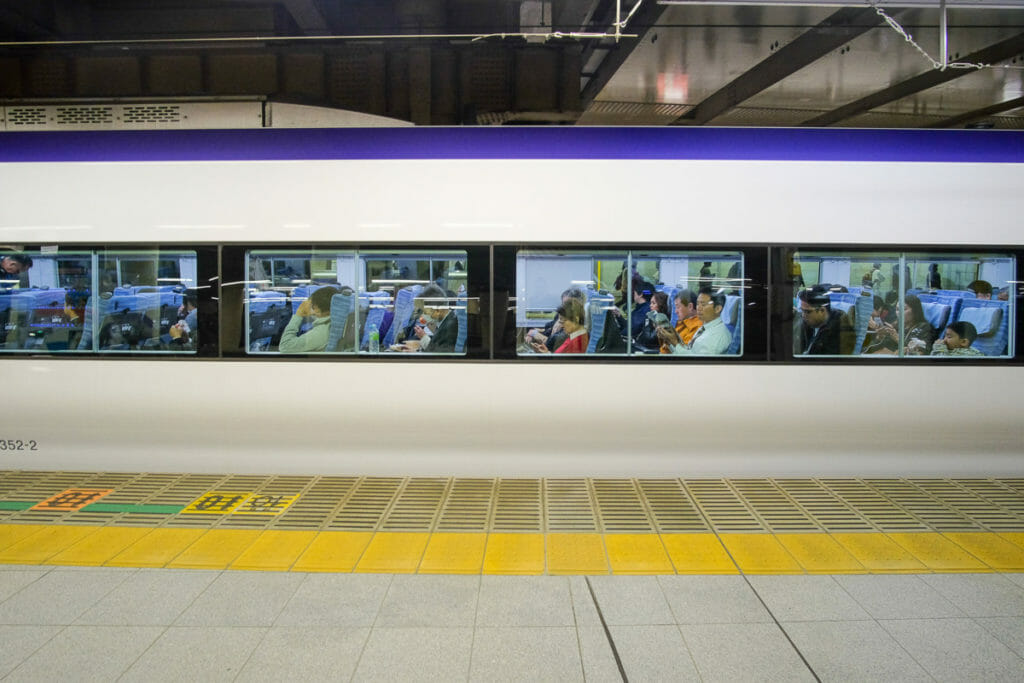
If you find that you’ll have to ride some subways or public transportation owned by other transportation companies in Japan, it’s worth looking into an IC Card . IC Cards are available for major transportation companies such as Pasmo and Suica.
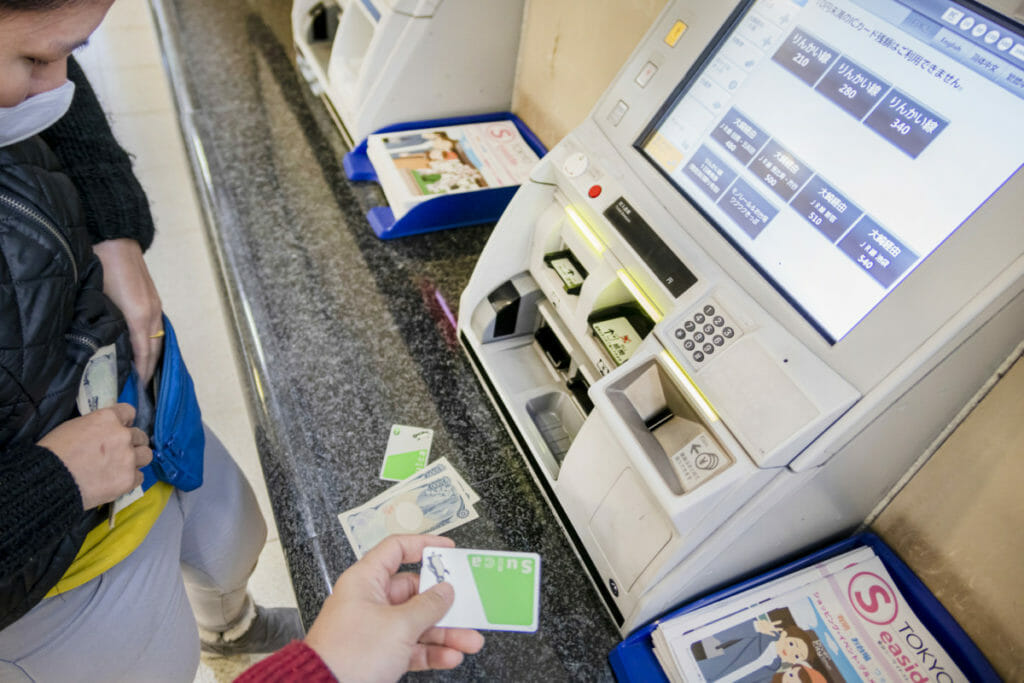
These cards let you board these trains and subway cars, as the Japan Rail pass doesn’t work on them.
The IC Card doesn’t get you any special deals when you use them, but they help you limit the number of yen you have to carry on you.
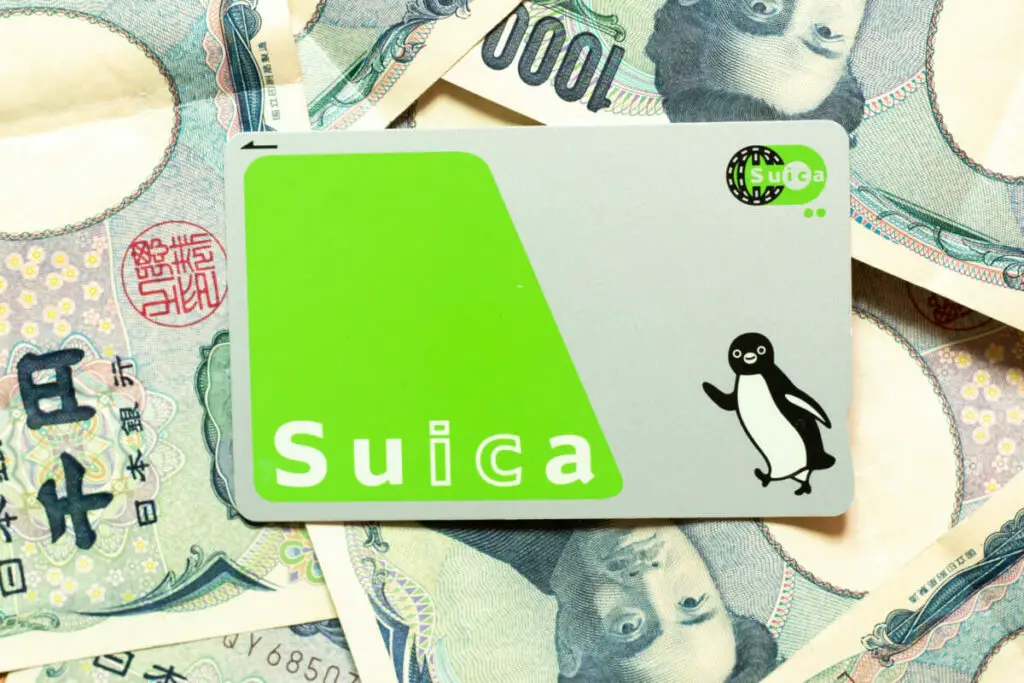
Furthermore, you can use these cards at some vending machines and convenience stores around Japan , so it’s worth setting it up and having some extra yen on it just in case.
Since there are numerous companies that offer IC Cards, your research is going to have to be thorough once you decide where you’re going, so you choose the right card.
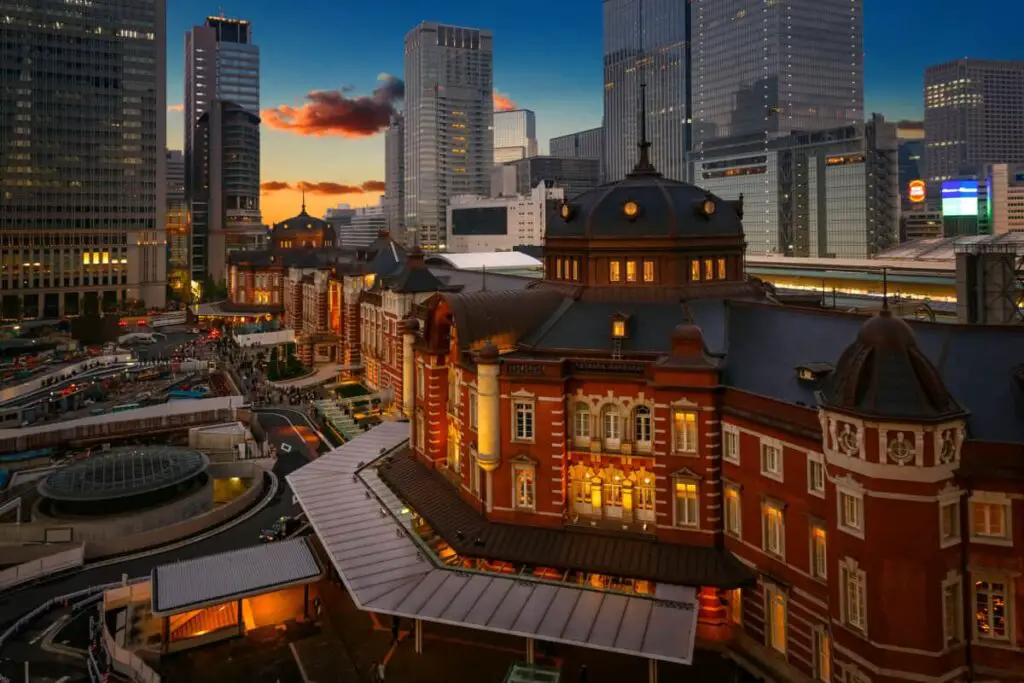
You can purchase and load an IC Card at a train or subway station; Tokyo Station will likely be your best bet since you’ll likely make your way there on your trip.
Tips For Using Public Transportation In Japan
When you’re planning out your routes for getting around Japan, planning around where the JR Pass and IC Cards can get you is the most effective way to get around.
It’s not only convenient but helps you keep your travel costs down as much as you can.
What most seasoned travelers and locals do is use their JR Pass to get as close to their intended destination as possible, as JR routes tend to go pretty far through Japan.
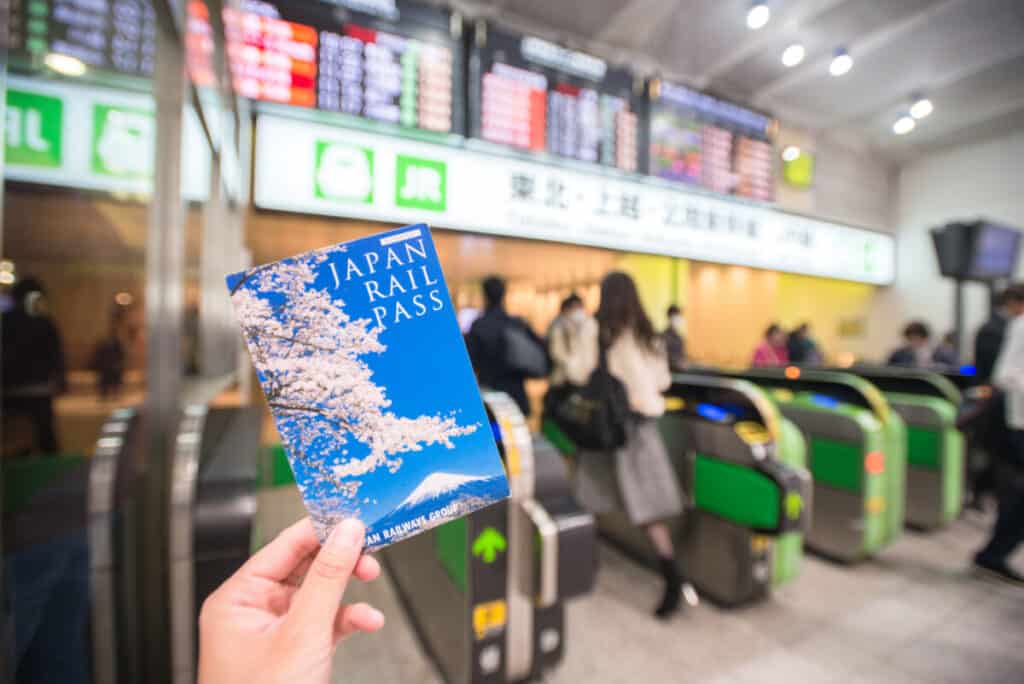
Then, they will use their IC Cards for the more direct route to get to their intended destination.
You can take your luggage on public transportation with you, but you’ll want to be cognizant of how much you pack when you know you’ll be using public transportation.
Some trains will have limits on what you can bring on board with you in an effort to make sure you don’t take up too much space.
Preparing For Your Trip To Japan
You’ll want to prepare yourself with a good portion of yen based on what you decide to do on your trip. A lot of places in Japan either only accept cash or prefer cash.
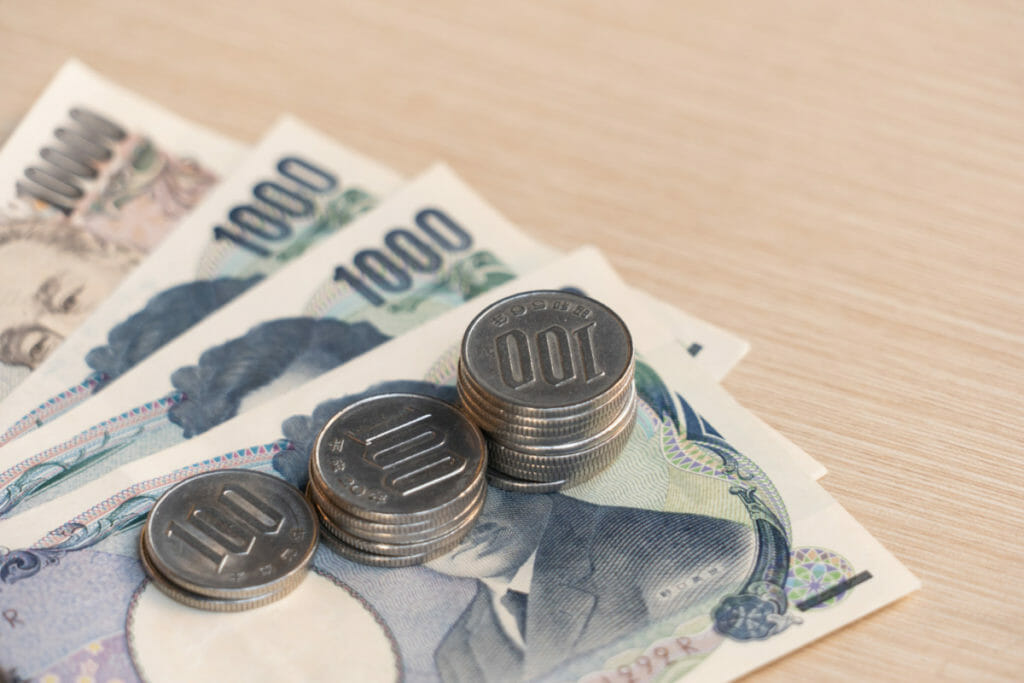
Be sure you have a small and secure spot for storing your cash when you have it on you. Japan is safe, but you can never be too careful.
Japan has centuries of history that may be overwhelming to some, but taking the time to learn basic manners and important aspects of the culture can help you navigate the country much more seamlessly. Some light online reading about manners and a translation app on your phone will do wonders for you.
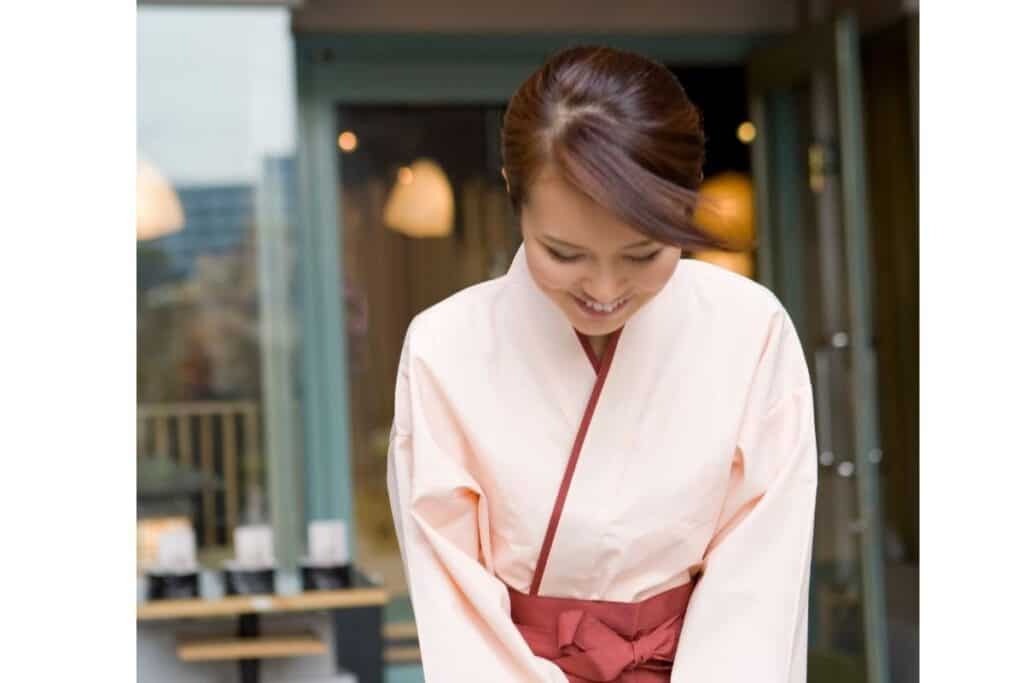
So long as you’re sure to be polite, say please and thank you, and avoid being too loud or rowdy, you’re likely going to fit in very well in the country.
Visiting Japan: Why Two Weeks?
Japan is not a country to visit for only a couple of days, or even a week. Two weeks will give you the opportunity to see a sufficient portion of the country.
One of the best ways you can pack in as much adventure and sightseeing as you can hope for is to organize your trip by the cities you want to stay in.
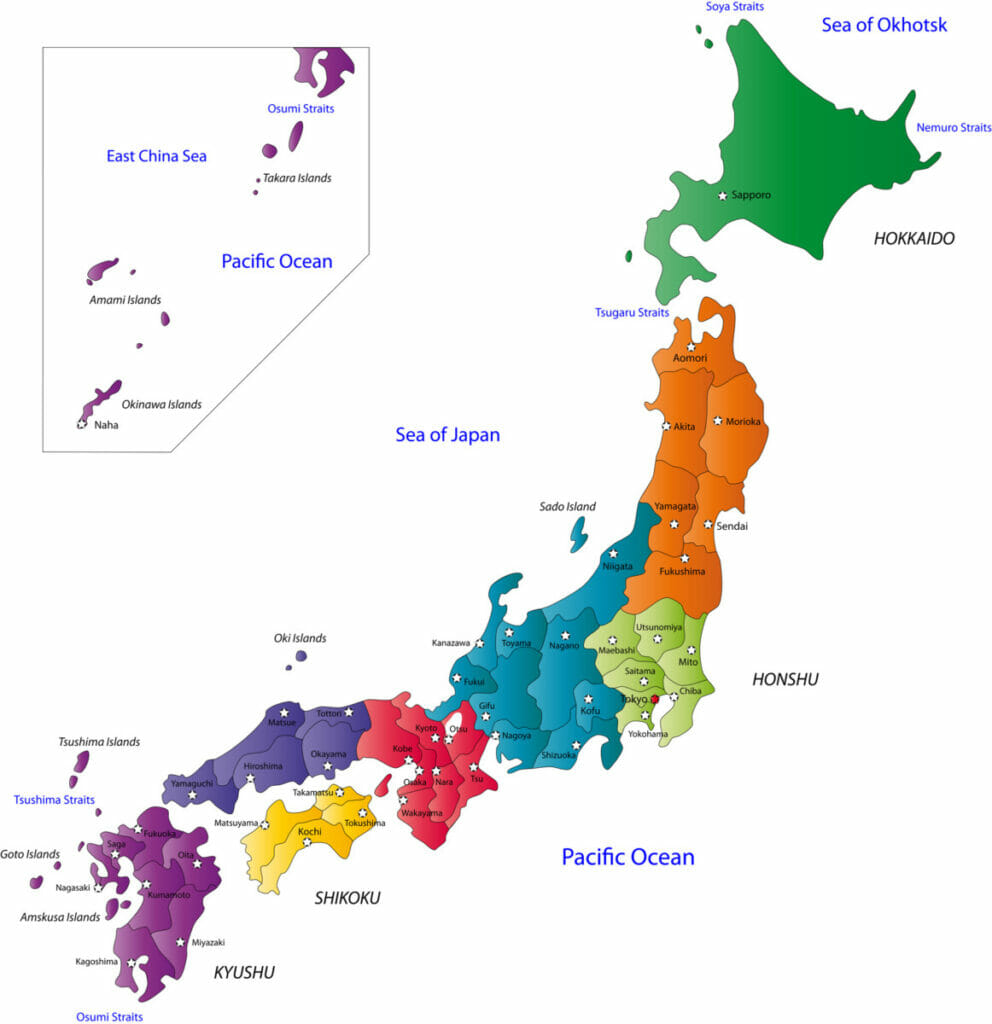
If you plan to spend two or three days in each city, you’ll have the opportunity to not only explore the city itself but explore nearby towns. Pretty much all of Japan is accessible by train or bus, so you have the ability to make day trips to nearby cities or towns a part of your trip.
A Two-Week Itinerary For Visiting Japan In 2023
Japan is a fairly big country, and narrowing down where to go can be tough. If you have two weeks, planning to see a couple of cities at minimum is not only doable but recommended, especially if you have a JR Pass. While Tokyo is a grand city and is worth spending a couple of days in, it’s not the only big city worth seeing.
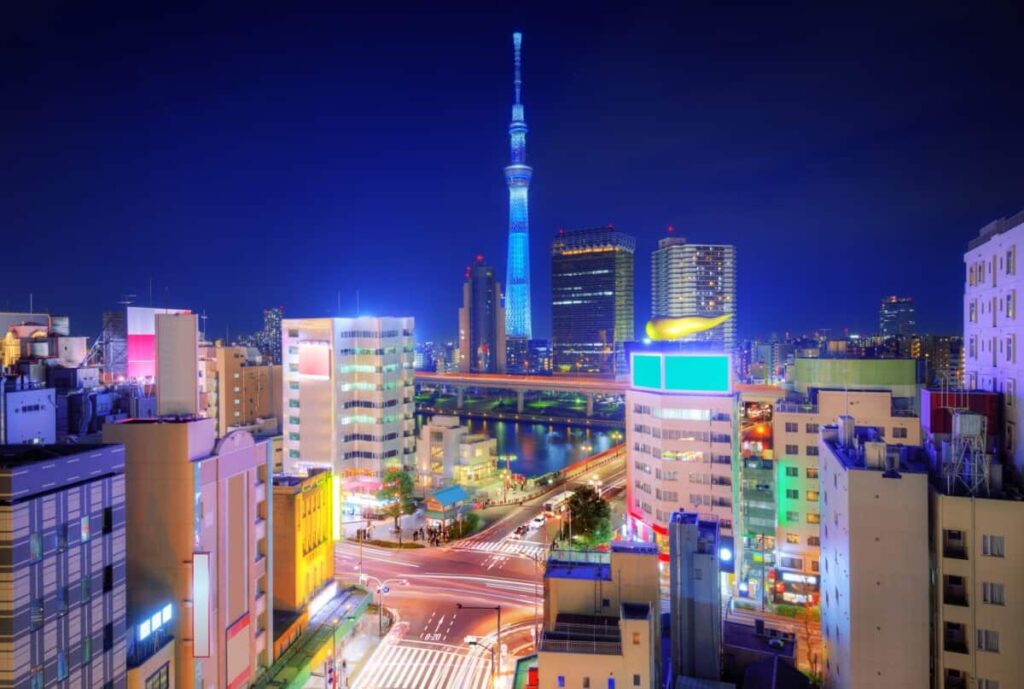
You also don’t want to overlook smaller villages and cities where the amount of learning you can do is tremendous. So many of these smaller cities and towns have remnants of traditional Japanese culture and ways of living that you have the opportunity to witness.
When visiting Japan for the first time, you’re likely going to want to hit some of the popular spots that bring people to the country every year.
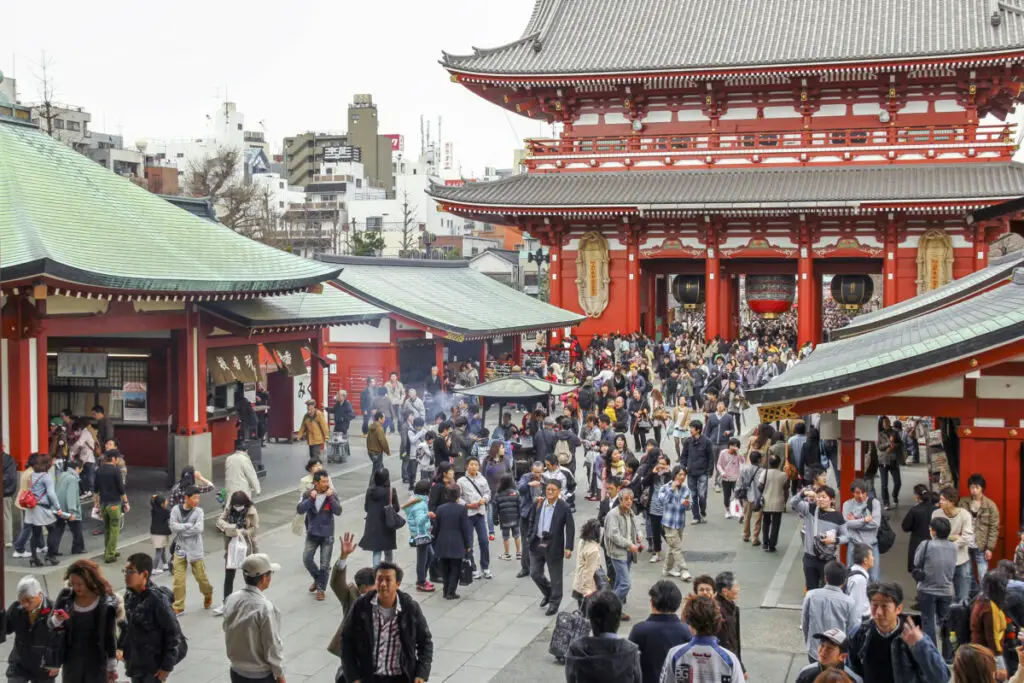
You’ll eventually want to come back again to explore some of the hidden gems of the country and the smaller neighborhoods where unique culture abounds.
To make your two-week trip as comprehensive and adventure-packed as possible – without spending too much time traveling and overwhelming yourself – your best bet is as follows:
- Start your trip in Tokyo and spend three to four days there, with the option of staying in the Fuji Five Lakes for a day
- Make your way to Kyoto for three to four days
- Next go to Hiroshima for two days, making a jaunt to Miyajima island for the day
- Spend your remaining days in Osaka before heading back to Tokyo to head home
Below are some of the top destinations for each of these cities, as well as some other ways to enjoy your time in between seeing the big sights.
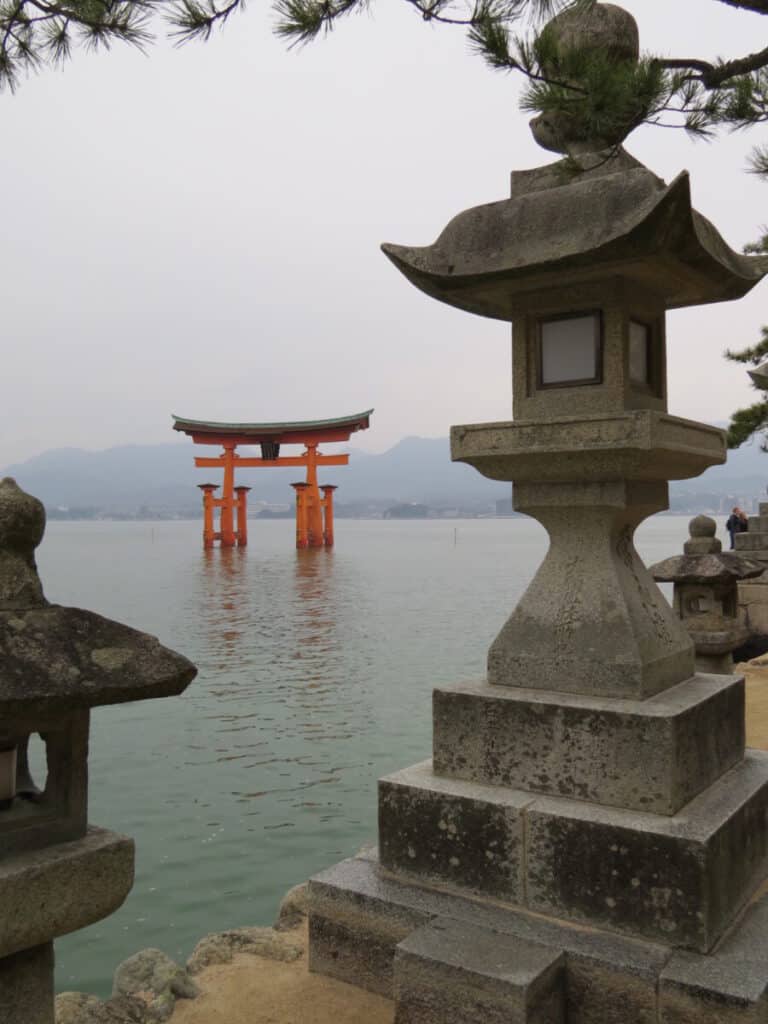
It’s important to note that there are so many other places in Japan that are just as beautiful and full of places to see, but you’d need much more than two weeks to see them all.
There are lots to see and do in the large city of Tokyo, and you have access to so many other places in Japan through a bus or train ride. For instance, making your way to Mount Fuji from Tokyo to spend a day or two there is very easy. You could easily spend your whole two weeks in Tokyo, but you don’t want to limit yourself.
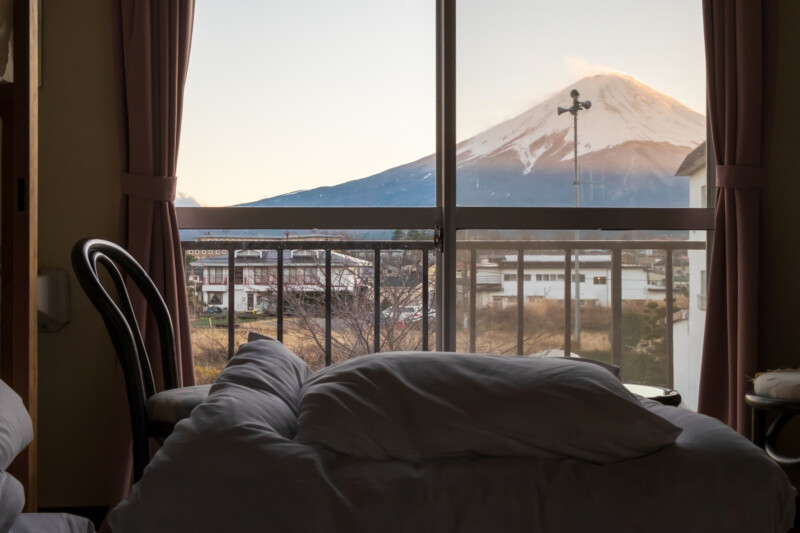
Tokyo is made up of several different districts and neighborhoods and is divided by Central, North, South, East, and West Tokyo.
No matter which part of Tokyo you decide to stay in, you have the opportunity to visit special districts dedicated to certain aspects of Japanese culture while also being able to shop, see shrines , and enjoy various activities and delicious foods.
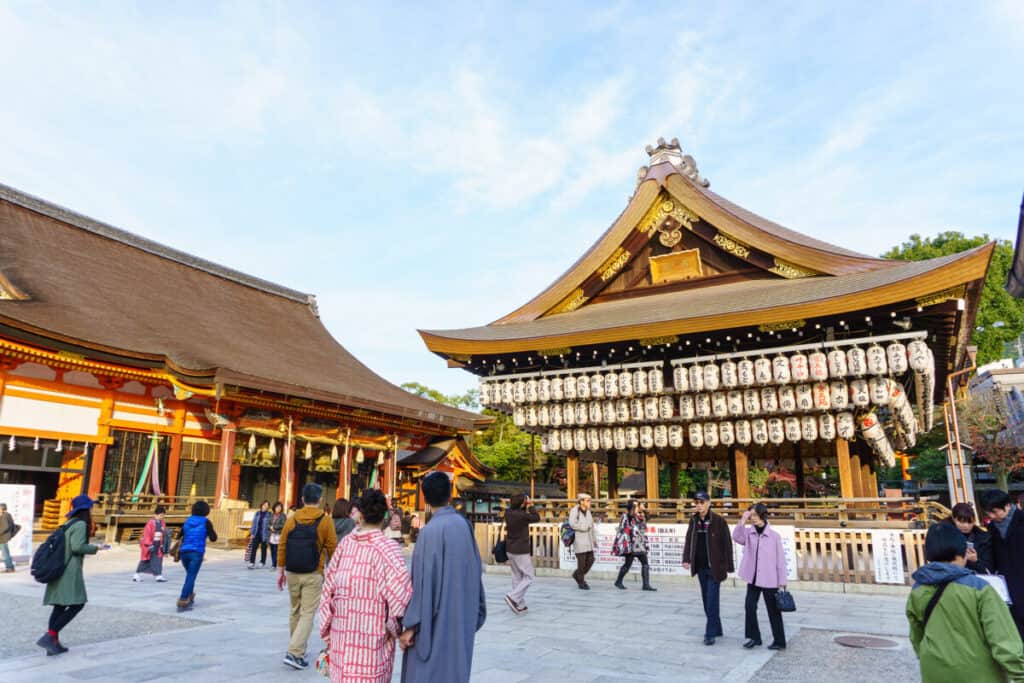
In Central Tokyo, you’ll find Tokyo Station, the Akihabara District, which is perfect for anime, manga, and tech lovers, as well as Ginza , home to the best shopping you’ll do in Tokyo. You’ll also find the Tokyo Dome and the nearby Koishikawa Korakuen garden, as well as the Yasukuni Shrine.
North Tokyo features the infamous Tokyo Skytree and the Tokyo National Museum, in addition to Ryogoku, known as the sumo wrestling epicenter . You’ll also want to see the Sensoji Temple or the landscapes of the Botanical Garden or Ueno Park .
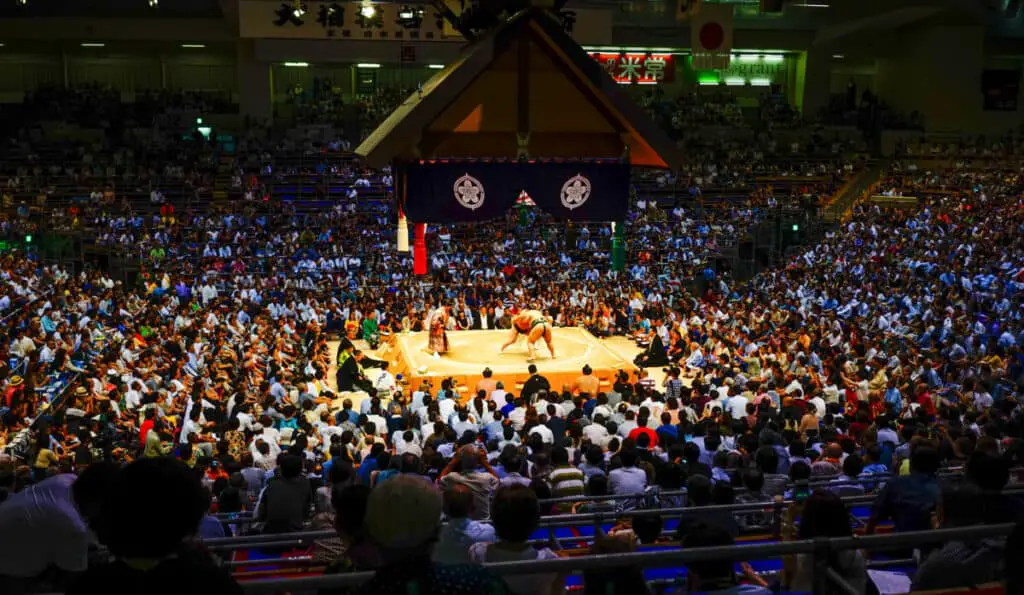
South Tokyo is home to some temples and shrines , such as Sengakuji, and the man-made island of Odaiba . You can also enjoy a ride on the Tokyo Water Bus, or do some shopping and exploring in Roppongi or Shiodome districts .
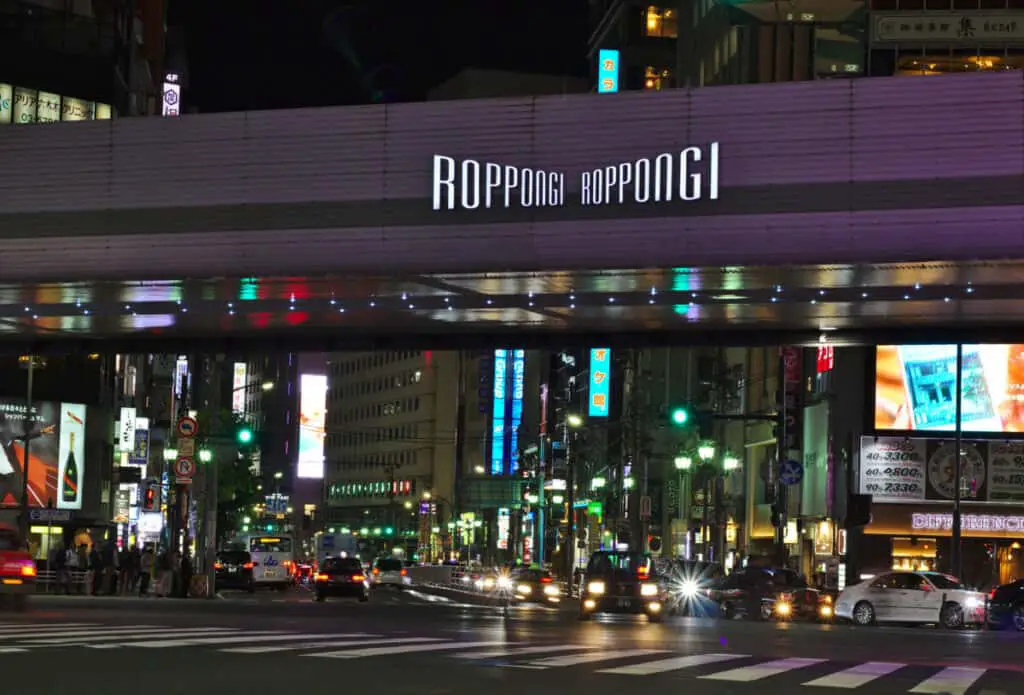
Finally, West Tokyo is home to the fantastic Shibuya , Harajuku, and Shinjuku districts, full of shopping, fun activities, and various subcultures. Yebisu Garden Palace is a great place to enjoy some Japanese beer, and the Meiji Shrine is a gorgeous place to see.
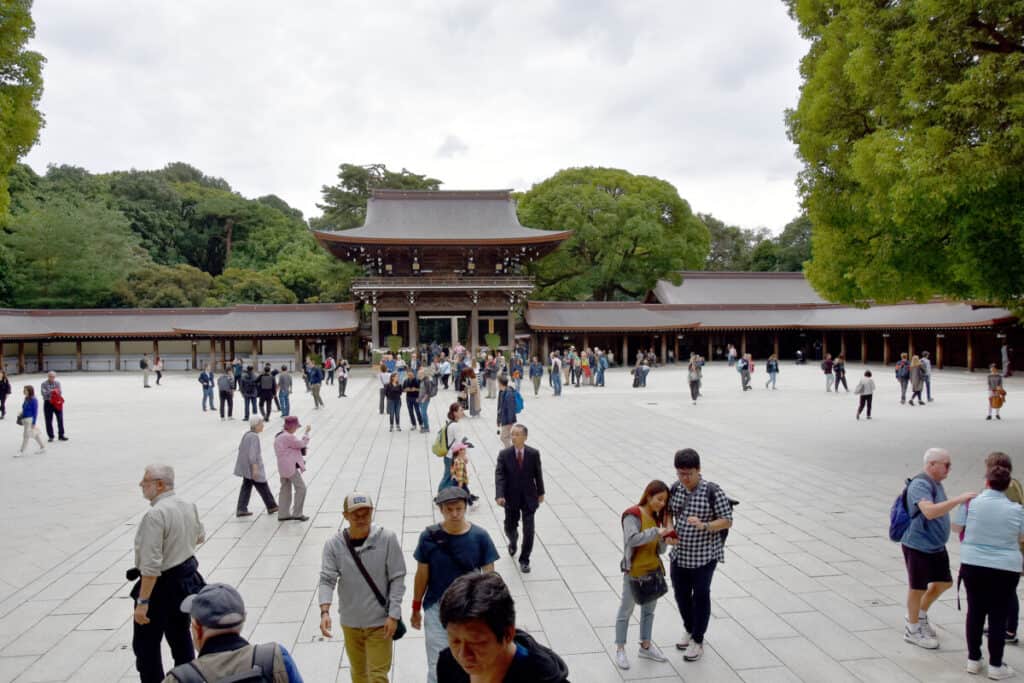
Tokyo can be a confusing city to traverse, so google maps are highly recommended to aid you in your exploration.
Tokyo Station
You’re likely going to make your way through Tokyo Station a few times in your travels through Japan. Don’t just let the station pass you by, though; in and around Tokyo Station, you’ll find a wealth of things to see and do.
Tokyo Station is also where you’re able to catch the shinkansen , or bullet train, which is likely to get you to many of your intended destinations.
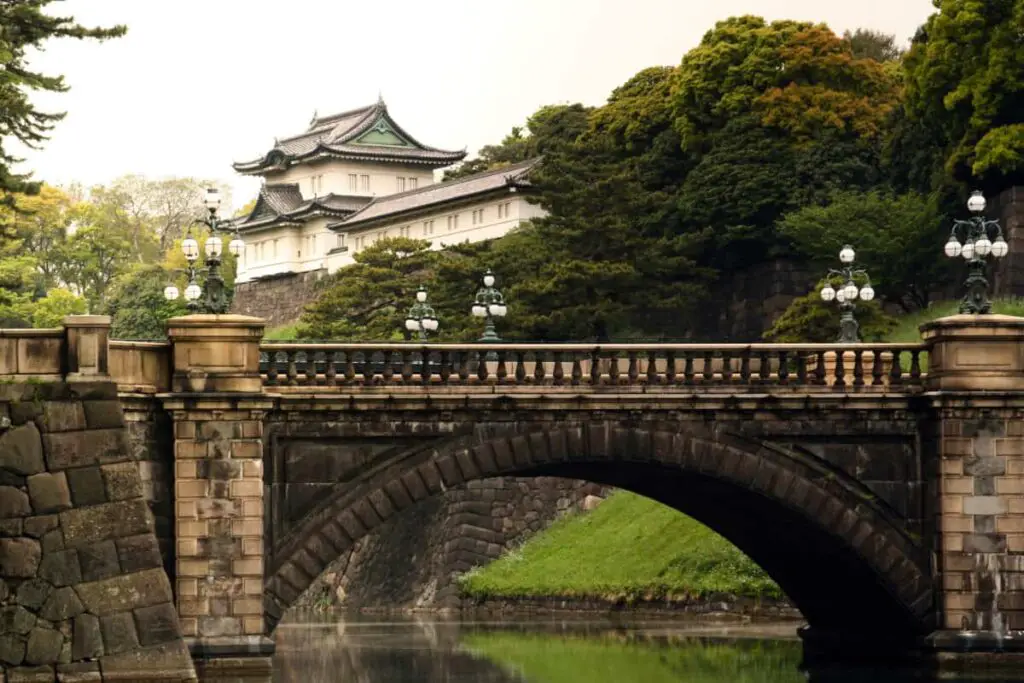
When you venture outside of Tokyo Station, which is in Central Tokyo, you’re surrounded by the Marunouchi business district , a vast array of shopping, and the Imperial Palace and accompanying garden. There’s also a lot of green space to sit down, relax, and enjoy some fresh air.
Mount Fuji And Fuji Five Lakes
Mount Fuji brings floods of tourists to Japan every year. This UNESCO World Heritage Site is a crucial element of Japanese culture and spirituality and is a very important symbol for Japan.
The beauty of Mount Fuji cannot be understated, and it’s worth the trek to the area. There’s a lot more to do around the Mount Fuji area than some might realize.
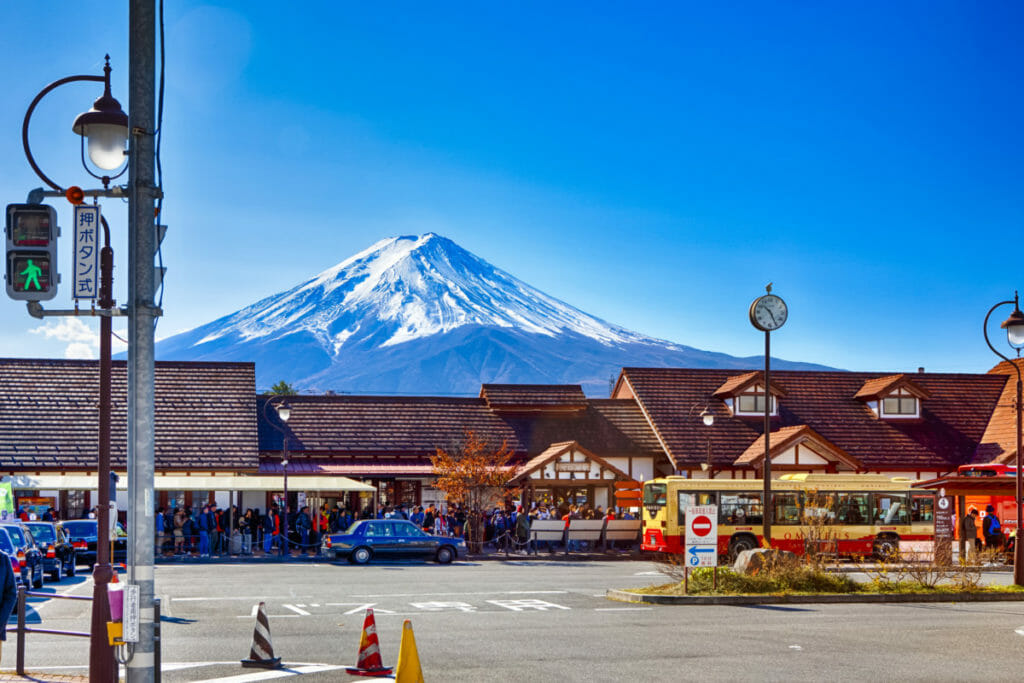
The Fuji Five Lakes area surrounds Mount Fuji, and you’ll find various ryokans to stay at, as well as shrines, hot spring baths , and even an amusement park.
While it can be hard to pick where to stay since there are so many enticing spots in Fuji Five Lakes, you’ll want to stay at least one night to get to explore as much as possible.
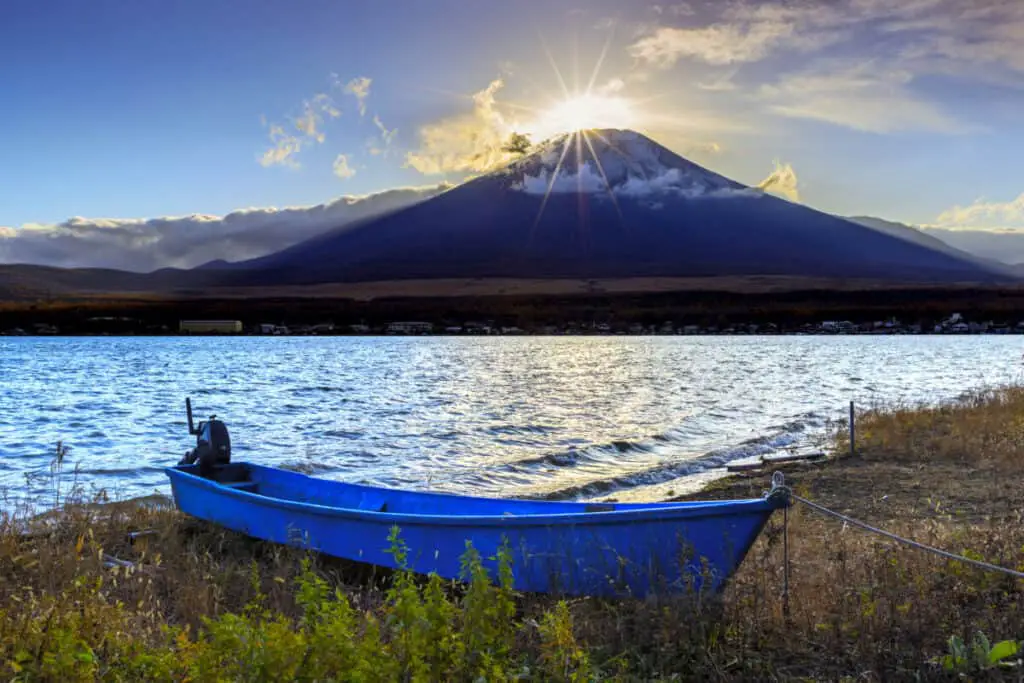
You’ll be surrounded by some of Japan’s main attractions in this one region. Mt. Fuji is the symbol of Japan itself. There is a cable car in the area, but it does not offer a trip to the summit of Fuji. If you have a few extra days to spend in the area, you’ll be rewarded with incredible mountain views at sunset and sunrise .
Kyoto is a place in Japan that is so full of history, a lot of which can be learned about from various museums and temples in the city . Many of these historically significant sights in the city have been standing for a very long time, despite the amount of devastation the city has seen over centuries of strife.
Like Tokyo, Kyoto is split up into Central, Eastern, Western, Northern, and Southern Kyoto, so you’ll want to spend a couple of days in the city at least. Central Kyoto is home to palaces and temples galore, such as Sento Palace and the Kyoto Manga Museum.
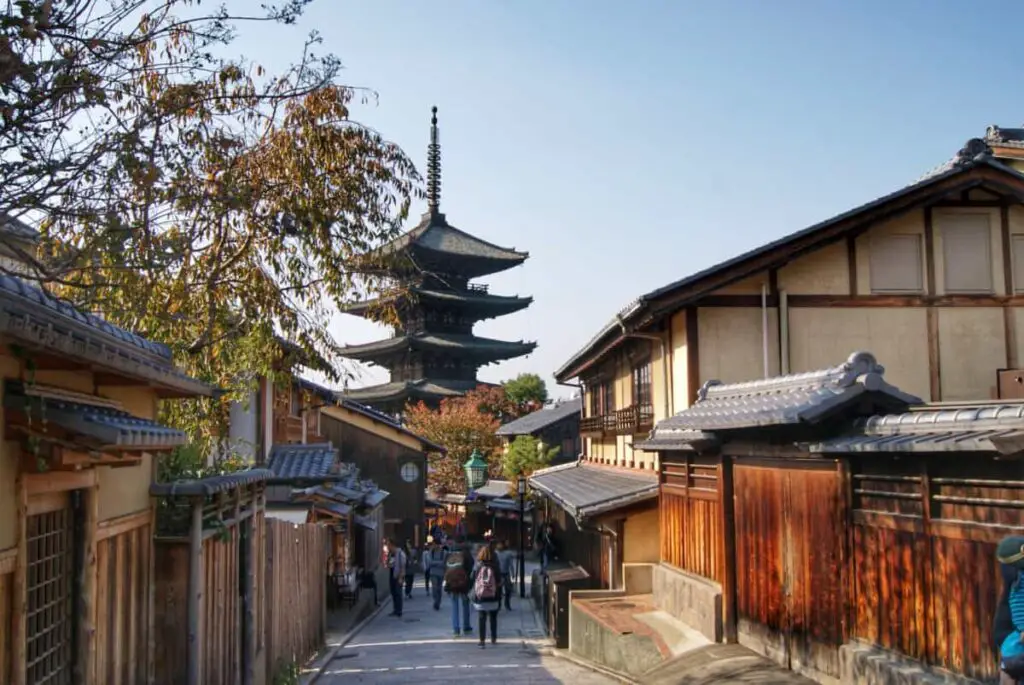
In Eastern kyoto, you’ll find numerous temples and shrines, as well as Maruyama Park and Gion, the famous geisha district.
Northern Kyoto houses a wealth of stunning locations of both historical and spiritual importance, including the Kinkakuji Golden Pavilion , the Enryakuji Temple, and the Kamo Shrines.
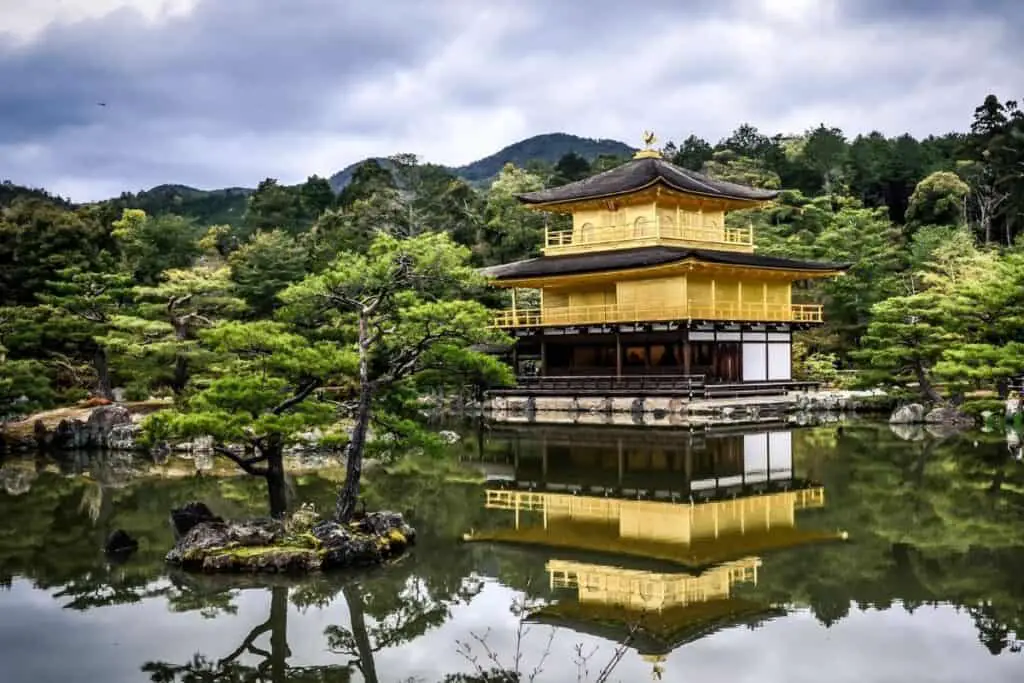
In Western Kyoto, you can sip some Japanese whiskey in the Yamazaki District, or take a boat ride through the Hozugawa River. Southern Kyoto has the Fushimi Sake District and the Daigoji Temple among other sites. Don’t forget to visit Nishiki market in downtown area. Kyoto itself is one of the best cities to see cherry blossoms in the spring.
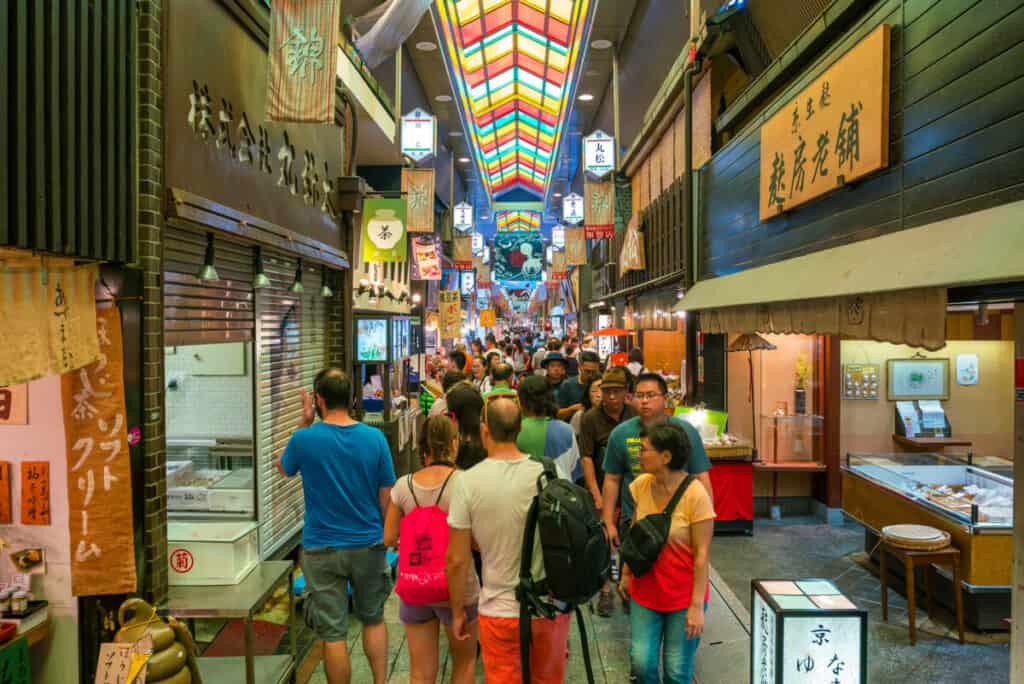
Of All Japanese cities kyoto is one you should not miss if you want to see the real Japan.
Hiroshima is the city known for falling victim to the atomic bomb, but the resilient city is so much more than that. The picturesque city is full of natural and created beauty, and there’s a lot to be learned from the major sites there.
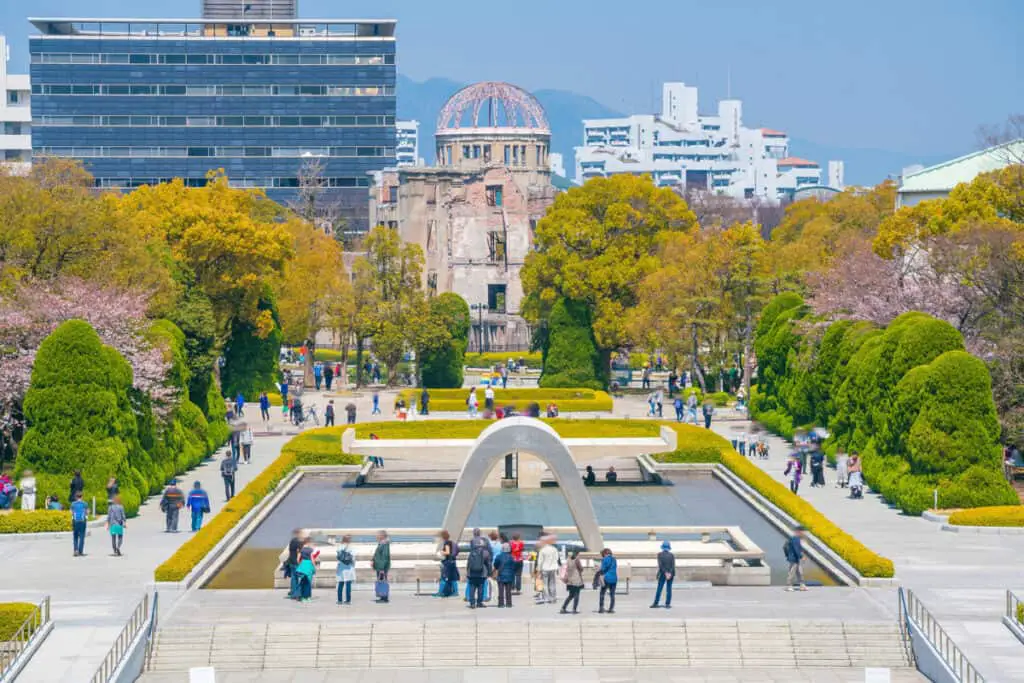
The Peace Memorial Park is the place to remember the lives lost from the atomic bomb, and the Hiroshima Castle is truly a marvel in construction.
When you make your way to Hiroshima to stay for a couple of days, you’ll want to split up your trip to venture to nearby Miyajima.
Miyajima is a stunning island that’s not too far from Hiroshima, and you can take a short boat ride to spend the day there before heading back to Hiroshima.
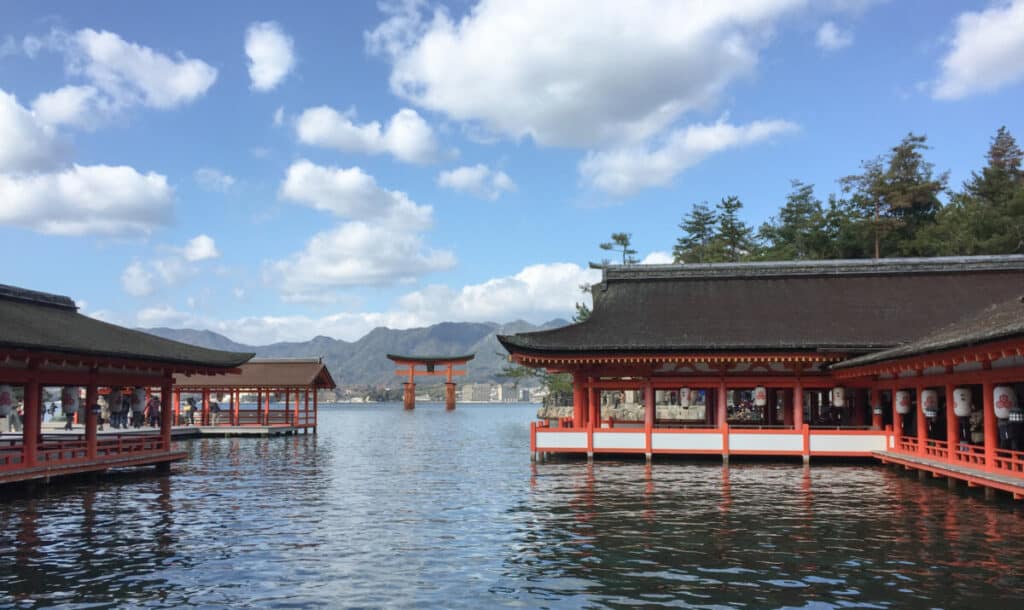
Miyajima is also where you’ll find the very famous red torii gates of Itsukushima.
Nature lovers will enjoy seeing the very large Mount Misen, and making their way along the various walking trails around the island. A truly beautiful city you will want to see if you’re visiting Hiroshima.
Finally, you’ll absolutely want to make your way to Osaka to spend the final days of your trip there. Osaka is full of bright lights, bustling city life, and many things to see and do. For instance, you can do some shopping and exploring in Shinsekai, a district that looks a lot like old Japan.
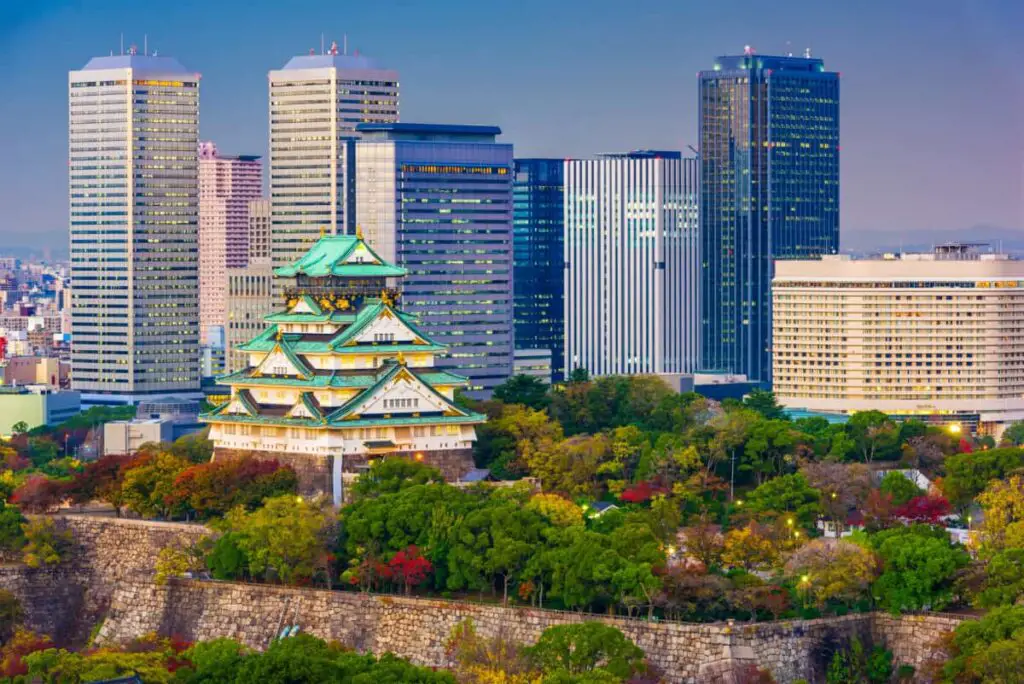
Minoo Park and Mozu Tombs are great places to get some sun and see some nature, and the Tenma District is the place to go for arcade games. Kuromon Market is a great place to go for some food-based souvenirs or some snacks to take home for yourself.
Osaka is the perfect place for hardcore foodies. The good news is that so many restaurants ensure you have enough time to sample Osaka’s various dishes.
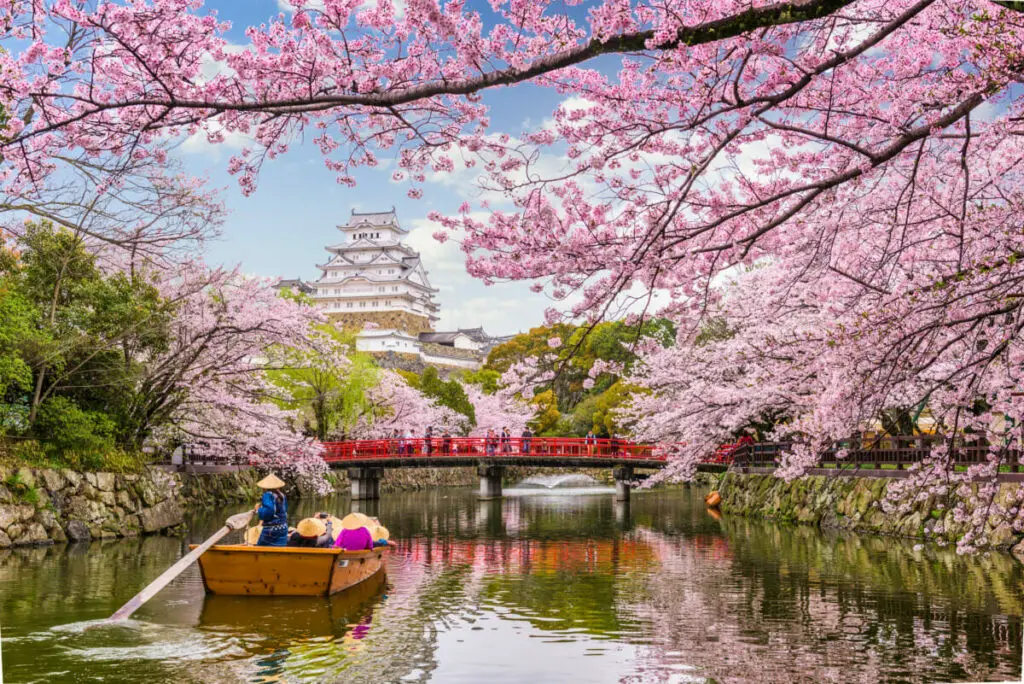
If your visiting Osaka for more than a couple of days, a short train ride will take you to Himeji Castle Japan’s most visited castle.
Making Your Two Week Stay Memorable
When you’re finalizing your two-week itinerary, there are some things to keep in mind before you make your final decisions.
These travel tips can not only help you keep to your intended budget, but they can also help you make the most of your trip.
Take Advantage Of Free Experiences
Exploring Japan doesn’t have to be expensive. There is a lot to see and do that doesn’t require any money, other than what you might need to spend traveling to and from the spot as well as any sustenance you might need.
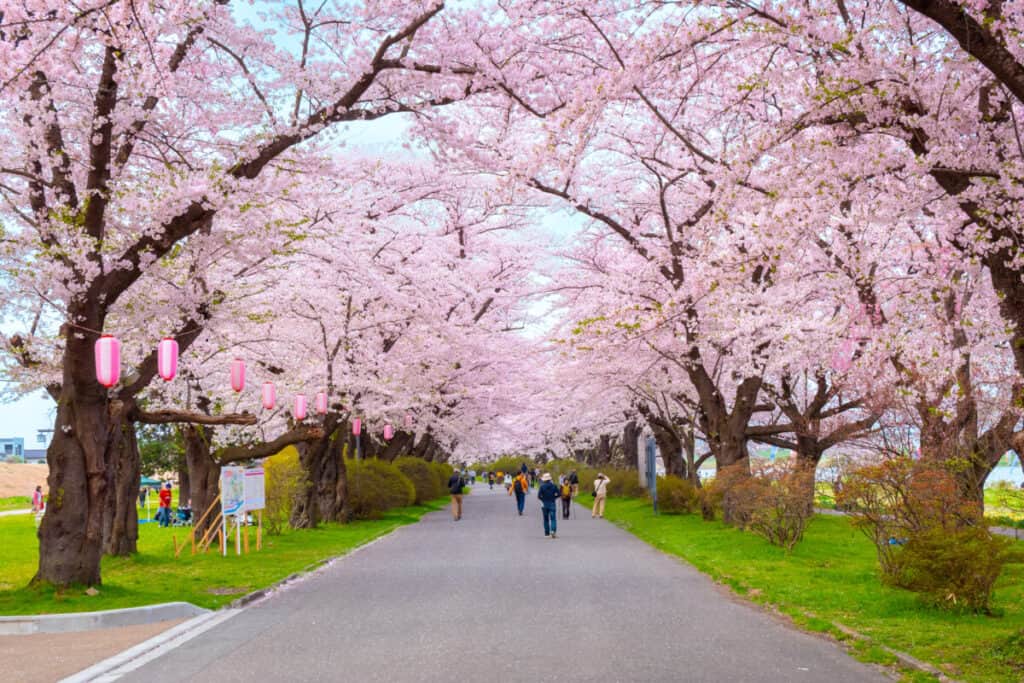
That said, with your JR Pass or IC Card and some snacks bought at a convenience store beforehand, you can easily spend at least half a day exploring Japan for free.
For instance, parks in Japan offer green space, plenty of seating, and even some amenities and trails to walk around.
Visit Temples And Shrines
Even if you don’t practice religion, visiting some of the thousands of Buddhist temples, Shinto temples, and accompanying shrines is not only inexpensive but will be an especially memorable experience.
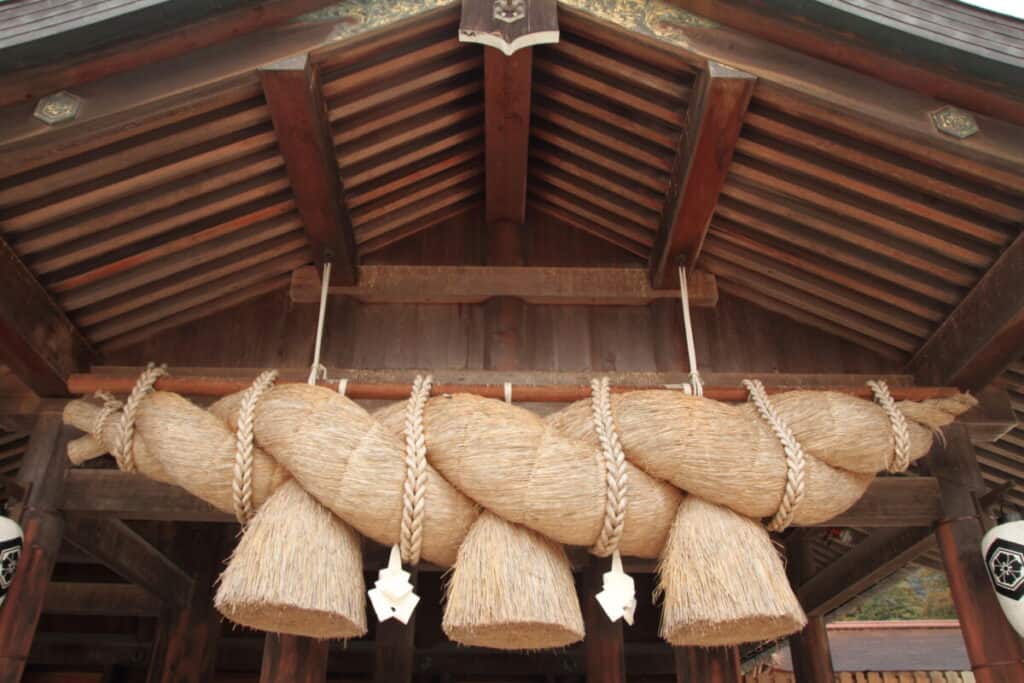
Many of these spots have guides you can learn from, picturesque gardens to walk through, and works of art in their architecture.
Hot Spring Baths/Onsens
An onsen is a hot spring bath, usually sourced from natural spring water in the area of the bath. One can find these baths indoors and outdoors, and onsen towns have been created by many sources of hot spring water throughout Japan.
These small and inviting towns are some of the best places to stay in Japan if you’re looking for a reprieve from the stresses of life.
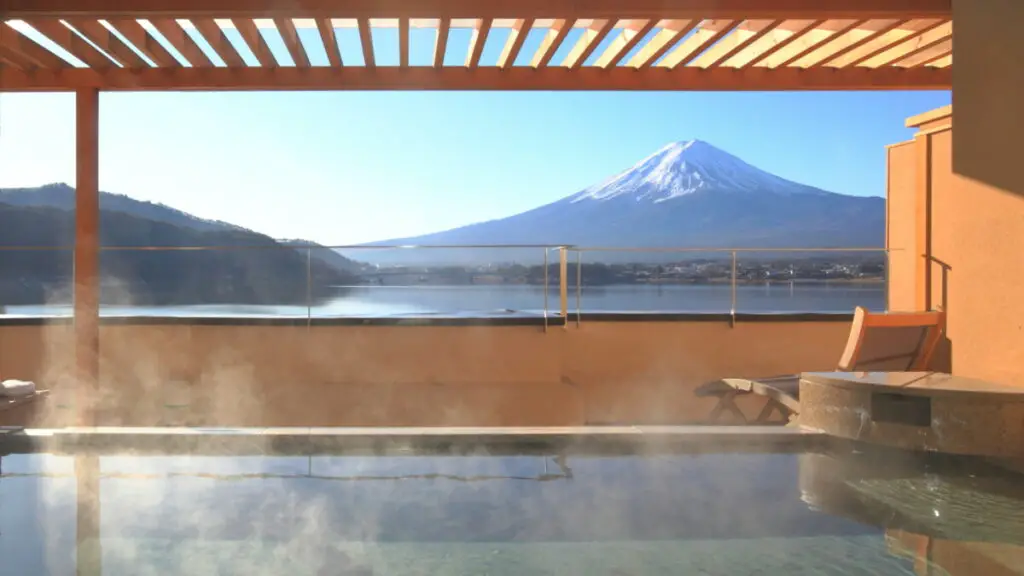
Hot spring baths and bathing culture are big in Japan. Before homes had accessible baths, the only option in Japan was to enjoy a public bath or Sento .
Outside of the social aspect of bathing culture, hot spring baths have been utilized in Japan for centuries for various ailments and health concerns.
If you plan on spending any time near Mount Fuji, you’ll definitely be able to enjoy your fill of hot spring baths. That said, there are plenty of onsens all around Japan so no matter where your travels take you, you’re likely to find at least one.
Where To Stay In Japan
The specific accommodations you book for your travels are going to be dictated by where you want to go.
The fantastic aspect of accommodations in Japan is that many of them is an experience in and of themselves rather than simply a place to sleep. Your options are quite extensive, from hostels to capsule hotels to traditional Japanese inns, also known as ryokans, that have a traditional Japanese private rooms.
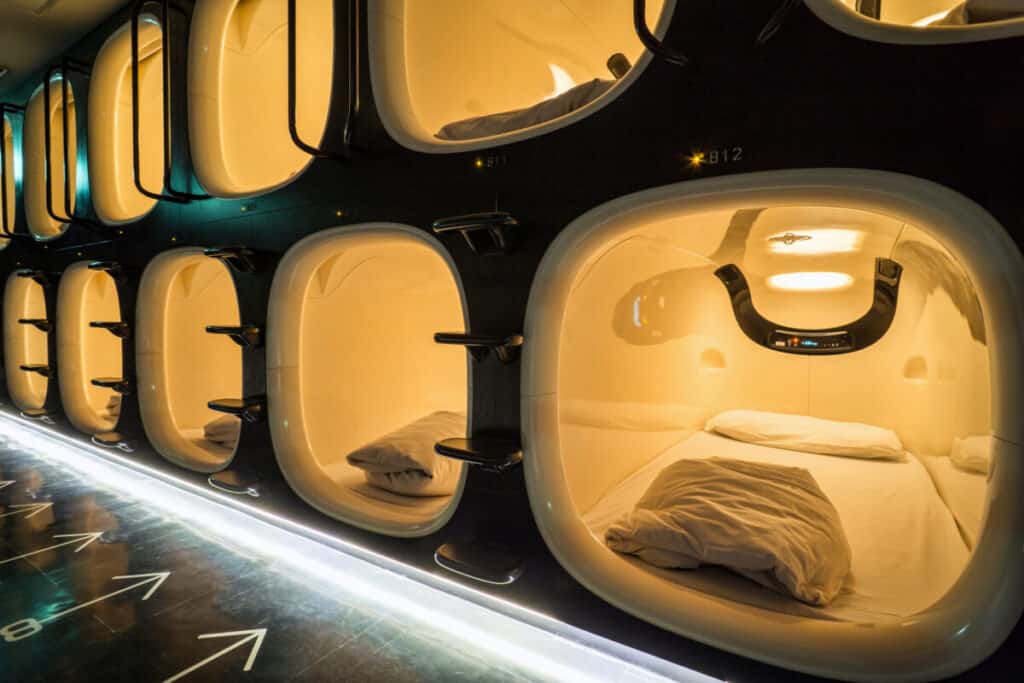
The language barrier is not as big a problem as you might imagine, as most accommodations will have at least one persons who understand basic English.
Japanese Hostels
A hostel is most often the cheapest option, especially if you’re not picky about your accommodations.
What’s important is to research hostels to ensure that where you’re staying is suitable to your needs and comfort level.
Best Hostels In Japan Via Tripadvisor
That said, Japanese hostels have a fantastic reputation for being clean, full of friendly and hospitable people, and very affordable.
Japanese Capsule Hotels
A Japanese capsule hotel is a unique experience where you sleep inside a pod. Most of these capsule hotels are fairly affordable, though, of course, a hostel or a hotel may end up being more affordable.
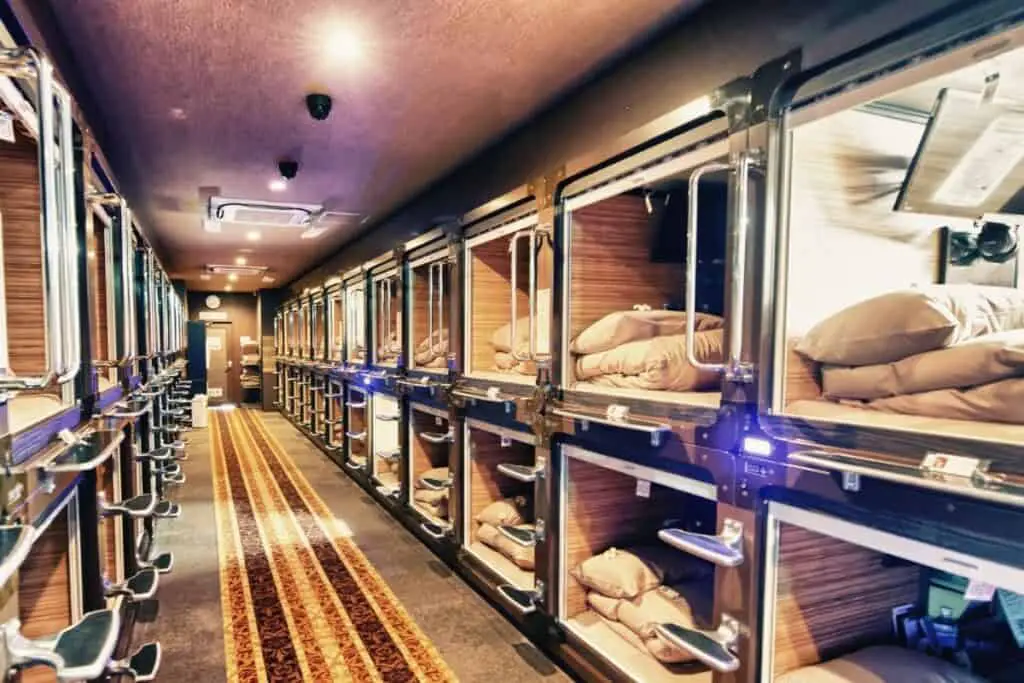
If you have the room in your budget, it’s worth checking out a capsule hotel for a night. If you’re looking for a cheap hotel, this is your best option.
Japanese Hotels
Staying at a regular hotel in Japan can easily become expensive, depending on what kind of hotel you choose to stay at. As expected, hotels range from mid-range to luxury in terms of price, amenities, and location. You can find a lot of recognizable hotel chains in Japan, as well as a mixture of local and smaller hotels.
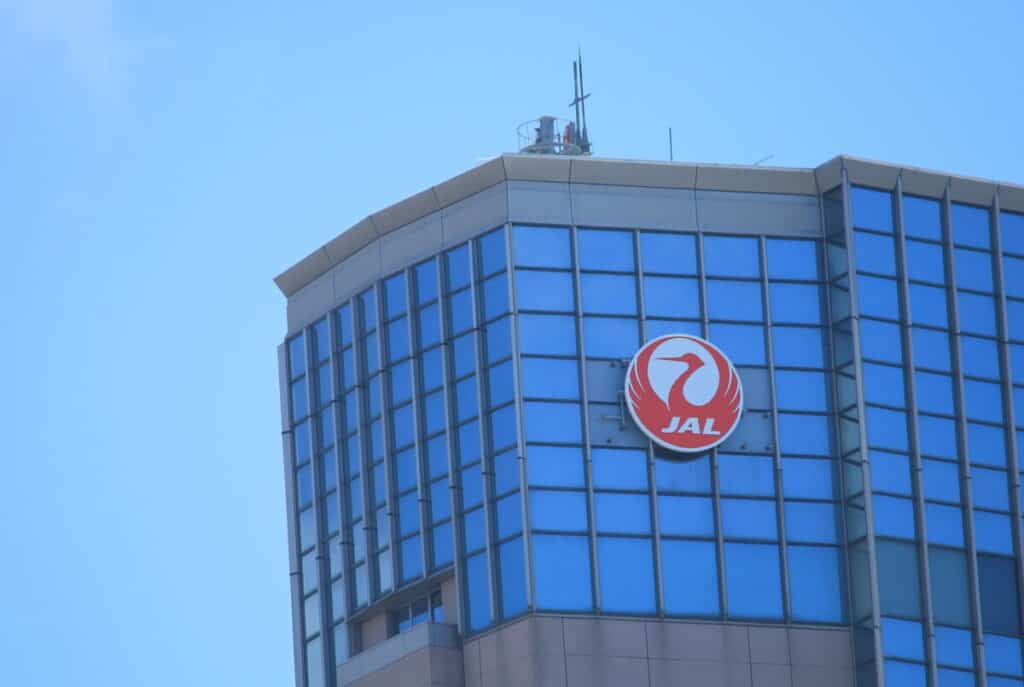
Hotels cost more if you stay right in the heart of major cities . Given how great public transportation is in Japan, there’s no need to stay in a hotel right in the city.
Instead, you can save a few bucks if you stay in a hotel just outside of the city and take the train in when you’re planning on sightseeing.
Japanese Ryokans
A ryokan is a preferred accommodation option if you’re looking to immerse yourself into Japanese culture as much as possible.
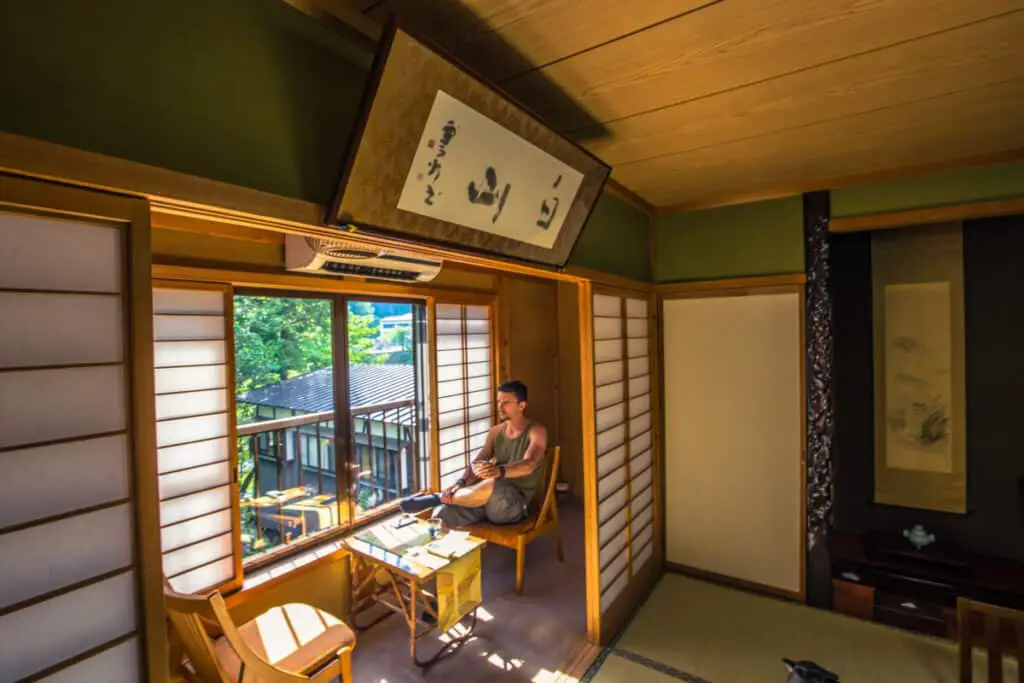
These traditional inns can offer a range of different experiences and amenities depending on where you’re staying. Typically, you’ll have a small, clean room to yourself, though bathrooms are often shared between guests. Most ryokan has hot springs on site.
Some of their hotel rooms even have a private onsen (hot spring bath) located within the room. One of the most important things to remember if your using a shared onsen with other guests is that nudity is part of the onsen experience.
Eating In Japan
Going out and experiencing authentic Japanese food is well worth making a part of your travel budget. While it’s not economical to indulge at five star restaurants every night, you don’t want to miss out on local delicacies and unique dining experiences based on where you’re staying.
There is so much more to Japanese food than sushi, though sushi in Japan is better than anywhere else.
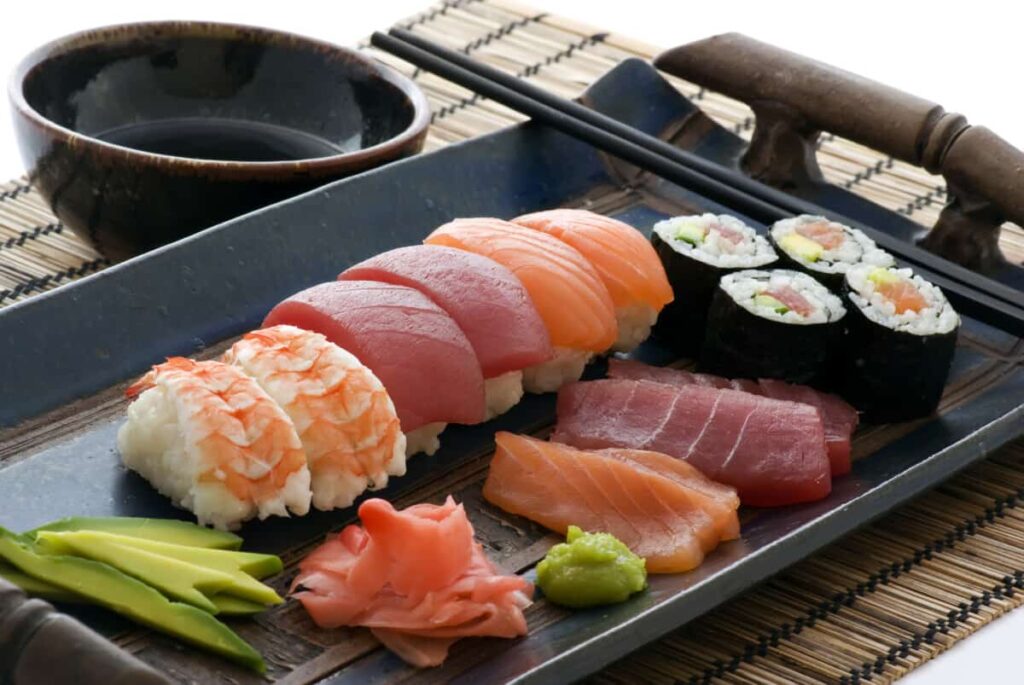
Comparatively, it’s not expensive to feed yourself when traveling through Japan. Your best plan of action to ensure you get to indulge in some memorable meals is to seek out the local delicacy in each place you stay in as you make your way through your itinerary.
You can either chat up the locals or do some research beforehand, depending on what you’re comfortable with.

Seeking out an izakaya is also highly recommended at least a few times when you’re in Japan. These are Japanese bars that serve small bites and snacks often using locally sourced ingredients crafted in unique ways.
Budget-Friendly Eating In Japan
You have a ton of options to get your fill of delicious Japanese food without blowing your food budget too quickly. You won’t miss out on good eating even when you opt for budget friendly options.
There are ways to find authentic, yummy Japanese fares without having to go to a restaurant for every meal.
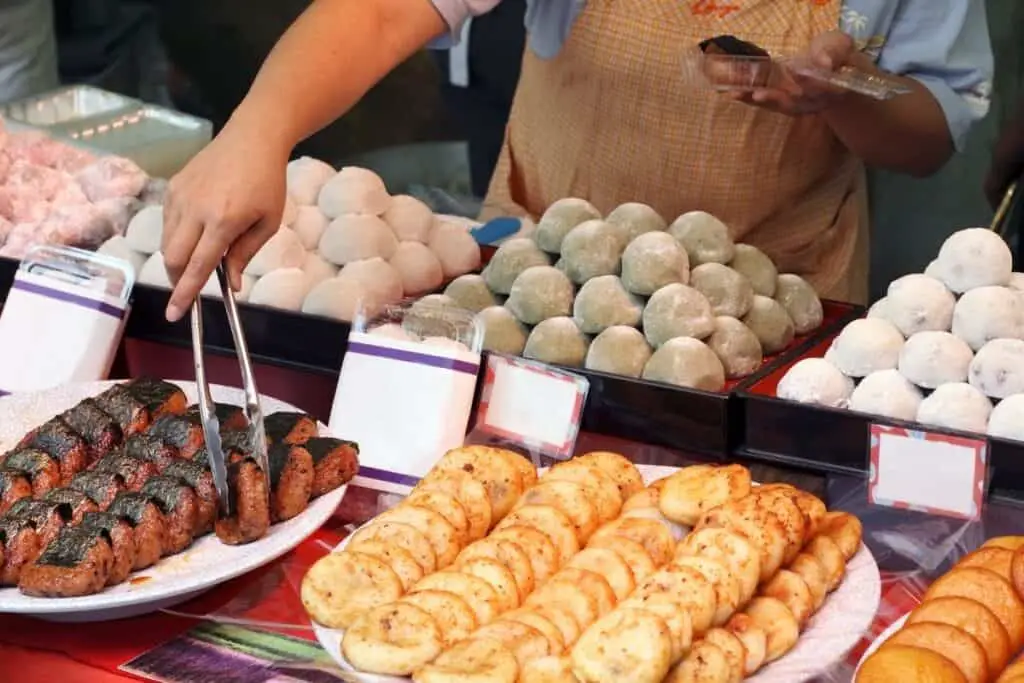
Street food is pretty bountiful in Japan, from vendors on the street to various stalls at a market. You can even find vending machines that offer inexpensive yet delicious snacks.
You can also grab some quick meals at convenience stores that are high quality, made with fresh local ingredients, and are also very budget-friendly.
Shopping In Japan
Japan is an epicenter of some very unforgettable shopping, as it’s one of the biggest fashion trend-setting countries in the world.
Outside of fashion, there is so much shopping to be done in Japan that it’s very easy to spend a lot of money doing so.
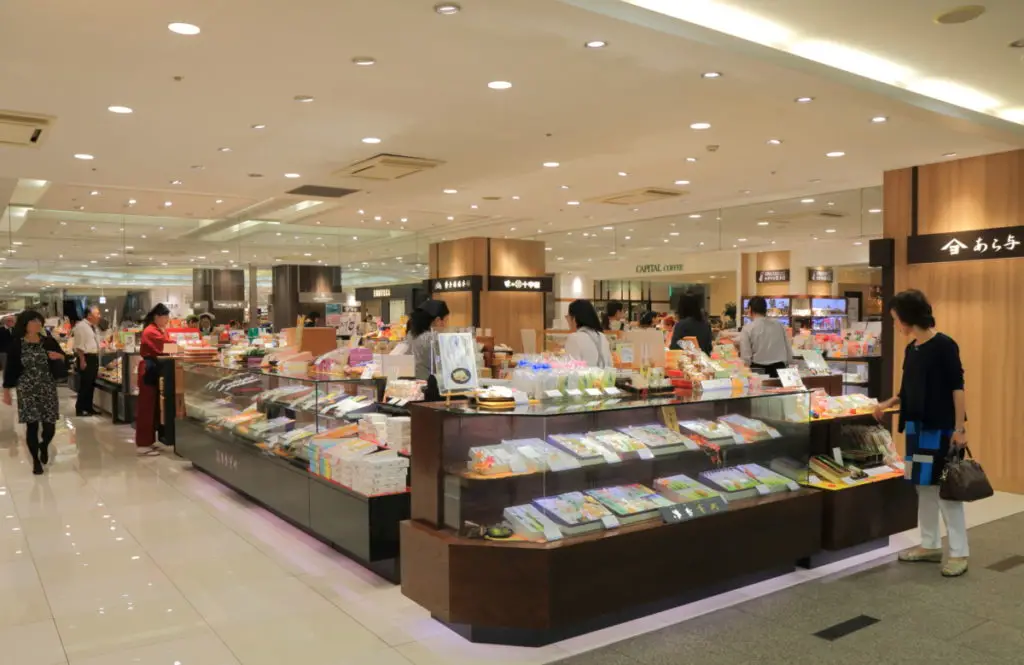
Having a strict budget for yourself can help you avoid spending all your money on other parts of your trip buying things. Tokyo department stores often have multiple levels of goods and services. The best thing is the onsite restaurants that have incredible dining experiences.
Japan is known as a cash-based society, so its a great idea to have Japanese yen in case credit cards are not an option. Many small mom-and-pop coffee shops are cash-only.
Budgeting For Your Trip To Japan
Budgeting is a major priority as soon as you know you’ll be planning a trip anywhere. The time of year you opt to travel to Japan can have some influence on cost. For instance, Japan is a popular place during cherry blossom season , which starts in April, so you can end up paying premiums for travel and accommodations.
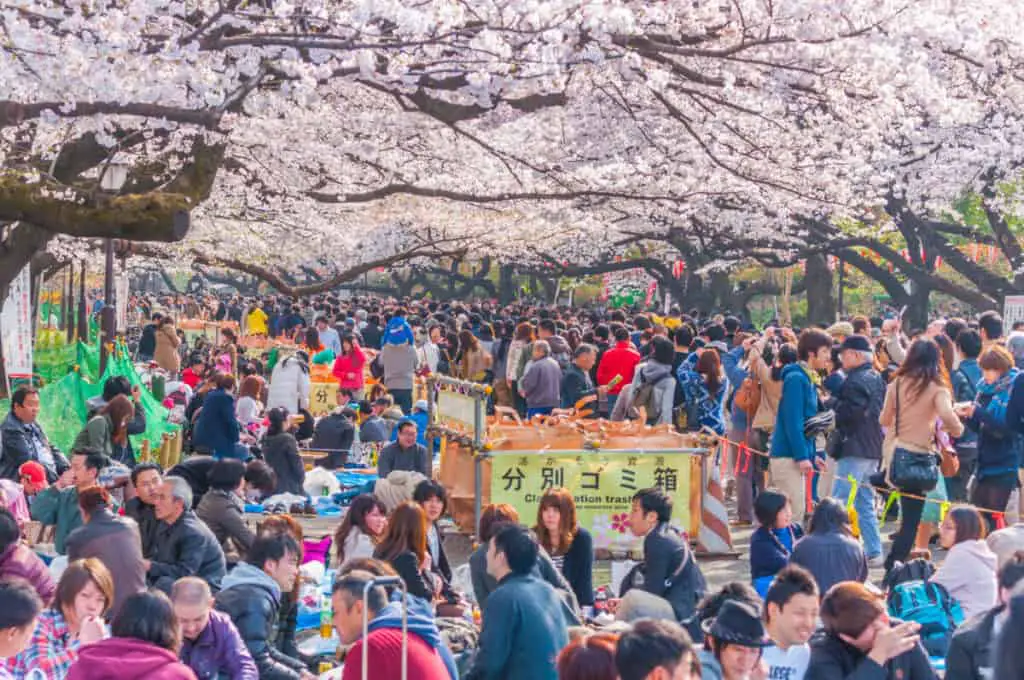
Despite popular belief, traveling within the country of Japan isn’t as expensive as one might assume. Some careful planning and having an itinerary mapped out beforehand can help you get a better sense of how much money you’ll need.
Having a safety net such as a credit card that doesn’t charge foreign exchange fees can give you some peace of mind, even if you don’t end up using it.
You can use a credit card at many places in Japan you’ll likely frequent, though it’s good to note that many places, especially tourist destinations, prefer cash when possible.
An Estimated Budget Of A Two Week Japan Trip In 2023
The biggest expenses you’re likely to see will be your flights and your accommodations. Your flight costs will vary depending on where you’re flying from, what season you’re choosing to fly in, and whether you pick a direct or indirect route, with added advice on the best time to fly.
Keeping your eye out for deals or seeing if you can cash in some reward points towards your flight can potentially save you a lot of money flying such a potentially long way.
There’s no exact answer for how much money you’ll need for a trip to Japan, no matter if you’re looking for a trip on a budget or not. All things considered, you could travel to Japan and stay for two weeks with between $3000 to $6000 USD based on what your final itinerary looks like and how well you manage your money in the country.
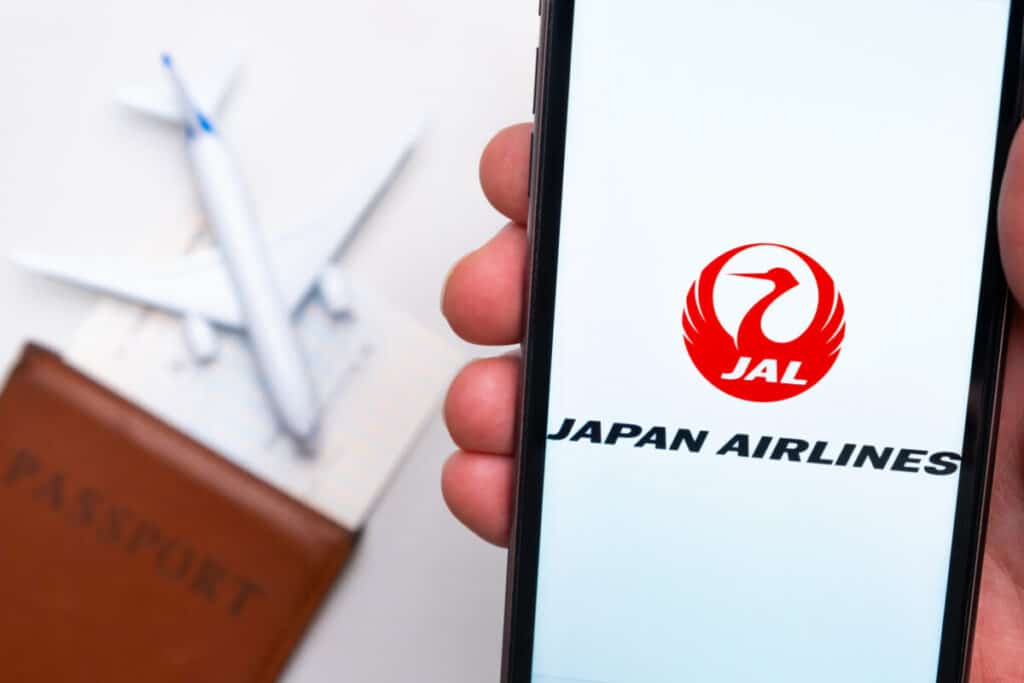
The following list features estimates based on a two week stay in Japan, considering some of your major and minor expenses. It’s important to note that estimates are just estimates and cannot be considered exact due to the numerous variances in costs associated with travel.
Furthermore, this chart and the estimated costs are based on traveling from the United States and are based on American currency USD.
Estimates may also be a little bit higher than what you could actually spend based on a number of factors. It’s always better to budget extra and have extra wiggle room than underestimate how much your trip will cost.
Estimated Costs (USD)
Airfare (international flights)
$1000-$2500
Transportation
Accommodations
Attractions and Experiences
Miscellaneous Expenses
TOTAL (Estimate by Budget)
Below is a further explanation of the budget seen above in the chart to understand how prices can vary depending on your specific plans and overall Japan cost.
It is a good idea to purchase a sim card to ensure your phone will operate on Japanese networks. The following is a more detailed look at cost of your Japan itinerary:
You’re likely looking at anywhere between $1300 to $1800 USD for your flights to and from Japan if you’re traveling from the United States.
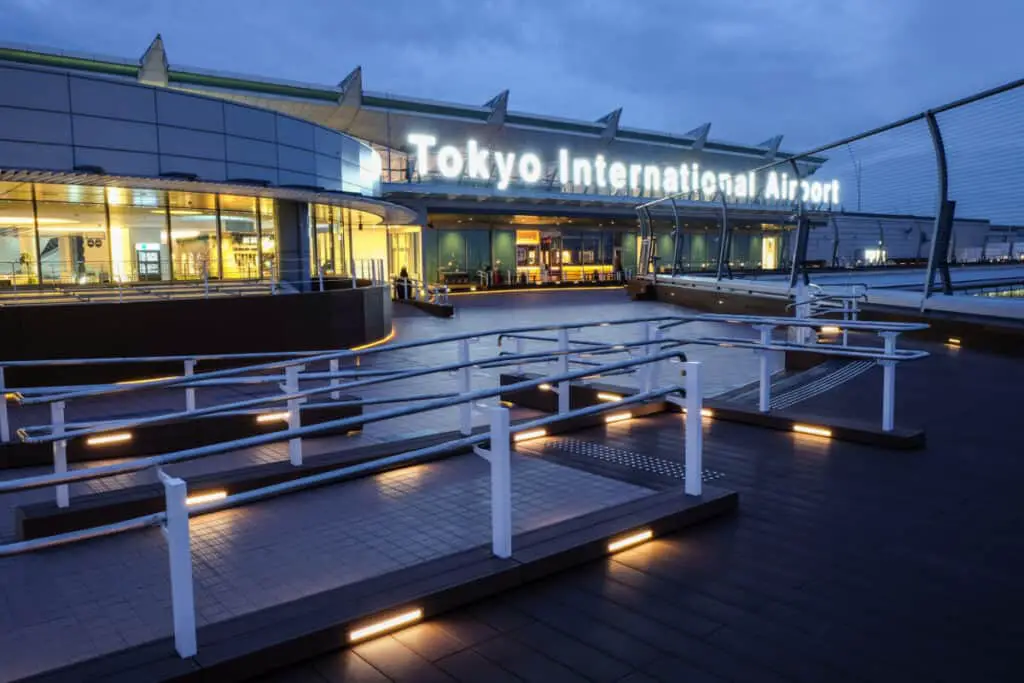
If you have the option to, fly into the Haneda Airport . It’s the most convenient airport to fly into as it’s close to Tokyo, which you’re likely going to travel in or through as you make your way through Japan.
Depending on your origin city, there are many direct flights to Tokyo and Haneda and Narita are the easiest way to begin a journey in Japan.
Transportation
Conveniently, you can purchase a JR Pass for a 14 day trip for unlimited travel on most of Japans train system. The cost for a 14 day Japan Rail pass is about $400 USD.
If you decide you want the upgraded pass, you’re looking at around $600. With how clean, safe, and accommodating transportation is in Japan, it’s really not needed for you to upgrade to a green pass to get luxury seating. If your traveling with a small group JR Pass will save you a lot on public transport.
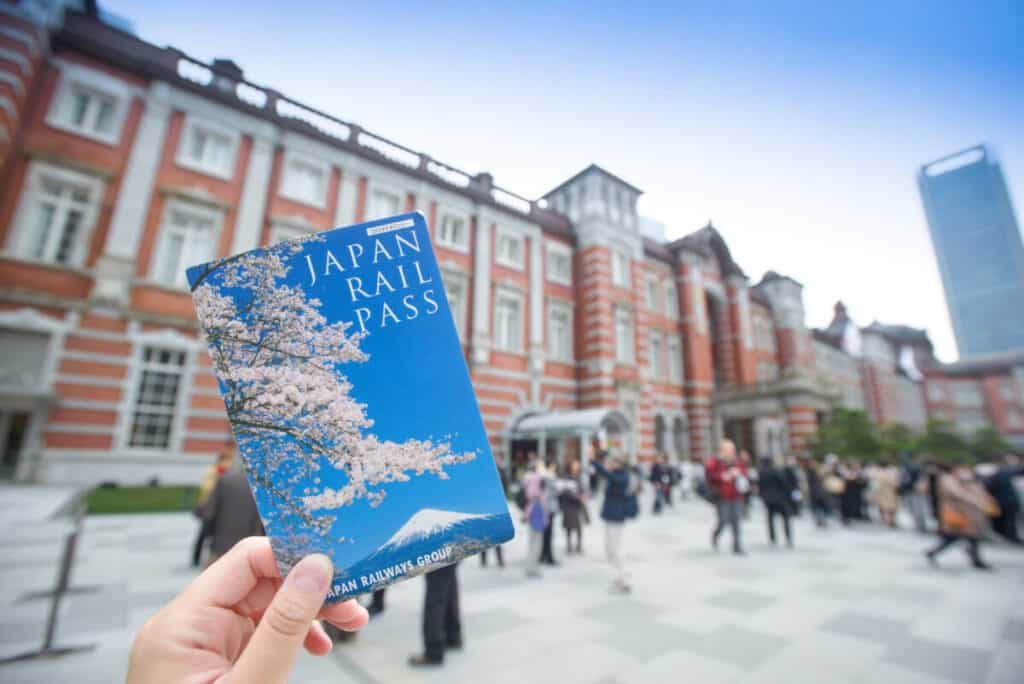
If you also plan on getting an IC card, you’ll have to account for the deposit and the minimum amount needed on the card. This only accounts to about $15 USD altogether.
If you put $50 USD on your card, you’ll be able to use it for local transportation fares and likely not have to reload it, though doing that is pretty simple.
You can also choose to add a little more since you can also use the card at vending machines and select convenience stores. It’s good to have a little extra cash on you for transportation in the very off-chance you can’t use either of your passes.
Accomodations
Accommodations can make up a moderate to big portion of your budget depending on what kinds of places you choose to stay in.
Generally speaking, accounting for between $100 and $125 dollars per night you’re in Japan is a good place to start.
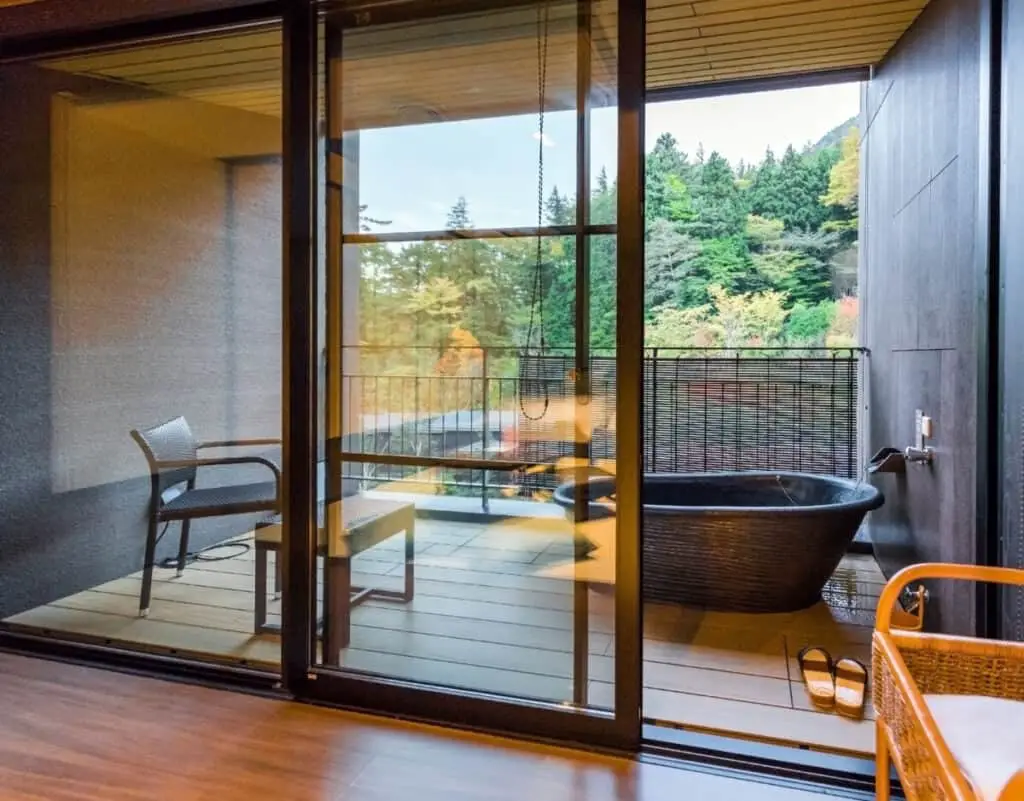
You’ll find quite a few accommodation options that are going to fall under this amount, though whether or not you choose to stay in those options is based on your comfort level.
You could easily feed yourself well on a budget in Japan without missing out. If you consider a food budget of about $30-$50 USD a day, you’ll have a lot of freedom in terms of being able to mix in some indulgences with some more budget-friendly options.
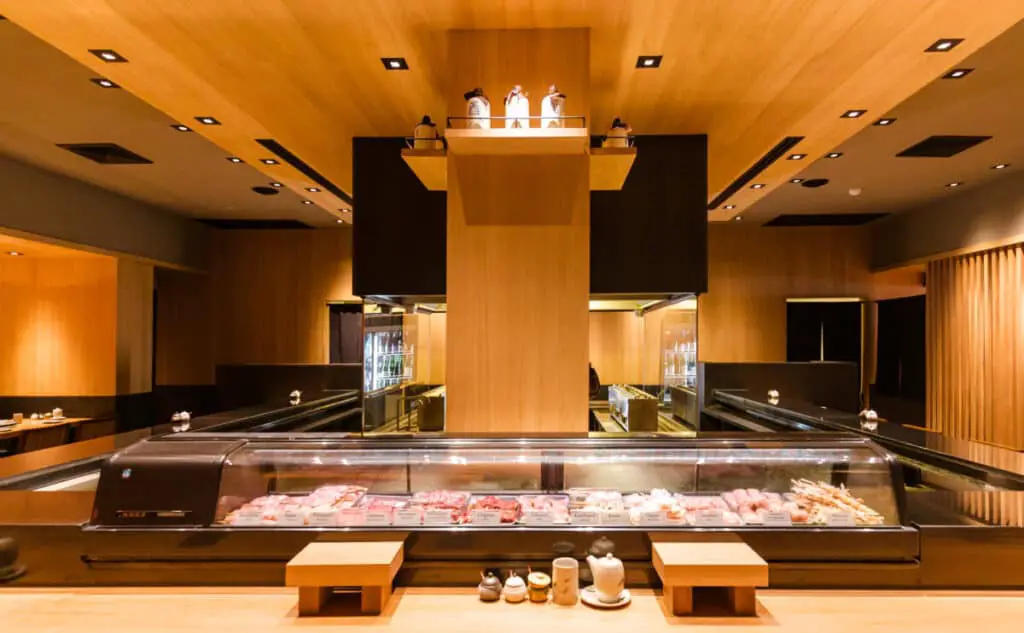
For two weeks, you’re looking at anywhere between $400 to $700 USD, though it’s very easy to be flexible with your food budget at many great restaurants .
Attractions And Experiences
This is likely to be one of the trickiest parts of your budget to plan. Traversing through Japan can be affordable or very expensive depending on how you plan and what it is you’d like to do.
The good thing is that you have a range of affordable places to see and things to do in Japan, many of which are highly desirable tourist spots.
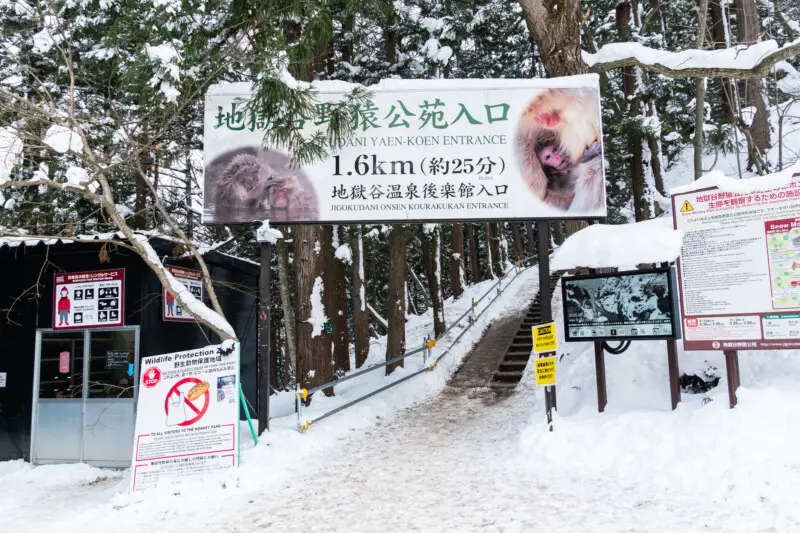
When possible, it’s worth seeing if you can purchase admission or tickets for your planned excursions in advance.
This won’t usually save you money, but in some cases, it might; it’ll definitely save you a lot of time you could waste waiting in long lines to get admissions. It can also help you reserve your spot should you indulge in something where participants are limited.
Your shopping budget will also have a lot of flexibility depending on your shopping habits. You always want to keep in mind what you have the capacity to bring back with you.
You want to be somewhat generous with your shopping budget no matter your habits, as letting yourself experience all the incredible districts with unique shopping opportunities is a must.
It’s important that you don’t over-promise people regarding what kinds of souvenirs you’ll bring back for them, as you don’t want to blow your spending budget on souvenirs for other people.
There are many places where you can find inexpensive souvenirs for people, however, and not just cheap, boring souvenirs, either.
Miscellaneous Expenses
You’ll want to have some room in your budget for things like incidentals or extras that you may not necessarily need but can make your trip more convenient. This can include things like a pocket wifi device so you can look up maps and connect to the internet safely when needed.
If you can budget for some wiggle room or have a backup plan should you run out of money, it can be a safety net of sorts if you find a few things you just can’t do without.
This is where a credit card with no foreign fees can be handy, though not if you’re the type of person who will be tempted to continuously swipe their card.
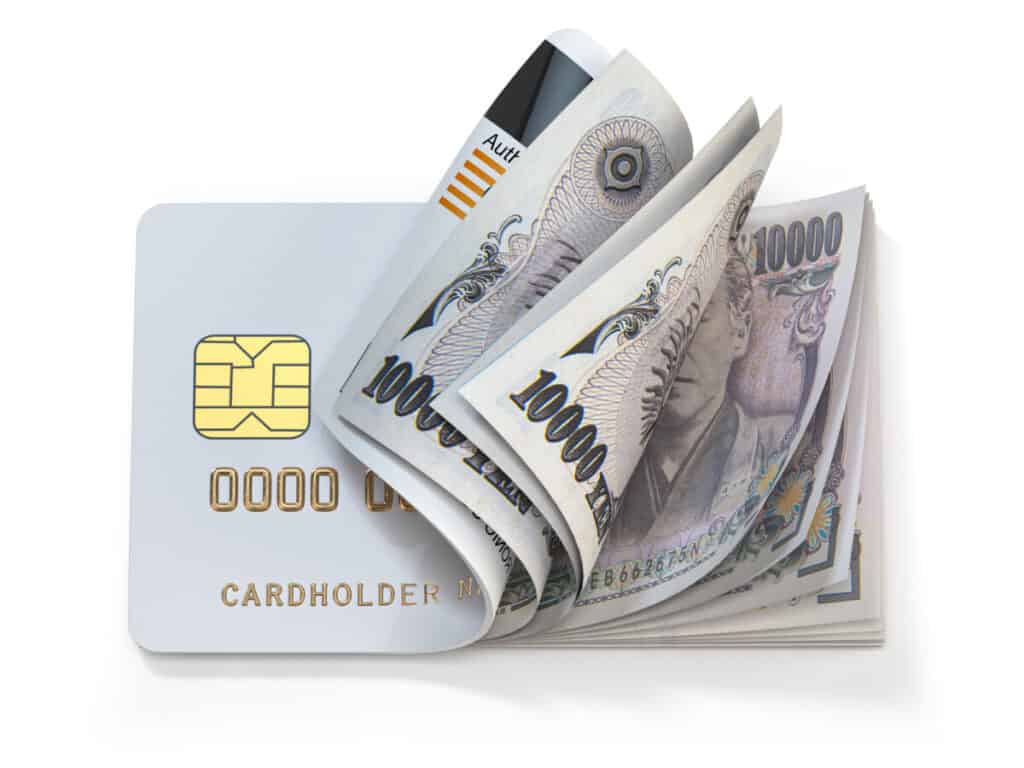
There are some costs associated with traveling to Japan that can’t be avoided, such as your plane ticket and your accommodations. The further in advance you can plan your trip, the better off you’ll be in terms of being able to shop for deals on tickets to sites, plane tickets, and even hotels or ryokans .
Don’t just stick to fancy restaurants when eating out either; some of the best food you’ll find will be in the streets or in little hole-in-the-wall restaurants that you’ll only discover once a local tells you about it.
Final Pro Tips On Visiting Japan
Depending on what your travel goals are, Tokyo is the best place to begin your exploration. Even if you are planning on spending your time in another city, it’s best to plan at least one full day there.
It’s a great way to see ultra-modern Japan and experience good food, luxury hotels, and the many Buddhist temple sites.
japan is known as an expensive country to visit and so having credit cards for an unplanned emergency is a great idea.

The Japanese people are incredibly well-mannered and kind. First-time visitors will be surprised, even in crowded Tokyo, by how willing they are to assist you if you find you need help.
The price range for visiting Japan can vary greatly depending on your personal budget, and travel guides are a popular option for your first day in Japan.
It is one of the most expensive countries in the world to visit there is still room for a good deal for savvy travelers. Some single-room business hotels can have lower average prices over larger chains, and many of Japan’s big cities have business hotels.
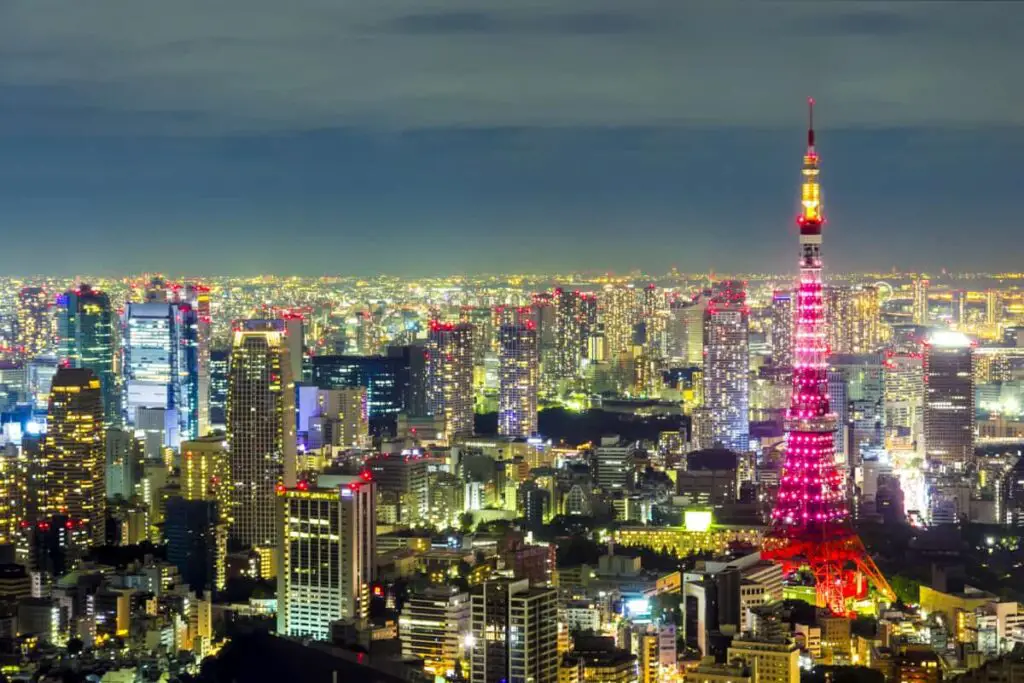
Finally, if your planning to travel long distances, then train travel is your best option, and comfort and speed is a good reason to opt for the shinkansen if only for a single trip between cities.
Flights can vary greatly depending on your home country, so remember to use sites that can search for great deals on flights, such as Kayak or Flight Hacker, which will charge a small commission to save more.
Latest Posts

Kyoto’s Autumnal Wonders: 25 Must-Visit Spots for Every Tourist

Tokyo on the Move: A Comprehensive Guide to the City’s Transport Tapestry

“Celebrating Sakura: Your Essential Guide to Japan in April – 25 Insider Tips for an Unforgettable Journey”

Tokyo Unveiled: The Ultimate Guide to the Top 100 Must-See Attractions and Optimal Timing for an Enriching Experience
- Cities & Regions 71
- Culture & History 64
- Events & Interest 41
- Learning The Language 5
- Pro Travel Tips 51
- Uncategorized 469
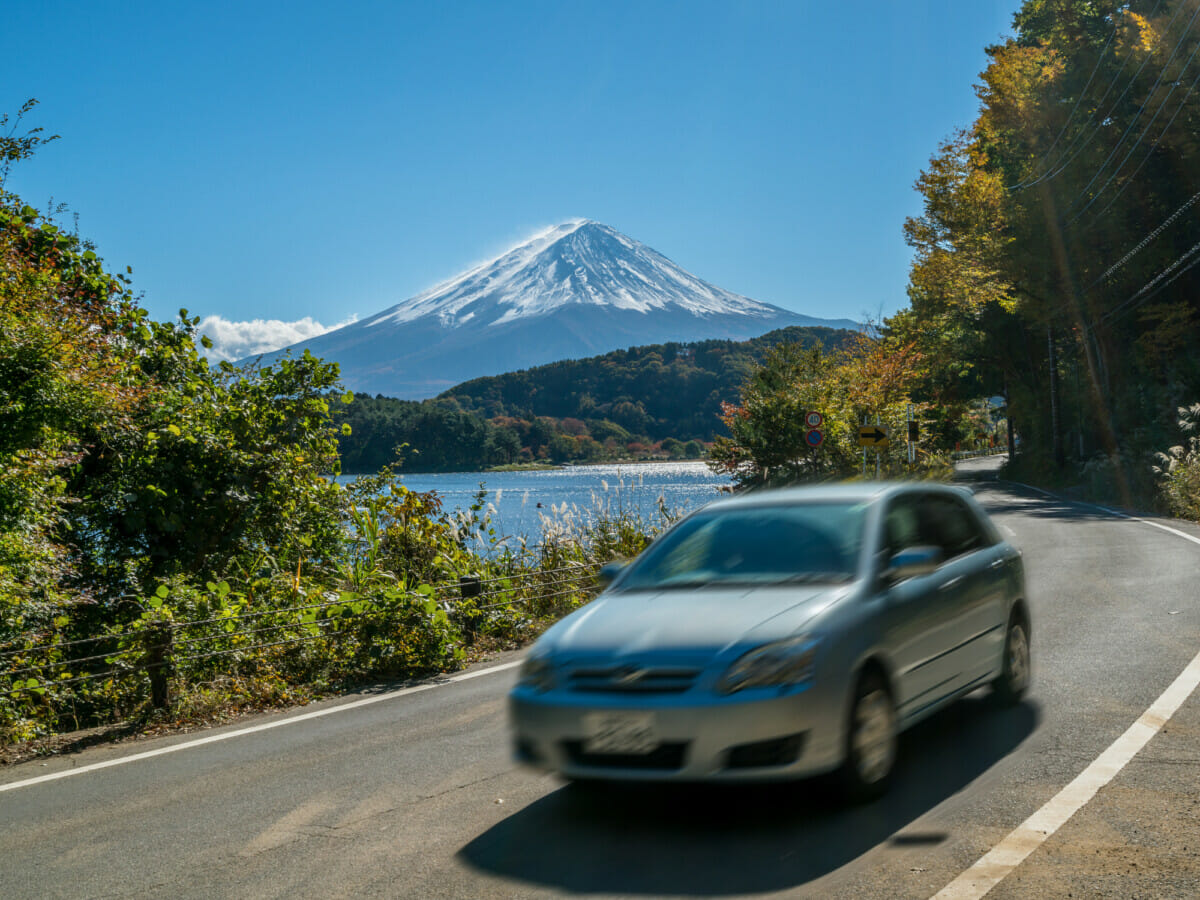
How to Get an International Driver’s License in Japan
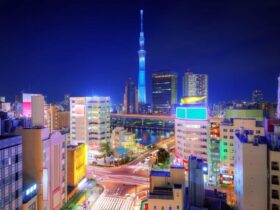
Tokyo Unveiled: The 100 Most Asked Questions


Japan Travel Budget: How Much Does It Cost To Travel Japan?
By: Author Lotte
Posted on Last updated: December 28, 2022
Categories Japan

Have you always dreamed about visiting Japan but are you worried about the costs? I spent two months in Japan and can say from personal experience: you can travel around Japan on a budget!
Yes, compared to Southeast Asia , Japan is an expensive country. But with some research and careful planning, it's possible to find great deals and travel on a budget in Japan.
In this post, you will find a full Japan budget breakdown and clever budget-saving tips in order to make the most of your money in the country of the rising sun. Let's get started !
Japan travel budget
Disclosure: Some links in this post are affiliate links. If you make a purchase through one of these links, we may earn a small commission (at no extra cost to you!). We're very grateful when you use our links to make a purchase:-).
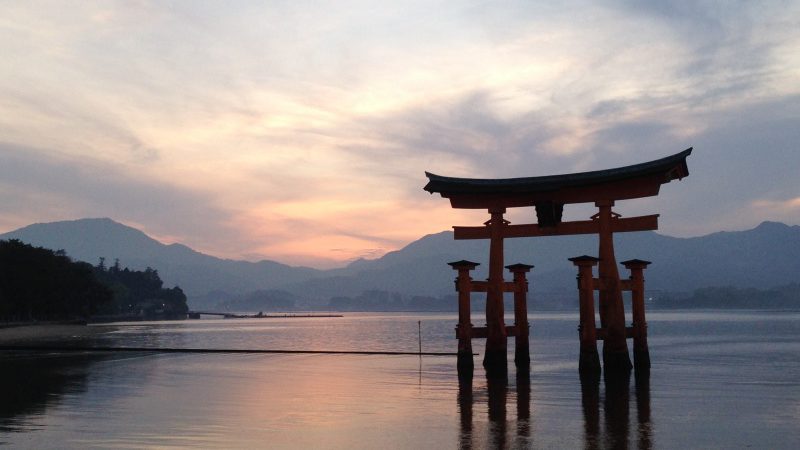
How to travel Japan on a budget
In the infographic below you can find a detailed budget breakdown of our Japan trip costs to give you a quick overview of how much you can expect to spend during your trip to Japan.
Of course, the amount you'll spend depends on your style of travel, the length of your trip, and the type of accommodation you choose.
Generally speaking, you can travel around Japan on a budget of $60-$120 per day (per person). As you can see in the infographic, our Japan daily budget was ¥13.418 (€107/$122) as a couple.
Read the post for detailed information about the costs of a trip to Japan, exactly how much we spent on accommodation, food, transport, and activities, and practical tips on how to travel to Japan on a budget.

Japan budget travel: important facts and figures
I traveled around Japan with my husband , and all expenses mentioned are for the two of us together.
I quote prices in Japanese Yen (¥) as well as Euros ( € ) and US Dollars ( $ ). When we were in Japan, €1 was around 125JPY and $1 was around 110JPY , you can find the current exchange rates here .
I spent almost a full month in Japan, 29 days to be exact. In total, we spent ¥389.122 (€3103/$3538) , which comes down to an average of ¥13.418 (€107/$122) a day for us as a couple. This includes all our Japan travel costs (see note below car section).
It does not include our airplane tickets from the Netherlands to Japan and back home.
My trip started and ended in Tokyo .
We spent 10 days on Hokkaido (the northernmost island of Japan) and the other 19 days on Honshu .

How to save money when planning a trip to Japan
When planning your Japan trip, it's important to plan carefully, look for discounts, and be flexible with your itinerary to make the most of your travel budget for Japan.
Avoid high season (travel during the low season instead)
Start by researching the best time of year to visit Japan as flight costs, hotel prices, and car rental fees vary throughout the year. Japan actually has two peak seasons:
- Sakura or hanami (cherry blossom season) : early March until mid-May
- Koyo (autumn leaves season) : early October until late November
While these are generally the best times to visit Japan, accommodation prices are at their highest.
So if you have the option to be flexible with your travel dates and able to travel during the low season (winter and summer), this is a great way to save money on your Japan trip.
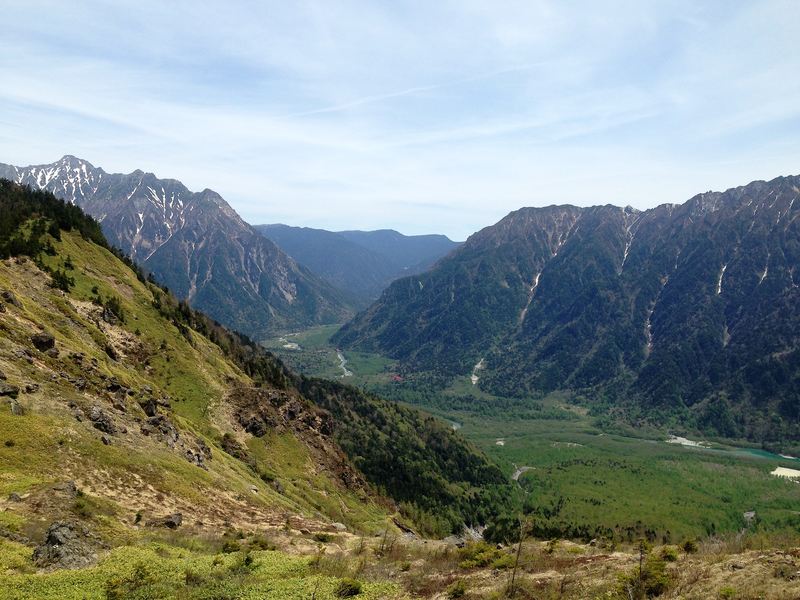
Save money on flights
You can save a lot of money by searching for cheap flights to Japan on websites like Kiwi.com . Try different travel dates and see how this affects the price of your flight.
Generally speaking, the cheapest days to fly are Tuesday, Wednesday, and Saturday. Airlines often offer discounted fares on these days, so it's worth checking the booking sites and comparing prices on different days of the week.
You’ll get a better deal by booking your flight in advance. For domestic flights 1-3 months before your trip is ideal.
For international flights, it’s best to book 2-8 months in advance. Tickets to Tokyo (Narita International Airport and Tokyo Haneda International Airport) and Osaka (Kansai International Airport) are usually the cheapest options, but keep an eye open for tickets to Fukuoka Airport as well.
Lastly, you may be able to find cheaper flights if you're willing to be flexible with your departure and arrival times.
Sure, it’s not ideal to arrive in the middle of the night, but if it saves you hundreds of dollars it’s worth losing one night of good sleep.
✈️ Click here to find a great deal on a flight

Book your accommodation in advance
Once you've got your flights booked, it’s time to research budget accommodation.
Not to worry, there are lots of budget options available in Japan, from a cozy private room with traditional tatami mats to clean to futuristic capsule hotels and sleeping pods.
I always use Agoda and Booking to find the best value-for-money accommodation for our trips. I recommend checking both platforms before you book to make sure you get a good deal on hotel rooms.
Please note that Agoda includes taxes in their price whereas Booking doesn't always include this. Make sure to check this before finalizing your booking.
Also, if you want to avoid hefty ATM fees or there's a strict limit on how much cash you can withdraw per transaction, it can be better to book with Agoda as you can often pay online with your credit card (thereby reducing your need for cash).
Cost to travel Japan: average daily expenses
Now that you know some great ways to save money in the planning phase of your Japan trip, it's time for a deep dive into our Japan travel expenses. Our Japan travel costs are divided into four categories:
- Accommodation cost: 23% of our average daily costs
- Transportation costs: 39% of our average daily costs
- Food & miscellaneous costs: 34% of our average daily costs
- Activity costs: 4% of our average daily costs
1. Accommodation costs in Japan

I'll be the first to admit that finding budget hotels in Japan can be a bit tricky as the general price level in Japan is just a lot higher than in countries in Southeast Asia or Taiwan .
That being said, there are some great options available. For example, APA Hotels, Super Hotel, and Hotel Mets are budget hotel chains in Japan that offer reasonable prices for quality accommodation.
Business hotels are also a good budget option if you're looking for an economical no-frills double room. Wing International Hotels, Smile Hotels, and the Toyoko Inn are some of the most well-known names.
How much did we spend on accommodation in Japan?
In total we spent ¥92.178 (€740/$832) on accommodation, averaging ¥3179 (€25/$29) per day . The accommodation costs are split into three categories:
- Sleeping in our car (at a free parking lot)
- Hotels and apartments
Where to stay in Japan on a budget?
Here is a list of all the places we stayed during our travels around Japan.
* Read more about our stay at Cando Hotel Shimbashi here .
** Unfortunately the accommodation we stayed at in Furano during our Hokkaido trip is no longer available. While we didn't personally stay at the Shin Furano Prince hotel we did visit their spa twice during our time in Furano.
*** Several other accommodations we stayed at are no longer available (stupid C**vid ?) . I’ve done my utmost to find suitable alternatives that I'd be happy to book myself.
Note: Prices for the hotels, campgrounds, and guesthouses depend on the time of year and how far in advance you book. Click ‘book here’ to see the latest prices on Booking and book ahead to get the best deal.
#1. Japan budget tip: stay at campsites
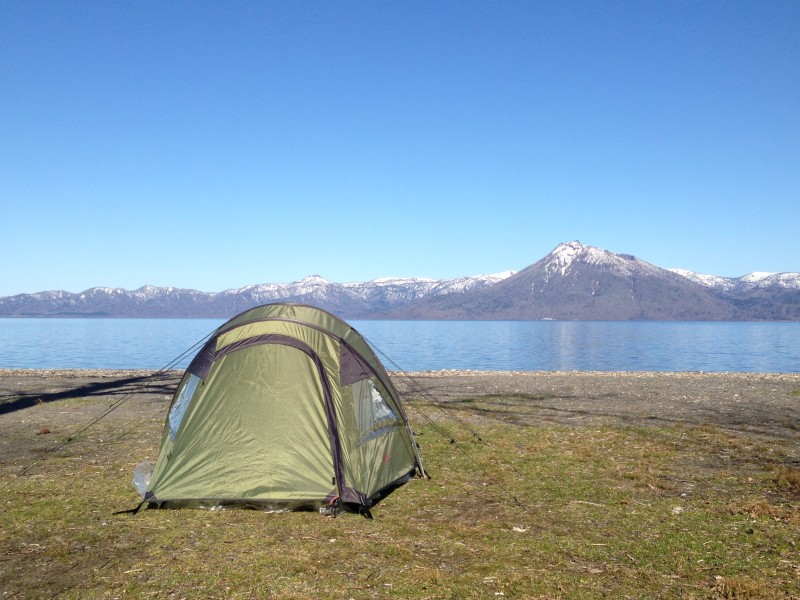
Camping in Japan is a great way to save money on accommodation. Yes, you'll have to bring camping gear but campgrounds are so much cheaper than hotels!
On Hokkaido for example, we stayed at 2 campsites and paid only between €7-13 ($8-14) per night. We also went camping on Miyajima Island and in Kamikochi (in the Japanese Alps) which saved a ton of money.
You can find more information about the accommodation and campgrounds we stayed at in our Japan itinerary .
#2. Japan budget tip: sleep in your car

I went to Japan in April/May and during that time it can still be very cold in Hokkaido. In fact, there were several nights when the temperature dipped below 0 degrees Celsius.
That's why we slept in our car for 4 nights. Which is totally acceptable in Japan! One night we found ourselves in an almost full parking lot with lots of Japanese people spending the night.
The crowd varied from a businessman who slept in his sports car to camper vans complete with their own generator and TV-reception antennae.
While this may not be the most comfortable or luxurious option, it's again a great way to cut your Japan accommodation costs.
We only did this during our first trip to Japan, when we were budget travelers and backpacking around Japan as a couple.
During our second Japan trip, we traveled as a family (with our 15-month-old son) and only stayed at hotels.
#3. Japan budget tip: book hotels in advance

We booked almost all our hotels a few months before our trip to Japan via Booking . Booking ahead and keeping an eye out for deals really helps to find affordable hotels in Japan.
For our trip, accommodation prices varied between ¥3300 (€24/$25) and ¥15000 (€110/$120) . That's a lot more than hotels in Southeast Asia but it's still cheaper than hotel prices in New Zealand .
2. Transportation costs in Japan
Let’s take a closer look at public transportation in Japan. First and foremost: public transportation in Japan is super efficient, well-managed, and very punctual.
There's no such thing as major delays in Japan (except when there's been an earthquake that severely damaged the train tracks).
There are many ways to travel around the country, such as trains, buses, taxis, and the MRT in big cities.
How much did we spend on transportation in Japan?
In total we spent ¥150.332 (€1202/$1367) on transportation, averaging ¥5185 (€42/$47) per day. Transportation costs are split into 4 categories:
- Regional flights
- JR Rail pass (regional)
Other transportation
Cheap flights in japan.
There are several budget airlines in Japan (Jetstar, Peach, and Vanilla), we flew with Jetstar from Tokyo to New Chitose Airport on Hokkaido and from Hokkaido to Kansai airport, near Osaka , for 21.625JPY (€173/$197).
Car rental fees in Japan

If you're interested in reading more about renting a car and driving on Hokkaido, be sure to read this post as well.
My car was provided by ToCoo . They were so kind as to provide me with a free rental car for my 10 day trip around Hokkaido. Even though the rental fee for my car was covered by ToCoo, there were other costs to pay which you can find in my Hokkaido post .
For us, the total costs of renting a car for 10 days were ¥42.527 , which comes down to ¥4253 (€34/$39) per day ( add the daily rental fee of the car you would like to rent and you have your total car rental cost ).
If this seems expensive, keep in mind that a car gives you the option to go camping in a tent and to sleep in your car. As mentioned above, this will save you a lot of money on accommodation!
Get a Japan Rail Pass

Upon arriving in Osaka , we bought a JR Kansai Hiroshima Area Pass which was valid for 5 consecutive days and at that time was ¥14.000 (€112/$127) per person.
This was the best JR pass for our trip because it covered all the places we wanted to see in this area.
If you plan on covering long distances in Japan within a short period of time, I highly recommend buying the Japan Rail Pass .
This pass gives you unlimited travel on all JR trains (including the famous shinkansen , aka bullet train), JR buses, and several other lines. You can choose a pass valid for 7, 14, or 21 consecutive days.
While the Japan Rail Pass offers great value for money it may not always be the most economical option for your trip. It's worth calculating the costs of your itinerary to Japan with and without the rail pass to see which option is best for you.
You can use Hyperdia to check the costs of your intended Japan itinerary and decide whether or not the JR Pass is worth the money for your trip.
Local trains are much cheaper than the shinkansen, but they're also a lot slower. So it's a bit of a trade-off between how much time and how much money you have available for your trip to Japan.
Important note: regional rail passes can be bought at most of the larger train stations, but the countrywide JR Rail Pass can only be purchased outside of Japan . If you're interested in getting a JR Rail Pass for your trip, be sure to buy one before you arrive in Japan. If a regional pass is a better option, you can wait until you've arrived. Although getting a regional JR Pass online can still be a better option, as we had to wait in line for quite a long time when purchasing our JR Kansai Hiroshima Area Pass in Osaka.

We used a lot of other transport, such as the bus around the Japanese Alps ( Kanazawa to Shirakawago ) and the metro in Tokyo. Total costs for all other transportation was ¥58.180JPY (€465/$529).
3. Cost of food in Japan

Japan is famous for its delicious cuisine! Sushi, ramen, tempura, and yakitori are some of the most popular dishes.
For a taste of traditional Japanese cuisine, try Washoku, a selection of small dishes including steamed rice, miso soup, and pickles.
If you're looking for something more modern, you can find a wide variety of international and fusion cuisine throughout Japan. Regardless, Japan is sure to have something to satisfy your taste buds!
Good news: the food in Japan is not only really tasty, but it’s also very affordable compared to eating out in Canada , Australia , and New Zealand !
That is if you eat local food at local restaurants. Eating Western Food always triples the price of dinner when traveling in Asia.
When it comes to food, stick to Japanese cuisine, browse the fresh food section in convenience stores (meals are heavily discounted at the end of the day) and take advantage of lunch specials and early bird specials that many restaurants offer.

How much did we spend on food and drinks in Japan?
In total we spent ¥130.751 (€1044/$1189) on food and some miscellaneous costs, averaging ¥4510 (€36/$41) per day.
I will say that it’s definitely possible to spend less on food, but I wanted to try out as many dishes as possible. Even so, we rarely spent more than ¥1000 on a dish.
Miscellaneous costs in Japan
Miscellaneous is comprised of small expenses like laundry, coin lockers for our luggage and towel rental, etc.
4. Cost of activities in Japan

When you’re in Japan, make sure to take advantage of all the free activities the country has to offer, like exploring temples, historic cities, National Parks, and manicured Japanese gardens.
Doing so will help you make the most of your vacation while still sticking to your budget.
When planning your Japan trip, it's also worth looking into tour companies that offer (discounted) activities that can help you save money while still getting the best experience.
Klook is the largest tour operator in Southeast Asia, but Get Your Guide has been working really hard on growing their SEA offers as well so be sure to check out those websites as well when you're planning your Japan activities.
Some of the most worthwhile tours and activities in Japan are:
- Admire the view from the Tokyo Sky Tree : visit the tallest structure in Japan and enjoy views of sprawling Tokyo City from the observation decks. Check availability .
- Visit the teamLab Planets TOKYO : explore the immersive exhibits within teamLab Planets TOKYO, a must-see attraction on any visit to Tokyo. Discover digital art installations made of lights, sounds, and different materials to delight all five senses. Check availability .
- Take a day trip to Mount Fuji : explore the Kawaguchi Lakeiscover Mount Fuji, one of the world’s most famous mountains and a UNESCO World Heritage Site. Check availability .
- Take part in a traditional tea ceremony in Kyoto : experience the true art of tea drinking by taking part in this tea ceremony at Jotokuji temple. Learn about the ancient ritual of tea drinking, and its social significance to Japanese culture and sample various different teas. Check availability .
- Take a tour around Hiroshima and Miyajima : learn about Hiroshima’s dark history and prosperous present at sites like the Peace Park and A-Bomb Dome. Travel to nearby Miyajima Island, a naturally and culturally beautiful spot with its own fascinating history. Check availability .

How much did we spend on activities in Japan?
We spent ¥15.834 (€116/$145) on paid activities, which comes down to an average of ¥546 JPY (€4/$5) per day.
We did a lot of sightseeing in the major cities ( Tokyo , Kyoto , Hiroshima , and Nara) and a lot of hiking in the mountains ( Koyasan , Hokkaido , and Kamikochi).
Travel insurance costs
I didn't include the cost of travel insurance in our Japan budget breakdown because we use our travel insurance for all our trips, not just for our Japan itinerary.
However, that doesn't take away the fact that making sure you have proper travel insurance is super important .
It helps protect you and your belongings in the event of a mishap during your travels. Furthermore, it provides coverage for medical expenses, trip cancellation, lost or stolen items, and more.
Also, having good travel insurance will provide you peace of mind, knowing that if something goes wrong, you have a safety net in place.
With so much to consider when planning a trip, having the right travel insurance can help ensure a smooth and enjoyable journey without stressing out about things that can go wrong.
Plan your Japan trip like a pro with these tools: ✅ Get a Japan Railpass to save lots of time and money. ✅ Rent a car for your Japan road trip via Rentalcars.com . ✅ Stay connected with Airalo Japan offer . ✅ Plan your journey with the Japan Lonely Planet . ✅ Find the best hotel deals on Booking.com . ✅ Join the best tours in Japan via Klook . ✅ Travel safely and get reliable travel insurance from Safety Wing .
Our Japan expenses: in conclusion
I hope my budget breakdown gives some insight into the travel budget needed for Japan. While Japan might not be the cheapest country, it has so much to offer …
Within just one month I went from hiking in the snow on Hokkaido to climbing to the top of Mount Misen while it was 30 degrees Celsius at Miyajima island.
I scaled a volcano, camped on the shore of the most gorgeous lake, walked under the vermilion Shinto gates in Kyoto, and gawked at the neon galore in Tokyo’s Akihabara.
I loved my month in Japan and I'm sure you will too, it's worth every ¥!
Read my other posts about Japan for more Japan travel inspiration!
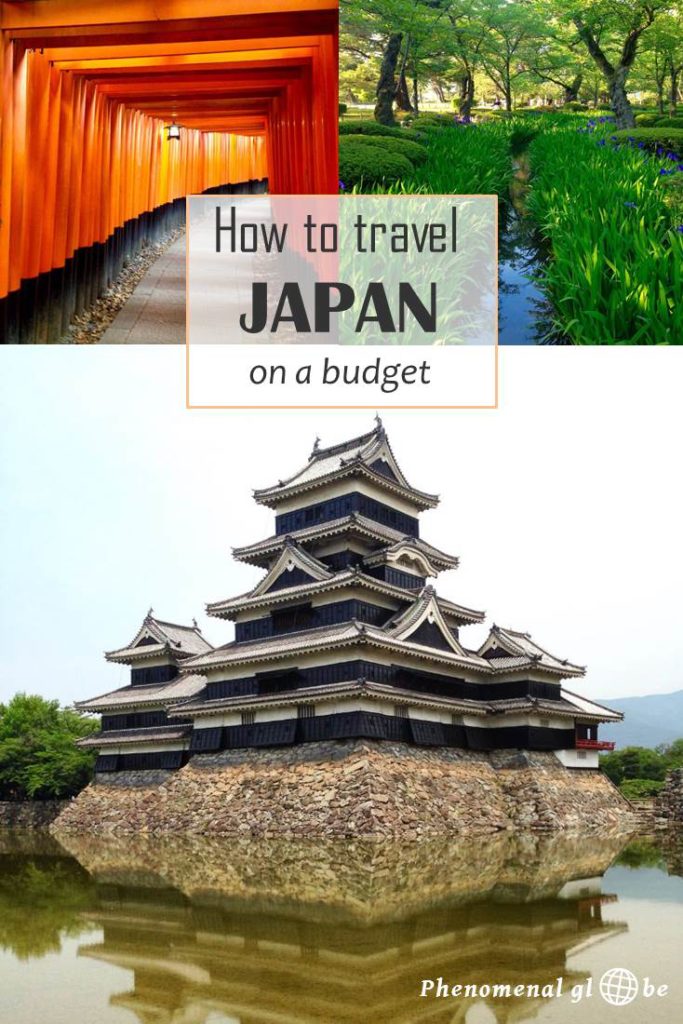
This post was updated in July 2021.
Laura Velasquez
Thursday 11th of October 2018
Thank you for all that information, is very useful. I have a question: I will be going by myself but I don't have a driver license. Do you think is possible to move entirely by public transport? Thank you,
Saturday 13th of October 2018
Thank you for reading:-) To answer your question, yes, it's very possible to travel entirely by public transport. The most 'difficult' place to navigate without a car is Hokkaido but there are trains and buses there as well so you shouldn't have any issues. We also just traveled by public transport on Honshu and it was very easy to do so. Have a great trip!
Sunday 7th of October 2018
Interesting reading your blog! I'm arriving in Manila October 26, the day before my birthday. Then on 27 planning on arriving in Tokyo so looking at cost effective accommodation for myself. Could you recommend anything?
Thanks for reading:-) Congrats on your birthday! We stayed at a lovely Airbnb in Tokyo, you can find the place here: https://www.airbnb.nl/rooms/8933904. If you have never stayed with Airbnb before you can get a discount with this link: https://www.airbnb.nl/c/leschbach?currency=EUR. Enjoy your trip!
Sunday 5th of August 2018
Hi Lotte, Just read through all your posts on Hokkaido, as hubby and I are heading over there for 2 weeks in October. You are a treasure trove of useful info, so already a BIG thanx! We want to start with Daisetsuzan Nat.Park and I was wondering about three things: 1. Is it too far to drive on the first day after we pick up the rental car from the New Chitose airport? 2. How many nights of accomodation to book to have a nice hiking time around the park? 3. Which base to choose: Sounkyo, Tokachi-dake or Adahidake Onsen? Any advice? Best wishes from sunny Poland! Gosia
Thursday 9th of August 2018
Hello Gosia,
Thank you for reading my blog and very exciting you'll be visiting Hokkaido in October! I'm not sure about the weather in that month but I think it can already be rather cold and perhaps there will be snow on the mountains, so be prepared and bring warm clothes! About your questions:
1. That depends on the time you land. If you arrive in the morning it could be done, but you would have to drive on the toll highways and may end up driving until darkness (I'm not sure what time it gets dark in October, be sure to check that before your trip;-) 2. We only did 1 short hike because there was still a lot of snow on the mountain and all the hiking trails were still closed. It's very possible there is snow on the trails in October so I find it a little bit difficult to answer this question... If you arrive late in the evening I would stay 2 nights so you have one full day plus, depending on your next destination, the next morning to go hiking. But again, trails may already be closed... 3. Adahidake Onsen is tiny (basically only hotels), Sounkyo is a bit bigger and has several restaurants so perhaps that would be a better base. I haven't been to Tokachi-dake so I don't know if that would be a suitable place to base yourself, sorry!
I hope this helps! Enjoy your trip and feel free to ask any other questions you may have:-) Lotte
Friday 9th of March 2018
Hello! Is ¥60,000 sufficient for 5 days daily budget for 1 person excluding the airfare and accommodation? Thanks!
Saturday 10th of March 2018
Hey Berna, well it always depends on your travel style. Do you plan to buy a rail-pass? Will you join a tours? How much do you plan to spend on food (Wagyu beef everyday may be delicious but will leave a serious dent in your budget;-). In general I would say ¥60,000 should definitely be enough, but it depends on your plans. Enjoy your trip! Lotte
Saturday 3rd of March 2018
Thanks for the info. Be heading to Tokyo today and looking forward to it. Gonna read some other posts of you as well!
Hi Evelyn, you are most welcome, have a great time in Tokyo!
Trip to Japan Calculator
Every traveler has a different budget and situation. Our calculator takes all possibilities into consideration for a quick trip or a long vacation in Japan.
1) Length of Stay
2) Number of Travelers
3) Choose City(s) you want to Visit:
4) How do you want to travel between cities?
Bullet Train Airplane Normal Train Highway Bus
5) What accommodations do you (and or your fellow travelers) want?
Doya ($10 a night) Youth Hostel ($30 a night) Capsule Hotel ($30 a night) Love Hotel ($50 a night) Ryokan ($60 a night) Standard Hotel ($80 a night) Luxury Hotel ($150 a night)
6) How do you (and or your fellow travelers) want to eat?
Instant Ramen and McDonalds ($3 per meal) Japanese Fast Food or Street Food ($6 per meal) Standard dining and standard restaurants ($10 per meal) Gourmet ($25 per meal)
7) How much sight seeing do you (and or your fellow travelers) want to do? (This includes taxi/subway/train fair, admission fees, and other expenses associated)
Minimal (occasional excursions within a mile of the hotel) Moderate (daily excursions in the city) Frequent (daily excursions in and outside the city) Extensive (only sleeping at the hotel, spending most of the time sight seeing)
8) How much shopping do you (and or your fellow travelers each) want to do?
None Minimal ($500 US) Moderate ($1000 US) Excessive ($2000+ US)
9) What time of the year will you go? (Spring and Summer are the most expensive times to go. Winter and Fall are the cheapest)
Winter Spring Summer Fall

Don't Study Japanese
Until You've Read Our Free E-Book
Japanese is hard enough already, don't make it harder on yourself by making these same six mistakes over and over! Read our free e-book and get an edge.
Find out how to speed up your study, get motivated, study the right way, and be less confused!

- Philippines
- South Korea
- National Parks
- Travel Stories
- How Much Does It Actually Cost to Travel the World?
- What’s In My Backpack: The Ultimate Long-Term Travel Packing List
- My Favorite Non-Fiction Travel Books
- All Budget Travel Resources
- Writing Portfolio
15 Tips For Visiting Japan on A Budget (How to Travel Cheap in Japan!)
This post may contain affiliate links. This just means I may receive a small commission at no extra cost to you for helping them promote their product or service. I don’t endorse any services I don’t personally use or recommend.
Japan is widely known as the most expensive destination in Asia. I’m not going to contest that fact, but I am going to show you how to save LOTS of money on your next trip. Because Japan is one of those places that everyone wants to visit. A bucketlist destination if you will. While it wasn’t cheap, it was also not nearly as expensive as we had originally thought. And with these tips for visiting Japan on a budget, it can even be a rather affordable destination open to exploration by all kinds of travelers.
This list isn’t going to include any Workaway or long-term travel tips for those staying months in the country. Instead, it’s going to focus on actionable easy budget-saving tips that people on a short trip can use to save bigtime in Japan.
15 Tips For Visiting Japan On a Budget
Transportation is by far the most expensive cost for travelers in Japan. We’re gonna start with ways that you can save while hopping from destination to destination in the country.
1. The big question: Japan Rail Pass or no Japan Rail Pass?
I actually wrote an entire post detailing my decision NOT to buy the Japan Rail Pass for $370 per person. The low-down is that we saved about $100 each by purchasing bullet train tickets on our own. We didn’t have to do an immense amount of research either. We just turned up and bought tickets.

Check out my full post to see everywhere we went so you can compare your itinerary and make sure that buying the Japan Rail Pass isn’t right for you.
2. Get Unreserved Train Seats.
When you’re purchasing your Shinkansen (Bullet Train) tickets be sure to specify that you want unreserved seats. This means you’ll be sitting somewhere in cars 1-6 and left to choose your own spot. These are much cheaper. If you’re traveling as a duo you’ll most likely still be able to find seats next to one another.
3. Choose buses.
Buses are cheaper than trains & astronomically cheaper than bullet trains. If time isn’t a constraint for you (or if you can plan for these travel days) choose at least a few buses to save hundreds of dollars.
4. USE the Metro!
I probably don’t need to tell you that Japan has impressively clean, well-connected metro and train lines in each major city so you’ll never need to use a taxi. You can reach every single destination by metro, bus, or walking. I promise. In slightly smaller cities biking is a great way to get around and is very popular among Japanese people.
Keep in mind that most metro stations (and all buses) require cash to purchase tickets.
5. Skip the SIM.
Everyone told us you need a SIM card to travel in Japan. But honestly, we found Japan super easy to travel without one. There’s free wifi everywhere (buses, trains, some towns) and maps.me has accurate metro info for offline use. All kiosks for restaurants and metro use had English language options and for the few menus that didn’t— use can download Google translate offline.
6. Book your accommodation ahead of time.

Budget-friendly places fill up first. Unfortunately, Japan is one of those countries where planning ahead is going to save you lots of money. Our guesthouses and hostels were all booked on Booking.com and Hostelworld.com for anywhere from $7.50-$23 per person. Hakone and the areas around Mt Fuji are the most expensive regions while Osaka had a $15 private room (not a great one but hey, what can you expect).
You’ll probably need to book at least a month ahead for the high season.
7. Where you stay in Tokyo matters.
Tokyo is huge. Sprawling. But luckily there are lots of interconnected metros including one circular JR line that rings the best part of the city. We stayed in Nippori. This is in the far northeastern part of the city. Most of the places we wanted to see were located in the West and Southwest. This meant lots of metro trips, most 40 minutes or more.
If you plan to stay less than 4-5 days in Tokyo, instead of simply choosing the cheapest place to stay, look for a conveniently located neighborhood. Otherwise, you’ll spend a lot of time and money on the metro.
Consider the 24-hour Tokyo Pass (cost: 800 yen) on days you’ll do LOTS of sightseeing in various neighborhoods. You can purchase it at all the major metro stations.
8. Don’t visit ANYWHERE on a weekend.
Obviously, you have to do something on a weekend. Make sure it’s Tokyo, Osaka, or another major city. Tourist cities like Hiroshima, Kyoto, Magome, Hakone, and more are absolutely flooded with local tourists. I mean A LOT of tourists. It’s kind of insane. You’ll have to wait in incredible lines. Plan accordingly.
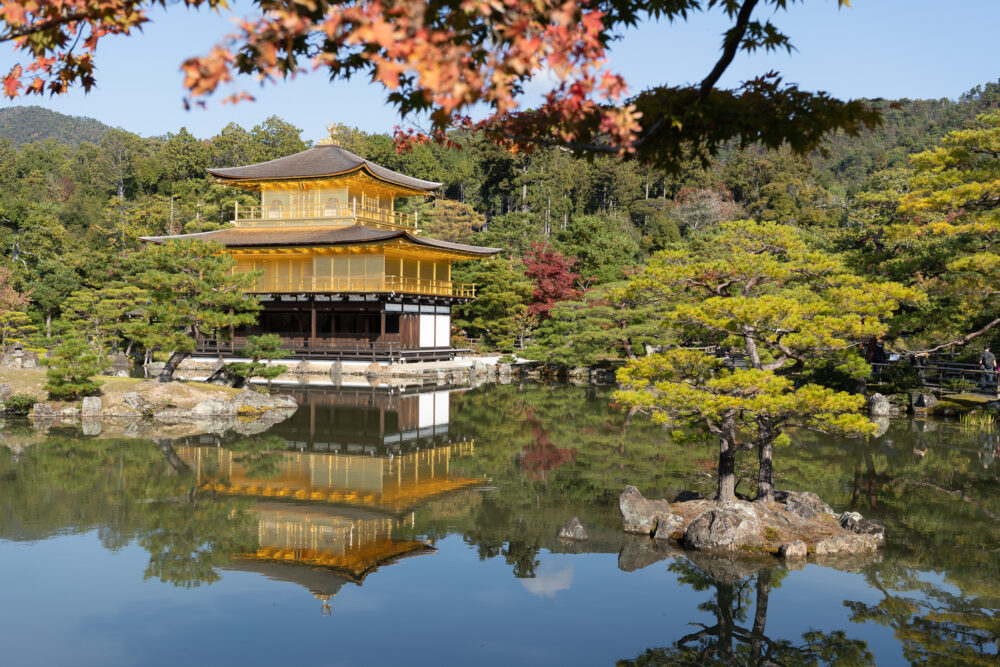
9. Kyoto is all about picking and choosing.
To keep Kyoto budget-friendly you can’t see everything. Many Buddhist temples in the city charge an $8-$15 entrance fee. This is probably to combat overtourism in an area that sees an incredible amount of visitors. We found that the free shrines were often the best because they saw fewer people and it wasn’t just massive crowds jostling for a photo op. Shoren-in Temple even has a tea ceremony that’s authentic for half the price of typical touristy tea ceremonies. I wrote about how to attend it here.
I recommend making a list of a few attractions and sticking to those rather than trying to see everything. These are our favorite things in Kyoto.
- Bike to the Bamboo forest just out of town early in the morning.
- Hike to the top of Fushimi Inari Taisha, not just a quick photo op visit.

If you’re looking to splurge on food in Kyoto, and it’s got some excellent options, definitely pay Teppan Tavern and La Bac a Sable a visit. Teppan Tavern serves Wagyu A5, traditional Kyoto bites, and homemade Umeshu (plum wine) that’s better than anywhere else for dinner. Seriously, this is the highlight of Japanese hospitality and it won’t break the bank. We spent $40 on a full meal with a few drinks. The French bakery is the perfect lunch pick-me-up.
10. 7/11, Family Mart, and Lawsons.
These are convenience stores scattered all over Japan. They have the cheapest beer and chu-hi, the cheapest coffee, and a wide array of Japanese snacks and desserts. But the best part is the bento boxes and hot food. You might be put off by the sushi, pizza or curry stuffed bao, habanero chicken strips, and tonkatsu meals but they are actually excellent and good quality! It’s a very popular stop for commuting Japanese residents. Keep in mind that hot food is usually restocked just before popular meal times.

In my professional opinion, the best food goes to Family Mart— but the best coffee goes to Lawsons.
Most restaurants don’t open until 10-11 AM and few hostels offer breakfast which leaves you out of luck. But these stores are a great cheap option for breakfast. Or late night meal. Or lunch.
11. Another cheap meal option? Conveyor belt sushi.
These places are the best. And they happen to be the most budget-friendly restaurants for great traditional Japanese sushi. You can typically get 10 plates between $8-15 depending on the items you select. This is a great way to familiarize yourself with sushi menus and sample new things too without having to commit to a whole set.

12. Share meals!
Unlike South Korea , a country we visited just before Japan, it’s very easy to order one dish and share. In Korea, you often pay by the person for popular meals like Korean BBQ. A major pain in the wallet for budget travelers looking to sample a lot of different items. Japan, fortunately, does not follow this rule and it’s quite easy to share several small plates for cheap.
13. Buy food for your Magome excursion.
I wrote an entire post detailing everything you need to know about hiking from Magome to Tsumago. I highly recommend this trip but since all restaurants close by 5 PM and I found most to be overpriced in the area— be sure to buy your own food from a Family Mart before you head to the mountains. Don’t forget trail snacks!
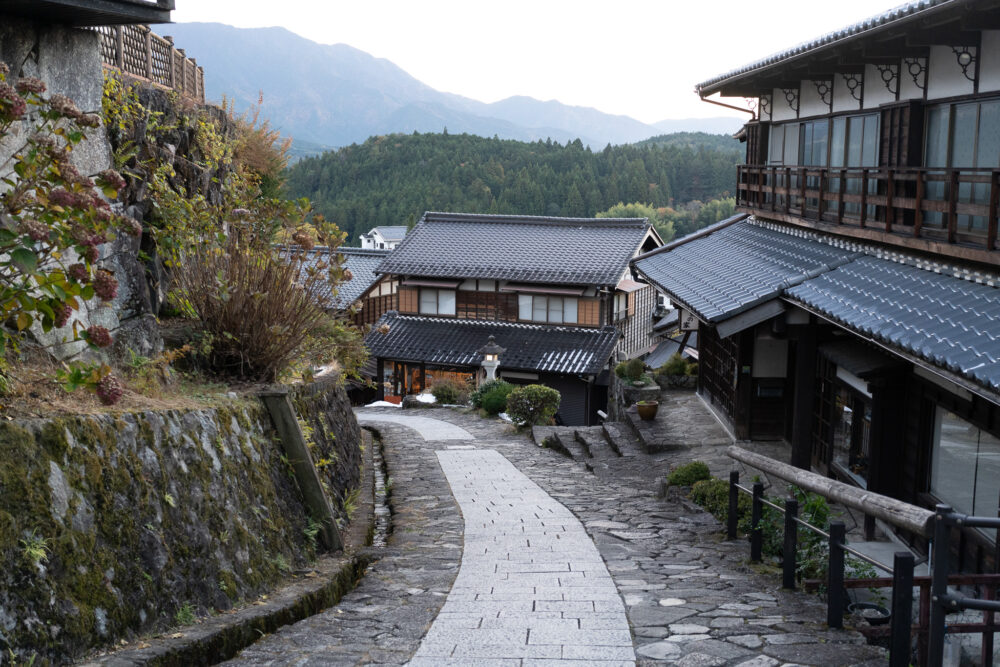
14. Beer is the most expensive alcohol in Japan.
Skip the beer and instead opt for Japanese Whisky highballs, Plum Wine, Shochu, and sake for cheaper drinking options.
15. Choose Omoide Yokocho over Golden Gai for a night out.
If you are looking for Tokyo drinking hot spots and nightlife, Omoide Yokocho is cheaper and more authentic than the late-night Golden Gai district. In Golden Gai, the drinks aren’t as strong and you’ll often have to pay a cover to even sit at the bar. It was still worth wandering through the alleys of each but I much preferred Omoide for dinner and a night of drinking.

How much did we spend in Japan on a Budget?
Let’s look at a quick budget breakdown of what we spent while visiting the country. Keep in mind, we only took trains and bullet trains because we had a short amount of time. We also didn’t know many of the above tips beforehand and would have booked our Magome accommodation much further in advance. So basically, I think you could save hundreds by following our tips above.
How much we spent in total for 19 days for two people: $2,687.55
How much we spent per day per person: $70.72 per day per person!!!
I hope this information helps you feel more confident to visit Japan on a budget and save lots of money while you do so! This was our most expensive trip BY FAR and with these tips, we could have easily cut costs by hundreds of dollars. Let me know in the comments if you think you have any Japan budget travel tips to add to my list.
Save This Post For Later!
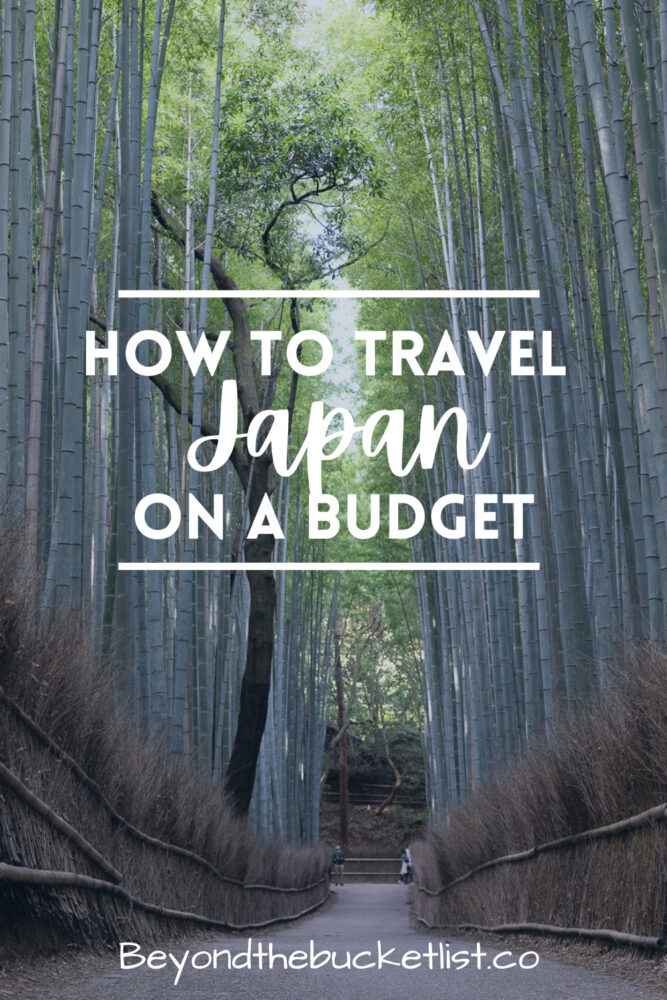
Further Reading...

How To Avoid Getting Scammed in Southeast Asia

The Nakasendo Trail: How to Hike Magome to Tsumago

5 Savvy Money-Saving Tips to Save You Hundreds Abroad
You suggested to hike to the top of Fushimi Inari Taisha. While I agree hiking up is really cool, I was underwhelmed because there really aren’t any great views so doing the entire top loop felt a waste. I did it at night which was totally cool, but eerie. You could hear but not see the monkeys in the trees.
Leave a Reply Cancel Reply
Save my name, email, and website in this browser for the next time I comment.
Notify me of new posts by email.
Sign up to our newsletter!
This site uses Akismet to reduce spam. Learn how your comment data is processed .
10 Days in South Korea: A Mini Travel Guide (2023)
How to experience a traditional japanese tea ceremony in kyoto, beyond_the_bucketlist.

The Ultimate Guide To Paying For Your Expenses While Traveling In Japan
- Last updated May 15, 2024
- Difficulty Beginner
- Category Travel

Are you planning a trip to Japan but worried about how to cover your expenses while exploring this beautiful country? Look no further! In this ultimate guide, we will provide you with a plethora of tips and tricks on how to pay for your expenses while traveling in Japan. From currency exchange to cashless payments and even cultural norms surrounding tipping, we have got you covered. So, sit back, relax, and let us guide you through the ins and outs of navigating the Japanese financial landscape.
What You'll Learn
Cash is king: understanding the importance of cash in japan, preparing your payment options: tips for using credit cards in japan, convenient alternatives: exploring mobile payment apps and digital wallets, exchange rates and atms: tips for managing currency exchange and atm withdrawals.

When traveling in Japan, one thing that you need to keep in mind is that cash is king. Even with the advances in technology and the widespread use of credit cards in many parts of the world, Japan is still a largely cash-based society.
While it's true that some places in Japan do accept credit cards, especially in larger cities and touristy areas, you shouldn't rely solely on your plastic. Many smaller establishments, such as local restaurants, street food stalls, and traditional markets, only accept cash. In fact, even some larger retailers and department stores may not accept credit cards, especially for smaller purchases.
So, how do you ensure that you have enough cash to pay for your expenses while traveling in Japan? Here are a few tips to help you navigate Japan's cash-dominated society:
- Exchange Currency Before Your Trip: It's always a good idea to exchange some of your home currency for Japanese yen before you travel. This way, you'll have cash on hand when you arrive in Japan. You can do this at your local bank, currency exchange counters at airports, or even online currency exchange services.
- Use ATMs: Japan has a good network of ATMs, especially in major cities. Look for ATMs at convenience stores, post offices, and train stations. Most ATMs in Japan accept international credit and debit cards, so you can withdraw cash directly from your foreign bank account. Keep in mind that some ATMs may have certain restrictions, such as limited operating hours or a maximum withdrawal limit per transaction.
- Notify Your Bank: Before you travel to Japan, inform your bank or credit card company about your trip. This will help prevent your transactions from being flagged as suspicious when you use your card abroad. Additionally, check if your bank charges any foreign transaction fees or ATM withdrawal fees. It's a good practice to have a mix of payment options, but be prepared for these fees if you rely heavily on your cards.
- Carry Enough Cash: Since many places in Japan only accept cash, it's important to carry enough yen with you. While it's generally safe to carry cash in Japan, it's advisable to keep smaller denominations to make purchases more convenient. Consider having a small coin purse or wallet to separate larger bills from small change. Keep the larger bills separate in a more secure location, such as a hidden compartment of your bag or a money belt.
- Plan Your Budget: Before your trip, estimate your daily expenses and set a budget for each day. This will help you calculate how much cash you need to carry. It's always better to have a little extra cash than to run out during your trip.
- Consider Purchasing a Suica or Pasmo Card: If you're planning to use public transportation frequently, consider getting a Suica or Pasmo card. These prepaid smart cards can be used for train, bus, and subway fares in many major cities in Japan. While they do require an initial deposit, you can easily top up the card's balance at any ticket machine or convenience store. This can save you the hassle of always needing exact change for transportation.
In conclusion, understanding the importance of cash in Japan is crucial for a smooth and hassle-free trip. While credit cards may be convenient in many parts of the world, having enough yen on hand will ensure that you can pay for your expenses anywhere in Japan. So, plan ahead, carry cash, and enjoy your trip to this beautiful and culturally rich country.
Considering Currency: Should You Exchange Money Before Traveling to Israel?
You may want to see also
Planning to travel to Japan? One important aspect to consider is how to pay for your expenses while you're there. While cash is widely accepted, credit cards are becoming more common in Japan. However, there are a few things you should know to ensure a smooth and hassle-free payment experience. Here are some tips for using credit cards in Japan:
Choose the right credit card:
Before you leave for Japan, it's important to check if your credit card is widely accepted in the country. Visa and Mastercard are generally accepted at most stores and restaurants, while American Express and Discover cards may have more limited acceptance. It's a good idea to have at least two credit cards with you, as a backup option in case one doesn't work.
Inform your credit card company:
To avoid any issues, it's recommended to inform your credit card company about your travel plans in advance. This way, they can mark your account to prevent any potential fraud alerts and ensure that your card will work while you're in Japan. You can usually do this online or by calling the customer service number on the back of your card.
Check your credit card's fees:
It's essential to be aware of any fees associated with using your credit card abroad. Some cards charge foreign transaction fees, which can add up quickly, especially if you're making frequent purchases. Additionally, it's important to know the exchange rate that will be applied by your credit card company. In some cases, it may be more advantageous to pay in the local currency rather than in your home currency.
Look for credit card acceptance signs:
While credit cards are becoming more common in Japan, not all places accept them. Look for signs that indicate credit cards are accepted, such as the logos of Visa or Mastercard displayed at store entrances or near the cash register. It's helpful to have a backup plan in case you come across a place that only accepts cash, especially in more remote areas or smaller establishments.
Use ATMs for cash withdrawals:
Even though credit cards are accepted in many places, it's still a good idea to have some cash on hand for smaller expenses or places that only accept cash. In Japan, you can typically withdraw cash from ATMs with your credit card or debit card. Look for ATMs that display the logos of international payment networks, such as Plus or Cirrus, as these are more likely to accept foreign cards. Convenience stores, such as 7-Eleven or FamilyMart, also have ATMs that accept foreign cards.
Consider getting a prepaid card:
If you prefer not to use your credit card for all your expenses, you can consider getting a prepaid card. These are reloadable cards that you can top up with cash at convenience stores or train stations. Pasmo and Suica are two of the most popular prepaid cards in Japan and can be used for transportation, as well as at many shops and vending machines.
Keep your credit card secure:
As with any international travel, it's important to keep your credit card secure while you're in Japan. Be cautious when making transactions, especially in crowded areas, to protect your card information from potential skimming devices. Keep your card in a secure place, such as a wallet with RFID blocking technology, and regularly check your credit card statements for any unauthorized charges.
By following these tips, you'll be well prepared to use your credit cards in Japan. Remember to choose the right credit card, inform your credit card company about your travel plans, be aware of fees, look for acceptance signs, use ATMs for cash withdrawals, consider a prepaid card, and keep your credit card secure. Enjoy your trip to Japan with the convenience and ease of credit card payments!
Exploring the UK: Tips for Traveling Outside London with a Baby
When traveling in Japan, it's important to have convenient and secure options for paying for your purchases. While cash is widely accepted, many visitors prefer using mobile payment apps and digital wallets for their convenience and ease of use. Here are some convenient alternatives to consider:
Suica card:
Suica is a popular prepaid card that can be used for various transportation systems, as well as at many convenience stores, vending machines, and even some restaurants. Simply load money onto the card and tap it on the payment terminal to pay. Suica cards can be purchased and reloaded at train stations, convenience stores, and online.
Pasmo card:
Pasmo is another prepaid card similar to Suica, accepted on most transportation systems in Tokyo and other major cities. It can also be used for purchases at stores and vending machines where Suica is accepted. Pasmo cards can be purchased at train stations and recharged at convenience stores.
If you have an iPhone or an Apple Watch, Apple Pay is a convenient option for making payments. Simply add your credit or debit card to the Wallet app and use your device to tap on the payment terminal. Apple Pay is widely accepted in Japan, especially at major retailers and restaurants.
Google Pay:
For Android users, Google Pay offers a similar digital wallet experience. Add your credit or debit card to the Google Pay app and use your device to make payments by tapping on the payment terminal. Google Pay is widely accepted in Japan, including at many convenience stores and restaurants.
LINE Pay is a popular mobile payment app in Japan, integrated with the LINE messaging app. You can link your credit or debit card to your LINE Pay account or use it with a virtual prepaid card. LINE Pay can be used at various stores, restaurants, and online merchants in Japan.
PayPay is a mobile payment app backed by Softbank and Yahoo Japan. It offers various promotions and discounts for users. Simply link your credit or debit card to your PayPay account and use the app to make payments by scanning a QR code. PayPay is accepted at many stores and restaurants in Japan.
If you have an Alipay account from China, you can also use it to make payments in Japan. Alipay is accepted at many major retailers and restaurants, making it a convenient option for Chinese visitors.
When using mobile payment apps and digital wallets in Japan, it's important to keep your device charged and be mindful of payment limits and security settings. It's also a good idea to carry some cash as a backup, as not all stores and restaurants accept mobile payments. By using these convenient alternatives, you can enjoy a hassle-free and convenient way to pay for your purchases while traveling in Japan.
The Ultimate Guide on How to Travel from York to London
When planning a trip to Japan, it's important to think about how you will manage your money while you're there. One of the first things you'll need to consider is how to exchange your currency for Japanese yen. Additionally, you'll need to know how to access cash while you're in the country. In this guide, we'll cover some helpful tips for managing currency exchange and ATM withdrawals in Japan.
Exchange Rates:
One of the most important things to understand when exchanging currency is the exchange rate. The exchange rate determines how much of one currency you can get in exchange for another. Rates can fluctuate daily, so it's a good idea to keep an eye on the current exchange rate before you leave for your trip.
To exchange currency, you can visit a bank or a currency exchange service. It's generally best to avoid exchanging currency at airports or hotels, as they often charge higher fees and offer less favorable exchange rates. Instead, consider visiting a bank or currency exchange service in the city where you'll be staying.
ATM Withdrawals:
ATMs are widely available in Japan and can be used to withdraw cash from your bank account using your debit or credit card. However, there are a few things you should keep in mind when using ATMs in Japan.
First, not all ATMs in Japan accept foreign cards. Look for ATMs that display international card symbols, such as Visa or Mastercard, to ensure that your card will be accepted.
Second, make sure to let your bank know that you'll be using your card in Japan. Some banks may put a hold on your card if they see international transactions, so it's important to notify them in advance to avoid any issues.
Finally, be aware that many ATMs in Japan have operating hours, and some may even be closed on weekends or holidays. It's a good idea to plan ahead and withdraw enough cash to last you through periods when ATMs may not be accessible.
Alternative Payment Methods:
In addition to cash, Japan is known for its use of electronic payment methods. Many businesses, especially in larger cities, accept payment through mobile apps, such as Apple Pay or Google Pay. These apps allow you to link your credit or debit card and make payments directly from your smartphone, eliminating the need for physical cash.
Some businesses in Japan also accept international credit cards, so it's worth carrying one as a backup. However, smaller establishments or rural areas may only accept cash, so it's always a good idea to have some on hand.
Overall, managing currency exchange and ATM withdrawals in Japan can be straightforward if you plan ahead. Familiarize yourself with the current exchange rate, use ATMs that accept foreign cards, and consider alternative payment methods such as mobile apps or credit cards. By following these tips, you'll be well-prepared to handle your finances while traveling in Japan.
Does Bunny Ranch Accept Travelers Checks? Everything You Need to Know
Frequently asked questions.
There are several ways to pay for goods and services in Japan. Cash is the most widely accepted form of payment, so it's a good idea to carry some Japanese yen with you. Many ATMs in Japan accept international cards, but it's a good idea to check with your bank beforehand. Credit cards are also widely accepted, especially in larger establishments and tourist areas. Some popular credit cards in Japan include Visa, Mastercard, and American Express. Finally, mobile payment methods such as Apple Pay and Google Pay are becoming increasingly popular in Japan, so you may be able to use these options as well.
Japan is generally a safe country, but it's always a good idea to take precautions when carrying cash. It's recommended to carry a smaller amount of cash for everyday expenses and keep the rest in a secure location, such as your hotel safe. If you need to withdraw cash, it's safer to use ATMs inside a bank or a reputable convenience store rather than standalone ATMs. Additionally, it's a good practice to separate your cash into different pockets or compartments, making it less noticeable and reducing the risk of losing everything if one pocket is targeted.
While many establishments in Japan accept credit cards, it's important to note that some smaller shops, restaurants, and local establishments may only accept cash. Additionally, some places may have a minimum spending requirement for credit card transactions. As for fees and charges, it's a good idea to check with your credit card issuer before traveling to Japan. Some credit cards may charge foreign transaction fees, which can add up if you frequently use your card. It's also worth noting that dynamic currency conversion (DCC) may be offered at some establishments, but it's generally recommended to decline this service as it often results in unfavorable exchange rates.

- Lazar Odonnell Author

- Pop Panupong Author Reviewer Traveller
It is awesome. Thank you for your feedback!
We are sorry. Plesae let us know what went wrong?
We will update our content. Thank you for your feedback!
Leave a comment
Travel photos, related posts.

The Ultimate Guide to Solo Travel in San Francisco: Discover the Best Things to Do and Places to Explore
- May 08, 2024

Navigating from Phuket Airport to Ao Nang: A Complete Guide for Travelers
- May 18, 2024

Understanding When a Visa is Required for Travel to Japan

The Ultimate Guide to Understanding Trial or Travel Size Products
- May 11, 2024

The Truth About Drug Checks While Travelling on Greyhound

Exploring the Dynamics of Hostel Dorms: Are Most Solo Travelers?

Enjoy fast, free delivery, exclusive deals, and award-winning movies & TV shows with Prime Try Prime and start saving today with fast, free delivery
Amazon Prime includes:
Fast, FREE Delivery is available to Prime members. To join, select "Try Amazon Prime and start saving today with Fast, FREE Delivery" below the Add to Cart button.
- Cardmembers earn 5% Back at Amazon.com with a Prime Credit Card.
- Unlimited Free Two-Day Delivery
- Streaming of thousands of movies and TV shows with limited ads on Prime Video.
- A Kindle book to borrow for free each month - with no due dates
- Listen to over 2 million songs and hundreds of playlists
- Unlimited photo storage with anywhere access
Important: Your credit card will NOT be charged when you start your free trial or if you cancel during the trial period. If you're happy with Amazon Prime, do nothing. At the end of the free trial, your membership will automatically upgrade to a monthly membership.

Download the free Kindle app and start reading Kindle books instantly on your smartphone, tablet, or computer - no Kindle device required .
Read instantly on your browser with Kindle for Web.
Using your mobile phone camera - scan the code below and download the Kindle app.

Follow the author

Image Unavailable

- To view this video download Flash Player

Japan Travel Guide 2024: The Up-to-Date Budget-Friendly Guide & Travel Tips with Essential Maps and Photos (Second Edition) (The Complete 2024 Travel Guide) Paperback – May 16, 2024
Purchase options and add-ons, japan adventure updated 2024.
Ready for an adventure in Japan? Our beginners manual is like a magic map, filled with secrets and fun places that will make your trip super cool!
Why This Book is Your Best Travel Buddy :
- Ever felt lost about where to go in Japan? Don’t worry! We've got you covered with the best places to see and fun things to do.
- You'll find out about the coolest spots in Tokyo, Kyoto, Osaka, and even in snowy Hokkaido!
- Love food? We’ll show you where to find yummy sushi, ramen, and more.
- Want to see cool festivals and events happening in Japan? We’ve listed them all for you!
- Maps and photos? Yep, we have those too! They make finding places super easy.
- Worried about spending too much? We’ve got awesome tips to save money and still have loads of fun.
- Plus, we'll share Japan’s secret spots that not many people know about!
What’s Inside? Let’s Check it Out :
- Tokyo Tales : Discover hidden alleys, giant robots, and yummy snacks in Japan’s buzzing capital.
- Kyoto Wonders: Walk in beautiful gardens, see old temples, and maybe even spot a geisha!
- Osaka Eats: Get ready to try the best street food ever!
- Hokkaido Adventures: Play in the snow and see amazing ice sculptures.
- Okinawa’s Sunny Beaches: Build sandcastles and splash in crystal-clear water.
- Autumn Leaves and Cherry Blossoms: See Japan’s famous colorful trees!
- Easy Travel Tips: Learn how to ride bullet trains and find your way around like a pro.
- Festivals and Fun: Dance at festivals and see cool fireworks.
- Budget Tricks: Save your pocket money and still see all the cool stuff.
Come on, Let’s Go!
Grab your copy of Japan Travel Guide 2024 now and start planning your most amazing trip ever. Japan is waiting for you with lots of fun, yummy food, and cool places to explore. Let’s make your adventure in Japan the best time ever!
Get your guide today and get ready for an adventure in Japan that you’ll never forget!
- Book 1 of 2 The Complete 2024 Travel Guide
- Print length 147 pages
- Language English
- Publication date May 16, 2024
- Dimensions 6 x 0.37 x 9 inches
- ISBN-10 1803628243
- ISBN-13 978-1803628240
- See all details

From the Publisher

Product details
- Publisher : Travel Media (May 16, 2024)
- Language : English
- Paperback : 147 pages
- ISBN-10 : 1803628243
- ISBN-13 : 978-1803628240
- Item Weight : 9.9 ounces
- Dimensions : 6 x 0.37 x 9 inches
- #2 in Travel Tips (Books)
- #36 in General Japan Travel Guides
- #163 in Adventure Travel (Books)
About the author
Kaiyo takumi.
Discover more of the author’s books, see similar authors, read author blogs and more
Customer reviews
Customer Reviews, including Product Star Ratings help customers to learn more about the product and decide whether it is the right product for them.
To calculate the overall star rating and percentage breakdown by star, we don’t use a simple average. Instead, our system considers things like how recent a review is and if the reviewer bought the item on Amazon. It also analyzed reviews to verify trustworthiness.
- Sort reviews by Top reviews Most recent Top reviews
Top reviews from the United States
There was a problem filtering reviews right now. please try again later..
Top reviews from other countries
- Amazon Newsletter
- About Amazon
- Accessibility
- Sustainability
- Press Center
- Investor Relations
- Amazon Devices
- Amazon Science
- Sell on Amazon
- Sell apps on Amazon
- Supply to Amazon
- Protect & Build Your Brand
- Become an Affiliate
- Become a Delivery Driver
- Start a Package Delivery Business
- Advertise Your Products
- Self-Publish with Us
- Become an Amazon Hub Partner
- › See More Ways to Make Money
- Amazon Visa
- Amazon Store Card
- Amazon Secured Card
- Amazon Business Card
- Shop with Points
- Credit Card Marketplace
- Reload Your Balance
- Amazon Currency Converter
- Your Account
- Your Orders
- Shipping Rates & Policies
- Amazon Prime
- Returns & Replacements
- Manage Your Content and Devices
- Recalls and Product Safety Alerts
- Conditions of Use
- Privacy Notice
- Consumer Health Data Privacy Disclosure
- Your Ads Privacy Choices

10 Best Budget Hotels In Tokyo (Near JR Yamanote Line!)
T okyo is full of amazing accommodation options, from high-end luxury hotels to budget-friendly hostels/capsule hotels to quaint and homey Airbnb experiences. It’s almost too hard to settle on just one!
If you’re planning a trip to Tokyo on a budget, there’s one major money-saving tip I want to share with you that’ll help you trim down your accommodation choices.
In order to make the most of your time in this bustling city, you’ll want to stay near the JR Yamanote Line . This train line connects many of Tokyo’s most popular neighborhoods and attractions, making it easy to get around quickly and efficiently.
By staying near the Yamanote Line, you’ll save time transporting back and forth, you’ll save money on unnecessary train/bus tickets, and you’ll be able to spend more time exploring all that Tokyo has to offer!
In this post, I’ll share some of the best budget-friendly hotels along the JR Yamanote Line, so you can focus on what matters most — plan your perfect Tokyo travel itinerary !
This post may contain affiliate links. You won’t be paying a cent more, but in the event of a sale, the small affiliate commission I receive will help keep this blog running/pumping out useful and free content. Thanks a lot!
Got a bit more budget to play around with? If so, you might like some of these other hotels along the JR Yamanote line , providing the same level of convenience from the train stations but MORE space and MORE amenities!
Best Budget Hotels In Tokyo Near JR Yamanote Line
Tokyo in a nutshell.
Here’s a quick overview of all the useful info you need to plan an awesome trip!
When To Go : Spring (March to May) for cherry blossoms, Summer (June to August) for festival season, Fall (September to November) for epic fall foliage.
Where To Stay : Choose a hotel along the JR Yamanote Line for the most convenience. We’ll get into all of this in this post!
Nearest Airport : Narita International Airport (NRT) and Haneda Airport (HND). NRT is 60 kilometers (37 miles) east of Tokyo’s city center. HND is 14 kilometers (9 miles) south of Tokyo’s city center.
How to Get Around : Public transportation all the way. Don’t even think about renting a car in Tokyo! If you plan on traveling across Japan, a Japan Rail Pass can save you a lot of money on transportation. The pass allows unlimited travel on Japan Railways (JR) trains, buses, and ferries for a set period of time.
Must-Do’s : Immerse yourself in all the digital art at TeamLab Planets , feel the Disney magic at Tokyo Disneyland or DisneySea , eat a crepe in the Harajuku district , try vending machine ramen and conveyor belt sushi , spend your early jet-lagged hours at Tsukiji Fish Market .
Before You Go :
- Read up on all our tips on how to do Japan on a budget
- Consider getting the Klook Pass Tokyo — you’ll get up to 48% off your tickets to Tokyo’s popular attractions, including Tokyo Disney, teamLab Planets, Legoland, Sanrio Puroland, Shibuya Sky Deck, and more. Choose from 6+ different combinations, and add on activities based on what you like to do!
‘Hello’ and ‘Thank You’ in Japanese :
- Hello: こんにちは (Konnichiwa) or おはようございます (Ohayou gozaimasu) in the morning or こんばんは (Konbanwa) in the evening
- Thank You: ありがとうございます (Arigatou gozaimasu)
Currency : the Japanese yen (¥) – click for current conversion rates
What Is The JR Yamanote Line?
The JR Yamanote Line is a train line in Tokyo that circles around the city’s central districts. It is one of the most convenient and popular train lines for visitors to Tokyo, as it connects many of the city’s top landmarks and attractions.
For first-time visitors to Tokyo, the JR Yamanote Line is a great way to get around the city and explore its many neighborhoods and districts. The line stops at many of Tokyo’s major train stations, including Tokyo Station, Shinjuku Station, Shibuya Station, and Ueno Station, making it easy to transfer to other train lines and explore different parts of the city.
As an example, if you were to stay by Shibuya Station and wanted to go to Shinjuku (a district that you’ll definitely end up in at some point during your trip), it would take approximately 5-10 minutes on the JR Yamanote Line. Easy!
However, if you were to stay along another train line or had to bus to the nearest subway station, you’ll need to transfer to the JR Yamanote Line to get to Shinjuku. This could take considerably longer, depending on the distance between your starting station and the nearest Yamanote Line station.
Plus, that doesn’t even take into consideration the time it takes to get off your first train and transfer to your next train!
To save yourself the logistical headache of having to worry about bus/train transfers, AND to save both money and time, opt to stay at a hotel as close to a JR Yamanote Line train station as possible!
Which Tokyo Neighborhood Should You Stay In?
Before we dive into all the hotels that are along the JR Yamanote Line, you’re going to want to have a good understanding of where in Tokyo you want to base yourself.
Tokyo is a humongous city, and you’re going to find a wide variety of different districts, from bustling neighborhoods with vibrant nightlife to peaceful areas with quiet parks and temples. With so many options, it can be overwhelming to decide what area to stay in during your trip to Tokyo.
In this section, we’ll explore the top four neighborhoods we recommend to first-timers in Tokyo and explain why they’re great areas for you to stay in.
Best for: first-timers, solo travelers, couples, foodies, people who want to be in the center of all the action, shopping and nightlife
Shinjuku is one of the most popular neighborhoods in Tokyo, and for good reason. It’s known for its always-buzzing nightlife, shopping, and entertainment. Shinjuku Station is one of the busiest (and most well-connected) train stations in the world, making it easy to get around the city from here.
Among the dozens and dozens of mega department stores you can enjoy, one of the top attractions in Shinjuku is the Tokyo Metropolitan Government Building , which offers breathtaking views of the city from its observation deck. The area is also home to Shinjuku Gyoen National Garden , a beautiful park with over 20,000 trees and a traditional Japanese garden.
Foodies will love Shinjuku for its many dining options , ranging from Michelin-starred restaurants to street food stalls. The area is also home to Golden Gai , a network of narrow alleys lined with tiny bars and restaurants that offer a unique glimpse into Tokyo’s nightlife .
Shinjuku is a great neighborhood for solo travelers, people who want to be in the center of all the action, and people looking for nightlife. Families may also enjoy the area, but should be mindful of the crowds and noise.
20 Top Things To Do In Shinjuku, Tokyo’s High-Energy District
Best for: first-timers, solo travelers, couples, foodies, nightlife and shopping
Shibuya is another popular neighborhood in Tokyo that’s known for its shopping, dining, and nightlife. It’s home to the famous Shibuya Crossing , one of the busiest intersections in the world.
One of the top attractions in Shibuya is Yoyogi Park , a beautiful green space that’s perfect for picnics and relaxing. The park is also home to Meiji Shrine , a popular Shinto shrine that attracts millions of visitors each year.
Foodies will love Shibuya for its seemingly endless dining opportunities! The area is also home to many trendy cafes and bars.
Shibuya is a great neighborhood for people looking for nightlife and shopping. Similar to Shinjuku, families may also enjoy the area but should be mindful of the crowds.
Pro Tip: If you are set on staying in Shinjuku or Shibuya, be prepared to pay a bit more for accommodation/lodging. It’s one of the most popular areas to stay in!
Best for: shopping and luxury hotels
Ginza is a high-end shopping district in Tokyo that’s known for its luxury boutiques and department stores. It’s also home to many high-end restaurants and cafes. For the most part, you can expect high-end everything here!
The area’s main drag, Ginza Dori , is like Tokyo’s Champs Elysees — their luxury shopping street. Along the street, you’ll find lots of shops, boutiques, restaurants, and cocktail bars conveniently located within the many skyscrapers.
One of the top attractions in Ginza is the Kabuki-za Theatre , which is known for its traditional Japanese kabuki performances. The area is also home to several art galleries and museums, including the Mitsui Memorial Museum and the Tokyo Gallery .
Foodies will love Ginza for its many high-end dining options, including Michelin-starred restaurants.
In fact, there are more Michelin-starred restaurants in Ginza than anywhere else in Tokyo. Ever heard of the popular 2011 documentary Jiro Dreams of Sushi ? One of the most famous restaurants in Tokyo, Sukiyabashi Jiro, holds 3 Michelin stars and is located right in Ginza.
Ginza is a great neighborhood for people looking for high-end shopping and dining experiences. Families may also enjoy the area, but should be mindful of the high prices.
Tokyo Station / Marunouchi Area
Best for: travelers who plan on taking day trips
The Tokyo Station / Marunouchi Area is another great district to stay in. It’s home to one of the busiest train stations in Tokyo. Because most Shinkansen trains leave from this station, staying around here is especially convenient and effortless if you want to take day trips outside of Tokyo.
From Tokyo Station, you can easily travel to any part of the city quickly (likely without the need to transfer to another train or bus). From Tokyo Station, Shibuya is 25 minutes away, Shinjuku is 15 minutes away, and Ueno is just 5 mins away — no transfer required for any of them!
Food lovers will love Tokyo Station for its many restaurants, department store food courts, cafes and dessert shops.
Should you choose to stay around here, some of the top attractions near Tokyo Station is the Imperial Palace , which is the residence of the Emperor of Japan. The area is also home to several museums and galleries, including the Mitsubishi Ichigokan Museum and the National Museum of Modern Art .
You’ll also be pretty close to the neighborhoods of Akihabara (manga, arcades, and electronics haven) and Ginza (luxury shopping).
Having said that, the downside of staying in this area is that you will have to take the train to get to Tokyo’s must-see attractions such as Shinjuku Gyoen National Garden, Yoyogi Park, Shinjuku/Shibuya districts, Harajuku district, etc.
Still, being based around Tokyo station is super convenient, especially if you plan on taking day trips to farther away destinations like Hakone, Yokohama, Tokyo DisneySea / Disneyland Tokyo , or any of the other theme parks near Tokyo .
Best for: families, travelers on a budget, people who like public parks and value quiet neighborhoods
Ueno is a vibrant neighborhood in Tokyo that’s known for its cultural attractions and outdoor spaces. It can be best described as being quieter than other districts, convenient, family-friendly, and budget-friendly!
Ueno is home to Ueno Park , one of the largest parks in Tokyo, which is famous for its cherry blossom trees and museums.
One of the top attractions in Ueno is the Tokyo National Museum , which houses the largest collection of Japanese art in the world. The area is also home to the Ueno Zoo , which is known for its giant pandas.
Foodies will love Ueno for its many street food stalls and traditional Japanese restaurants. The area is also home to Ameya Yokocho , a bustling shopping street that’s perfect for souvenir shopping.
To give you a sense of its location, Ginza is 12 minutes away and Tokyo station is just 8 minutes away. However because it is further east, Shibuya and Shinjuku are 28-30 mins away by train.
All in all, Ueno is a great neighborhood for families and people looking for a more cultural experience in Tokyo. Solo travelers may also enjoy the area for its lively outdoor atmosphere.
Pro Tip: If you’re planning on taking day trips that lie north of Tokyo (Nikko, Nagano, etc), then staying in Ueno can be a great idea. Most Shinkansens heading north typically stop at the Ueno Station.
10 Budget-Friendly Hotels Near Tokyo’s JR Yamanote Line
Landabout tokyo.
6-minute walk from Uguisudani Station on JR Yamanote Line (near Ueno area)
Landabout Tokyo is a great bang-for-your-buck hotel for budget travelers who want a comfortable and convenient place to stay while exploring Tokyo. This hip little hotel offers affordable prices without sacrificing comfort or convenience, making it the perfect choice for travelers on a budget.
Designed for comfort, all guestrooms offer a range of amenities to ensure a restful night. Rooms at the hotel are equipped with linen service, blackout curtains and air conditioning, and some rooms even come with extra design features such as a balcony or terrace.
Packing light is possible at LANDABOUT TOKYO thanks to the hotel’s laundromat keeping your clothes clean.
Another one of the standout features of Landabout Tokyo is its location. The hotel is located on the JR Yamanote line, giving guests easy access to popular neighborhoods like Shibuya, Shinjuku, and Harajuku.
In terms of attractions that are within walking distance, you’ve got the likes of Ueno Park, Ueno Zoo, and Tokyo Metropolitan Art Museum all a few steps away!
The Millennials Shibuya
3-minute walk from Shibuya Station on JR Yamanote Line
The Millennials Shibuya is a unique and innovative capsule hotel located in the heart of Tokyo’s vibrant Shibuya neighborhood. The Millennials Shibuya’s location in the Shibuya neighborhood makes it close to famous attractions including Meiji Jingu, Shibuya Crossing and Hachiko.
Unlike traditional hotels, capsule hotels offer a unique and minimalist experience, where guests sleep in small, individual capsules instead of traditional hotel rooms.
The hotel is perfect for solo travelers and budget travelers who want to meet new people and make friends during their stay. In fact, 20% of the hotel floor area is dedicated to shared spaces: high-tech co-working spaces, kitchens, play zones, dining areas and bar counters that are available 24 hours a day!
The hotel’s communal areas make it so easy to socialize and connect with other travelers from around the world. They also have free coffee and beer (at certain hours)!
Every day at The Millennials Shibuya begins with a delicious in-house breakfast. A memorable night with your travel companions can be had without going far, at the hotel’s very own nightclub.
For the ultimate convenience, you can even have groceries delivered to your room at The Millennials Shibuya, with their exclusive service. Do you prefer to cook your own meals? Then you’ll love the in-house shared kitchen.
MIMARU TOKYO SHINJUKU WEST
5-minute walk from Shinjuku Station on JR Yamanote Line
For those of you traveling in groups of 4 or more, a great accommodation option could be MIMARU TOKYO SHINJUKU WEST , which features budget-friendly apartment-style living spaces.
This hotel is perfect for families or other larger groups who want to stay together and enjoy comfortable yet affordable accommodations while still in the middle of all the action in the bustling district of Shinjuku!
Unlike traditional hotels, MIMARU TOKYO SHINJUKU WEST offers a unique and spacious experience, where guests can enjoy a private apartment-style room with all the amenities they need. Each room comes equipped with a kitchenette, private bathroom, comfortable bedding, and other creature comforts such as air conditioning, a fridge, a microwave, an electric teapot, and a bidet.
You can choose between rooms with Japanese-style beds or Western-style beds, as well as rooms with single beds or bunk beds. There are lots of options at various price points to fit any type of travel style and budget!
The hotel’s prime location in the heart of Shinjuku makes it the perfect base for exploring Tokyo’s top landmarks and attractions. It’s close to several well-known attractions and is a 10-minute walk from Kumano Shrine, 0.6 miles from Yamano Hall, and an 8-minute walk from Lumine Shinjuku 1.
MIMARU TOKYO UENO NORTH
3-minute walk from Ueno Station on JR Yamanote Line
Much like the MIMARU property listed above, MIMARU TOKYO UENO NORTH offers very similar rooms and amenities with the only main difference being its location and price. If you’d rather stay in the Ueno neighborhood, the Ueno North location is just the apart-hotel you’re looking for!
One huge plus of choosing this one over the Shinjuku property? The price. Ueno accommodations typically cost a bit less than those in Shinjuku.
If this hotel and its location caught your eye but you’re finding that the room type you want has sold out, you’re not totally out of luck because there are a few other Mimaru properties nearby you can check out:
- MIMARU TOKYO UENO EAST : 3-minute walk from Ueno Station
- MIMARU TOKYO UENO INARICHO : 5-minute walk from Ueno Station
Sotetsu Fresa Inn Tokyo Kanda
4-minute walk from Kanda Station on JR Yamanote Line (in Tokyo Station area)
If staying on the eastern side of Tokyo is more your vibe, Sotetsu Fresa Inn Tokyo Kanda is a perfect home base for you. Firstly, the hotel is only a short walk to the heart of Akihabara, the famous electronics and anime district, and Tokyo Station, the city’s main transportation hub.
Being close to Tokyo Station is particularly convenient, as it allows you to take day trips to nearby destinations such as Yokohama, Kamakura, and Nikko with ease. Additionally, Tokyo Station is a major transportation hub, with several train lines and subway lines connecting to different parts of the city.
The property is also super close to popular shopping places such as Chuo Dori, Kai House Japanese Cooking Class Tokyo, and Chomp Chomp, as well as popular restaurants such as Kanda Yabu Soba, Ramen Restaurant Tanaka and Isegen.
While the rooms are more compact than others on this list, they come with everything you need to have a comfortable stay in Tokyo.
Asakusa Kokono Club Hotel
12-minute walk from Asakusa Station (along Ginza Line)
Asakusa Kokono Club Hotel is a wonderful hotel in the lovely Asakusa area, about 7-8 minutes’ walk from the nearest subway station. While this one is not located on the Yamanote line, you are in the iconic Asakusa district!
Previous guests love the hotel’s more intimate location in the heart of Asakusa, one of Tokyo’s most historic and charming neighborhoods. The hotel is within walking distance of many of the area’s top landmarks and attractions, including the famous Senso-ji Temple and the bustling Nakamise shopping street.
In terms of sizing, this one’s considered really spacious by Tokyo standards.
The hotel’s rooms are very stylish and have practical interior design. Rooms come with amenities such as comfortable beds, free coffee/tea in the room, a flat-screen TV, comfortable bedding, and a private bathroom with a shower and complimentary toiletries. Some rooms also have a balcony with views of the city!
The hotel’s common areas are well-designed and offer a range of amenities for guests to enjoy. The hotel has a rooftop terrace with great views of the city, as well as a communal lounge and kitchen area where guests can socialize and prepare their own meals.
One of the standout features of Asakusa Kokono Club Hotel is its commitment to sustainability and eco-friendliness. The hotel uses renewable energy sources and eco-friendly products wherever possible, making it a great choice for travelers who want to minimize their environmental impact.
Hotel Matsunoi
1-minute walk from Shin-Ōkubo Station on JR Yamanote Line (in the Shinjuku area)
If you happen to be traveling to Tokyo alone, Hotel Matsunoi has got you and your accommodation needs covered.
Hotel Matsunoi is a great hotel for budget travelers and solo travelers who want a simple and convenient place to stay while exploring Tokyo. It’s nothing fancy, but you do get your own room (which is perfect if you’re looking for more privacy than what a hostel or capsule hotel can offer).
Hotel Matsunoi offers both double rooms and single rooms, making it a great option for solo travelers who want to save money without having to pay for a double occupancy room. The single rooms are cozy and well-appointed, with all the amenities you need for a comfortable stay.such as a desk, a flat-screen TV, and free toiletries.
Popular points of interest near the accommodation include the Koizumi Yakumo Memorial Park, Inari Kio Shrine, Yodobashi Church, Korea Museum, Okubo Park and Meotogi Shrine. All in all, this one’s a great choice for its price and location.
UNDER RAILWAY HOTEL AKIHABARA
2-minute walk from Akihabara Station on JR Yamanote Line
The Under Railway Hotel Akihabara is in an excellent location when it comes to distance from the train station. As the name suggests, it’s literally under the railway, situated on the same street as Akihabara Station.
Although the room sizes may be smaller than your average hotel, the hotel offers fair prices, making it suitable for single travelers or couples traveling lightly.
While there is going to be some noise from passing trains, the hotel provides earplugs to help mitigate any disturbances.
And on the plus side, the hotel’s proximity to the train station allows for easy access to nearby food options — many of them are open late too!
Overall, this one’s a great option for those who prioritize location and affordability over spacious accommodations. You’re barely going to be in the room anyway, right?
Book And Bed Tokyo Shinjuku
6-minute walk from Shinjuku Station on JR Yamanote Line
Book And Bed Tokyo Shinjuku is an amazing budget-friendly accommodation option in Tokyo if you’re looking for hip hostel vibes!
This centrally-located hotel is perfect for budget-conscious travelers who want to experience something new and unique during their trip to Tokyo.
One of the standout features of Book And Bed Tokyo Shinjuku is its unique design and concept. The hotel features a range of capsule-style beds that are built into bookshelves, creating a cozy and comfortable space for guests to sleep and relax.
The hotel’s communal areas, including a shared lounge and library, make it easy to socialize and connect with other travelers from around the world.
Book And Bed Tokyo Shinjuku is also a great option for budget travelers who want to save money on food and drinks. The hotel has a small cafe that serves coffee and light snacks, as well as a communal kitchen that guests can use to prepare their own meals!
Akihabara Bay Hotel (Female Only)
2-minute walk from Akuhabara Station on JR Yamanote Line
The Akihabara Bay Hotel is a female-only capsule hotel that’s perfect for backpackers, solo travelers, or light travelers on a budget.
The capsules are clean and cozy and feature convenient amenities like control panels for lighting and fans, as well as shelves and phone charging outlets. Worried about loud sounds during the night? Don’t be. The sleeping area (in true Japanese fashion) is generally pretty quiet atmosphere during the night.
Guests have access to bathrooms and shower rooms, but just note that the toilets may be on different floors than the showers. The showers are set up with individual cubicles and provide all the necessary toiletries. There are also sinks available for hair drying and doing your makeup.
For under $60 per night, you really can’t beat it!
Are APA hotels any good?
I’ve stayed at an APA hotel twice in my life. There are a few things consistent about these hotels: they’re cheap and in convenient locations, but the rooms are never the cleanest and the rooms are SMALL. Even as a solo traveler with 1 suitcase, you’ll feel squished. Traveling as 2+? Good luck.
Recently, I also learned about the major controversies surrounding the CEO and his wild racial/political views ( here and here ). At this point, I avoid APA hotels.
Where To Stay In Tokyo: Frequently Asked Questions
Where is the best area to stay in tokyo on a budget.
Asakusa and Ueno are great areas to stay in Tokyo on a budget. These areas offer affordable accommodation options, great food, and easy access to many of Tokyo’s top landmarks and attractions.
Where should first-timers to Tokyo stay?
First-timers to Tokyo should consider staying in the Shibuya or Shinjuku neighborhoods. These areas offer a great mix of shopping, dining, and entertainment options, as well as easy access to many of Tokyo’s top landmarks and attractions.
While a lot of the hotels in these neighborhoods are going to be a bit pricier than in other areas, there are hidden gems (found in this post!) that are perfect for budget travelers!
Which is better: Shinjuku or Shibuya?
Both Shinjuku and Shibuya are great neighborhoods to stay in Tokyo, and which one is better depends on your personal preferences.
Shinjuku is known for its incredible nightlife, shopping, and endless dining options. It’s also home to Tokyo’s red-light district, Kabukicho, which can be appealing or not, depending on your preferences.
Shibuya is known for its trendy fashion boutiques, cafes, and restaurants. There’s absolutely no shortage of shopping here!
If you value nightlife , nothing can beat Shinjuku’s night atmosphere! If you value shopping , Shibuya has a wider range of options. And for food , both Shibuya and Shinjuku are amazing — they are the two most competitive gourmet areas, where you can find pretty much anything you want!
They are both relatively close to each other (just a few train stops away), so I’d say you really can’t go wrong with either.
Japan Travel Insurance
This is a no-brainer. When traveling internationally, be sure to get yourself some travel insurance.
I’ve heard of too many unfortunate experiences where friends and family have had baggage lost/stolen, hotels canceled, or have had unexpected medical emergencies while traveling where they’ve had to cut their trips short.
True story alert — in 2022, my partner even had his shoulder completely dislocated while surfing in Mexico, resulting in a $950 USD emergency room bill that we had to pay out of pocket for! Not fun… and most definitely not cheap.
Without travel insurance, you would have to pay out of pocket for these mishaps. This is why I get travel insurance for all my international trips now!
One of the best budget-friendly travel insurances for those traveling outside their home country is SafetyWing .
SafetyWing Insurance provides coverage for unexpected illness or injury, including eligible expenses for hospital, doctor or prescription drugs. This means that if you get ill or injured, THEY will cover the medical expenses.
In addition, it provides emergency travel-related benefits such as:
- emergency medical evacuation – very much needed if you like to go hiking or backpacking in the wild .
- travel delay
- lost checked luggage
- adventure sports coverage (add-on) – so you can rappel down waterfalls, cave dive, mountain bike, scuba dive, etc. with peace of mind.
- electronics theft (add-on) – get reimbursed if your laptop, phone, camera or other electronics get stolen.
Click here to price out how much travel insurance would be for your trip .
Planning Your Trip To Japan?
Here are some of our other Japan travel guides to help you plan an incredible trip!
- 15 Best Hotels In Tokyo Near JR Yamanote Line (With Map)
- 2 Days In Tokyo, Japan: Best Things To Do With Your Time
- The Perfect 5-Day Itinerary In Tokyo, Japan
Tokyo Travel Tips: 50 Things To Know Before You Go
10 other cities worth visiting near tokyo, japan.
- 20 Best Things To Do In Tokyo At Night
- 18+ Best Attractions In Tokyo For Anime Lovers
- Disney Tokyo vs. DisneySea: Which One Is Right For You?
- 10 Of My Favorite Cheap Eats In Tokyo, Japan
- 10 Best Tattoo-Friendly Onsens Near Tokyo, Japan
The Perfect Kyoto Itinerary: 5 Days In Kyoto, Japan (+ Nara and Osaka)
- 2 Days In Kyoto: The Ultimate Kyoto Highlights Itinerary
- 7 Best Ryokans In Kyoto To Truly Feel Relaxed
- Osaka Day Trip From Kyoto: Best Things To Do In Osaka, Japan
- Where To Stay In Osaka, Japan: Neighborhood Guide
Japan In General
- Japan On A Budget: 45 Essential Tips For An Affordable Vacation
- Best Of Japan: The Perfect 2-Week Itinerary For First-Timers
- 18 Popular Foods To Try In Japan
- 15 Amazing Onsen Towns In Japan To Visit On Your Next Trip
Other Posts You’ll Love:
21 fun and exciting things to do in tokyo at night, best of tokyo: the perfect 5 days in tokyo, japan.
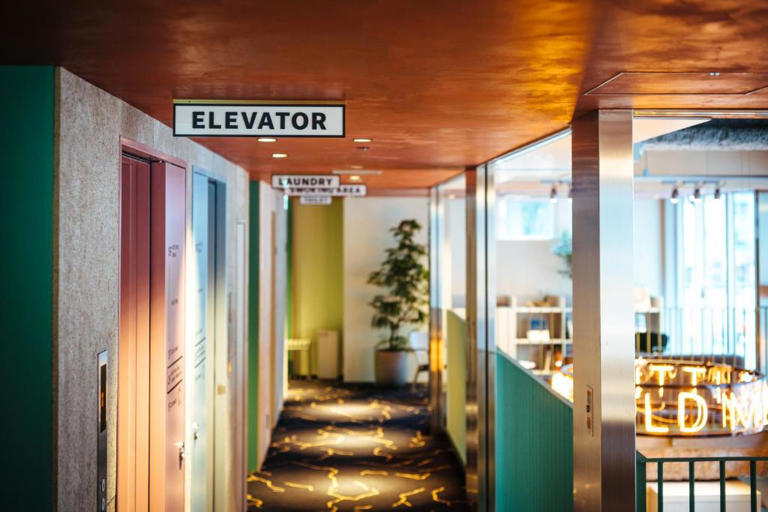
7 Cheapest Destinations For 2024 That Offer The Most Travel Value
Looking for a cheap destination for your 2024 vacation?
- Find the cheapest vacation spots in 2024 with the Post Office's Holiday Money Report, focusing on currency strengths and local costs.
- Locations like Sunny Beach, Bulgaria, Sharm el-Sheikh, Egypt, and Algarve, Portugal offer affordable travel experiences with diverse activities.
- Tokyo and Hoi An, Vietnam provide inexpensive yet unforgettable experiences with free attractions like parks, shrines, and cultural sites.
Looking for a cheap vacation? The postal and financial services firm Post Office , located in the United Kingdom, has released a new travel report that highlights some of the most affordable vacation destinations for 2024. The yearly study is intended for tourists from the UK, although Americans might also benefit from this list.
The Holiday Money Report 2024 identifies some of the most affordable holiday locations by examining currency strengths, local costs, and necessary visitor fees in 40 well-liked vacation spots worldwide. The study rates locations using a barometer that accounts for the cost of eight necessities for tourists: beer, coffee, cola, water, wine, sunscreen, bug repellent, and a three-course dinner.
Furthermore, the report provides a decent idea of where travelers’ money will go the farthest, even if it excludes items like lodging and travel. Here are the seven cheapest destinations for 2024 that offer the most travel value.
10 Cheap Travel Destinations In The US, Ranked By Cost
7 sunny beach, bulgaria, travel cost per day: $78.26.
Sunny Beach, situated on Bulgaria's Black Sea coast, was built as a resort town for Bulgarian families in the 1950s and has grown to be the nation's top tourist destination over time. Due to the town's expansion over time, the town now offers vacationers an exceptionally wide range of possibilities. These include go karting, paintballing, casinos, music venues, and a massive waterpark.
Additionally, this cheap destination has a gorgeous waterfront, lined with tall buildings and featuring a lovely blue sea as well as a lengthy sandy beach. When it comes to nightlife, the neighborhood is known for its club scene. With a bustling nightlife and affordable costs, it's a great option if travelers are looking to go out with friends on a tight budget.
6 Sharm el-Sheikh, Egypt
Travel cost per day: $76.86.
Sharm El Sheikh is a popular destination for eco-tourists and divers due to its abundant marine life and hundreds of Red Sea coral reef locations. Over the past several decades, the tourism industry in this city on the Sinai Peninsula has expanded quickly, leading to the emergence of upscale resorts and sophisticated nightlife.
Sharm el-Sheikh, known for its affordability and value, stands out as one of the cheapest destinations in 2024, offering an array of budget-friendly activities. Snorkeling and diving in the crystal-clear waters of the Red Sea are must-dos, showcasing colorful coral reefs teeming with marine life.
For excursions on land, sampling delectable street cuisine and touring Old Sharm's bustling marketplaces provide rich cultural experiences without breaking the budget. Additionally, hiking Mount Sinai for breathtaking sunrise views comes at little cost, making Sharm el-Sheikh a treasure trove of affordable yet unforgettable experiences.
5 Algarve, Portugal
Travel cost per day: $74.76.
The Algarve region in Portugal, which offers culture, history, and scenic beauty at a far lower cost than in past years, is one of the cheapest destinations for 2024 that offers the most travel value. Travelers looking for an inexpensive yet stimulating break will find Algarve to be an exquisite destination with its sun-drenched beaches, quaint villages, and mouthwatering seafood.
Algarve's beautiful beaches are well-liked by people all over the world. This is particularly true if travelers go at the height of summer. Even with Algarve's growing popularity, this sunny region of Portugal continues to provide a ton of amazing bargains for cheap costs. There are several affordable hotels in the area; travelers can get some great deals, but they will need to make reservations far in advance.
10 Cheap Solo Travel Destinations For Those On A Single Budget
4 tokyo, japan, travel cost per day: $73.95.
Unexpectedly, Tokyo, Japan, a thriving city where modernity and tradition coexist, claims its place on the list of the cheapest 2024 destinations. The Post Office claims that all travelers need to buy as visitors is $74.43 each day.
Tokyo offers a wide range of free attractions, from skyline views at the Tokyo Metropolitan Government Building to discounted museum tickets on designated days. Green spaces like Ueno Park and iconic shrines like Sensoji are also free to explore. Enjoy art without spending a yen, with TeamLab installations scattered throughout the city and public sculptures like Louise Bourgeois' giant spider .
Unexpected places, like luxury boutiques and sushi restaurants, also host free art displays. Whether admiring Mt. Fuji from observation decks or stumbling upon art in unexpected places, Tokyo provides endless opportunities for exploration without breaking the bank .
3 Mombasa, Kenya
Travel cost per day: $68.79.
With its white sand beaches, lively marketplaces, and rich Swahili tradition, Kenya's Mombasa comes in on the list of the world’s cheapest travel destinations for 2024. Its seaside location on Africa's east coast entices visitors looking for both leisure and cultural discovery.
Given that Mombasa Island is one of the most popular tourist attractions in Kenya, travelers should definitely make the effort to visit if they haven't already . It's best to avoid choosing a date between December and March when travel is at its busiest and rates are highest.
12 Top Travel Destinations In The US For 2024
2 cape town, south africa, travel cost per day: $68.07.
With the backdrop of Table Mountain and immaculate coastlines, Cape Town, South Africa, promises a memorable vacation with an expenditure of $68.48 per day for necessities. Here, travelers can savor fine cuisine inexpensively while immersing themselves in the dynamic culture.
Tourists can visit Boulders Beach, renowned for its colony of African penguins , which presents a picturesque scene with ancient granite boulders and shimmering turquoise waters, or explore Kirstenbosch Botanical Gardens for serene sunset concerts and scenic strolls. At the historic Labia Theater , enjoy diverse films, or indulge in culinary delights at food markets like Oranjezicht City Farm and Mojo Market .
Budget-conscious travelers can also explore the vibrant streets of Bo Kaap for free, unwind on hiking trails such as Lion’s Head and beaches like Clifton, or ascend Table Mountain on complimentary hikes or cableway rides.
1 Hoi An, Vietnam
Travel cost per day: $64.10.
Hoi An, Vietnam, tops the list of the most affordable destinations for 2024. The Southeast Asian city offers the best value for travelers’ money and won't break the bank, with a total projected cost of just $64.51 per day for travel necessities, according to the Post Office survey.
Hoi An, a city on Vietnam's central coast, draws tourists with its UNESCO-recognized Ancient Town, a charming area where lantern-lit lanes lead to delightful stores and street food vendors. Additionally, it's located near some of Asia's most breathtaking white-sand beaches.
Hoi An's Ancient Town, a historic gem from the Nguyen Dynasty, reflects cultural exchanges with Japan and China. Notable structures like the Cau Pagoda showcase foreign architectural influences.
On-budget travelers can explore bustling streets and cultural sites like the Hoi An Museum and Folk Island's Handicraft Village at VinWonders Nam Hoi An . History enthusiasts can visit the Hoi An Impression Theme Park and delve into the town's 400-year history, featuring the Hoi An Memories Show. For tranquility, travelers on a budget can visit Cam Thanh Village's coconut tree-lined rivers, offering basket boat rides and local boat shows.
We’re sorry, this site is currently experiencing technical difficulties. Please try again in a few moments. Exception: request blocked

COMMENTS
Kyoto - Hiroshima: 10,500 Yen ( $70) Hiroshima - Osaka: 10,000 Yen ( $67) So if you were to replicate my Japan route exactly, you would end up spending $381 on rail tickets. It sounds like a lot of money but I do want to stress that the trains in Japan are some of the best in the world.
6. The Japan Rail Pass is a great travel bargain. Like the famous Eurail Pass, the JR Pass is one of the world's great travel bargains and is the best way to see a lot of Japan on a budget. It allows unlimited travel on Japan's brilliant nationwide rail system, including the lightning-fast shinkansen (bullet train).
Food Budget in Japan Average Daily Costs. Calculated from travelers like you. While meal prices in Japan can vary, the average cost of food in Japan is $30 (¥4,568) per day. Based on the spending habits of previous travelers, when dining out an average meal in Japan should cost around $12 (¥1,827) per person.
Bus Passes. One way to save on transport costs in Japan is by purchasing a Willer Express Bus Pass. This pass allows you to travel for 3, 5 or 7 days within a period specified by you. Advantages: The days of travel do not need to be consecutive, giving you flexibility in your itinerary.
Medium budget: 500 - 2000 yen per day. Admission to famous temples costs between 300 and 1000 yen. Most museums and castles charge about 500-1500 yen per person. High budget: above 2000 yen per day. Some museums and attractions (usually outstanding ones or tourist traps) charge between 1,500 and 3,000 yen per person.
With some advance planning, Japan is an affordable destination for even the most budget-conscious traveler. Take some time to decide which options best suit your budget. There are a wide variety of budget accommodation options, transportation passes and sightseeing discounts available.
You can save money in Japan by living like a local. If you're staying in a hostel, buying a rail pass, eating relatively cheap food, and visiting a few attractions, budget around 10,000-16,000 JPY per day. However, by utilizing the tips above, I think you can travel Japan for 7,000-10,000 JPY per day.
Kanpai's Budget Calculator provides a precise estimate of the travel expenditures item-by-item, with numerous possible choices. As a matter of fact, a backpacker's 10-days trip will not cost the same as a 3-weeks stay for a family looking for a very comfortable trip. Fill in the questionnaire below to discover the expenses to expect and ...
A regular JR pass that allows travel across the whole country costs 29,100 yen. This is incredibly reasonable. If you take a train from Tokyo to Kyoto, throw in a day trip to Nara and you've started saving money. Our plan was as follows: 3 days - Hiroshima and Miyajima. 2 days - Osaka. 1 day - Himeji. 1 day - Nara.
Japan on a mid-budget - 20 ,000 Yen per day (£100 / $130) For those wanting to stay in low-cost hotels, enjoy the restaurant scene, nights on the town, and the odd activity/experience splurge. Japan on a high-end budget - 25,000 - 40,000 Yen per day (£130-£200 / $165-$250)
This section covers estimated trip costs depending on your travel style. I share my actual travel expenses further below. 🎒 Budget Traveler - Japan Trip Cost. Budget travelers can expect to spend approximately $60 per day or $840 for two weeks of travel in Japan, excluding flights. Here's what a budget traveler's cost breakdown can ...
How To Visit Japan On A Budget . Saving Money on Transportation . Regional Travel in Japan. For regional trips, your top options are bullet trains, buses, or planes. Bullet trains are very expensive but worth the splurge if you're short on time (the trains zip through the countryside as fast as 200mph).
11. Try housesitting. This is the ultimate Japan on a budget tip if you can pull it off! Housesitting is a way to avoid spending anything on lodging and accommodation while traveling. If you're flexible with dates for lodging and accommodation, take a look at housesitting as an option.
We've traveled to Japan three times, each with a slightly different budget: The first time (2015), we had 8 days and were on a super tight budget.; Our second visit (2019) was for 3 weeks, and our budget was a bit more flexible, but still not huge.; And on our most recent trip (2023), we had 3 weeks and a more generous Japan travel budget.We also had our toddler with us, meaning we made ...
Unlike in much of the rest of the world, consumer prices in Japan have barely increased over the past decades. Add to it a weak yen, and you have a travel destination that is much more economical than the outdated misconceptions about expensive Japan would suggest.With careful planning and a little know-how, it is now easier than ever to enjoy a budget trip in Japan.
The Seishun 18 is a 5-day ticket, costing 2,370 yen per day - a total of 11,850 yen. A fraction of the price of the Japan Rail Pass, this is a great option if you want to do lots of little trips or one or two big journeys during the 5 day period. Interestingly, the ticket can also be shared between up to 5 people.
2 Weeks in Japan Trip Costs. The estimated total cost for 2 weeks in Japan is $5,530, £4,400 for 2 people. This works out to around $200, £157 per person per day, and it includes flights, accommodation, transportation, food, activities, souvenirs, and other small expenses. This is a for a medium-budget holiday with some luxury dinners, top ...
Backpacking Japan Suggested Budgets. If you're backpacking Japan, plan to budget 7,000 JPY per day. This assumes you're staying in a hostel dorm, cooking some of your meals, eating at the cheap restaurants and takeaways, visiting free museums and temples, and using public transportation to get around.
All things considered, you could travel to Japan and stay for two weeks with between $3000 to $6000 USD based on what your final itinerary looks like and how well you manage your money in the country. ... You could easily feed yourself well on a budget in Japan without missing out. If you consider a food budget of about $30-$50 USD a day, you ...
Generally speaking, you can travel around Japan on a budget of $60-$120 per day (per person). As you can see in the infographic, our Japan daily budget was ¥13.418 (€107/$122) as a couple. Read the post for detailed information about the costs of a trip to Japan, exactly how much we spent on accommodation, food, transport, and activities ...
During our last trip to Japan, I made a list of EVERY SINGLE TRANSACTION we made whilst travelling. I made a massive spreadsheet and now share where our cost...
Trip to Japan Calculator. Every traveler has a different budget and situation. Our calculator takes all possibilities into consideration for a quick trip or a long vacation in Japan. 1) Length of Stay. 2) Number of Travelers. 3) Choose City (s) you want to Visit: East & Central Japan. (Tokyo, Nagoya, Nagano, Nikko, Hakone)
6. Book your accommodation ahead of time. Budget-friendly places fill up first. Unfortunately, Japan is one of those countries where planning ahead is going to save you lots of money. Our guesthouses and hostels were all booked on Booking.com and Hostelworld.com for anywhere from $7.50-$23 per person.
On the budget side, to travel to Tokyo, you're likely looking at between $4,500 and $5,000 between airfare, hotel, rental car, and subway ticket, plus a smartphone plan. On the luxury side, you ...
Notify Your Bank: Before you travel to Japan, inform your bank or credit card company about your trip. This will help prevent your transactions from being flagged as suspicious when you use your card abroad. ... Plan Your Budget: Before your trip, estimate your daily expenses and set a budget for each day. This will help you calculate how much ...
Budget Tricks: Save your pocket money and still see all the cool stuff. Updates; Come on, Let's Go! Grab your copy of Japan Travel Guide 2024 now and start planning your most amazing trip ever. Japan is waiting for you with lots of fun, yummy food, and cool places to explore. Let's make your adventure in Japan the best time ever!
If you plan on traveling across Japan, a Japan Rail Pass can save you a lot of money on transportation. The pass allows unlimited travel on Japan Railways (JR) trains, buses, and ferries for a set ...
Foreign visitors to Japan spent 1.75 trillion yen ($11.2 billion) in the January to March period, according to data from the JNTO. That's an increase of 52% compared to pre-pandemic 2019.
10 Cheap Solo Travel Destinations For Those On A Single Budget Solo travel doesn't have to break the bank. Check out these cheap destinations for solo travel that are perfect for world wanderers on a budget. 4 Tokyo, Japan Travel cost per day: $73.95. Unexpectedly, Tokyo, Japan, a thriving city where modernity and tradition coexist, claims its ...
TOKYO, Japan - On November 29, 2023, the United States and Japan officially launched the "U.S.-Japan Tourism Year" with a signing ceremony at the residence of U.S. Ambassador to Japan Rahm Emanuel. ... and the Japan Association of Travel Agents. For the United States, the Tourism Year is an important initiative under the National Travel ...